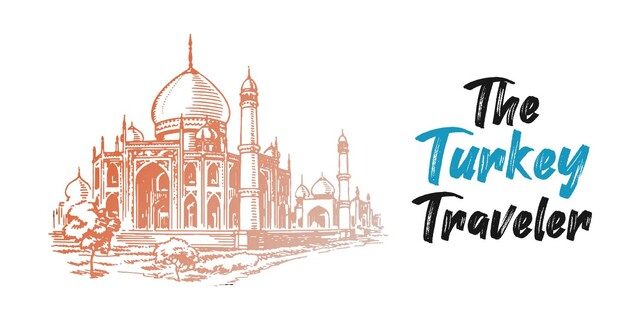

Getting Around Istanbul: How To Use Public Transport in Istanbul
Co-Founder of The Turkey Traveler. Globetrotter, Adventurer, and Frequent Traveler to Turkey!
This website uses affiliate links. For more information, click here .
Istanbul is a really easy city to navigate, but it’s also huge. It also spans two continents, Europe and Asia, separated by the Golden Horn harbour, which connects to the Bosphorus Strait.
These two sides and the varying modes of transport can make getting around Istanbul confusing.
This is why we wrote this guide to public transportation in Istanbul so you can understand how to get from place to place with ease.
Planning a trip to Istanbul last-minute?
Make sure you book your tours, places to stay, and airport transfers ahead of time to ensure availability!
Here is our recommended airport transfer in Istanbul:
- Airport Shuttle From Istanbul Airport (IST) or Sabiha Gocken International Airport (SAW) (Super affordable!)
Here are our recommended tours in Istanbul:
- Luxury Bosphorus Cruise At Sunset (A must-do In Istanbul)
- Whirling Dervishes Show (Unique experience!)
- Historical Turkish Bath Experience
- Istanbul Food And Culture Tour
Here are our recommended places to stay in Istanbul:
- Magnuara Palace Hotel (Gorgeous hotel in the historic centre!)
- Pera Palace Hotel
- Cheers Hostel (Budget hostel near the Blue Mosque!)
What is the best way to get around Istanbul?
The best way to get around Istanbul is on foot. The city is quite walkable, especially in the areas where all the tourist attractions are.
The districts of Sultanahmet, Besiktas, and Eminou are the three main areas where tourist attractions reside. You can easily walk between these three districts since they sit next to each other.
Besiktas is located across the Galata Bridge and connects to Eminou, which connects to Sultanahmet.
If you decide to stay in these areas, you won’t need to use much public transport to get from A to B.
But of course, we can’t all walk for miles and sometimes we need to give our weary legs a break, so you may need to use public transport when walking isn’t an option.
Public Transport in Istanbul
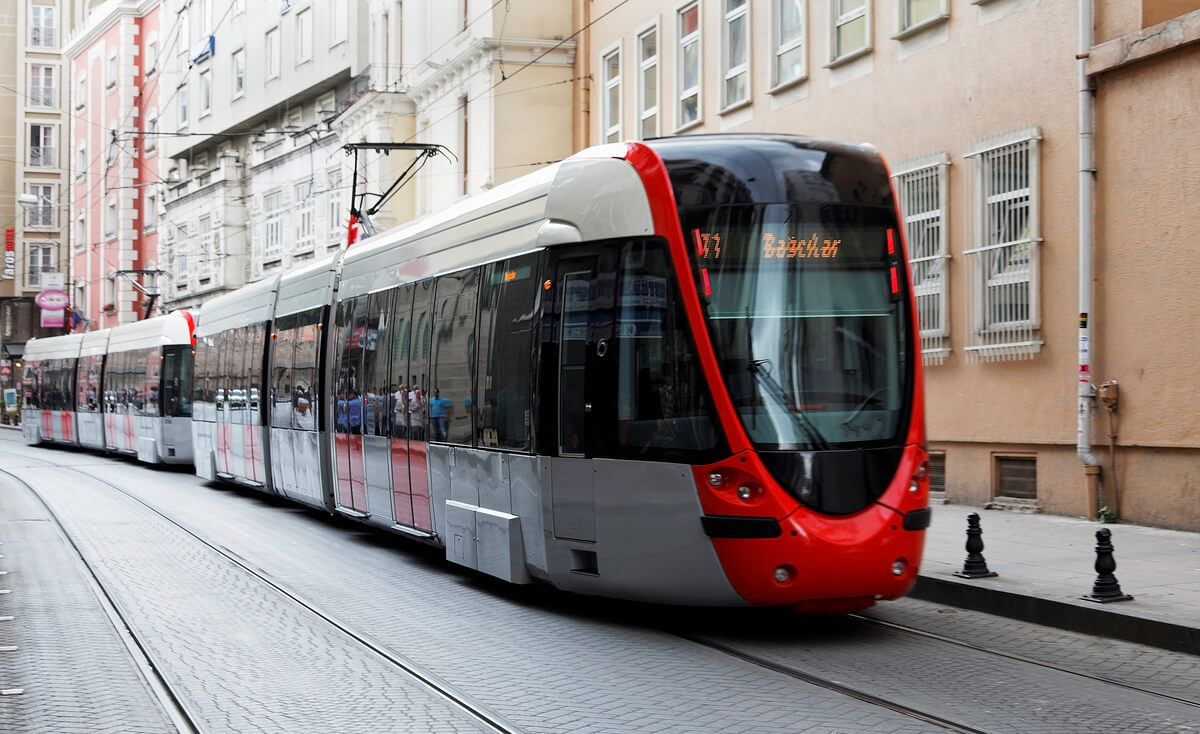
The main way to get from each tourist attraction is on the tram. The tram is very simple to use and it’s difficult to get lost since there are only three lines and it only runs on the European side of Istanbul.
Riding the tram in Istanbul is a great way to explore the city, and it has been conveniently built to ride between some of the most notable tourist attractions.
It started as a horse tram during the Ottoman era in 1860, and became an electric tram in 1912, making it one of the oldest public transportation options available.
In 1992, it was modernized when the T1 line opened, followed by the T2 in 2006. In 2011, the T1 and T2 line merged and was simply called the T1 line, which is why there is no T2 line today.
The T4 and the T5 lines opened in 2007 and 2021.
With a modern network covering much of downtown, trams are a comfortable and economic way to get around Istanbul.
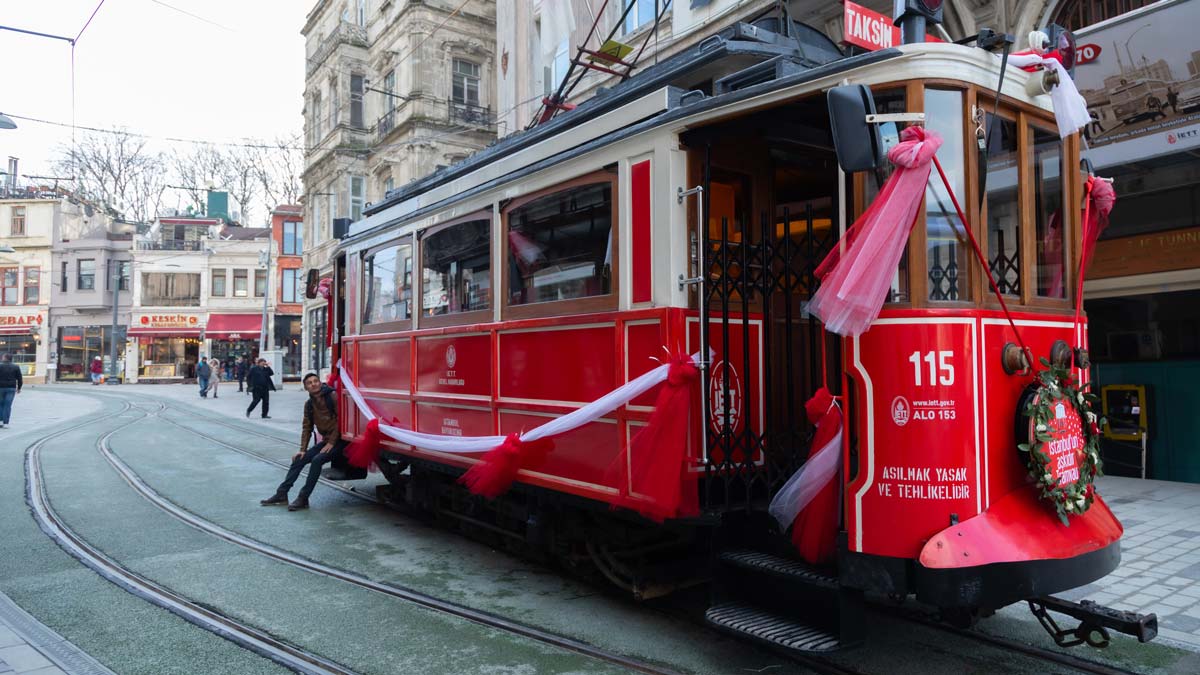
The T1 Line runs from Bagcilar to Kabatas, and is the main line that connects the suburban neighborhoods to Sultanahmet where the Hagia Sofia, Blue Mosque, and Topkapi Palace are located, and runs into the Besiktas district where you’ll find the Galata Tower and Istiklal Street .
The T1 tram lines connects to the T4 Line at Topkapi which runs up to Mescidi Selam. This line runs mostly through suburban areas and is rarely used by tourists.
The T3 Line is located on the Asian side and operates in a circular loop around Kadikoy and the Moda district.
The trams are modern and quite atmospheric, with detailed information panels inside each car informing passengers on how to use them and where they’re heading.
All lines are now air-conditioned, accessible for strollers and wheelchairs, and even provide WiFi!
A ride costs only 15TL regardless of destination or length of the journey. You can purchase 1,2,3,5 or 10 ride tickets, or use your contactless payment card.
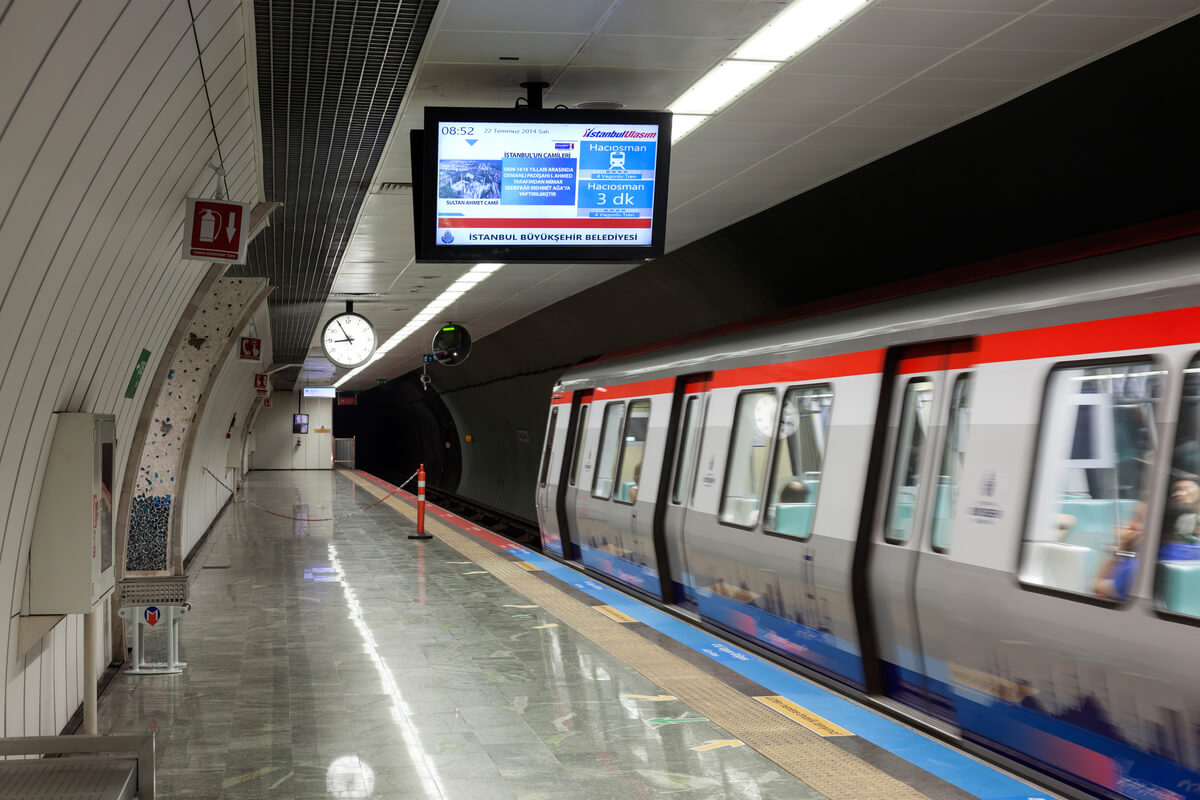
If you’re looking for the quickest way to get around Istanbul, you may need to take the Marmaray metro .
It’s been around since 1989 and was the world’s second-oldest underground urban rail line, the top spot goes to the Underground in London. It has expanded far beyond its original line between Taksim and Levent and today has 11 lines. You can even get the M11 metro line to Istanbul Airport from Kabataş.
Nowadays it runs over 194 kilometers of track with a total of 133 stations, linking neighborhoods all over the city.
Riding on the modern and comfortable metro system is a great way to save time while seeing some of Istanbul’s major sights. Most stations are accessible with elevators, meaning it’s an easy way for those with mobility issues to get around the city.
Plus, navigating it is pretty straightforward: you can either use your contactless payment card, or buy your ticket at one of the many vending machines scattered around the station or from the friendly ticket staff.
The metro reaches most major points in Istanbul such as Sultanahmet and Uskidar.
It’s also the quickest and easiest way to reach the attractions on the Asian side of Istanbul , such as Uskudar and Kadıköy.
Bus & Metrobus
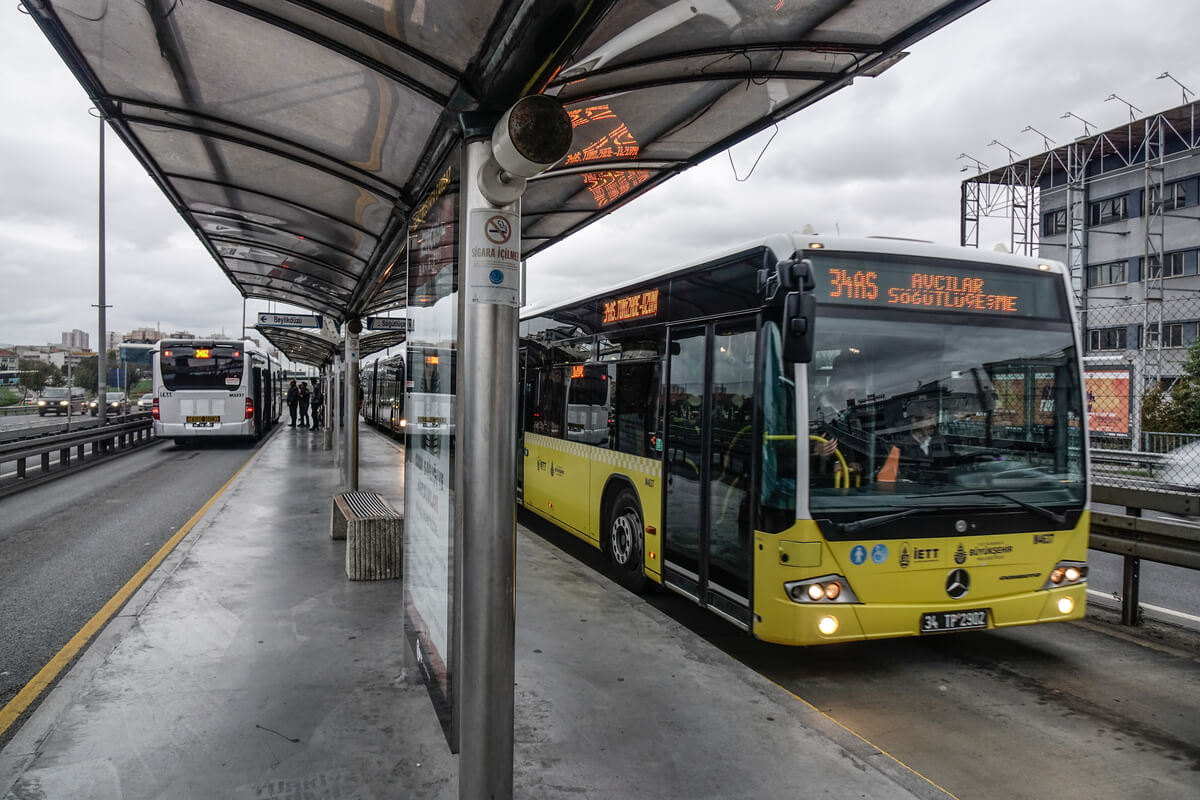
Istanbul is a bustling city with so much to see, so if you don’t want to travel underground, another great way to get around is by bus (dolmuş).
The large, yellow buses take you to places all over Istanbul. With over 4,012 buses and 783 bus lines, you can find a bus to take you anywhere.
There is also a Metrobus service , which is a a private lined express bus service and is a fast way to get between the two ends of Asian side and the European side.
The buses usually transport from suburban areas into the city and traffic can be a problem in some areas, so we don’t recommend a bus for getting around downtown. You may use the buses when traveling to and from the airport, or for reaching attractions further afield such as the Vialand Theme Park or Legoland.
Some routes are even diverted during peak times, which is quite inconvenient for tourists who aren’t aware of these alternate routes.
If you want to visit just the touristy sites, you might want to consider the hop-on hop-off bus , which rides around Sultanahmet Square, Eminönü, Karaköy, Besiktaş, Galata, past the Dolmabahçe Palace and Naval Museum, and up towards Taksim Square, Şişhane, and Egyptian Spice Bazaar.
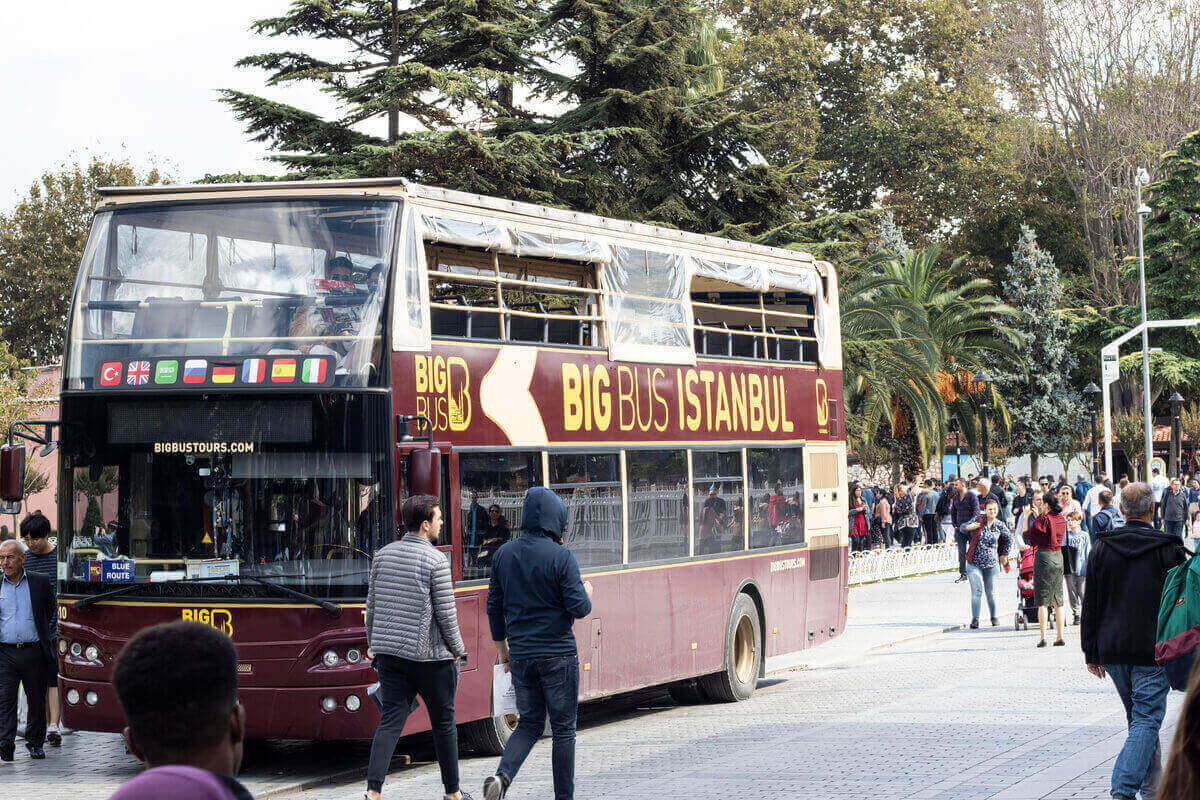
The iconic ferry system in Istanbul has been around since the reign of Ottoman sultan Abdülmecid and is an affordable way to cross the Bosphorus.
Depending on where you want to travel, you can choose from different routes that connect the European and Asian sides of Istanbul.
There are various ticket options ranging from day tickets and group discounts to monthly subscriptions.
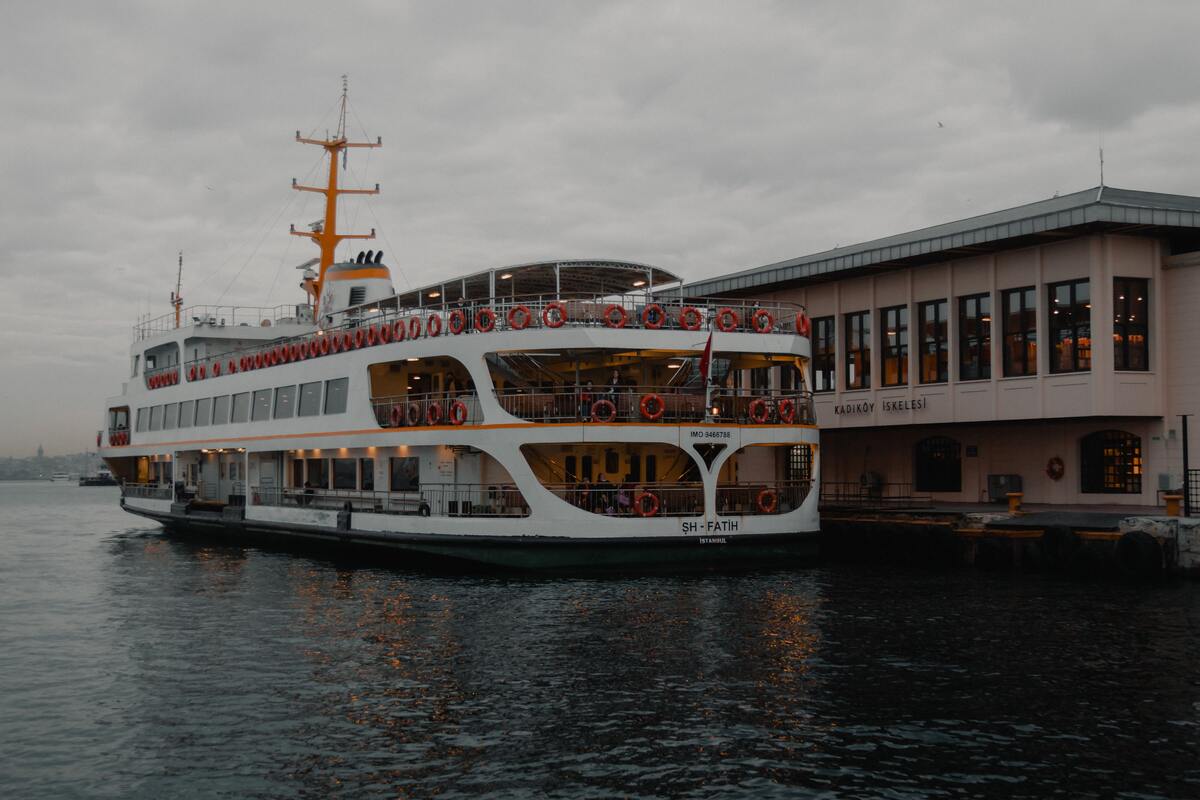
Taking a ferry ride is an experience worth having and it’s quite affordable, too. The perks of the ferry are uou get to witness part of Istanbul’s history while traversing through two continents.
The downside is that ferry times are not as regular as other forms of transport, so if you want to take a ferry, you need to plan ahead and make sure you make it to the pier with enough time to spare, otherwise you may end up waiting as long as an hour for the next ferry.
The experience undoubtedly adds another layer to this unique city that continues to dazzle visitors and locals alike, but we do recommend you take a look at the ferry times before you visit so you can plan when you need to get to the pier.
The ferry times can all be found here.
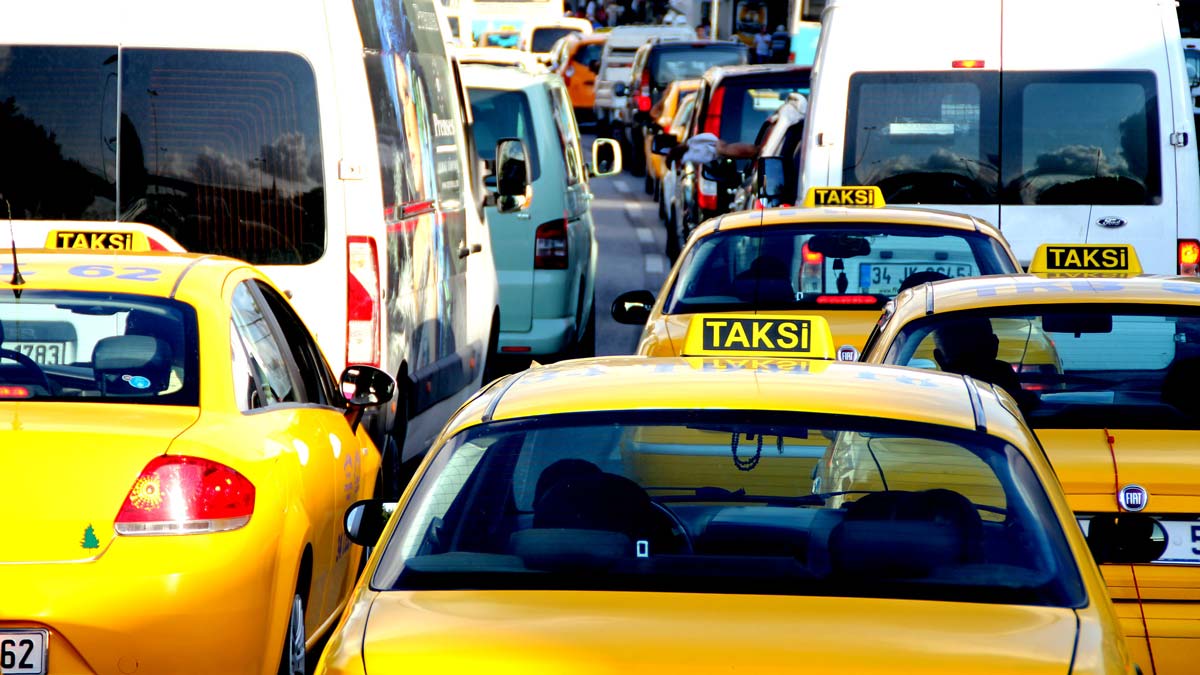
Honestly, we wouldn’t recommend getting a taxi in Istanbul. The one time we did this, we were scammed and ended up paying more than was written on the meter.
The driver pretended to be lost and drove in the wrong direction – only because we had our route on our phone were we able to tell him of his mistake and he turned around. Of course, we paid for that mistake.
This is why we always recommend using Uber in Istanbul . This means you see the fare before you get in the taxi and you can also follow the route on your phone. If there are any problems, Uber has a support team that can help.
We felt much safer using Uber and never had any issues using it.
Do You Need an Istanbul Public Transportation Card?
There is a public transportation card called Istanbulkart, which is a prepaid payment card that allows you to travel on any form of public transport in the city.
The Istanbul Card used to be the best way to pay for public transport, since you could top up at kiosks at all metro stations, ferry piers, and tram stops.
However, you no longer need to use the Istanbulkart to pay for public transport in Istanbul . All public transport now accepts contactless payment cards as a form of payment, meaning there is no longer the need to queue up for a ticket.
If you don’t have a contactless payment card, you can still get an Istanbulkart from a machine at the airport. The machine is located outside the main bus terminal.
Tips for Using Public Transport in Istanbul
- Use your contactless payment card. This is much easier than lining up for a ticket, and costs the same price.
- Be aware of pickpockets. Especially on the tram. While crimes are rare and Istanbul is safe , petty crimes like pickpocketing can sometimes happen. Wear your backpack on your front and lock away any valuables.
- Carry a city map. Don’t rely on Google maps as it’s not foolproof. You can collect a map from your hotel or from tourist information centers.
- Carry cash. Many ticket machines don’t accept cards, only cash, so bring cash to avoid needing to queue at ticket booths. When taking the tram, the ticket machine is the only way to buy a ticket.
Final Thoughts on Getting Around Istanbul
So there you have it, this is how you get around Istanbul using public transportation. As you can see, it’s fairly easy to navigate.
We hope this guide helped you plan your trip to Istanbul and helped you plan your route around the city. Hopefully now you have some insight into how to use public transportation in Istanbul.
Co-Founder of The Turkey Traveler
Sean Lau is a professional travel blogger and writer with adoration for Turkey. Originally from the USA, Sean frequently travels to Turkey to explore every nook and cranny. From bustling bazaars of Istanbul to the tranquil beaches of Antalya, Sean has seen it all. He hopes to share his first-hand knowledge, insider insights, and personal anecdotes to inspire fellow travelers to visit Turkey, especially to his favorite destinations – Istanbul and Cappadocia.
Leave a Comment Cancel reply
Save my name, email, and website in this browser for the next time I comment.
AFFILIATE DISCLOSURE
This website uses affiliate links, meaning I may earn a commission if you make a purchase through a link at no extra cost to you. TheTurkeyTraveler is a participant in the Amazon Services LLC Associates Program. As an Amazon Associate, I earn from qualifying purchases. For more information, see our full affiliate disclosure .
© 2024 The Turkey Traveler
Wander-Lush
42 Things to Know Before You Visit Istanbul: Helpful Istanbul Travel Tips
Istanbul is a magnificent beast.
Thirty-nine districts, 15 million people, and 1700-plus years of history – it’s still difficult for me to wrap my head around a city of this scale.
I never know where to begin with Istanbul. And yet every time I arrive, I somehow feel instantly at ease. Turkey’s biggest metropolis has a way of encircling you, sweeping you up and taking you along for the ride. For me, it’s one of those places where it’s best to relinquish expectations and anxieties and just go with the flow.
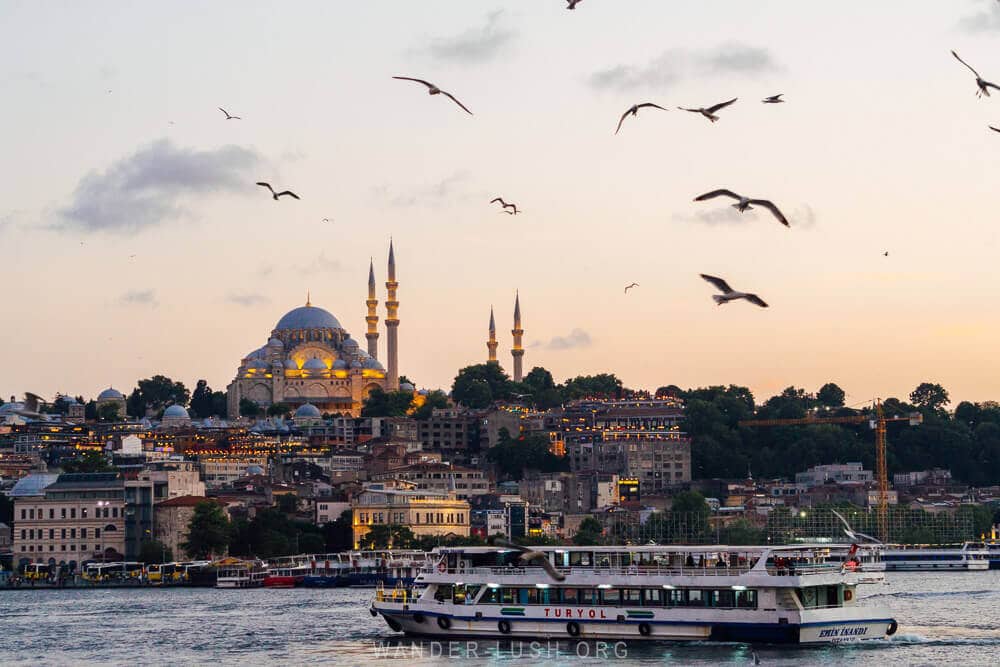
That’s easier said than done, and there are countless tidbits I wish I had known before I visited Istanbul for the first time back in 2019. On my recent re-visit, there were many more things I noticed for the first time.
I struggled to whittle this list down to a digestible size – not because travelling in Istanbul is particularly complicated or difficult, but because when you’re dealing with a city of such incredible breadth and depth, there’s just so much to talk about.
Here are 42 Istanbul tips that I think every traveller will benefit from , including cultural quirks, itinerary planning tips, logistics hints, and common faux pas.
- Also read: The perfect itinerary for 4 days in Istanbul
Please note: This post contains affiliate links, meaning I may earn a commission if you make a purchase by clicking a link (at no extra cost to you). Learn more.
Istanbul quick links
- Istanbul airport transfer: Private transfer from Istanbul Airport or Sabiha Gokcen (from $27)
- Where to stay in Istanbul: Hostel Le Banc (budget); 38 Hotel (mid-range); Hotel Empress Zoe (boutique); Ecole St. Pierre Hotel (luxury)
- Istanbul Official E-Pass: Pre-purchase online here
- Skip the line: Blue Mosque & Hagia Sophia Small-Group Tour (from $40)
- Best Istanbul food tour: Taste of 2 Continents (from $100)
- Top-rated Istanbul city tour: Best of Istanbul in 1 Day (from $60)
- Turkey car hire: Find a low-cost rental on Local Rent (from 28€/day)
Essential Istanbul travel tips
Starting with the basics, here are answers to some of the burning questions I had before my first visit to Turkey (Türkiye) and Istanbul.
1. Avoid visiting in summer
Never underestimate Istanbul’s magnetism. The city pulled in more than 14 million tourists in 2019 (including me), and on my most recent trip in 2022, it felt just as crowded as it had been three years earlier.
I’m willing to bet that most people visit Istanbul during the summer months – June, July and August. This feels a bit hypocritical because I myself have visited Istanbul twice during summer – but because I did, I know what peak season is like.
Istanbul’s climate is quite mild relative to other cities in the region. Temperatures might not go too far beyond 30 degrees Celsius in the shade, but the sun is scorching hot, and it’s very dry.
Aside from the oppressive heat, there are the summer swarms to contend with. (You haven’t really experienced a queue until you’ve stood in line for the Hagia Sophia on an August afternoon.) There are crushing crowds at every landmark during summer, and that gets old pretty quickly. On top of that, accommodation prices are noticeably higher and it can be challenging to get a reservation.
The best time to visit Istanbul is during shoulder season, spring (April to early June) or autumn (mid-September to the start of November). For something different, consider visiting Turkey in winter , when snow covers Istanbul and the city’s charm-o-metre is off the charts.
Take note of the dates for the Holy Month of Ramadan (usually around March-April-May, but it changes every year), which influences the way the city operates.
2. You need at least three days to do Istanbul justice
However many days you give yourself in Istanbul, it will never be enough. You will always feel like you short-changed yourself – there’s always one more neighbourhood to explore, one more ferry trip to take, one more museum to visit, one more restaurant to try…
Three days is the bare minimum for a first-time visitor, but you could easily stay for a week or more.
I recently spent 10 days in Istanbul and found it was a good amount of time to see the city at a relaxed pace. I stayed in the centre for that entire time, though I did have a few ‘down’ days to work. There are dozens of day trip opportunities to break things up if the city gets to be too much.
One of the highlights of Istanbul is the food, so you’d do well to measure the duration of your stay in meals eaten rather than nights slept! Six square meals (and a couple of ‘spread breakfasts’) is ideal for indulging in the best of Istanbul’s food scene .
Plan your time with my 4-day Istanbul itinerary , which covers the must-sees and a few local gems.
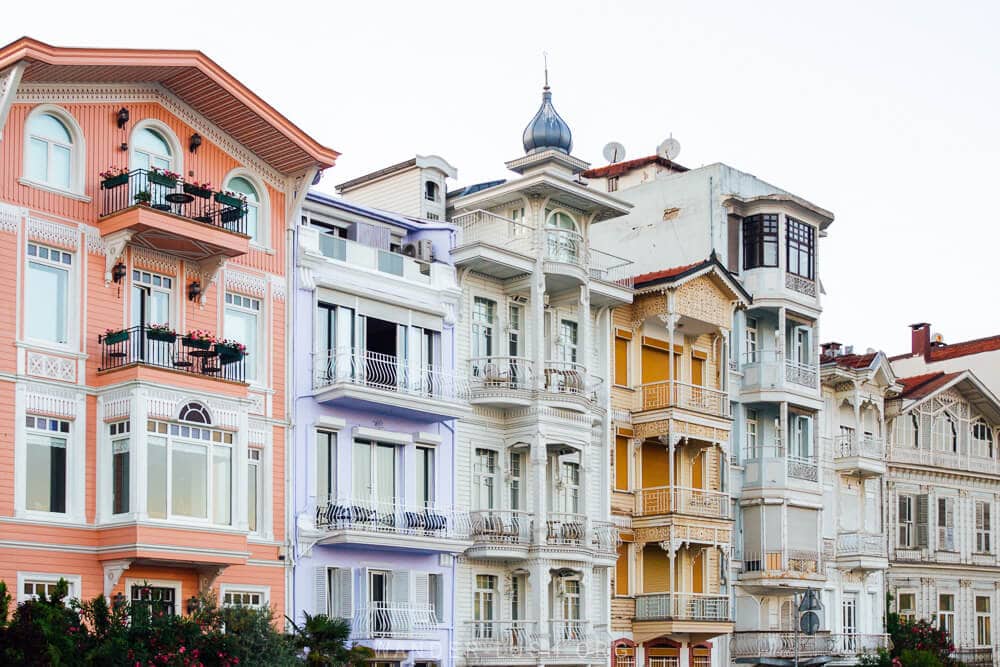
3. Save time (and maybe money) by applying for an e-visa
Most nationalities require a tourist visa to enter Türkiye. The country’s e-visa scheme, which launched in 2013, is available to citizens of 40+ countries, including the States, Australia and Canada. (EU citizens do not need a visa.) A standard multiple-entry visa is valid for a stay of up to 90 days with 180 days validity from the date of issue.
Visa on arrival (VOA) is also available, but if you’re flying in, it requires queueing at the airport – and because of the high volume of flights arriving at IST particularly, it can be a long wait. For some nationalities, it’s also more expensive – 10 USD dearer on average compared to the e-visa according to the official fees (though for US passport holders, VOA is cheaper).
Applying for a Turkish e-visa requires completing a simple online form. The website has English-language support and international card payment, but be warned that sometimes it’s a bit glitchy. Both times I’ve applied, my visa has landed in my inbox almost instantly (within the hour). Be sure to print off the A4 piece of paper to show at immigration.
There are copycat sites out there – the official e-visa portal is located here .
I have never been asked for proof of onward travel or a hotel reservation when entering Turkey. If you want one or both for peace of mind without making an actual booking, then I suggest using OneWayFly .
4. Travel insurance is a must
Travel insurance is mandatory for all foreign visitors to Turkey. Again, you might not be asked to show proof of insurance if you’re travelling on an e-visa (I haven’t), but rules are rules nonetheless.
Istanbul is generally regarded as a safe city, but pickpocketing and crime do occur. More importantly, local health care can be expensive, so it pays to be covered in case of accident or unexpected illness.
For single-policy or annual trip insurance, I recommend HeyMondo. Get 5% off your policy when you sign up using this link .
Read up on these Istanbul safety tips before you go.
5. Use the Havabus (Havaist) shuttle to travel to/from the airport
Update: Since publishing this guide, both Istanbul airports now have an underground metro service. I would definitely look into this option – avoiding traffic could be a real time-saver. Here are more details .
Havabus is a terrific service for travelling between Istanbul’s airports (yes, there is more than one – see the next point) and the downtown area. Shuttles operate 24/7, with departures in both directions every 30-60 minutes.
Tip: At Sabiha Gokcen airport, the shuttle is called Havabus and at Istanbul Airport, it’s called Havaist. I have used both – they operate in much the same way, but they have separate websites for checking the schedule ( here for Havabus and here for Havaist).
When you land in Istanbul, look for the airport bus signage. At Sabiha Gokcen, the bus stand is located on the other side of the car park directly in front of the arrivals terminal. Tickets are purchased using cash on the bus and cost 37.50 TRY (around 2 USD) per person to go to Taksim.
If you prefer a private transfer, airport cars are very well priced (from $27 to/from either airport). Pre-book a door-to-door airport transfer online here .
Eventually the Istanbul metro will extend to IST Airport, but the line has not been completed yet.
6. There are multiple airports in Istanbul – don’t front up at the wrong one!
Istanbul Airport (IST) is the city’s largest and busiest international airport. Located on the European side in Arnavutkoy, 40km / 45 minutes’ drive from Taksim Square, it is sometimes referred to as ‘Istanbul Grand Airport’ or IGA. If you’re flying with Turkish Airlines or from Europe, there’s a high chance you will be landing at IST.
A second airport, Sabiha Gokcen International Airport (SAW), receives flights from the Middle East (Emirates, Qatar ) as well as Turkey’s own Pegasus Airlines. It is located on the Asian side, 40km / 60 minutes’ drive from Taksim Square.
A third airport, Ataturk Airport, closed in 2019.
The two airports are 80km apart and it takes at least 75-90 minutes to travel between them. There are shuttle buses, but if you show up at the wrong one for your flight, there’s a good chance you’ll be left high and dry. Triple-check your reservation and make sure you show up at the correct airport.
We got caught out with this on our first trip and rolled up at the wrong airport for our flight back to Australia. Luckily we had come a day early with the intention of staying the night at the airport hotel, so we still made our flight.
You can use Havabus/Havaist to get back to the airport from the city, too. Buses depart from Taksim Square. Take the metro to Taksim and follow the exit towards Taksim Gezi Park. From there, the station is a short walk (you will see the coaches waiting and two ticket booths on the footpath).
Buses to both airports depart from the same area, so again, triple-check you’re hopping on the right one!
7. Pre-book your accommodation
Hotel platform Booking.com doesn’t work in Turkey, so if this is your preferred way to find accommodation, you’ll need to do your browsing and booking before you arrive. (This can be overcome by using a VPN of course.)
Pre-booking is essential for peak-period travel as properties do fill up and prices can skyrocket for last-minute reservations.
I normally use Airbnb in Istanbul for the simple reason that I prefer to stay in local neighbourhoods. Sisli is my district of choice: It has great access to public transport, fantastic local restaurants, and a more relaxed vibe.
8. Card is widely accepted, but it helps to carry cash
Ninety-nine percent of venues and shops in Istanbul accept credit/debit cards, including Visa and Mastercard, as well as contactless pay. For small markets and convenience stores, local restaurants, bars and taxis – and when dipping into the wonderful world of Istanbul street food – you’ll need cash.
Many smaller shops in Turkey have a primary limit set on card purchases, meaning you need to meet a certain threshold if you want to pay with a card. In these instances, cash is necessary. Small bills also come in handy for tipping (more on that later).
I suggest withdrawing cash when you first arrive and reserving it for smaller purchases and tips. Check out my Istanbul Travel Budget to learn more about budgeting for your trip and the cost of common items and services.
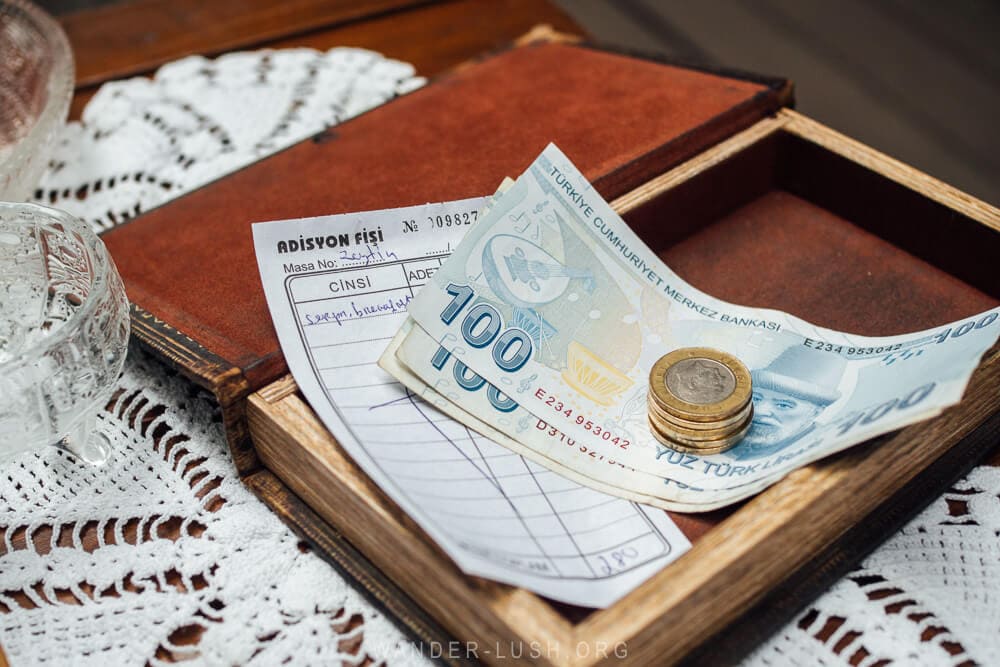
9. Most ATMs in Turkey charge a fee
ATMs are ubiquitous in Istanbul and most of the time, you’ll see half a dozen different cash machines clustered together. Majority charge a withdrawal fee – up to 5% for some banks – and have a transaction limit of between 3000-5000 TRY.
The only no-fee ATM we could find was Ziraat Bank. It’s red with a distinctive wheatear logo. We also used HalkBank, which did not charge us a withdrawal fee, but did hit us with a 13 TRY fee on Wise.
Banks change their fee structure regularly, so you might need to experiment with a few different machines. If the bank does charge a fee – either a flat fee or a percentage – this should always be displayed on the screen before you finalise the transaction.
On our first trip to Turkey, we had issues with our Australian bank cards not being accepted. This time around, I used my Wise card without any issues. I found the best method for withdrawing cash was to exchange stored currency to Turkish lira within the Wise app, then withdraw lira from the ATM.
Wise is great for international travel and offers very competitive exchange rates – if you don’t yet have an account, you can sign up here .
10. Buying a SIM card in Istanbul is easy, but your options are limited
Open WIFI is not readily accessible in Istanbul, which makes buying a local SIM card more or less a necessity.
If you’re not a Turkish citizen and you don’t hold a residency permit, you’ll find you have limited options when it comes to buying a SIM. Low-cost packages are not available to foreigners and most telcos only offer one standard tourist package.
After doing a bit of research, we settled on a Vodafone SIM. Vodafone only has one option for tourists, which includes 20GB of data, calls and texts, and unlimited access to Whatsapp. We paid 350 TRY (around 19 USD).
The process of buying a SIM is very straightforward and only took us about 15 minutes. You need a hard copy of your passport for registration, so make sure you’re carrying it with you. The tourist SIM automatically expires after 60 days.
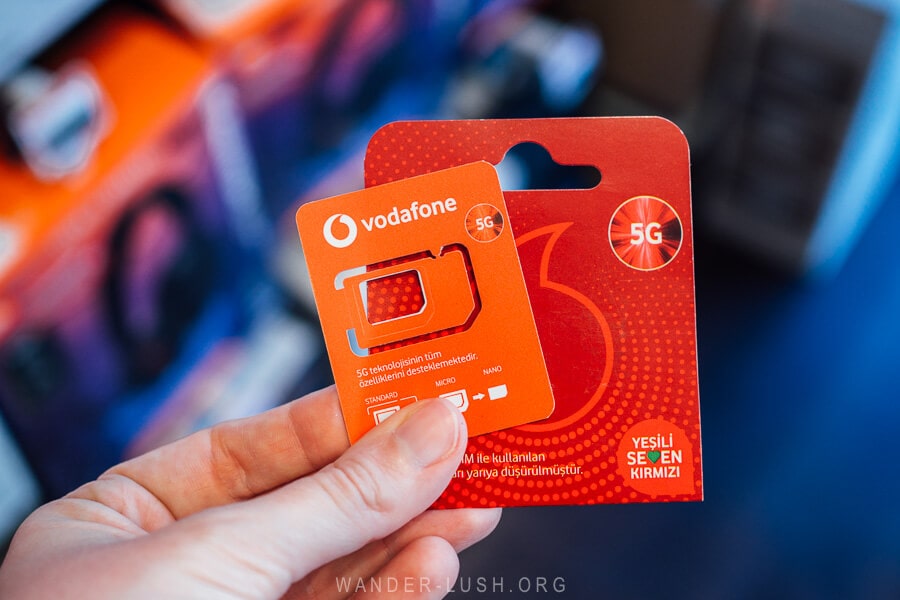
11. The public transport system is phenomenal
If you’re considering hiring a car in Turkey to continue your travels beyond the city, make sure you pick it up on the outskirts of the city (possible when using a company such as Local Rent ). The traffic is maniacal and I would not recommend driving in the city centre.
There’s no reason to drive a car in Istanbul, anyway: The public transport system is affordable, easy to use and reliable. Between the metro, trams, buses, ferries, and my personal favourite, dolmus vans, you can get anywhere you need to go with ease. Google Maps works well for planning your route.
Dolmus minivans – Turkey’s answer to a marshrutka – are a fun experience. The name literally means ‘stuffed’ because passengers are squeezed in like sardines. Keep in mind that the entire transport network is very busy and squishy during peak hour, especially in the morning between about 8-9.30am.
When boarding a bus in Istanbul, enter through the front door and tap your IstanbulKart on the electronic reader. If the bus is very full, you can board through the back doors and pass your card down the line for someone at the front to swipe.
12. You need an IstanbulKart transport pass
On our first trip to Istanbul, we walked a lot and relied on buying single-journey metro tickets for longer trips. This time around, we re-learned that only certain ticket machines inside the metro dispense single tickets – and usually they are the ones with an obnoxiously long line of people.
An IstanbulKart is an essential purchase if you plan to use public transport. There are several different cards available – all are valid for the metro, buses, trams and ferries. The so-called Anonymous IstanbulKart is recommended for tourists and is sold at kiosks and newsstands and inside metro stations for 50 TRY (non-refundable). You can use one card for multiple people (up to five people).
A single IstanbulKart fare costs 7.67 TRY. Compared to the 15 TRY for a single-journey ticket, you’ll end up saving almost 50% on every trip.
Note that metrobus fares vary according to the number of stops travelled, but metro fares are flat. Transfers are charged at 5.49 TRY for the first transfer and 4.17 TRY for the second leg.
Find more information about the public transport system here .
13. Use an app for taxis in Istanbul
Istanbul’s cab system is similarly well organised, with three types of taxis at different price points. Yellow taxis are standard and have the lowest fares (6.3 TL/km plus a switch-on fee of 9.8 TL). Turquoise taxis are a premium service and cost 20% more, while black taxis (always luxury vehicles) are twice as expensive as yellow taxis.
Taxis are metered, so it’s generally considered safe for a tourist to hail a cab on the street. However, scams do happen , which is one of the reasons most people (including many locals) prefer to use an app.
After numerous legal battles, Uber re-launched in Turkey in 2021. We used it on several occasions and found the service to be good – short wait times, friendly drivers, and competitive fares (we always paid in cash rather than hooking up our credit card – make sure you are carrying small bills).
Uber alternatives include BiTaksi and Itaksi. The former has POS contactless payment, which is great for paying by card.
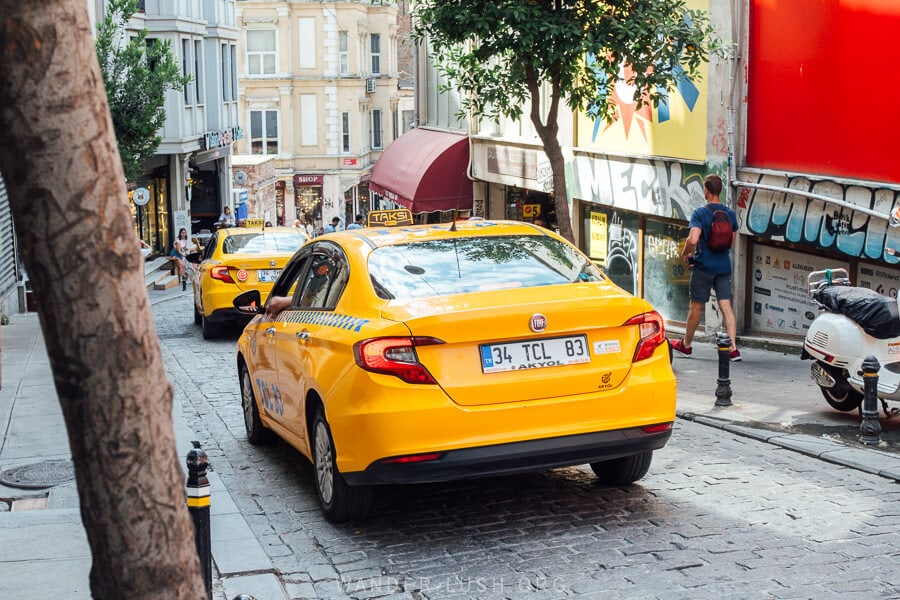
14. Tipping is standard
Tipping is customary in Turkey, with 10% being the standard mark for restaurants and bars. For taxi drivers, it’s normal to round up to the nearest lira when paying in cash.
Of course you should only tip if you’re satisfied with the service. We found the quality of customer service in Istanbul to be pretty good across the board, with the exception of one chain cafe where we had a terrible experience.
Tipping is slightly higher for other service providers: 10-20% goes to your tellak or natir at the Turkish baths, and to your hairdresser or barber.
15. Can you drink the tap water in Istanbul?
This is a rhetorical question, because I’m still not sure what the correct answer is! Locals will warn you off tap water while at the same time, the government is running campaigns to encourage more people to drink from the faucet.
From what I understand, Istanbul tap water was undrinkable a decade ago. Infrastructure improvements (and the addition of chlorine to the water stream) have made tap water safe to drink, but many people still prefer to drink bottled water.
If the building you’re staying in has old, rusty pipes, it might be best to give tap water a wide berth. Try a small quantity and see how it sits with you.
16. Don’t flush your loo paper
Istanbul’s pipes are a bit sensitive, thus most restaurants, cafes and hotels request you place toilet tissue in a bin rather than flushing it down the loo. If this is the case, you’ll likely see a sign and a strategically placed wastepaper bin. If in doubt, don’t flush it.
17. If you need a bathroom, head to the nearest mosque
After chasing after non-existent bathrooms in malls and metro stations, I finally cottoned onto this little Istanbul tip: There are public toilets attached to most mosques and in my experience, they are almost always cleaner than public bathrooms elsewhere. Pan toilets are common. Men’s rooms are marked with bay , and women’s with bayan .
Some bathrooms are free to use, while others charge a small (1-2 TRY) fee. Another good reason to carry some small bills or coins with you.
18. Sip ayran to keep your tummy happy
Ayran is a savoury yogurt drink that has its roots in Turkey, but is popular around the region (I developed my ayran addiction several years ago in Bosnia and Herzegovina and have been sipping it ever since). It’s not too creamy, not too watery, and has just a hint of salty effervescence.
Because it’s yogurt, it’s full of good bacteria that do wonders to keep your gut in balance. Just as you might drink lassis in India, you can drink ayran in Istanbul to help ward off any potential food or water-related bugs.
Food poisoning definitely does occur in Istanbul, so watch what you eat and try to consume street food earlier in the day when it’s fresher (especially fish wraps and seafood).
People drink ayran with breakfast, lunch or dinner, and it is served at virtually every restaurant in Istanbul – either in little plastic tubs or from a fountain. Always go for the fresh option when it’s available: It’s light and aerated and extra delicious, presented with a big scoop of yogurty foam on top.
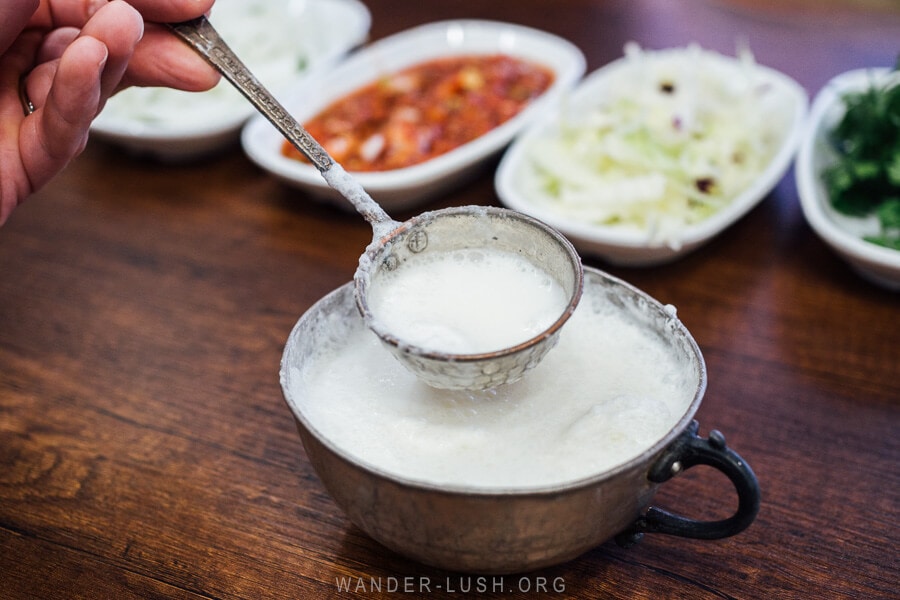
19. Drinking is common, but alcohol is not ubiquitous
The most popular alcoholic drinks in Istanbul are beer, wine and raki , a powerful spirit distilled from grapes or other fruits. Not all restaurants serve alcohol, however, and when you make your way over to the Asian side of Istanbul (which is noticeably more conservative), you’ll find that only a handful of establishments are licensed.
If you prefer to BYO, tekels are Istanbul’s answer to bottle shops. They normally sell a selection of local bottled beers and Turkish wines along with soft drinks, snack foods and cigarettes. It’s illegal to sell alcohol within 100 metres of a mosque or a school, so you won’t find any tekels in some neighbourhoods.
Sales are restricted to certain times of day – you cannot purchase drinks from a bottle shop between 10am and 6am (there are no restrictions on restaurants and bars, though). Alcohol is served as normal during Ramadan.
Excessive drinking is taboo in Turkish culture. Raki, the national drink, is a social beverage consumed slowly with food. It has aniseed notes and is sometimes served over water and ice, which gives it a milky colour.
If you want to try raki, head to a meyhane (meze bar), where alcohol is served with small places of food (also see point #26 on this list). You can order a small 350 mL bottle or a shot (~40 mL). Start slow – some rakis are 80-90 proof.
20. English is widely spoken (sort of)
The number of Turkish people who speak English is somewhere between 15-20% . Of course the rate is much higher in Istanbul, but still, English is not as widespread as you might imagine.
We found a bit of a paradox here: In big shops and phone stores, very little English was spoken, while we encountered staff who spoke perfect English in small restaurants and humble bakeries.
The bottom line is that it’s a bit of a mixed bag, so be prepared to sign and mime your way through some situations. Of course it helps to have some simple Turkish under your belt – knowing a few basic phrases can help to smooth things over.
Istanbul quirks to know before you go
Here are a few unusual quirks that tripped us up in Istanbul.
21. Pharmacies are hard to find
Turkey differentiates between ‘pharmacies’ and ‘cosmetic stores’ in a way that I’ve not noticed in any other country. The latter sells beauty and health products, but there is no pharmacist on staff and nowhere to buy over-the-counter medications or prescription meds.
Chains such as Watsons, Rossmann and Gratis are classified as ‘cosmetics stores’. If you need anything more serious than paracetamol or a revitalising face mask, you need a pharmacy or eczane .
Eczanesi are more difficult to come by. That’s because there are no chain pharmacies in Turkey. All pharmacies are small and owner-operated by a pharmacist – essentially mom-and-pop shops. You won’t find them in malls, only on the streets. Look for the ‘eczanesi’ sign in the window, and when using Google Maps, search for ‘eczane’ rather than ‘pharmacy’.
Pharmacies are worth hunting down if you need them: Many medicines are freely available in Turkey without a prescription, and prices are almost always cheaper than elsewhere in Europe. You do have to ask around, though, as every pharmacy has different stock and different generic brands. My partner spent several days searching for his medication and after asking at a dozen eczanesi, he finally found what he was looking for at a quarter of the price it is in Georgia.
22. Hand cologne is a thing
Istanbulites were sanitising their hands long before it was cool. The first time we had our hands doused in hand cologne by a friendly waiter, we assumed it was hand sanitiser – but no, this tradition far predates the pandemic.
Kolonya harks back to the days of the Ottoman Empire when a pleasant smelling liquid was sprinkled on guests’ hands as they would enter or exit private homes, hotels or hospitals. Today it’s widely used in restaurants after you pay the check. Some places have a little bottle on the table next to the salt and pepper shakers.
Scented with jasmine, lemon, rosewater or dark spice, a dash of hand cologne leaves your paws smelling fragrant fresh. Unlike hand gel, kolonya is very thin and watery – a little bit goes a long way. And because it’s ethanol-based, it does act as a disinfectant as well.

23. Don’t be surprised if you get asked for your phone number
Grocery stores, cosmetic stores, clothing shops and pharmacies alike seem to ask customers for a local phone number – I assume for marketing purposes rather than to track or register anything. This happened to us on a daily basis, and the first few times, the language barrier made it very confusing.
If you don’t have a local SIM (and even if you do), you can always say no and the cashier will copy a random number off the back of an old receipt.
24. Don’t stay too close to a mosque if you like to sleep in
Istanbul has its own backing track, and that is the sound of the call to prayer ( ezan ). The rumble of minarets whispering to each other is incredibly stirring – but your opinion might be slightly different if you happen to be laying your head near a mosque’s speakerbox every night.
The call to prayer happens five times a day, starting with the pre-dawn İmsak ( Fajr ), which reverberates around the city some time between 4-6am depending on the time of year. In July, it can be as early as 3.30am, with a second Sunrise ( Güneş ) call around 2 hours later.
With well over 3,000 mosques, you’ll more than likely have at least one or two nearby. If you’re a light sleeper, it’s worth scoping out the local mosques and choosing accommodation that’s further than earshot from the nearest minaret.
25. Don’t linger too long at a lokanta
Lokanta are a specific type of Turkish restaurant that serve casual, home-style meals to workers and tradesmen. Every neighbourhood has them, and they are a terrific place to sample salt-of-the-earth Turkish cuisine and soak up a bit of local culture at the same time.
When you sit down at a lokanta, a waiter will come to take your order within seconds. Some are cafeteria style, others are a-la-carte. At the end of the meal, empty plates are spirited away and the table sprayed and wiped just as fast as the food came out. Usually you settle the bill at a cash desk rather than requesting a written check.
It’s easy to overstay your welcome at this type of establishment, where the imperative is to turn tables as quickly as possible. They are perfect when you need a quick bite, but if you want a leisurely meal, choose a different sort of restaurant. Sidewalk meyhanes , for example, are the complete opposite. Serving meze and raki, they are designed for long, lingering lunches.
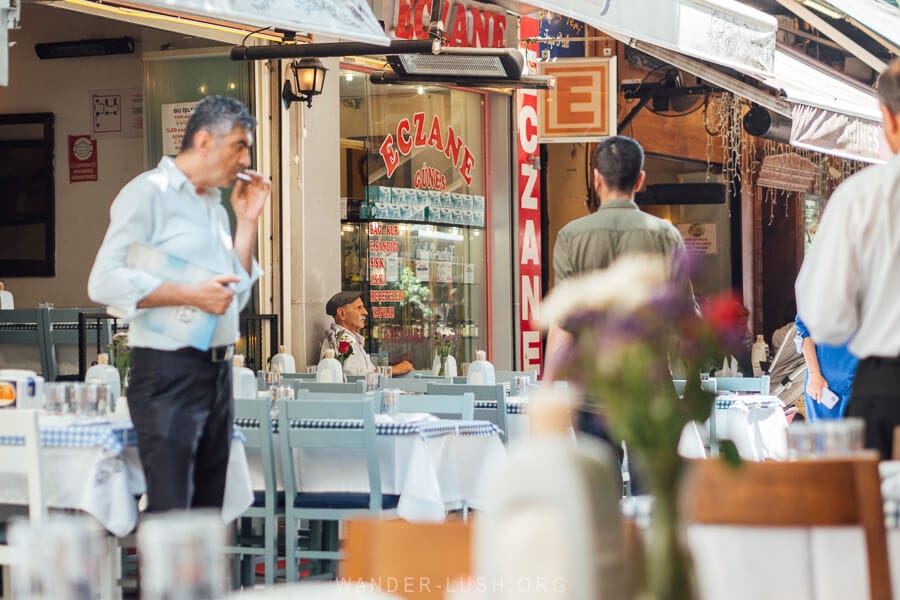
26. Don’t assume those meze plates are free
It’s normal for wait staff at a meyhane to present you with an attractive tray of small plates before they take your order. Turkish meze includes grilled eggplant with yogurt, fava beans, artichoke, and many, many more delicious bites designed for sharing over a bottle of raki.
Don’t make the mistake of assuming these small side salads are free – they are not. (Sides of chopped onion, herbs and chilli served in smaller silver dishes with kebab, on the other hand, are usually included in the price.)
27. Brace yourself for lots of uphill walking
They don’t call Istanbul the ‘City on Seven Hills’ for nothing. After a few days walking the streets, you might think the ‘city of seven million hills’ is a more apt nickname.
Constantinople was laid out in the image of Rome, which was of course built over a septet of hills. On the ground, it feels like all of Istanbul is rippled, with steep streets and vertiginous staircases at almost every turn. There are many advantages to this city plan, the delightfully sloped houses in Balat for one, and the spectacular city views you get from the higher elevations for another.
Comfy shoes and a whole lot of patience are absolutely essential when exploring Istanbul on foot, where it can literally feel like an uphill battle to get from one place to the next.
There are ways to avoid the slog, including using the funicular railways: Taksim-Kabatas and the historic Tunel that links Karakoy and Beyoglu. The latter is the world’s second-oldest subterranean rail line (after the London Underground) and the oldest still-operating underground funicular in Europe.
Istanbul travel tips to feel like a local
While it takes more than a three or four-day stay to feel like a fully fledged Istanbulite, here are a few little tricks to help you fit in.
28. Dress modestly to blend in
Istanbul is a metropolis through and through, with a liberal dress code to match. Almost anything goes, but I still recommend you cover up for comfort and to fit in with the crowd. Women should try to avoid plunging necklines, revealing fabrics, and very short hemlines.
There are noticeable differences between the European and Asian sides of Istanbul, with more modest dress and more hijabs worn in Uskudar compared to Eminonu, for example. Generally speaking, Turkey gets more conservative the further east you go, and this holds true even in the city centre. Keep it in mind if you’re travelling around the country.
One place you definitely must observe the dress code is mosques, where covered arms (to the elbow for men or the wrist for women) and legs (down to the ankles) is required. Women must also cover their hair. Majority of mosques have pull-over muumuus that you can borrow (for free) at the door to fully cover up. Note that there are no dress requirements for young kids.
It’s obligatory to remove your shoes when entering a mosque, so on days when you’re sightseeing, wear kicks that you can easily slip off and on. And if you prefer not to go barefoot, carry a pair of ankle socks in the bottom of your bag. Some mosques provide plastic bags, otherwise you can just leave your shoes outside.
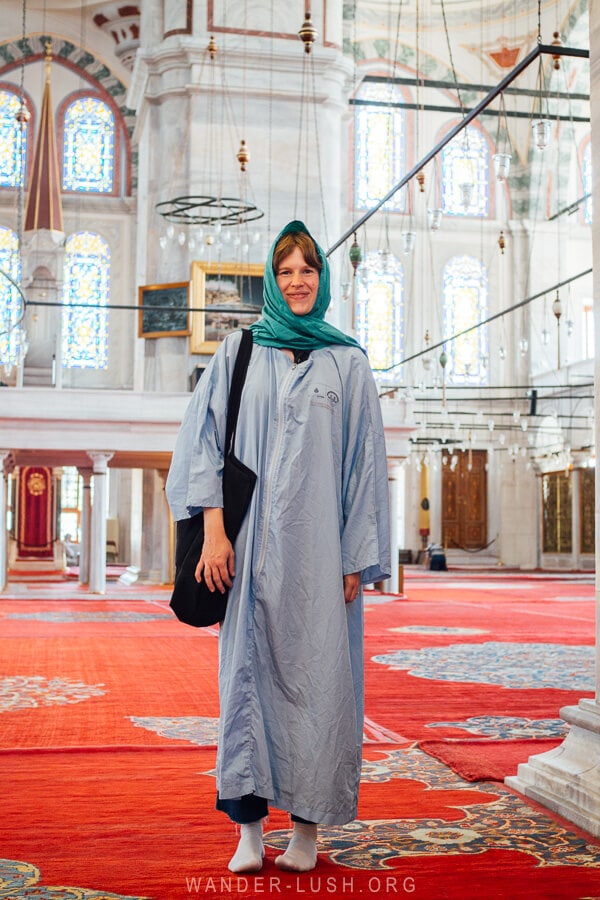
29. Never skip breakfast…
Breakfast is certainly the most important meal of the day in Turkey. Sunday breakfast is the queen of the morning meals, when the famous kahvalti tabagi ‘spread breakfast’ comes into its own.
On a Sunday, some Istanbulites spend the better part of the day between mid-morning and late afternoon gathered around the breakfast table with friends or family, noshing on an extravagant spread of cheeses, olives, cut vegetables and eggs served with supple somun bread. Kahvalti is a daily occurrence in places like Besiktast ‘Breakfast Street’ and in gourmet cafes such as Van Kahvalti.
If you’re on a tight timeline or a budget, breakfast doesn’t have to be drawn-out or expensive: There are faster and more affordable options, such as a pick-and-choose breakfast at Cakmak Kahvalti Salonu, where small plates range from 2-8 TRY each.
Borekcisi (borek bakeries) serve portions of steaming hot filled pastry and chai, or for a simple breakfast snack on the go, grab a simit bagel from a street vendor.
30. …But don’t order coffee first thing
Kahvalti means ‘before coffee’. Breakfast is traditionally accompanied by cay , strong black tea, rather than Turkish coffee. It’s normal to down half a dozen glasses of tea in a single sitting (though two or three is usually enough). Most sit-down kahvalti breakfasts come with two pots of tea.
If you want to do things like a local, save your Türk kahvesi for after lunch and start your morning with cay sade – strong and bitter tea with no sugar – instead.
31. Don’t be afraid to haggle at the bazaar
Haggling is customary and expected at markets in Istanbul and in other commercial settings. You’ll find that most items at the Grand Bazaar or Spice Bazaar have a price tag, but for those that don’t (and even for those that do), it’s quite normal to bargain for a better price. This is especially true if you’re buying more than one of something or multiple items from the same vendor. Rule of thumb is to aim for a 35-50% discount on the sticker price.
There are huge mark-ups at the Grand Bazaar, which seems to be almost exclusively the domain of tourists these days. There are local markets and street markets all over Istanbul where you’ll have a better chance of striking gold for a fair figure. Markets are held on different days of the week and following a rotating schedule, so you can always find something on. Popular food and flea markets take place in Karakoy (Tuesdays), Ortakoy (Thursdays), Uskudar (Fridays), and Besiktas (Saturdays).
If you do decide to brave the Grand Bazaar or another historic market in Istanbul, the best advice I’ve heard is to do your shopping in the mid-morning. It’s more likely that vendors have already made a few sales and met their daily commission targets, so there will be less pressure on you.
32. Don’t fall for the ‘shoe cleaner trick’
This one got us good.
One early morning we were walking down an alleyway in Besiktas when we heard a clack on the cobbles and noticed that someone had dropped a wooden shoe brush. Being the saint he is, my partner rushed to pick it up without a second thought and handed it back to the shoe cleaner whose caddy it had tumbled from.
Expressing his profound thanks, the guy promptly took a seat on the curb at our feet and insisted on shaking my husband’s hand in gratitude. That’s when he grabbed him by the wrist in a monkey grip and tried to pull him down for a coerced shoe cleaning. I should mention that he was wearing joggers, not leather shoes!
Neither of us were aware of this common scam at the time, so we thought the whole situation was quite hilarious. The man had a gorgeous smile and was very friendly – we actually gave him credit for this ingenious trick.
Only later when we heard about the scam did we realise what had (almost) happened to us. Ross managed to talk his way out of it, dirty shoes still intact.
We were not mad in the slightest, but it could have been a different story had we actually been talked into handing over cash. Keep an eye out for this trick, especially in touristy areas.
33. Embrace cat culture
There are up to a million cats and kittens living on the streets of Istanbul. Every cafe is a cat cafe, and every corner has its own posse of cute pusses. A picture-perfect clowder of cats lounging on fence posts and chairs like the princes and princesses they are awaits you at every turn.
Similar to street dogs in Georgia , the cats of Istanbul are regarded as community pets rather than strays and are fed and cared for by the locals. For the most part, they don’t bother people and keep to themselves. We definitely encountered a few fiercer felines on our travels – it’s pretty obvious which cats want pats and which ones need their personal space. They will let you know with a dagger stare or a hiss.
Cat culture can be traced back to Ottoman times, when tabbys helped to quash the city’s mice population. In this respect, cats are an inseparable part of the city’s social fabric.
If you’re an animal lover, it can be distressing to see so many cats living rough, especially when they’re not in the best shape. (Though I must say that every cat I met in Istanbul was plump and rosy.) It helps to know that Istanbul (and all of Turkey) has a no-kill, no capture policy.
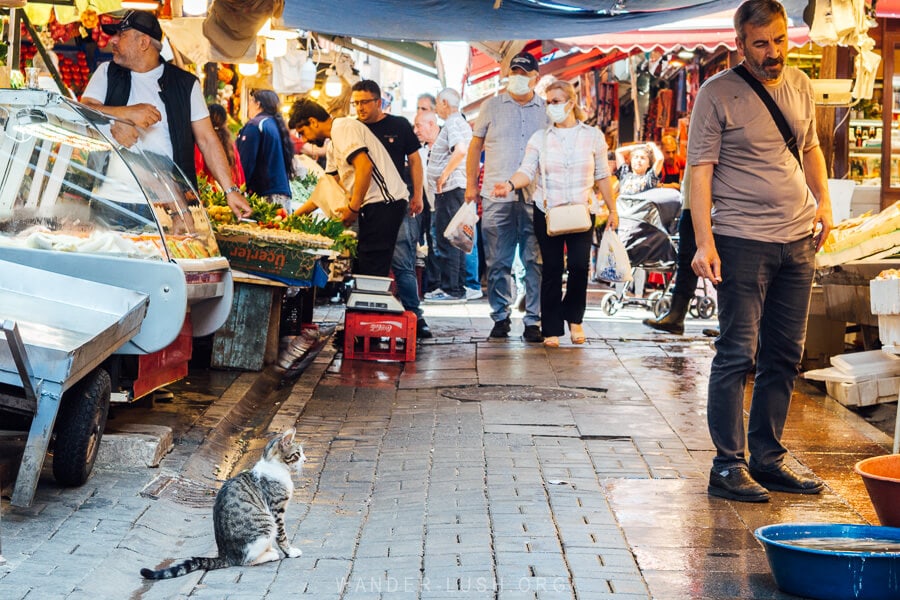
34. Brush up on your basic hammam etiquette
Partaking in a traditional Turkish bath is a must-do in Istanbul. The hammams have aeons of history and custom attached to them – there are definite dos and don’ts, just as there are with the sulfur baths in Tbilisi . It helps to know how to handle things once the towels come out, lest you embarrass yourself.
Regarding nakedness, men normally strip down to nothing while women wear undies (single-use pairs are supplied by most bathhouses) then don a pestemal towel, which stays wrapped around you for the duration of your stay.
The Turkish-style skin peel/massage ( kese ) can be quite rough on the skin and muscles. The therapist, known as a natir or tellak , will always be of the same gender. It’s customary to tip them 10-20% after your treatment.
For more Turkish hammam hints, see this guide .
More helpful Istanbul tips to make the most of your visit
Finally, here are a handful of practical tips for planning your itinerary and getting the most out of your time in Istanbul.
35. Organise your Istanbul itinerary by neighbourhood/district
Istanbul has 39 districts, each with its own character and appeal. From the Instagrammable houses and antique shops in Balat, to the trendy cafes in Cihangir, the rambunctious fish market in Uskudar to the Ottoman-era mansions in Arnavutkoy , every corner of the city has something incredible up its sleeve.
A great way to organise your time in Istanbul is by planning your movements around the different neighbourhoods. Each one is quite discreet, so you can knock out a to-do list before moving onto the next.
Some neighbourhoods naturally pair together thanks to geography and transport logistics: Galata and Karakoy, Fener and Balat, Uskudar and Kadikoy, Cihangir and Cukurcuma. See my Istanbul 4-day itinerary for more ideas on how to plan your visit by district.

38. Consider signing up for a food tour
One thing every Istanbul neighbourhood has in common is its never-ending supply of cafes, restaurants and street food vendors. One of the best ways to discover the city – especially if you’re on a tight timeline – is by signing up for a food tour.
I was lucky enough to join Culinary Backstreets’ Born on the Bosphorus tour during my most recent visit to Istanbul. It was one of the highlights of my trip – not only because of the delicious food, but mainly thanks to our incredible guide, Benoit, who over the course of a full day taught me so much about Istanbul’s food and beyond.
The popular Taste of Two Continents tour, with 11 food stops and a Bosphorus ferry crossing, is a good alternative if you’re looking for a half-day experience.
37. Get an early start to beat the crowds
This is particularly important in summer, when the touristy parts of the city get extremely crowded. One of the best ways to avoid long waits at landmarks such as Galata Tower is by waking up early and arriving as doors open.
The metro starts running at 6am – and from Friday evening to Sunday morning public transport operates 24/7 – so there’s no excuse not to get out in the early AM.
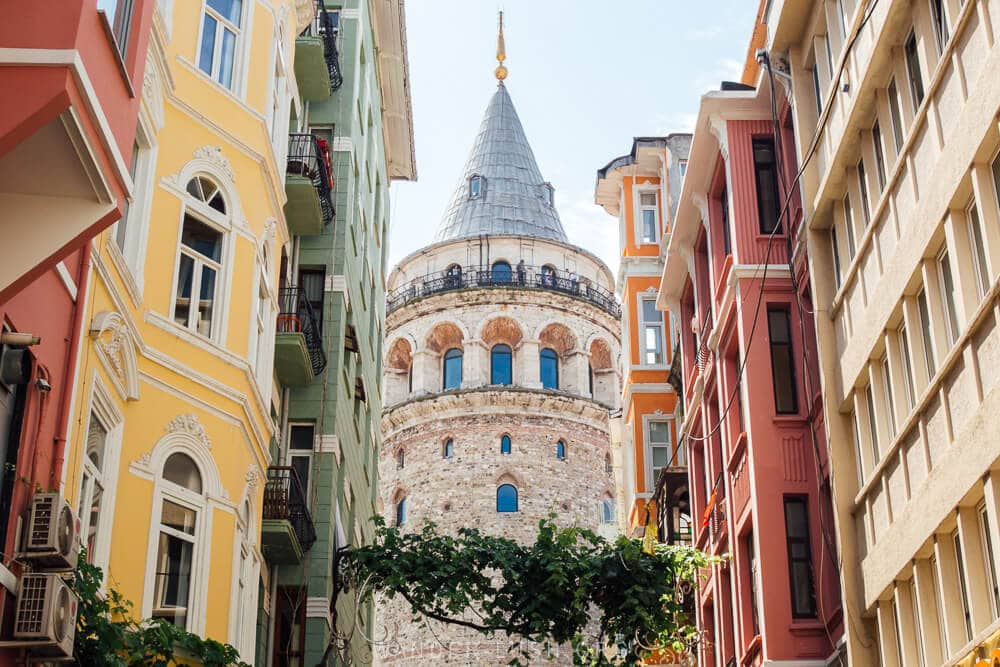
38. Invest in a Museum Pass or Istanbul E-Pass
There is a gamut of different tourist cards and passes available for Istanbul. The 5-day Istanbul Museum Pass or the 2-7 day E-Pass is one of the best investments you can make if you plan on doing the rounds through the city’s best museums and big attractions.
The digital pass gives you skip-the-queue access to 10 of the city’s finest cultural institutions, including Galata Tower, Topkapi Palace and the Harem, the Istanbul Archaeological Museum, the Museum of Turkish and Islamic Arts, and the Galata Mevlevihanesi Museum.
Available to purchase online before you arrive, it uses a simple QR code system. Just show your pass on your mobile – no need to print anything.
Only buy the pass if it makes sense for you, though: You have to visit multiple attractions for it to pay off, though the other perks – particularly the ability to skip the ticket line – are invaluable in a sense.
Purchase the official Istanbul E-Pass here via Viator .
39. Check prayer times in advance
The Blue Mosque and Hagia Sophia are both active mosques, open to visitors 24 hours a day, seven days a week. Except during prayer times, that is.
All of Istanbul’s mosques temporarily close to non-Muslim visitors five times a day for a period of about 90 minutes. For the duration of the Congregational Prayers, no tourists are permitted to enter.
It’s imperative to check prayer times in advance. If you show up while prayers are on, you will be met with a long wait outside. Times are signposted at the bigger mosques or you can check online .
The queue to enter the Hagia Sophia gets very long towards the end of the prayer session. The best time to visit is 30-40 minutes before the mosque is scheduled to close. Don’t try to visit on Fridays when the Jumu’ah prayer takes place – this is one of the busiest times, and it’s always crowded and chaotic.
If your Istanbul visit coincides with Ramadan or another Islamic holiday, prayer times might be different and mosques might be closed for longer periods during the day.

40. Skip the Bosphorus cruise – take advantage of local ferries instead
Some people opt to experience the Bosphorus on board a yacht at sunset with champagne and nibbles. If your budget won’t stretch that far, or you just prefer a local experience, then a ride on the public ferry offers the same ambiance and water views for a fraction of the price.
Hundreds of ferries criss-cross the strait, linking Istanbul’s Asian and European sides. The most scenic ferry routes include Besiktas to Kadikoy, Karakoy to Uskudar, and Karakoy to Kadikoy. Some boats go up the Bosphorus towards the Black Sea, and others head in the opposite direction towards the Princes’ Islands.
Bring a simit bagel to snack on (and to lure seagulls in for photos), or order a tulip-shaped glass of tea from one of the roving vendors on board.

41. Don’t miss the sunset from Galata Bridge
There is only one way to end a day in Istanbul in my opinion, and that’s by watching the sun go down from Galata Bridge. It might be touristy as heck, but there’s a good reason why this is such a popular spot. Views of the glittering water and intertwining boats, mosque minarets silhouetted against a dusky blue sky framed by fishermen casting their lines off the edge of the bridge, are absolute gold.
I recommend finding a spot to stand on the western side of the bridge, above the area where the Karakoy ferry docks. Aim to arrive about an hour before sunset for the best light.
For the perfect Istanbul photo, wait patiently for the garbage truck to come down the street and dump its load in the bins near the ferry terminal – this sends the seagulls into a frenzy, and they fill the skies with their spinning and diving for a good 15 minutes.
42. ‘Authentic’ Whirling Dervish ceremonies still exist – here’s how to find one
Speaking of Istanbul must-dos: A Whirling Dervish show is a bucket-list item for many. I was warned that all Mevlevi Sema ceremonies had become commercialised and ‘spoiled’ by tourists to the point where they just weren’t worth pursuing any more. So I made it my mission to find a real, ‘authentic’ Sema ritual in Istanbul, and I’m happy to say that I eventually did.
Get all the details about the best Whirling Dervish ceremony in Istanbul in this guide .
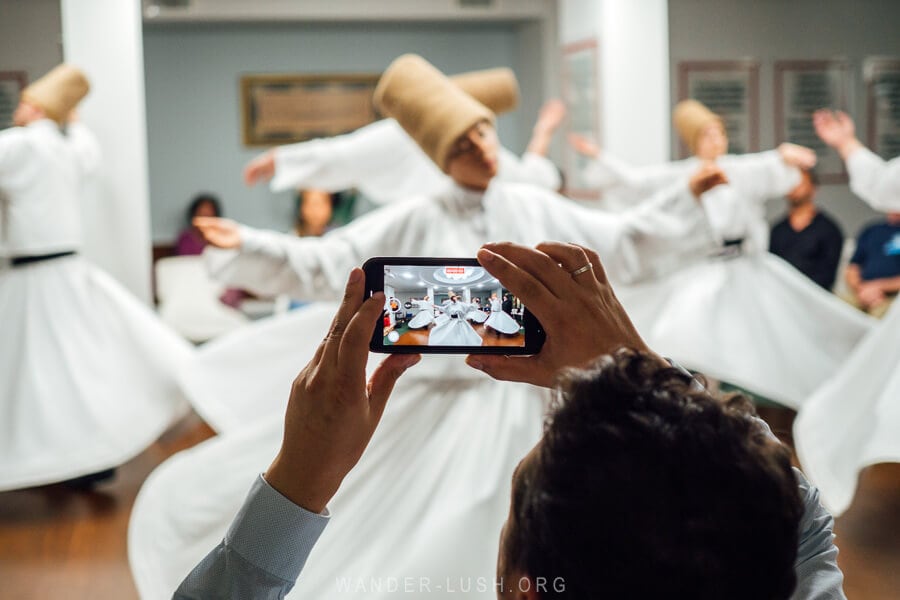
Where to stay in Istanbul
Budget: Hostel Le Banc (⭐ 9.5) – This popular hostel in Beyoglu is footsteps from the Galata Tower and Sishane metro station. It features air-conditioned rooms (private doubles and mixed/all-female 4 and 10-bed dorms), a shared lounge and a terrace.
Mid-range: 38 Hotel (⭐ 8.6) – Located in Sisli, close to Osmanbey metro station, this hotel has compact, tidy double rooms and suites.
Boutique: Hotel Empress Zoe (⭐ 9.2) – This gorgeous boutique hotel is decorated with heritage flourishes and boasts hammam-like ensuites and private internal terraces. The location in Fatih, minutes from Sultan Ahmet Mosque and the Blue Mosque, is very central yet the hotel still feels secluded.
Luxury: Ecole St. Pierre Hotel (⭐ 9.5) – Located in Beyoglu close to Galata Tower, this boutique-luxury hotel offers high-end suites with private courtyards and terraces. The building, an old Italian Dominican school with remnants of the 13th-century Galata walls inside its courtyard, is dripping with history.
Turkey essentials
Here are some of the websites and services I recommend for planning a trip to Turkey. Remember to check out my full list of travel resources for more tips.
FLIGHTS: Find affordable flights to Turkey using the Skyscanner website .
VISAS: Use iVisa to check if you need a tourist visa for Turkey and apply for an expedited visa online.
DOCUMENTATION: Use OneWayFly to obtain proof of onward travel/hotel reservation for your visa application.
TRAVEL INSURANCE: Insure your trip to Turkey with HeyMondo , my preferred provider for single-trip and annual travel insurance.
CAR HIRE: Use the Local Rent platform to hire a car from a local agent. Prices start from as little as 18€ per day.
ACCOMMODATION: Find the best Turkey hotel deals on Booking.com .
CITY TOURS & DAY TRIPS: Browse the Viator website to find the best itineraries and prices for Istanbul food tours, Cappadocia balloon rides and more!
More Istanbul travel resources
- 1-4 day Istanbul itinerary
- Istanbul travel budget
- The ultimate guide to eating out in Istanbul
- Tips for visiting Galata Tower for Istanbul city views
- The best Whirling Dervishes ceremony in Istanbul
- Guide to Arnavutkoy, Istanbul’s most beautiful district
- The best places to visit in Turkey
- Turkey in winter: Where to go plus travel tips
12 Comments
Detailed tips are super helpful, especially about the best time to visit and the ins and outs of public transport.
Thank you. Right now in Turkey with wife and kids. Following your steps and recommendations. Just one thing: booking asked for a price but the hotel converted the price to Liras and charged me much more for exactly the same booking and service! Thank you again,
I love your travel blog! Your vivid descriptions and stunning photographs make me feel like I’m right there with you. It’s inspiring to see someone embracing adventure and exploring new cultures. Keep the travel stories coming!
Excellent article and links for further information. I am planning a trip to Turkey in September with my wife and your articles a great start and support. Great job! Alejandro
This is very, very helpful. Thank you so much.
Early in your article you indicated that Booking.com does not work in Turkey, yet in the section, entitled “Turkey Essentials”, you direct us to that site for Hotels. Maybe I am missing something, but that appears to be contradictory. I found the article very helpful…..Thanks for the information.
Hi JB – I still recommend using Booking, only you have to reserve from outside of Turkey ie. before you arrive.
Thanks so much, this was really helpful. Lots of good to know stuff that I didn’t find mentioned elsewhere
it was very helpful thank you
Ha, I made the same mistake again and didn’t read through your info thoroughly. In Georgia, I paid more than I needed to for a SIM at the airport and this time, I could have saved a few lira on a bank withdrawal in Istanbul.
Already appreciating the smiles and kindness in Istanbul very much.
Love your work Emily.
Perhaps it’s different for Australian passport holders, but I found the VOA to be a better deal than the eVisa for Americans. Our eVisas were fast and easy to get, but cost $50 plus a 2 dollar service fee. We got them before traveling to Turkey last year, but went twice to make them a better value. This past month we got VOA (no lines) and paid 25 euros each. Both are valid for 6 months. Plus you get a little visa stamp in your passport!
Thanks Owen for the info – you’re right, VOA is more affordable for US passport holders, but not for us Aussies unfortunately! I would have loved a visa stamp. I’ll update that now. Cheers!
Leave a Reply Cancel reply
Your email address will not be published. Required fields are marked *
- Subscribe to future posts
Road is Calling
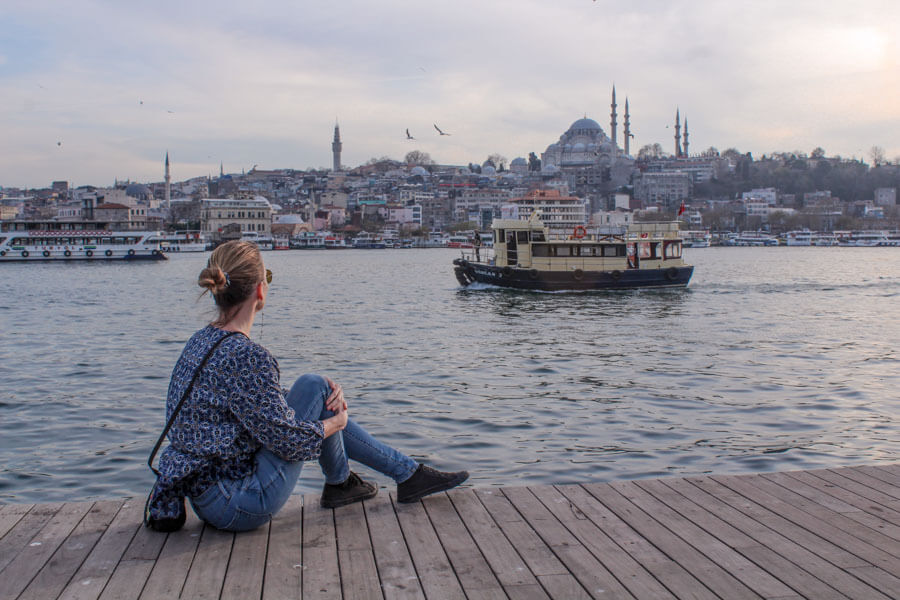
50+ Practical Travel Tips For Istanbul to Make the Most of Your Trip
After living in the largest city of Turkey for more than a year, I thought it was finally time to share the most practical travel tips for Istanbul that help to plan a stress-free vacation and get the most out of your trip.
Istanbul is that destination where you need to come prepared. Plan in advance not only where to stay , what to see , and where to eat but to book in advance tours you like, transfers, shows, and excursions. You also need to know ahead of time where to go and areas to avoid, learn about the famous scams and activities. Leaving everything for the last day will cost you much in terms of time and money.
There are really many things to know about traveling in Istanbul and many things to tell. Of course, this vast city with a thousand-year history hides many untold stories and leaves a lot of questions. Answering those questions and sharing some hacks made me write the whole Istanbul tourism guide with many insider tips for first-time visitors, people on a short or long vacation, and everyone else who just wants to have the best Istanbul vacation!
So get yourself a cup of tea and dedicate your tea time to some inspiration about Istanbul. Because this post is long! Learn everything you need to know before traveling to this amazing city on any visit. I include much advice, including Istanbul tips and tricks for tourists on a budget, for first-time travelers to Istanbul, and those who return after a long period of time.
And then if you fancy a read about some interesting facts about Turkish culture, check them out here . Also, find out about the common mistakes that tourists make when planning their Turkey holidays . Make sure to avoid them!
Quick Istanbul Insider Tips
Planning your trip to Istanbul last minute? If yes, here are the first-hand resources and insider tips that you’ll need!
Apply for E-Visa
- Turkey E-Visa for individuals – check if you need it
Top Private Transfer from Istanbul Airport
- Meet & greet private transfer from IST airport or Sabiha Gokcen airport
Best Places (Locations) to Stay in Istanbul for Mid-Budget
- Zeyn Otel Istanbul (Sultanahmet – 9.6 )
- Walton Hotel (Galata – 9.4 )
- Room Mate Emir (Taksim – 9 )
- Ikiz Konak Boutique Hotel (Kadikoy, Asian side – 9.6 )
Top Tours in Istanbul
- Evening Walking and Food Tasting Tour (best for short visits!)
- Tour Around Colorful Neighborhoods of Istanbul (small group tour!)
- Mosques of Istanbul Walking Tour (with expert guide!)
- Extraordinary Istanbul (best city tour!)
- Asian Side Uskudar & Kadiköy Tour with Lunch (with a boat ride)
- Best Bosphorus Cruise (skip the line!)
Other Useful Resources to Have
- Best Istanbul Car Hire – below I explain why
- Best Istanbul Pocket WiFi – unlimited 4G Internet
- Istanbul City Transport Card – for bus, metro, tram & ferries
- Istanbul Museum Pass – skip the line at the most famous sights
Must-Know Travel Tips For Istanbul Before a Trip
What is istanbul like.
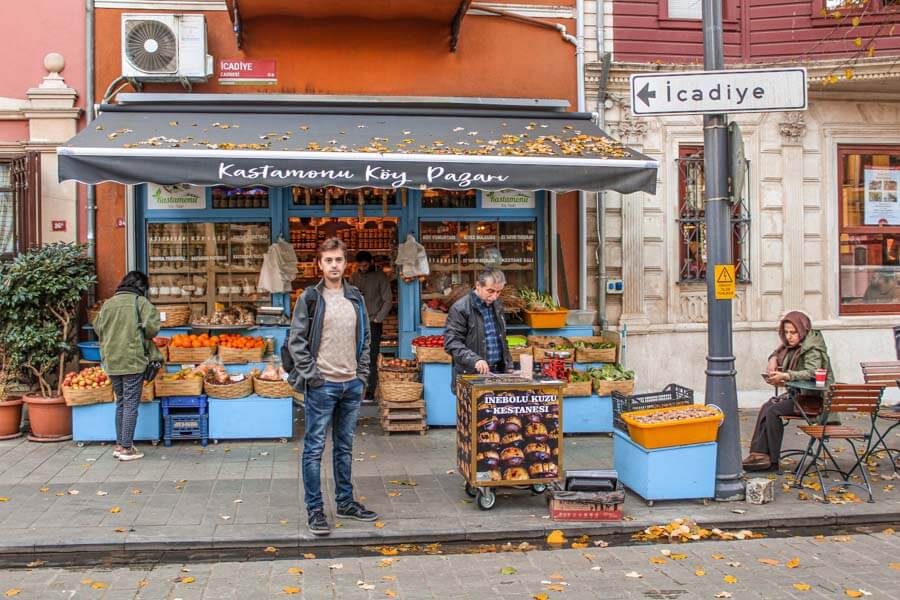
Oh well, where to start, there are just so many things to know about Istanbul.
First of all, Istanbul is huge. It is a many-sided, multifaceted city which you can visit endless times because on every visit it opens up from a new angle. Some parts of it remind developed neighborhoods of Bangkok or Saigon. Others look more like somewhere in Europe and there are also other areas where mysterious Doha or old quarters of Dubai come to mind.
Istanbul has amazing ancient historic architecture, thousands of quirky cafes and restaurants, and incredible views that you can access from anywhere, in any part.
This city, like many others that may come to mind, has its own smell and different neighborhoods smell in different ways. At the same time, it has many dirty, hectic, old streets and also very dangerous, sketchy-looking parts to avoid.
At times, Istanbul can be overwhelming with its sellers and bazaars, constant traffic, crowds of people, and noise from bars. And then, on other occasions, it is calming, exotic, and charming with all the cats, hospitable people, delicious foods, and a vibrant atmosphere.
In just this one city, you can live a very different life and have a different experience as a tourist, depending on the neighborhood and activities you choose.
Istanbul is a destination of incredible size. More than 15 million people live there on 2 continents while every day covering very long distances and spending time in traffic jams comparable to those in Los Angeles or New York.
Do not expect to find a distinct downtown or city center because there is none. Instead, Istanbul is divided into districts that have their own separate mini centers that are steeped in history and enriched with attractions.
This is why it’s best to make a plan of what you want to see and where you’re going to visit when you will be in the city. Istanbul is not a destination where you can go unprepared. It is absolutely not going to open up with a swoop, but instead can easily stun by the number of people on the streets or in the main tourist places as well as upset with tourist-oriented eateries and too annoying sellers.
Best Time to Travel to Istanbul
The best time for Istanbul travel depends on the goal of your visit. While one season can be great for shopping or fewer crowds, it can be not the right time for cruises and sightseeing. So it all depends.
However in general, no matter what’s the goal of travel is, the best season to visit Istanbul is spring and autumn. But to be more precise – April, May, September throughout November are the best months.
At this time, the weather is very pleasant, everything blooms (in November there is foliage), prices are noticeably lower, getting reservations is easy, and many festivals all over the city take place. And the best part – crowds of tourists do not storm every landmark and religious site.
I lived in Istanbul through all seasons and can say with confidence that spring and fall are really great for everything – for shopping, visiting palaces and museums, for walks in nature and even for some sunbathing if you wish.
Summers are usually too hot (especially July and August) and overwhelmingly crowded. Winters are rainy and chilly. Although for us personally, for many reasons, winter is an absolutely wonderful time to be here ( and this is why ).
So if you try to understand what is the best time to travel to Istanbul, look at the second part of spring and the entire season of autumn.
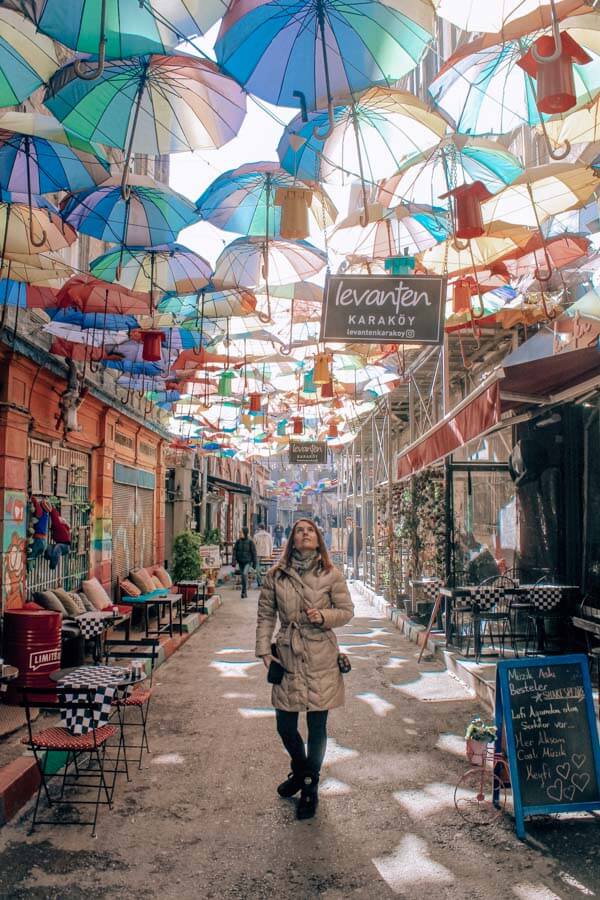
Is It Safe to Travel to Istanbul?
What do you imply by “safe travel to Istanbul”? If there are no terrorist attacks, no pickpocketing or if it is safe enough to wear short skirts and tops or drink beer in the middle of the main square?
I know and remember how in 2017, there was an explosion near Sultanahmet Square and another explosion on Istiklal Street (a popular walking street with shops). Also, there was a shooting in one night club on New Year’s Eve and a terrorist attack at Ataturk Airport. Oh, and then another explosion near the Besiktas stadium after the match. Yeah, there were some terrifying events.
In connection with what happened, Istanbul authorities started to increase the level of security in the city and since 2017 everything was quiet. The airports have enforced stronger security (it starts at the entrance, where the police inspect each car and also inside the airport where everyone is checked before entering the airport building).
In places of various events and crowds, there are always police officers. In Sultanahmet – the most popular tourist neighborhood in Istanbul, the police are always on duty. Istiklal Street and Taksim Square also always have police officers around.
That being said, Istanbul is a safe destination and welcoming to foreign visitors. But it doesn’t mean that you shouldn’t be aware of your surroundings. Of course, like any huge multimillion city, Istanbul has good areas and those that are better to avoid , scams, pickpockets, mugging, snatching, and crazy drivers take place too. But the same applies to Barcelona , Rome or Lisbon.
Nowadays, the biggest problem in Istanbul is corruption but it won’t affect you as a tourist. We, after living here for a while, haven’t experienced any of that, although heard many stories from locals.
The best part about travel to Istanbul for tourists is the fact that this city is very open and receiving of different nationalities and cultures. No matter what your race, religion or culture is, you are very welcome.
NOTE : When walking around the city you should probably have a copy of a document confirming your identity, no need to carry an original.
How Many Days to Spend in Istanbul
I would put it this way. There are too many places in Istanbul that are worth seeing. One and two days are never enough.
If you are visiting Istanbul for the first time , that’s the only city you plan to see in Turkey and your goal is in one trip to see as much as possible, then plan at least a week.
This is enough time to see all major attractions, explore one neighborhood at a time, visit a hammam (if you visited hammams in Marrakech , it will be a similar experience), get acquainted with local cuisine in full, go on a day trip to the Princes Islands or the Black Sea, and even drive a bit outside Istanbul.
If your goal is to travel to Turkey and only get a quick introduction to Istanbul, then the ideal time would be 3-4 days.
Honestly, only the main touristy attractions in Sultanahmet (such as Hagia Sophia, Blue Mosque, Topkapi, one of the underground cisterns) will take the whole day, if not more. Then you can devote another day to a walk along Istiklal, Galata Tower, Karakoy , and a cruise along the Bosphorus. Another day – a walk through museums, parks, and/or other lesser-visited quirky neighborhoods. And you also must spend at least one day on the Asian side.
Two days is too little. One day in Istanbul is usually better than nothing when you are on a long layover. But don’t deliberately plan a trip for this time since this is definitely not enough. With only 2 days in Istanbul, you may even get a wrong impression of the city.
I invite you to check my favorite Istanbul itineraries to choose the one which suits your needs better.
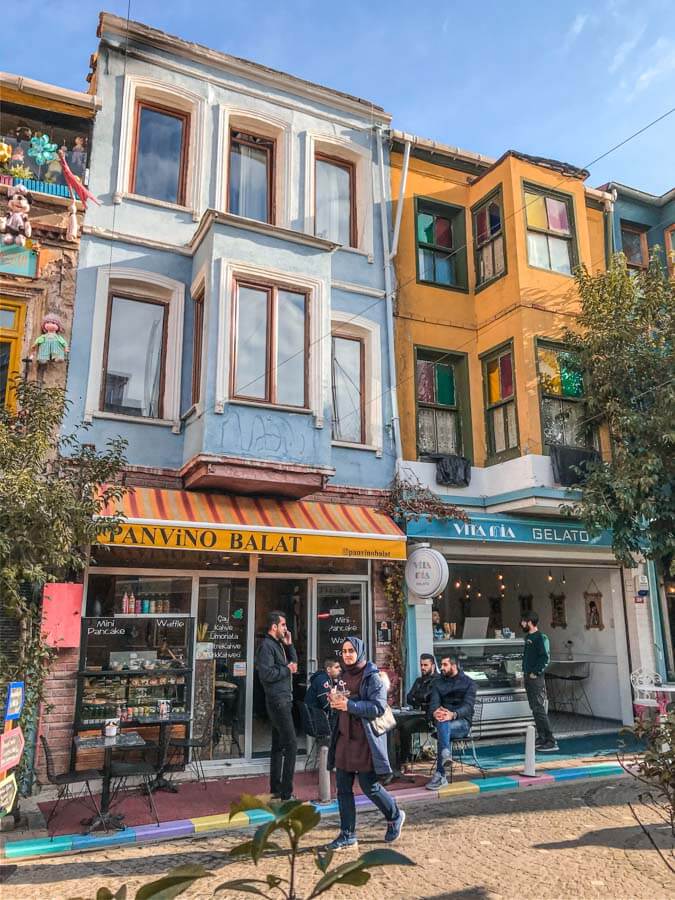
Do You Need a Visa to Istanbul?
Turkish government often changes visa rules for various countries. For example, some time ago many European countries, as well as travelers from the US, needed to apply for a visa in the embassy of their country. Then that rule was changed to visa on arrival but later it changed to e-visa obtained in advance.
Some countries are exempted from visas for their travels for up to 90 days like most countries in the Schengen Area and the United Kingdom. For Americans traveling to Istanbul (or Turkey in general) visa situation changes often. So make sure to always double-check the rules even if you think you know them.
The website of the ministry of foreign affairs of Turkey has the latest information. And our favorite resource where to get a visa (and check if you need it at all) is this one . We use it every time to apply for Mark’s visa.
Depending on the nationality, the price of a visa is different but the process of applying is the same for everyone.
To anticipate a question about whether a visa on arrival is available, I’ll say that yes but my number one travel tip here is not to take this route. The reason for this is that airline staff often isn’t willing to register a passenger on a flight without seeing the visa first. And if you do manage to fly, you’ll end up paying $30 more at the border in Turkey than for the online application.
And What About Insurance, Do You Need Travel Insurance for Turkey?
Travel insurance as such – no, but medical yes. All visitors to Turkey are required to purchase medical insurance before they enter the country. There is no minimum amount required, however, the condition is to obtain insurance for the length of the entire trip.
From July 1, 2020, Turkish Embassy also recommends adding coverage for treatment in case of covid. It is not mandatory but recommended.
When you choose medical insurance, do not purchase the most basic package unless you are 100% sure about your health.
Medical services in Turkey, and especially in Istanbul, are quite expensive for foreigners (unless you speak Turkish and can pretend you are a local). There is always a ‘special’ rate for foreigners who pay 3-4 times more than Turkish people when visiting a clinic.
Besides health insurance, it is always smart to add travel insurance which also covers medical emergencies, trip cancellations or interruptions, delays, evacuations in force majeure situations, and lost, damaged or stolen luggage.
For short or long trip medical insurance, I recommend referring to SafetyWing . We have been using this company for many years and like their seasonal deals and a good variety of policies available. Click here to get a quote from them .
Where to Stay in Istanbul
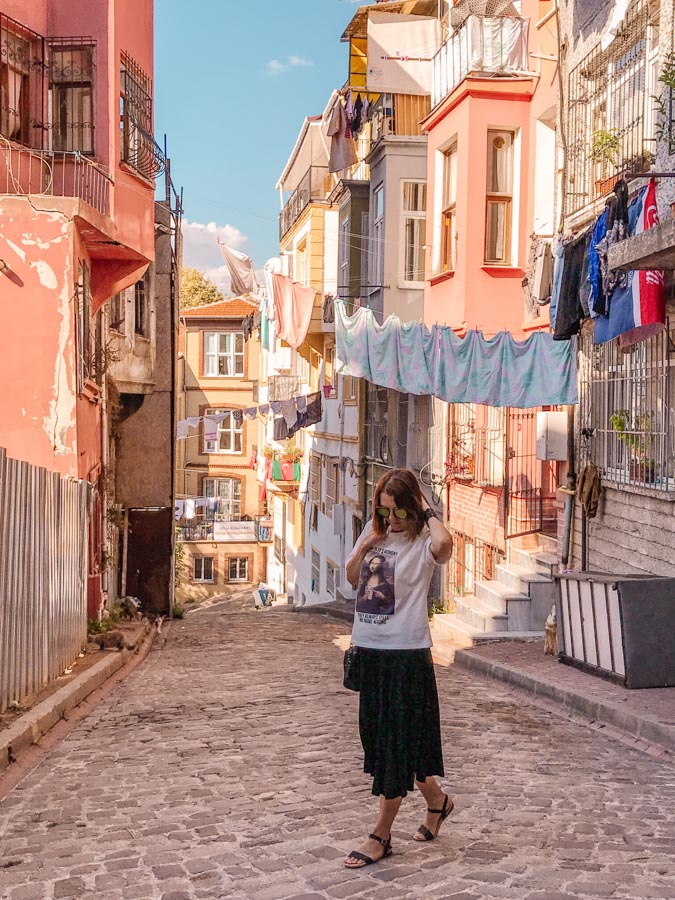
Where to stay in Istanbul is a very important question to ask since it will determine the quality of your trip. Staying in the wrong area can spoil any vacation. You need to learn about each neighborhood and district and decide if it will suit your needs.
In this guide to areas in Istanbul you can learn what to expect from each neighborhood and how to understand which one is better for you personally. Some of the neighborhoods suit better families with children, others are best for budget travelers, party lovers or business people. Study up on this topic before making any reservations.
And don’t forget to read my posts on cool and unusual hotels and Airbnbs in Istanbul . We stayed in some of them and I saved others to recommend on this blog. And here are a few more nice hotels that I like:
BEETHOVEN HOTEL & SUIT : A beautiful, yet budget-friendly clean hotel with friendly staff, delicious breakfasts and great sea views from the restaurant. The location is great since it’s very close to the main sights in Sultanahmet and a tram stop is right there nearby. Reviews are great and ratings are high! Check them out.
ZEYNEP SULTAN HOTEL : Clean, cozy and quiet hotel a few steps away from Hagia Sophia and Basilica Cistern. It is a perfect option for travelers on a budget who want to stay in the most famous part of Istanbul. Rooms have everything you need, including electric hot pots. Breakfast is served on a beautiful open terrace and in the evening, you can have tea and baked goodies.
THE MARMARA PERA : A stylish hotel in the area of Istiklal street , not far from the Galata Tower and Taksim Square. Being located in a busy neighborhood, this hotel is quiet and offers amazing views of Istanbul. There is also a rooftop pool and restaurant on the premises.
GEORGES HOTEL GALATA : Boutique hotel on a quiet cobblestone street in the very heart of the city. Everything is nearby, the rooms are beautiful, the food is good, service is exceptional, and views from the rooftop restaurant and spectacular! We’ve been there twice and loved it, I am sure you will love it too!
Why Not Forget to Pre-Book Your Accommodation
When planning a trip to Istanbul or any other popular tourist destination in Turkey, it is essential to pre-book your accommodation for a few reasons. First, because some resources for finding accommodation (like Booking.com for example) don’t work in Turkey. And second, because the best options are taken quickly.
Even if you use VPN or refer to another aggregator to book a hotel or flat, most of the time you’ll be left with not-so-good choices if booking accommodation at the last minute. Because best deals are booked well in advance.
Turkey is one of a few countries where I personally reserve our accommodation ahead of time because I know if I wait for too long, we’ll be overpaying for poor quality. Particularly when planning travel for the prime season and summer. During those times prices also go up, so the same hotel will cost differently for the same dates if booked with a small time gap.
That being said, if you want to score your best accommodation option and not overpay, book it in advance and as soon as you like it. It is better to cancel it later if you find something else that you prefer more.
How to Get From Istanbul Airport to the City
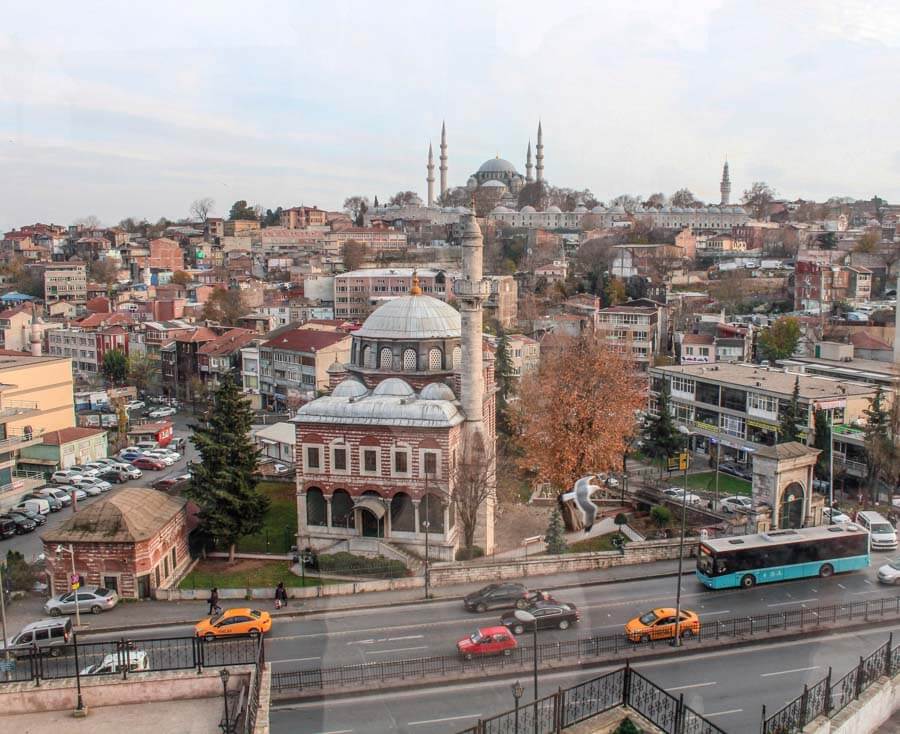
At present time Istanbul has three airports but only two are open to commercial passenger flights – Sabiha Gökçen airport and IGA (often marked as IST). Getting to and from each of them to different parts of the city is pretty easy.
The cheapest (and very comfortable) way to reach Istanbul center from the airport is by bus, either by:
- Havaist bus that provides transfers from Istanbul (IST) airport to many areas of the city.
- Havabus that runs between Sabiha Gokcen Airport and Kadikoy Pier or Taksim Square.
To find the Havaist bus in Istanbul airport after receiving the luggage, follow the signs indicating bus transfers. And if for some reason you don’t see them, then just look for the escalator going down (to the -2nd floor), where the Havaist buses stop. Besides the escalator, there is also an elevator.
To find the Havabus shuttle at the Sabiha airport, just proceed outside to the front part of the arrivals terminal, cross the road and you’ll find buses near the parking lot.
The fare depends on the distance of the route, so each route has its own ticket price. Prices start from $2 (that’s the price for the most popular transfers to Taksim square and Kadikoy) and payment is made on the bus by card or cash (in local currency if paying with cash).
If you prefer a private transfer with a meet and greet service, you can pre-book it online for a very reasonable price.
I also have a guide to Istanbul airport transfer from all airports if you’d like to get a more in-depth look.
How to Get Around Istanbul
Istanbul has modern and very diverse transportation. Some types of it are not very fast due to traffic jams but they are clean and safe. Istanbul has a metro, tram, buses, ferries, dolmush buses (shared taxis similar to marshrutka), and of course taxis with Uber.
For us, who live in Istanbul for a few months each year, using local taxis and dolmushes is not a very pleasant experience and I am not sure it will be for you.
With taxis, it is not so much about the high cost as the possibility of fraud by unscrupulous drivers. While cabs are supposed to have meters, not all drivers use them. Those that do can take a longer route to get to a needed destination, in this way making a foreigner pay more. But I guess this is a common problem for many cities, Istanbul is not the only one. Also, as a rule, at night, taxis increase the tariff.
Dolmushes or as they are also called local shared taxis, operate on most routes. However, you need to know exactly which one to take and how much it costs. Since drivers don’t speak any English, there will be no chance to ask about the route and price.
Another disadvantage of taking a taxi, dolmush or even a bus is traffic. It is a nightmare during peak hours every day.
This is why the best way to get around Istanbul is by tram, ferry, metro, Marmaray, and Uber .
Istanbul metro is clean and extremely safe. All stations are equipped with security posts and cameras. Until recently, the metro worked from 6.00 to 00.00. However, now it works around the clock on the night from Friday to Saturday and from Saturday to Sunday. This is great news for nightlife activists.
To find out how much each type of transportation costs and how to purchase tickets, see my Istanbul travel budget guide .
What to Wear in Istanbul
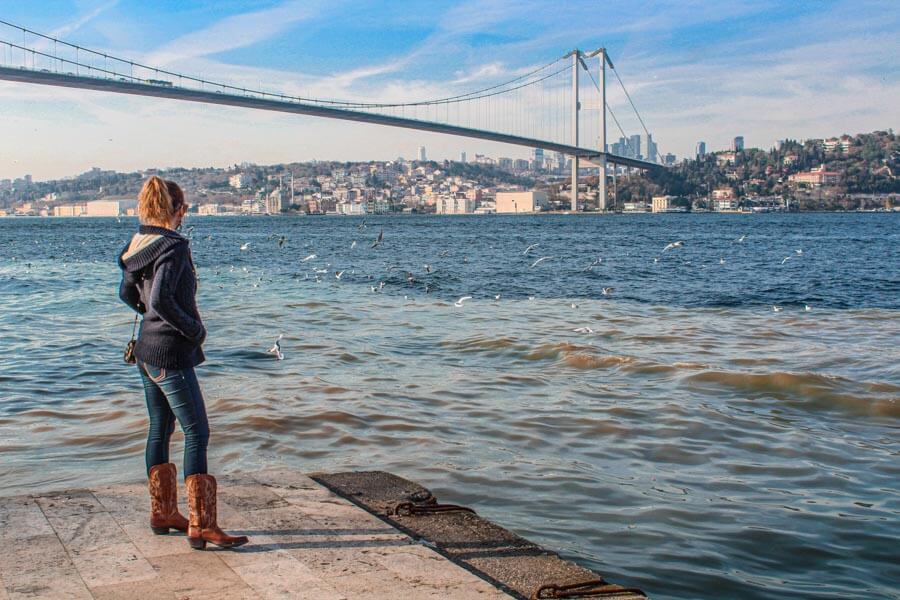
The question of the dress code for Istanbul constantly arises among tourists. I know that because I was asking myself hundreds of questions before my first trip. And until this day I have friends and family members who are constantly asking me the same.
When packing for Istanbul, you need to remember that despite the official status of Turkey as a Muslim country, most of the Turkish laws related to morals are based on secular ethics. In Istanbul, you clearly see the trends of Europe that have touches of the East. Jeans, blouses, dresses, ponchos, waistcoats, jackets are all popular here. Istanbul is not very conservative but Islamic traditions still influence local clothing.
The general law of the Turkish clothing style is maximum simplicity . Don’t wear too revealing clothes which show too much body. Although Turkish women may wear tight or fairly open outfits, women in short skirts and a low neckline may face condemnation and censure. You don’t need others to talk behind your back and point at you.
If you are a woman, choose to pack elegant dresses , modest and neat outfits that cover the hips, shoulders, and upper arms . In colder weather in Istanbul, you can wear a sweater with long sleeves, a skirt, or a dress to the knees . If planning to visit mosques and don’t want to wear scarves given at the entrance, choose a hoody. A hood can cover your head instead of a scarf.
In summer, Turkish men and women rarely wear shorts outdoors. They prefer them only if the shorts reach a knee. If you don’t want to stand out as a tourist whom people will be staring at, try not to wear very short shorts in Istanbul. Also, this applies to both men and women, it is better not to wear sleeveless shirts on the street.
If you see a guy in Istanbul wearing bright colors, most likely that’s a tourist. Local men prefer the restrained colors of shirts and trousers – from white and black to several shades of cream and blue. Women, on the contrary, love to combine lots of bright colors.
What to Know About Turkish Culture & Etiquette
Istanbul throughout its history has always been either the capital or an important trading center of many civilizations. Thanks to this, the city has absorbed completely different religions, cultures, customs, and architectural styles. It is home to representatives of 72 nations who have contributed to making Istanbul a cosmopolitan city.
Turkish people are generally very friendly and helpful. You may find some of them a bit intrusive and even cloying but that is just the wrong impression because they really try to be nice to all tourists and each other. That’s part of the culture.
They love music, parties, and getting together with families and friends in the evenings after work or during the weekends. This is why you’ll be noticing many groups of people by the sea or in the parks (or anywhere in the city where there is a green lawn) with their own camp chairs and tables, and food (and always sunflower seeds, haha). They can be spending hours having picnics or just enjoying a beautiful setting in each other company.
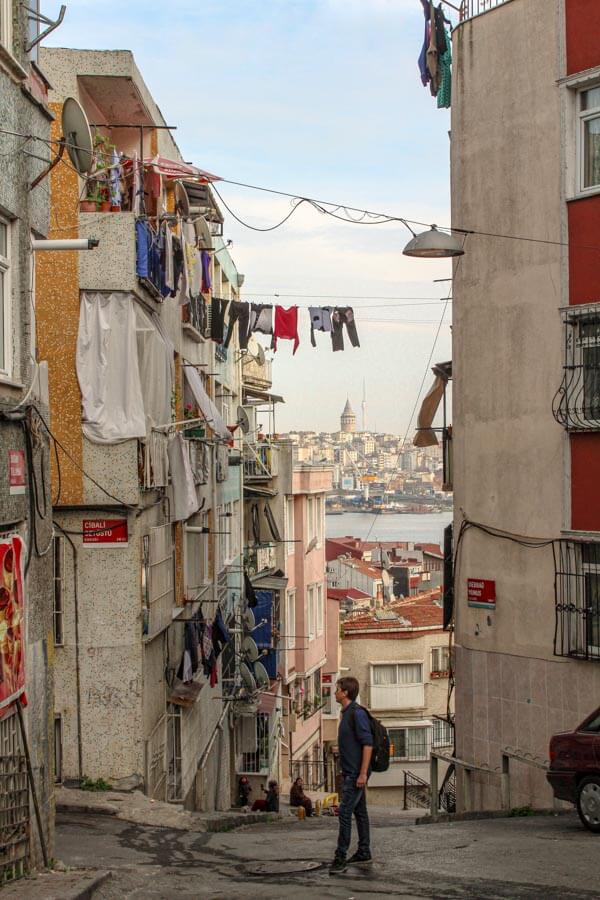
For the same reason, there are tons of cafes, bars, restaurants, and just street food kiosks that are always full of people. Because the food culture in Istanbul is massive. It is customary to eat out and actually spend a good chunk of time in restaurants while slowly eating or prolonging the pleasure of tea drinking.
Turkish people also have a reputation for politeness, so you’ll often hear ‘pardon’ on the streets of Istanbul or ‘teşekkürler’ (thank you) which they also expect to hear from others.
The culture in Istanbul is also very diverse, which is one of the many reasons why I love spending a few months a year there!
Besides Turkish rich cuisine, you can find cuisines of other nations together with various celebrations and festivals. There is always something going on in Istanbul, including the world’s largest conferences, forums, concerts, and shows.
Istanbul can definitely stand in line with such cities as London, Brussels, Amsterdam, Vienna , and others where life abounds around the clock and where you can feel welcome.
Istanbul Travel Tips for First-Time Visitors
Know turkish money.
This isn’t really an Istanbul travel tip, more of a Turkey travel tip, but you still need to know that wrapping your head around the currency is all-important.
In Turkey, the national currency is the lira. If you are wondering what money to carry with you, then it does not matter. You can come with dollars, euros, pounds, swiss francs. Many types of currency can be exchanged in banks or exchange offices. In addition to them, you can also exchange currency in chain stores (like Migros for example). There you will receive change in lira at a good rate.
The Turkish lira is very unstable and with each year keeps losing its value. This is why the exchange rate is always floating and it doesn’t even make any sense to write down here what it is. At the moment of updating this post, $1 equals 18 lira but it may change in a week or month. So I always recommend checking the rate closer to a trip once again.
Do not exchange money at the airport (unless you need a bit to pay for the bus) or at the hotel reception. The exchange rate there is always low.
Take Some Cash With You Before Arriving But Not Too Much
It will be smart to bring some cash with you instead of getting it from Turkish ATMs. Almost all of ATM machines charge a withdrawal fee in the amount of 5-7% and some give out money at a lower exchange rate. The fee comes either as a percentage or a flat rate, but you still get to pay a high amount for a transaction.
But the thing is, you don’t even need much cash in Istanbul. The payment system in the city is very well technologically advanced, so you can pay by card or contactless pay almost anywhere you go. Only except for some street food stalls, markets (although we paid by card there too), and small convenience stores.
This is why in order not to hustle, just take some cash with you from home and pay for the rest by card.
Other times when you’d need to have cash are when you want to tip, pay for dolmush or cab. In all other cases, you can do a cashless transaction.
In fact, in many places (like grocery stores or restaurants) there is even no limit set on card purchases. After so much time spent in Istanbul, I still can’t get used to the fact that in a store you can even pay by card for one tomato, which costs 20 cents.
Get Istanbul Transport Pass Right Away!
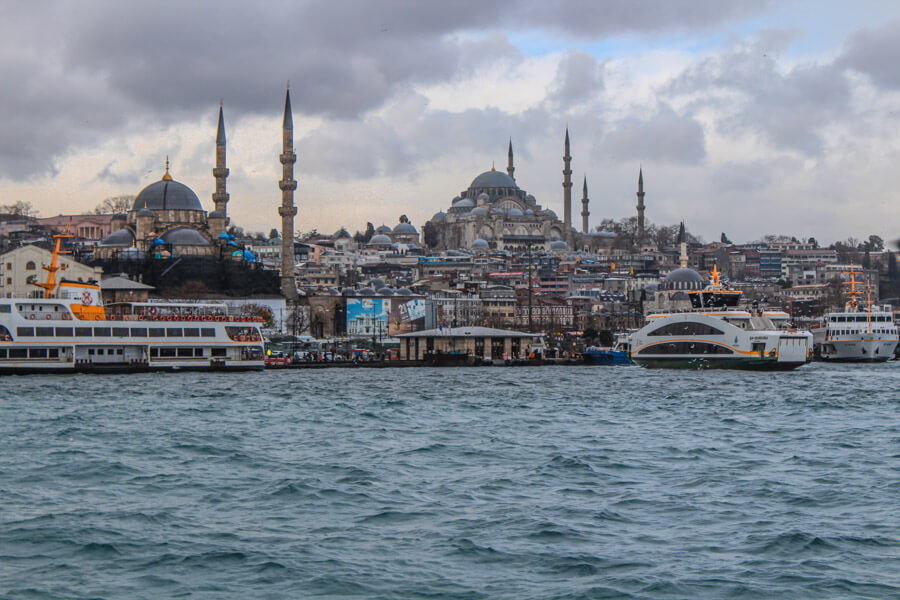
Istanbul is a city where public transportation can be expensive and cheap at the same time. It all depends on how you pay for it. If buying a ticket from the ticket booth every time before taking a metro, bus or tram, it’s going to be 35%-50% more expensive than when paying the fare with a transport pass called IstanbulKart .
There are many types of transport passes available but the best one for tourists is Anonymous IstanbulKart which costs around $1.5 (25TRY) and comes without credit. It is great for couples or families who can use it for up to 5 people. With this card, you get a discount for each ride on public transport. Also, if making a transit within 30 minutes after the payment for the first ride, you’ll have another discount for the second ride, third, etc.
It is well worth buying IstanbulKart even if you might use public transport only a few times. It’s not going to be only cheaper but will save you time. Lines for Marmaray, ferry or tram tickets are often long.
NOTE : You can buy IstanbulKart pass in many kiosks, newspaper stands, metro and ferry stations around Istanbul. It is also available via the yellow/blue vending machines by the majority of public bus stops and metro/ferry stations. Lately, also another option came up when pass is available for purchase online. Just type ‘IstanbulKart’ on Google Play or App Store to find out the details.
And then you can always order it online with a pre-charged travel balance for 5 or 10 journeys and have it delivered to your accommodation in the Taksim area or Sultanahmet. This is a very convenient service for travelers who have a short trip to Istanbul .
Buy a Sim Card to Make Things Easier
How are things in Turkey with mobile services and Internet for travelers? Well, that’s a good question. While buying a sim card is not a problem, the choice of options is very narrow.
Turkey is not like many other countries where sim cards are either free or very cheap to get. Quite the opposite, they are on the more expensive side and have some limitations. Yet, you’d still want to purchase one to stay in touch without restrictions and overpayments.
So the thing that you need to know is that Turkey has 3 main mobile operators which are TurkTelekom, TurkCell, and Vodafone. Each of them has almost identical list of services and a similar cost. Internet speed level and connection quality are the same.
The only feature that makes Vodafone stand out is their “like at home” rate which has some great benefits for those tourists who already have a SIM card from Vodafone in one of the European countries. Other than that, it offers the same packages as other companies. All mobile operators are good enough and which one to choose depends more on personal preference.
On average, the most popular package for tourists that includes decent internet coverage, some minutes and messages costs around $20. The duration of this sim depends on the country of origin a tourist is from. Since some nationalities are allowed to enter Turkey for different duration (from 1 to 3 months), the expiration date of a sim card will depend on that.
Besides a sim card, many people also choose pocket wifi . While this is a much more expensive option, it is very reliable and easy to get (by delivery). It works best for short-term visitors who come for a maximum of up to 2 weeks and also need to work remotely while on their Istanbul vacation.
Download These Helpful Apps Before You Travel
Use your phone not only for taking photos but as a personal travel guide by downloading these apps that are very helpful on a trip to Istanbul:
- Google App – particularly a ‘translation’ feature where you can translate anything with your camera. Very convenient when you need to translate quickly signs on the street, menus, items in the grocery store, etc.
- Google Maps App – is very precise about transportation schedules and routes as well as traffic gems. Download a map of Istanbul so you can use it without data when offline.
- Uber – officially back in Turkey and is slightly a cheaper alternative to taxis.
- BiTaksi – Turkish version of Uber which is very popular among locals. It will help you get a cab in less than 5 minutes and you can pay for a ride with a card.
- Yemeksepeti – the most popular app in Turkey for ordering food (in case you don’t feel like eating out) with the biggest database of restaurants. Everything gets delivered within 15-30 minutes.
- Getir – alternative to yemeksepeti that let’s you do grocery shopping online and all other items that are on sale in grocery store, be it dog’s food, hygiene products or even basic clothes.
Stay as Centrally as You Can Afford
Different people have different views on this tip for the Istanbul trip . Some may advise staying further out and taking advantage of Istanbul’s extensive, cheap, and reliable public transport system. While others will recommend fancy but distant neighborhoods like Nisantasi in Sisli, Besiktas, Balat , or even Sultanahmet.
My mind is set differently. I’ll keep saying again and again that you should stay as centrally as you can afford. And none of these neighborhoods is central.
When you’re trying to see as much of Istanbul as possible, you want somewhere that’s well-connected, from where you can get to other parts of the city within equal time without too many transfers, and from where you can walk to many of the sights without using transportation.
For the first trip to Istanbul , I recommend staying in Karakoy, Eminonu, Cihangir , Kabatas, and the area around Galata Tower. But you can also read my extensive guide to the best areas in Istanbul to help you choose the best neighborhood where to stay.
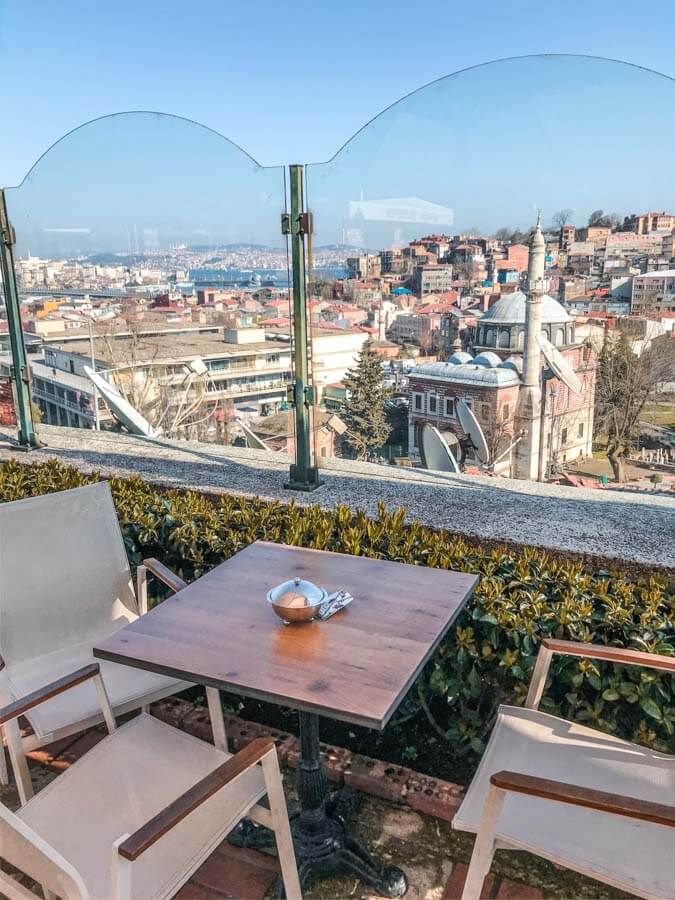
Do Not Drink Tap Water in Istanbul
Tap water in Istanbul is not safe to drink. The reason for that is the amount of chlorine and alkaline substances in it which are added in increased concentration not safe for drinking. Most government officials claim that the water pumped into the city is within the safety standards, yet they also talk about the higher levels of chlorine added to water to kill the bacteria.
Another reason not to drink tap water is the old pipeline system which has a high level of lead and rust.
There are two ways out of this situation – buy bottled water or use city fountains with drinking water. There are quite a few fountains in the city center and the water there is coming from underground springs. It is clean and you shouldn’t worry about drinking it.
For bottled water, it is cheaper to buy bigger (5 or even 10 liters) canisters.
Learn Some Basic Turkish to Make It Easier to Communicate
I get that. Trying to learn even a few words and sentences in a new language can be tough. But if you put some effort, it can be very helpful for many reasons. People in any country always appreciate when foreign guests try to speak the local language even with 1000 mistakes and a horrible accent.
In Istanbul, Turkish people will be amazed and grateful for that even more.
If you already speak a few languages, picking a few words in Turkish will be easy. Even if you don’t speak any foreign languages, don’t assume that Turkish is hard. In fact, it is not. Learn the alphabet which will help you read a lot of words and remember that all words in Turkish are read the way you see them with emphasis on the last syllable .
Some useful phrases that you might want to learn before your trip to Istanbul and Turkey in general include:
MERHABA – Hello
PARDON – Sorry
LÜTFEN – Please
TEŞEKKÜR EDERIM – Thank you very much
NE KADAR – How much?
Be Meticulous When Packing Your Suitcase
Besides those tips on what to pack for Istanbul that I mentioned above, you should also remember a few others.
First one is that pharmacies (Eczane) in Istanbul, and throughout Turkey, do not work at night and on Sundays. Usually, they are open from 09:00 to 20:00 on weekdays. There is only a small number of “pharmacies on duty” that work at night and on Sundays and the addresses for them can be found on any door of a pharmacy that is closed during this time.
With a big number of pharmacies around each corner, buying most medicines is very difficult since they need a prescription. This is why do not forget to pack a first aid kit with the essentials and travel medical insurance.
Those who love taking a bath should bring along a universal bathtub drain stopper (no kidding). If you plan to take a bath in Istanbul (or in Turkey in general) then such devices are practically not available (except for luxury hotels).
Also, it is difficult to find an insect repellent on sale in Istanbul (and during summer evenings bugs will definitely bother you). If traveling in summer, don’t forget to take it along with sunscreen and a hat. The sun here is merciless, and you can burn in literally half an hour.
Visit Mosques & Churches for Free!
And here is my Istanbul tip for tourists who love seeing religious sites – remember that all functioning mosques and churches are free to visit.
With more than 3,360 mosques in Istanbul among which some are true architectural masterpieces, you shouldn’t miss an opportunity to see the most significant of them. At any time on any day, all mosques are open to all tourists except for the time during prayers.
This means that one of the most famous mosques (actually Byzantine churches in the past) Hagia Sophia is also free to visit now (good news to budget travelers!). It has been turned into a mosque since 2020 and the entrance fee was dropped.
You can read more about the most beautiful mosques and religious sites in Istanbul to decide which ones to add to your Turkey itinerary . And scroll down to find out about the etiquette for visiting mosques.
All churches in Istanbul that are active (not museums) also do not charge any entrance fee. Although many of them open only for service time, on Sundays and Christian holidays.
Helpful Istanbul Tips and Tricks for the Best Experience
Always bargain when shopping in the markets .
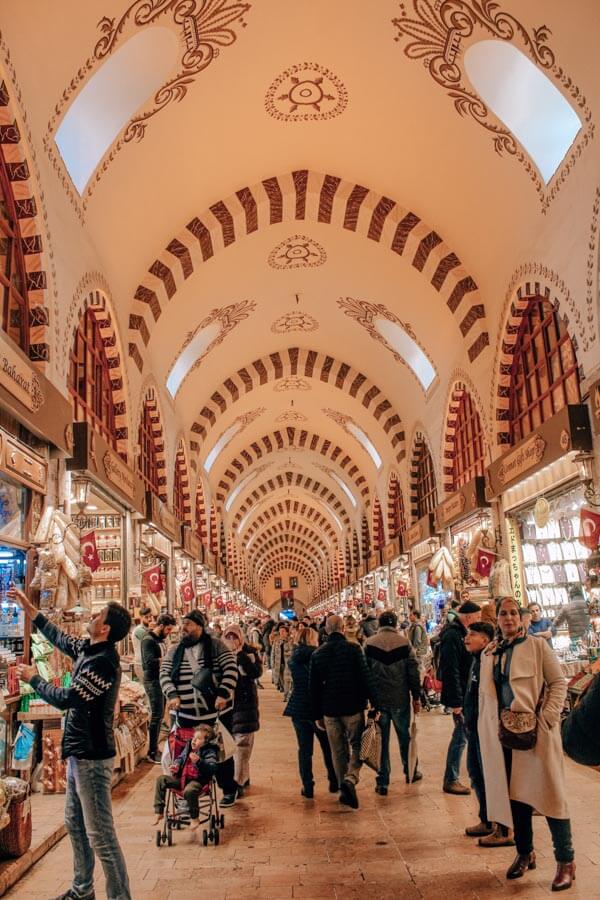
When buying something in Istanbul bazaars, be sure to bargain. In this way, you won’t only reduce the price (which is initially very high), but also pay tribute to local customs. Bargaining is part of a local culture and every local does it.
In order to successfully haggle in Istanbul (and all over Turkey), you need to prepare a bit for this exciting process.
On arrival, do not rush to buy things in the first shop you come across. In the beginning, get acquainted with prices in the market. In Turkey, prices for everything are always and everywhere too high. So it would be smarter to visit at first at least 3-4 stores to get an idea of how much things cost and only then return to the store where you intend to buy something.
When entering the store, do not rush to demonstrate your interest in the item you like. Try to behave as indifferently as possible. Act like you don’t need anything and pretend that you are just looking around without a goal to shop.
Istanbul markets never have price tags, so the best discount to aim for ranges between 20-80%, depending on the product. Among all items on the market, leather products are most of all overpriced up to 80% when prices for excursions or souvenirs are only 20% higher. Feel free to tell any price you want and then go from there.
But no matter what, remember this one important tourist advice – in no case should you say anything negative about the product. If you don’t like it, better regretfully say that you cannot afford it.
If you don’t feel comfortable haggling, then better go shopping at malls and shops. There is no shortage of them.
Do Not Skip Asian Side
Many tourists who visit Istanbul mainly concentrate on the European side of the city, skipping the charms of the Asian side full of many cute neighborhoods. Even if you are on a 2 or 3-day trip to Istanbul, find time to hop on a ferry from Karakoy or Eminonu and go at least to Kadikoy.
“Asia” of Istanbul is a long strip of land that stretches along the coast of the Bosphorus and is conventionally divided into three main regions – Kadikoy, Uskudar , and Beykoz. Each of them is full of hidden gems and authentic treasures. Although the easiest one to visit is Kadikoy as it is well connected with many neighborhoods on the European side.
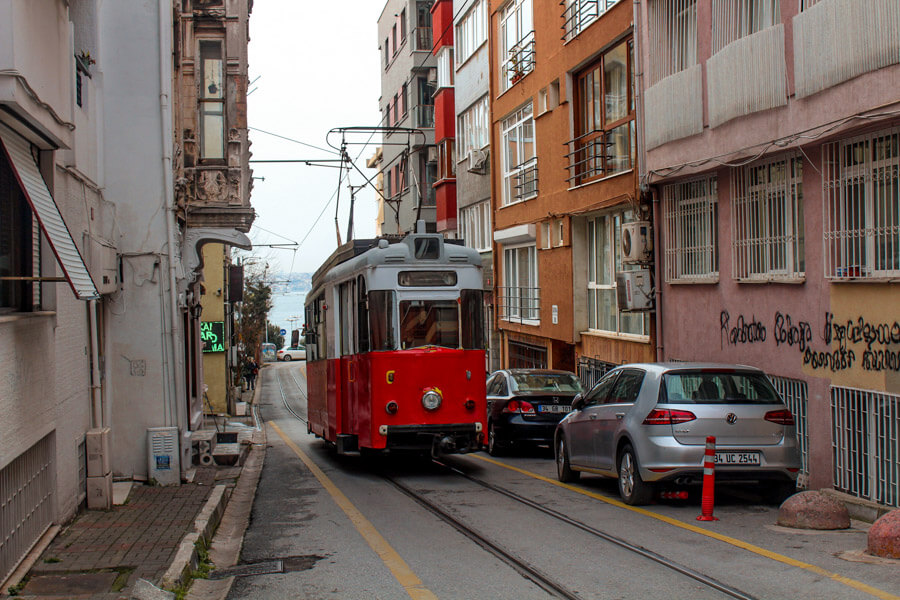
In fact, Istanbul actually began as an Asian city in the oldest district of Kadikoy. Its progenitor was the ancient city of Chalcedon, which the Dorians founded even before the creation of the mighty Byzantine Empire in 680 BC. e. From that time, streets with descriptive names like ‘Moda’ (meaning fashion), ‘Sanatkarlar’ (craftsmen) or ‘Antik’ (meaning antique) and many markets have been preserved here.
And today they have a huge historic value for the tourists. So the oldest settlement on the Asian side today is a rich, spacious and respectable area where people come to take a break from the bustle of old Istanbul.
Do Not Bother Driving
Driving in Istanbul is a headache I really wouldn’t put yourself through unless you absolutely have to. But you really don’t need to thanks to a wonderful transportation system.
During the time when I lived in Istanbul and since then when I return for 2-3 months each year, I rent a car only on those days when Mark and I go to the Black Sea coast, on a day trip south or east, or when we want to road trip to Fethiye or Bodrum .
If you also want to go on a few day trips from Istanbul and see what is there outside the city, the best company to rent a car is DiscoverCars . It is a great pick for people on a short Istanbul holiday as all companies listed on their aggregator are located at the airport, service is wonderful and prices are the lowest. Getting to the airport is always easy and quick and companies work around the clock.
There is also another company that I like to rent from that represents only local agencies but they work better for other goals. You can read more about it as well as about all driving tips in my guide to car rent in Istanbul and Turkey .
Take a Day Trip Out of Istanbul
In continuation of my previous thought – I strongly encourage you to go out of Istanbul and learn more about Turkey through a visit to another destination. Particularly knowing how many cool places are easily day-trippable from the big smoke.
One of Princess Islands , for example, is the first one that should be on your list. With its age-old architecture, dreamy beaches, and easy access, you can add it to your itinerary without too much extra planning.
Among other places, some of my favorites are Garipce village and Kumkoy on the European side of the Black Sea coast, Silivri with organic farms, Anadolu Kavağı, and others that you can find in my guide to self-guided daycations from Istanbul.
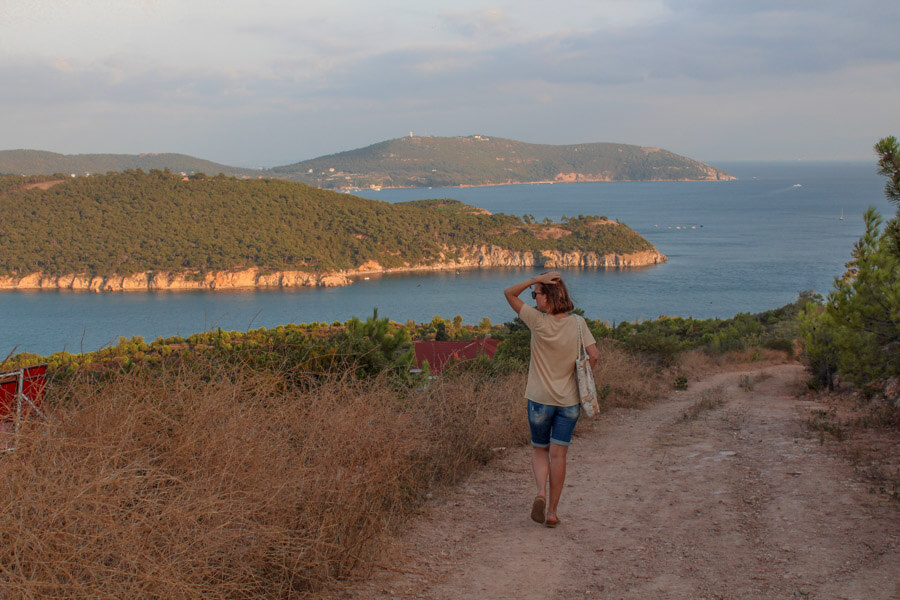
Use a Bosphorus Ferry Instead of Taking a Bosphorus Cruise
There are plenty of touristy yacht cruises plying the Bosphorus Strait. Like a guided half-day Bosphorus cruise or a longer version of a day cruise with lunch . There’s nothing wrong with them and they have their own benefits. But did you know that you can hop on a public ferry from one continent to another and pay less than for a cup of cappuccino?
It’s one of the best Istanbul tips for tourists that many people don’t know about.
When you get to Istanbul, you’ll notice how many vessels loaded with passengers scurry along the shores on a daily basis. Some of those vessels are public ferries while others are private ones on a tour.
You also want to experience a public ferry ride and see the city from the water. It is one of the must-do things in Istanbul that doesn’t cost much. And if budget with time allows, only then go on a private cruise.
TIP : For the best experience with a public ferry, at the port, buy some Turkish delight or baklava, and on the ferry order Turkish tea in miniature glass cups. Also, stock on bread and feed the seagulls. They are going to be an amazing addition in your photos.
Do Not Book Your Accommodation Near the Mosque if You’re Not an Early Person
You can easily apply this Istanbul advice to any other city in Turkey, really. If you don’t want to ruin your trip, then before booking accommodation, check if there is no minaret with loudspeakers to your hotel or Airbnb.
Being anywhere near the mosque means that Azan will wake you up every single night. Since almost all mosques have loudspeakers that are used five times a day (sometimes even more) and they are so powerful, everybody within a 5 km distance can hear the message.
The earliest prayer is performed at dawn (the time depends on the time of the year) and usually lasts between 20 to 30 minutes. The second call to prayer takes place in about 2 hours right after that which will be waking you up again.
Even though the first early Azan is incredibly melodic, it still serves as an alarm clock for everyone in close proximity. Especially for those tourists who come from small quiet towns or countryside.
In fact, one of the most unique things to do in Istanbul is to get up in the middle of the night and head to a nearby mosque to listen to the call to prayer and watch others come for prayer. But waking up every night because of it can be somewhat stressful for most people.
Not all mosques have loudspeakers. So to be completely sure, you’d need to contact the host to clarify this question if you see a mosque on the map near the potential accommodation.
Remember About the Cats When Booking a Place to Stay
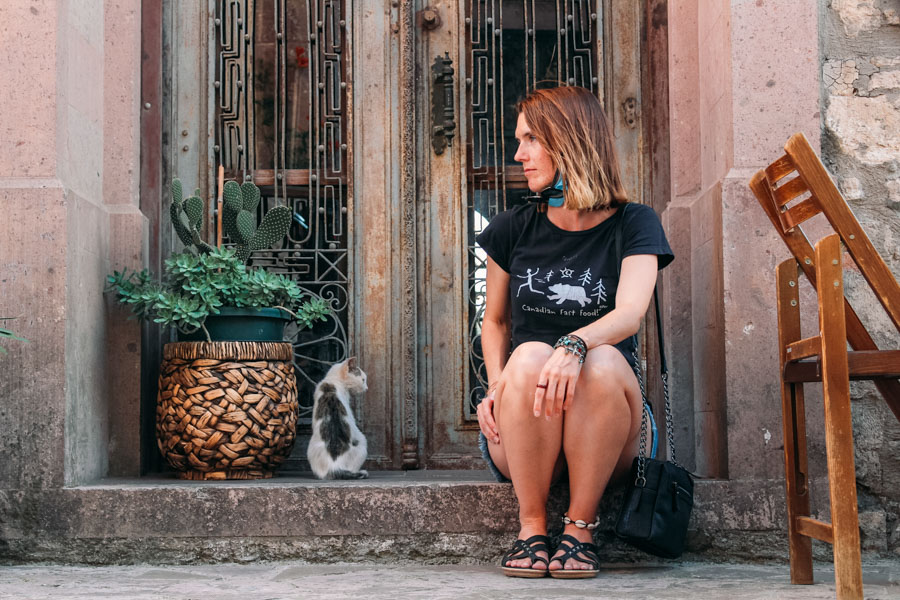
My other Istanbul insider tip is specifically for people who are allergic to cats as cats’ culture in this city is enormous and they are always kings.
Cats are really everywhere and they seem to have their own life separate from people. Today, interestingly, cats are one of the attractions of Istanbul to that point when “pat and feed attraction” is even included in the tourist list of “must do” things in Istanbul.
Only here, in this city, visitors can get cats’ food in special vending machines in exchange for plastic waste. Only here, the mustachioed tabby cats are regarded as community pets who are allowed everything. They can jump on a table in a cafe, walk into someone’s house, steal food from merchants, or lie down in the middle of the sidewalk. No one will ever think to drive them away or do anything harmful. In Islam, there is a belief that the one who killed the cat will beg for forgiveness from God only if he builds a mosque.
So, no matter what you think of cats, you need to get used to the fact that they will be surrounding you in Istanbul everywhere. Also, that many people owe cats and rent their flats out to others who come with cats on a vacation too.
Due to this, many hosts don’t clean their homes for pet allergies. Most just do a regular cleaning that even worsens a problem for sensitive guests.
I lived in many apartments around Istanbul and in each of them, there were cats. I knew it right from the first minutes after crossing the threshold of the house. One time it was so bad that we asked a host to arrange a deep pet-allergen cleanup.
Thus, if you are severely allergic to cats too, you need to make extra preparation for a visit. First of all, don’t be afraid to contact the host and let them know about your allergy and second, don’t forget to pack antihistamines.
Try to Avoid Staying Near Taksim If You Love Peace & Quiet
When it comes to accommodation, my number one Istanbul tourist advice for everyone who loves quietness is not to stay near Taksim Square and Istiklal street. The Taksim area almost never sleeps and is always incredibly loud.
With all the bars and restaurants where music is on until 5 am and with constant crowds and noise, you won’t be able to sleep. Even soundproof windows won’t help.
Staying in Taksim is great for party lovers and everyone who is planning to stay up all night long. Others, especially those who travel to Istanbul with kids, should avoid this area. Come to visit but not to stay.
Do Not Start Your Day With Coffee & Don’t Drink It With Milk
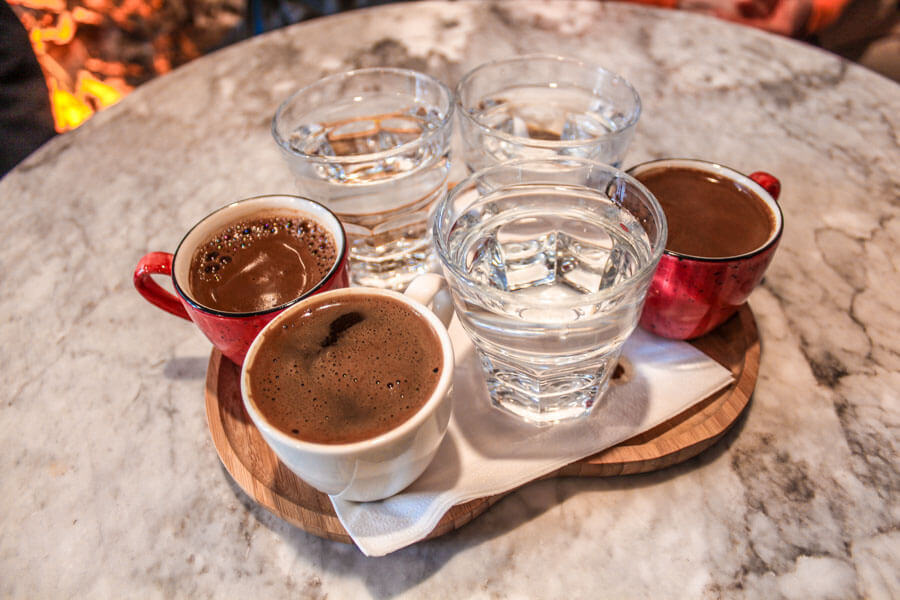
My other Istanbul advice for tourists is about the famous Turkish coffee. In Turkey, people take coffee seriously and believe brewing it is a form of art.
They never drink it before breakfast or with milk. Local baristas keep their recipes a secret and claim that you can brew the right coffee after you have already done it 300 times. Before that, it’s just continuous training.
If you want to feel like a local, don’t drink coffee first thing in the morning. Have it after breakfast or better leave for early afternoon. Instead, start your morning with traditional black tea (cay) in a tulip-shaped tea glass.
Be Sure to Indulge in a Street Food in Istanbul
When it comes to food, my all in all Istanbul tip for tourists – you have to try the street food! And not only if you are a budget traveler.
The street food scene in Istanbul is incredibly rich (as rich as street food in Vietnam or local eats in Ubud ) and inexpensive. There are hundreds of cafes that don’t look very presentable but the food they offer is heavenly.
For the most part, street food in Istanbul has a high standard of hygiene (except for several individual sellers but you can easily spot them) and is fresh. Many times, it is also as good (or even better) as restaurant food .
Some of the must-try Istanbul street food picks are : pilav with various toppings, kumpir (stuffed baked potato), grilled corn and chestnuts, kokorec (sandwich with lamb or goat intestines), gozleme (flatbread with different fillings), icli Koftecisi (Turkish type of meatballs), borek (pastry with cheese, potatoes or spinach) and balik ekmek (fish sandwich).
One of the best ways to learn about the food, especially if you are short on time, is to join a food tour. I personally had a chance to go on two tours 10 tastings of Istanbul and a food tour on two continents . Both of them taught me a lot about Istanbul’s food even though I spent so much time in the city discovering food scenes on my own.
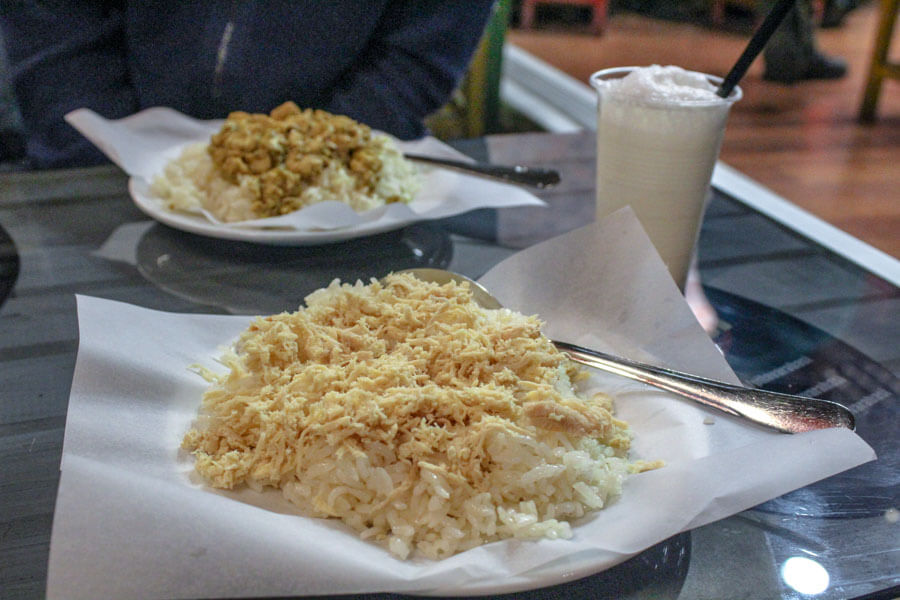
Oh, And Don’t Skip Breakfast
Where, where, but in Istanbul, you just can’t skip breakfast!
Because Turkish breakfast in Istanbul is a whole ritual of delicious food and small plates. It is popular both at home and in cafes with restaurants, and the main day for breakfast is Sunday. Since Sunday is a day off and there is an opportunity to gather with the whole family while taking it slowly.
The first meal of the day in Istanbul is always filling although not always expensive. You can choose one of many foods or go with the largest plate suitable for your budget, the choice is big! Just follow my tips for Turkish breakfast ideas to understand what people eat in Istanbul in the morning.
And remember one golden rule – many cafes serve breakfast all day long!
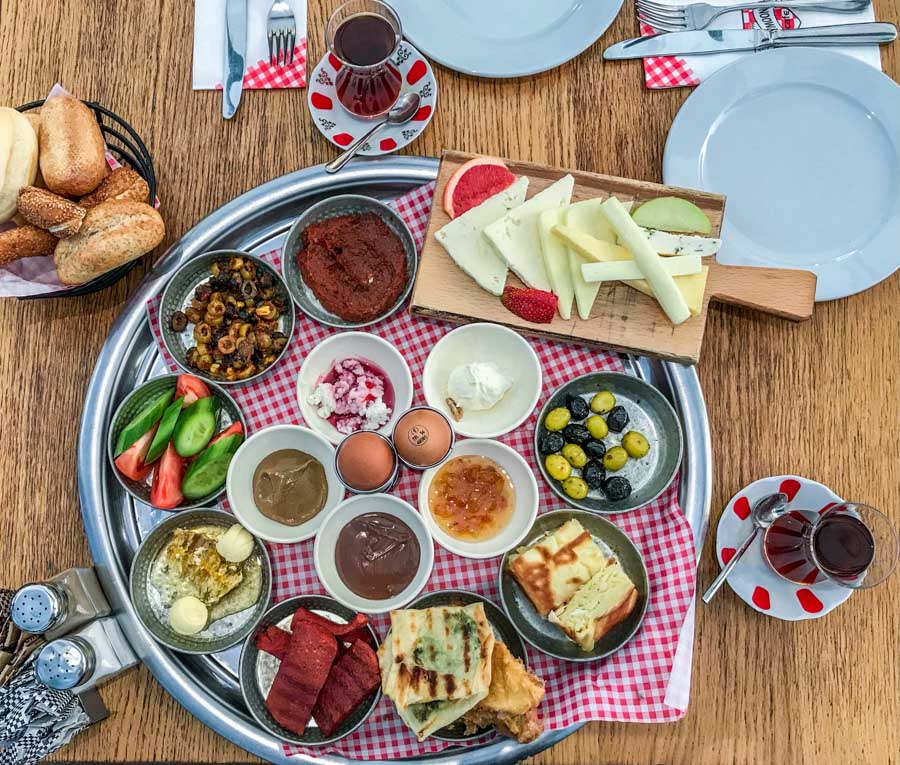
Istanbul Tips for Tourists to Make Things Easier
Purchase istanbul museum pass.
Almost every European city sells museum passes that save on entrance tickets to some attractions or give discounts on them, offer different bonuses and the right to travel for free on public transport. Istanbul is not an exception here.
Its Museum Pass, which is valid for 5 consecutive days, allows visiting many municipal museums together with some major historical monuments without a queue and for free.
However, among all Istanbul hacks, this one will work best for people who plan to spend at least 3 days in the city and complete a program “maximum” during each day. The card is especially helpful during the high season when queues are very long at many attractions and you don’t want to waste time waiting.
To save time and not stand in line for a card, you can buy it online and use its QR code on the mobile at the entrance to sites. And to learn more about the pass, its alternatives, and evaluate if buying it is going to make much sense for you, read my review of the Istanbul museum pass .
Do Not Forget Comfortable Shoes
Istanbul is called the “City on Seven Hills” for a reason. The Roman, Byzantine and Ottoman empires built Istanbul on 7 hills that make up the historic parts of the city today. Besides hilly neighborhoods, many streets are either cobbled or have relief stones. This in turn makes walking a bit harder.
Considering this and the fact that Istanbul needs to be explored on foot, you need to take care of comfortable shoes. Do not take shoes with heels, on a large platform, and flip-flops for summer. Pack comfortable footwear.
The ‘most challenging’ hills are in Kabatas/Galata area as well as in Besiktas. To conquer some of them, you can always hop on the old tram or underground funicular (Tunel). This Tunel is the second oldest subway in the world (after London) with the shortest subway line. Located in the European part of Istanbul, it serves to simplify and speed up the movement of passengers between two areas – Galata, which was once the financial and commercial center, and Beyoglu, the heart of social life.
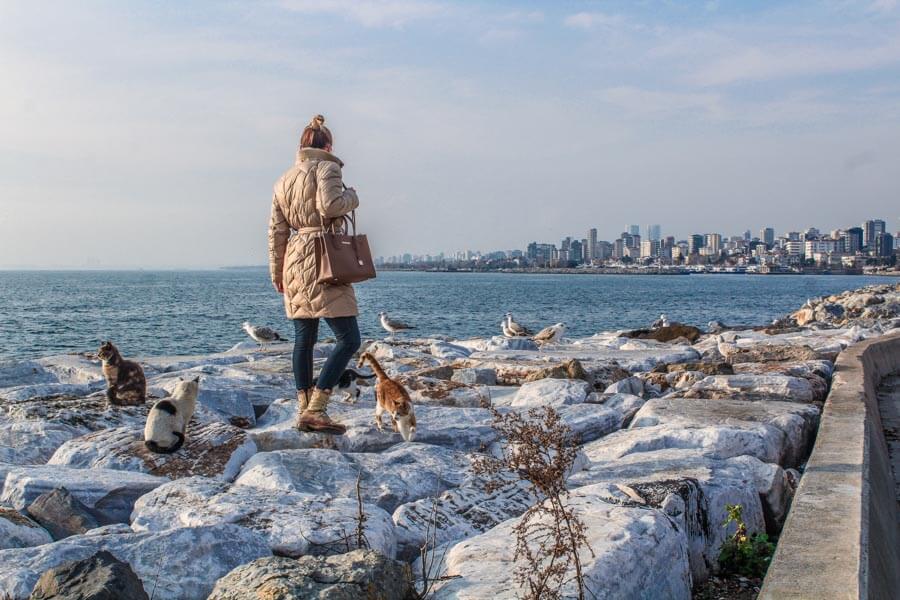
Here is Where to Find Public Bathrooms in Istanbul
There are no problems with finding a bathroom in Istanbul. Toilets are everywhere in tourist places, including almost every cafe with the exception of small tea shops or kiosks.
You can find free toilets in:
- Museums and culturally significant places and parks. Almost all parks have free public toilets.
- Close to some bus stops that have attached shopping centers (free public bathrooms are inside centers and you need to go through the entire hall to find it).
- In all mosques.
Public toilets cost less than $0.50 (3-5 TRY) and you can pay with IstanbulKart (in many) or cash. You’ll find them:
- At some metro stations, underground passageways, and near major stops. For example, there is a public toilet in Gulhane Park, next to Sultanahmet Square, in the passage under the Galata Bridge. Another one is near the Kadikoy metro station (across the road).
- At railway and bus stations.
Things to Know About Visiting Istanbul Mosques & Religious Sites
If on your trip you are planning to visit mosques (which most tourists do), at the entrance you must take your shoes off. If you are not wearing socks, take them with you. Dress as modest as possible: cover your shoulders, legs, and head (for women).
Keep in mind that it is forbidden to eat or drink inside mosques as well as to speak loudly, laugh or do anything else that attracts attention.
It is not recommended to stand by or walk in front of people in prayer. Also, never ever take pictures of those who pray or wash before/after the prayer.
No one is allowed to visit mosques during the prayer at noon. It is better to visit between services. For example, in the Blue Mosque, visiting hours are from 8:30–12:45, 14:00–16:45, 17:45–18:30.
By the way, it is better to find out in advance about the schedule when mosques are open. It changes every season and each mosque has its own hours.
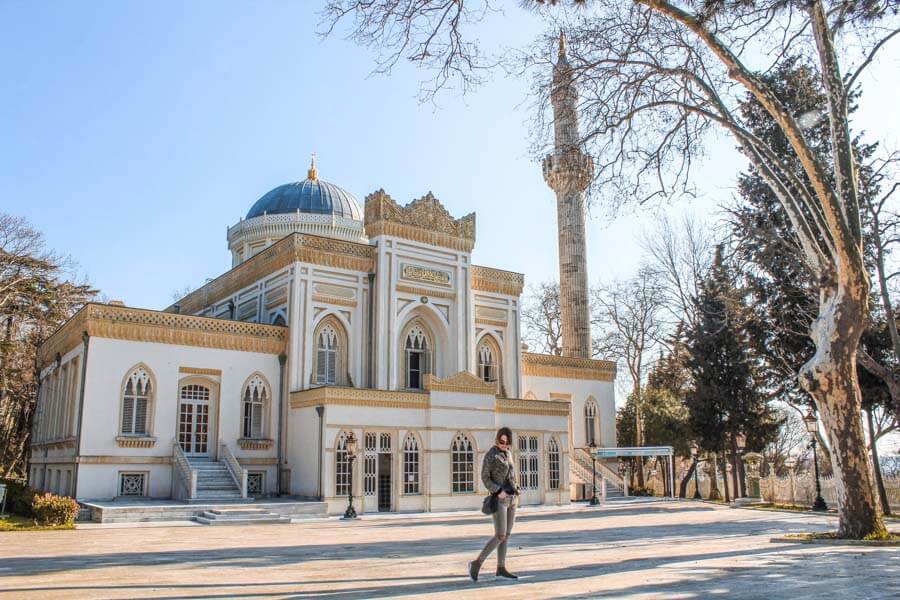
Pay Attention to What You Take Photos Of
Many tourists, carried away by capturing pictures on a trip, do not pay attention to what falls into their frame.
In a Muslim country, it’s worth looking around. In Istanbul (and anywhere in Turkey), it is not recommended to photograph women in black hijabs and ask men for permission to take photos of them.
For various reasons, sometimes, it is not allowed to take photos and videos near some mosques, on the territory of ancient temples, and in excavation zones. You can always find out about the ban by carefully looking around – a sign with information on photos should be nearby. Respect that and don’t take pictures on the sly if there is a warning not to photograph.
Also, photos and videos are not allowed anywhere near military bases. You can get a fine and deportation for this mistake.
Don’t Forget About Tipping
During our time in Turkey, we learned that this country is almost like the United States in terms of tips. People who work in service don’t make enough and depend on tips a lot.
Although gratitude in the form of money is not required, it is very much appreciated. Waiters, hotel porters, guides often expect a tip in the amount of 10-20% of the amount you pay (street food places don’t count). Taxi drivers expect that the amount will be rounded up.
In Turkish baths (hammams), it is customary to add a fourth part of the invoice amount to encourage all attendants. And you will definitely not forget about it as all of them will gather before your departure, waiting for the tips.
Again, you don’t have to leave anything on top of your bill. So don’t feel pressured and don’t overthink it but it is a nice gesture.
We personally tip only in those cases when we are happy with the service.
Tip For Tourists on a Budget – You Can Explore Istanbul For Free
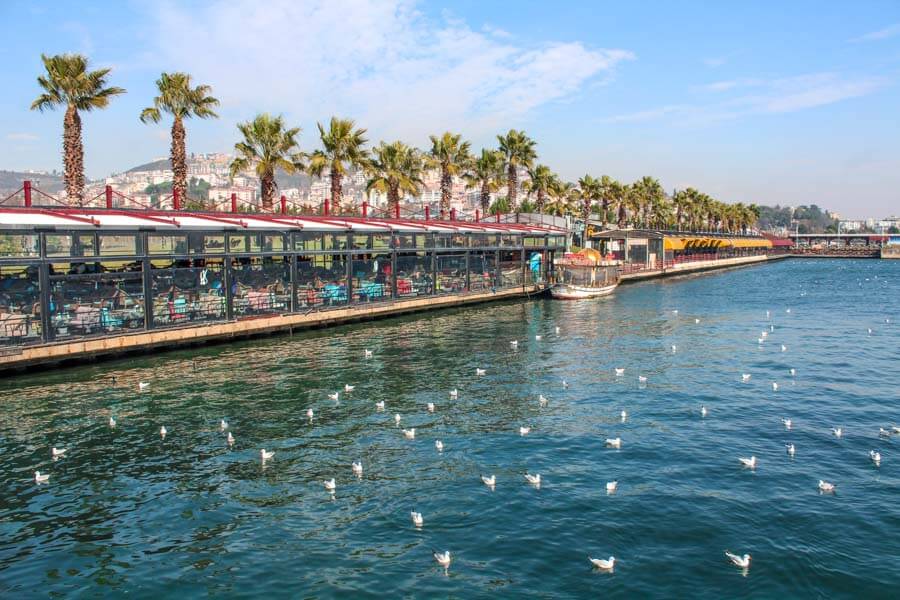
If you have a limited budget, keep in mind that you can get acquainted with Istanbul for free. This city has many attractions that you can visit without paying a dime.
For example, if you want to learn how Ottomans lived then I advise you to get around the Yildiz palace and park complex . This area is full of ancient Ottoman houses and offers incredible views of the Bosphorus. And the best part – all of that is absolutely free.
For lovers of intellectual activities, the Elgiz and Doganchay museums on the European side of Istanbul don’t have any fees. The first museum contains works of famous European and Turkish masters. The second exhibits paintings, sculptures, photos, and drawings by a modernist artist, in whose honor the museum is actually named.
Another free thing to do in Istanbul is to go on a free walking tour (or almost free). While you don’t need to pay anything for the tour, guides still expect some remuneration in the form of tips. In the end of a tour, you can decide on the amount convenient for you.
We personally like this company with free walking tours but there are a few others offering similar routes.
An Egyptian bazaar is also a great option for those on a budget who want to plunge into the atmosphere of the East. Spices and dry fruits, nuts, cheeses, sweets – you can find so many tasty things there on the cheap. A nice bonus is that you can taste the goods for free, so having a walk around the market gives you lots of impressions and snacks.
Istanbul Travel Advice on What Not to Do (!)
Do not call istanbul constantinople & don’t talk about greece.
Officially, Istanbul became Istanbul and not Constantinople in 1930, 7 years after the establishment of Turkey as a country. But unofficially, Istanbul stopped being Constantinople in 1453 when it was conquered by Turks and became the capital of the Ottoman Empire.
Calling Istanbul Constantinople is wrong and it can cause negative feelings among the locals. So don’t do it when having a conversation with locals or even with a tour guide (who is a Turk).
Besides that, try not to talk about Greece (Greeks and Turks have a long-standing tense relationship), express ill will towards Turkish sultans and any political figures, argue about Kurds and Turkish Cypriots, and never express any negative feelings about the Turkish flag or language.
Do Not Question Others How They Feel About Mustafa Ataturk
Most likely you won’t even know who this man is or how much he transformed Turkey as a country. But you will definitely see his photos around the city everywhere you go. A lot of people keep his picture on the wall in restaurants, cafes, barbershops, hospitals, schools, government institutions, and even guest houses. It can be a small picture or a big poster on the door, wall, or on the outer side of buildings.
Ataturk was the founder of the Turkish Republic and the first president of the country. He grew up in Ottoman Thessaloniki in present-day Greece and came to prominence for his role during World War I.
Because of him, Turkey became the secular, industrial nation that we know today. Yet, not everyone accepted all the changes he made and not everyone supports him today. Talking about Ataturk is a bit sensitive topic. People, no matter how they feel about this important man, get very passionate when discussing him.
Don’t get them started. If you are eager to learn about that time in history, better visit a fantastic Ataturk museum where you can find answers to a lot of questions.
Additionally, remember that criticizing, negatively speaking or making jokes about Ataturk’s monuments and images is considered an insult. And for that, even guests can go to jail. Also, besides the Ataturk topic, do not start conversations about the situation with refugees and religious issues.
Do Not Visit Only Galata Tower For the View
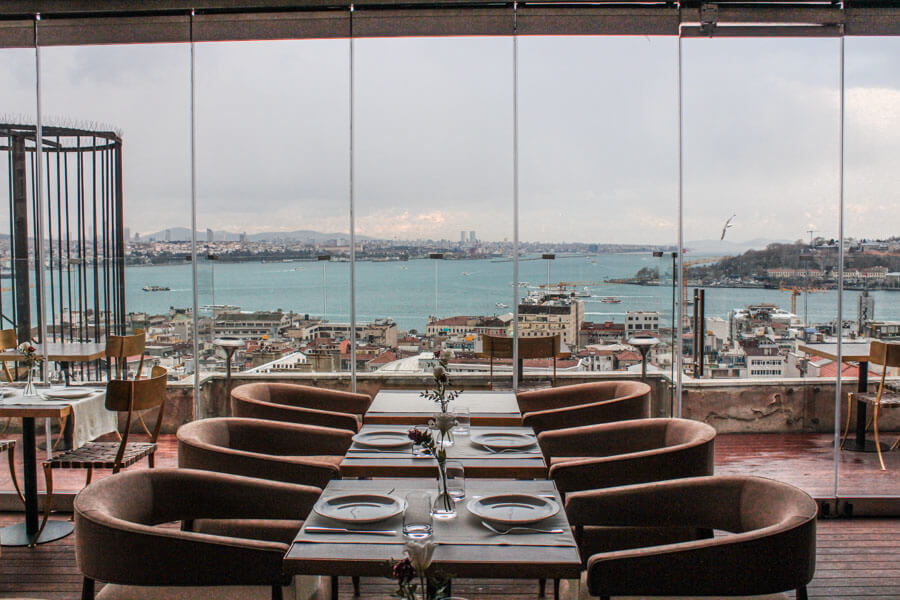
Galata Tower, an icon of the Beyoglu district and one of the main landmarks of Istanbul, is definitely beautiful. But if you are coming on a short visit and thinking to climb the Galata Tower for the panoramic opportunity, it can be a waste of time.
First of all, because this most touristy attraction takes some time to get in with tens of thousands of tourists who compete in speed and arrogance. In the summer, its tiny panoramic balcony gets packed with people who push and squeeze each other in annoyance, and in winter it gets just very cold there. Second, there are many more fascinating locations nearby that offer incredible views of Istanbul.
Visiting Galata Tower is a great activity if you have more time to spend in Istanbul and combine this visit with a trip to other panoramic locations that actually offer a view of Galata itself. Like one of many parks that have amazing views or panoramic restaurants and cafes. One of them just nearby is Balkon Restaurant & Bar or a bit farther a Kat Restaurant .
Do Not Travel to Istanbul For the Beach Vacation
A lot of people who plan a trip to Istanbul believe that in this one city they will be able to experience everything – from ancient sites and delicious food to hiking and beaches. While the first two are two, the last one will not live up to your expectations.
Yes, Istanbul has access to two seas. But beaches are not something that this city is famous for.
If you are interested in beach vacations, try to add a few days to your trip and venture to one of these best beach destinations from Istanbul . Some of them, you can reach in about an hour.
Those who have at least a week in Istanbul and still want to spend a day by the water should check the beach near the Florya Sahili Park, Caddebostan coast in Kadikoy neighborhood , beaches of Princes Islands, Marmara Island, Avsa island, Kumkoy on the Black sea, Sile and Agva towns.
Do Not Pick Up a Shoe Brush That Shoe Cleaner Dropped
I would like to conclude my Istanbul travel guide with one of the biggest scams that many tourists fall for until this day. My family became a victim of this scam too and lost a big sum of money. This scam comes from shoe cleaners and their “trick” of dropping a shoe brush.
Istanbul is famous for shoe cleaners who usually “hunt” near the main tourist routes. They “accidentally” drop a brush naturally in the sight of tourists expecting someone to pick it up. And, of course, there is always a tourist who falls for this trick trying to help by picking up the brush and giving it to a cleaner.
You don’t want to pick that brush! It is a trap! After you let the cleaners know he dropped a brush, he’ll do his best to impose an unnecessary shoe shine on you and then, in the end, ask for an incredibly high amount of money for it. In case you don’t pay or if you argue, he can attack and forcefully take your money.
Stay away from shoe cleaners and don’t do anything when seeing them drop a brush or any other item.
Alright, so this is my list of 45 ultra-practical travel tips for Istanbul. They are meant to answer a lot of questions and help make your Istanbul trip more enjoyable. Knowing them will help you master the art of Istanbul travel and plan an amazing vacation!
And then if you are looking for more Istanbul travel advice, I have a load of it here !
Similar Posts in Other Regions
- Visiting Morocco For the First Time – 10 things to know before you go
- First Time in Dubai – my travel tips & things to do
- First Time in Kenya – things to remember & safety advice
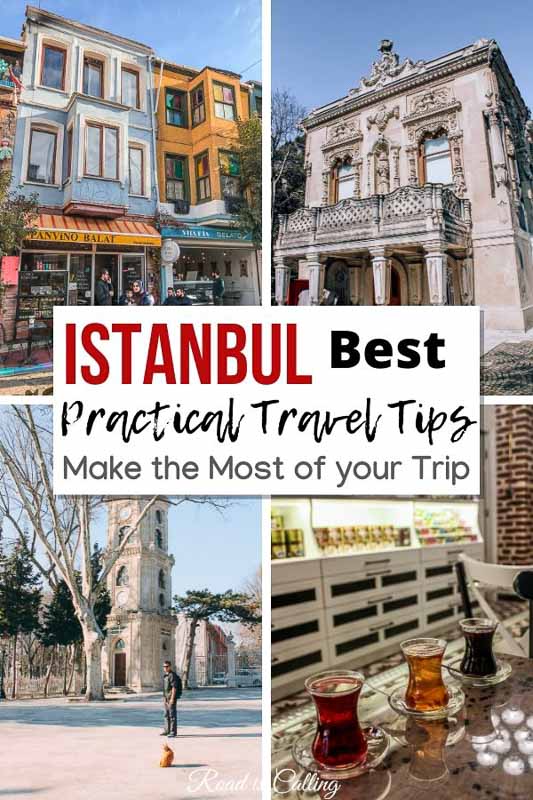
Anya is originally from Ukraine but in heart she is a citizen of the world. She is working online and that’s why has an opportunity to travel a lot and live in different countries. At present time, she is based in Spain while waiting for the war in Ukraine to be over to be able to return home. On this blog, her main goal is to inspire others to travel to under-the-radar places and discover the world while working remotely.
Similar Posts
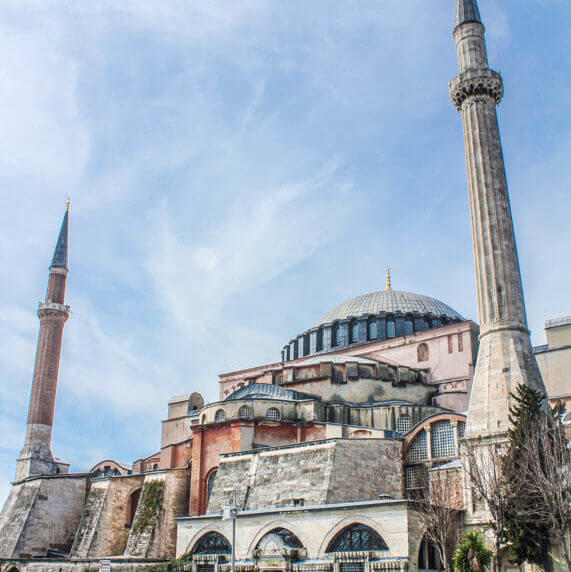
The Best Istanbul Sightseeing Ideas For Anyone Who Visits For the First Time
Visiting Istanbul earlier this month was absolutely eye-opening. I had no idea how many sensational sightseeing spots this city has. And how much it captivates with its charm and mix of cultures. Istanbul is…
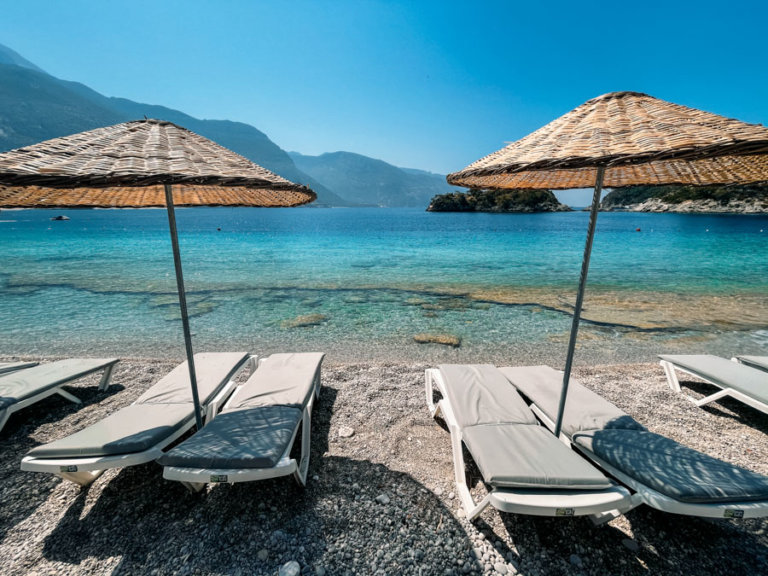
8 Best Beach Destinations in Turkey From Istanbul for a Quick Trip
With a considerable number of incredible beach destinations in Turkey that are easily accessible from anywhere in the country, it would be a mistake not to visit at least one of them on your…
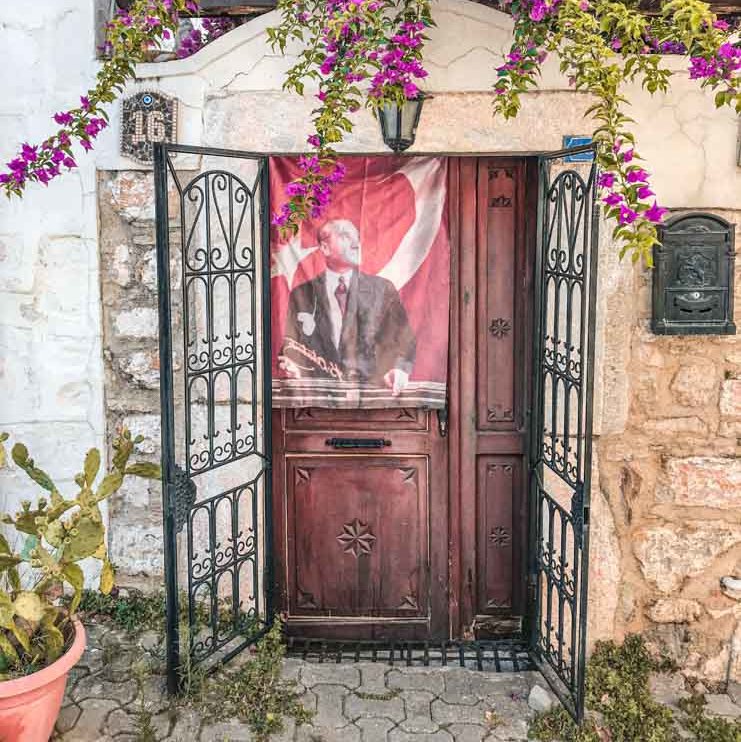
15 Interesting Facts About Turkish Culture That You Need to Know Before Visiting
We have been living in Turkey for almost a year now. Wow, it’s been the longest in one place since the moment we left the US. And during this time we managed to notice…

Romantic Places in Istanbul for Couples – How to Spend Quality Time Together
With the number of romantic places in Istanbul, the challenge lies not in finding a spot for your date, but in choosing from the city’s many beautiful options, where every corner radiates the promise…
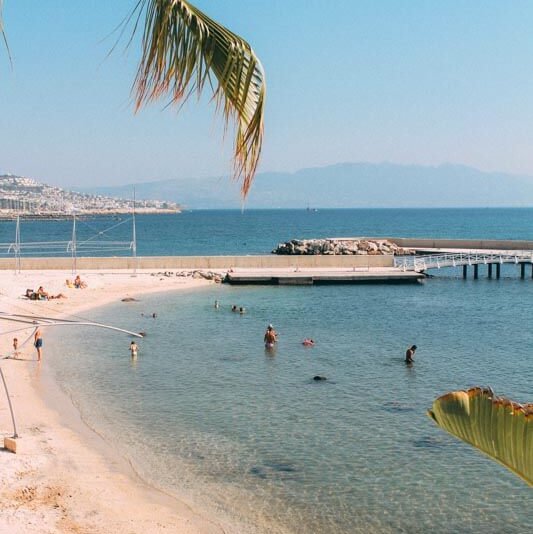
15 Best Beaches in Bodrum (Peninsula) For Your Turkey Bucket List
Bodrum in Turkey is famous for many things. Some people know it for its numerous bays, surrounded by gardens and pine groves, fancy high-end hotels, or an abundance of historic sights. But not many…
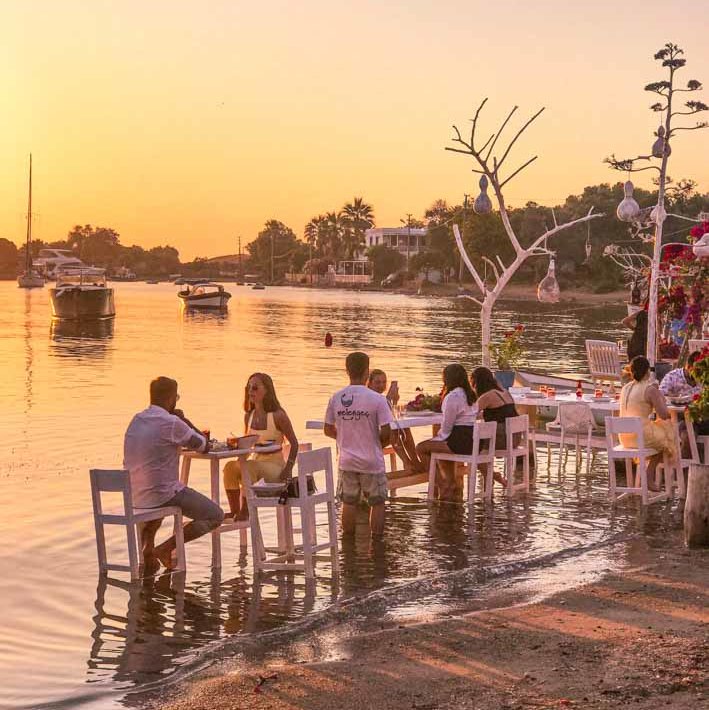
My 21 Favorite Places to Visit in Bodrum (Peninsula) That You’ll Love Too
Recently, we have spent almost two months in Bodrum. I thought it was enough time not only for lazy days on the beach after a long working day but also for driving around and…
Great post, super informative! I would love to travel to Istanbul someday!
Thanks for all the amazing suggestions. I have been to Istanbul but have not experienced half of those things. I did enjoy all the markets!
Istanbul is huge, it’s difficult to experience everything at once! I guess you have a reason to return 😉
I loved Istanbul so much and I am so sad I didn’t get the opportunity to read your article before going there. You gave so many good tips that would have made my trip even better! Thanks for sharing!
I am so glad to hear you found these tips helpful!
Hello. Good tips for a nice trip.
But I had a bad experience in Istanbul and I don’t recommend a trip to this city.
I landed on the night of 10/17/2022 at Istanbul Airport (IST). Before the flight, I purchased a transfer service through Booking.com for the transfer from the airport to the hotel, for 32 pounds sterling.
Upon arrival at the airport, I did not meet the driver at the agreed location (exit 13) and spoke with a driver who was there. I showed him the name and phone number of the person who was supposed to pick me up. He called then and on the other end of the line someone impersonated the driver who was supposed to pick me up, saying that there was a mistake and that I should make the ride with the one I had found. A price of 3590.00 Turkish Lira was placed and payment would be accepted by credit card. As I was very tired, it was late at night and I didn’t know the rate of the Turkish lira, I accepted it. On leaving the airport, the local called a colleague to accompany the trip.
On the way, they stopped at the first ATM and I was forced to withdraw the money. At that moment, I saw that it was a coup and that my life was in danger. Upon arriving at the hotel, I took a photo of the license plate and asked the receptionists for help. I couldn’t sleep that night. The next morning I went to the tourist police station. I told the policeman what had happened and he only said that he would contact the owner of the vehicle and talk to him about returning the money.
On the night of 10/19/2022, a representative of the vehicle owner went to the hotel and the hotel manager brokered the contact and negotiation. The two, representative and manager, said it would only fit me 85.00 euros as there would be fees to cover. I paid the equivalent of 225.00 euros for the criminal race and received only 85 euros at the end. No policial report was registered. I was coerced and robbed. This is all completely absurd. Crime and impunity prevail there. Uber doesn’t work in the city and the hotel manager said there is a big mafia in car transport at Istanbul airport.
I hired a guide for a walking tour of the historic center, but he didn’t show up. I paid for a laundry at the hotel to deliver clean and ironed clothes but they only delivered clean ones. They always try to overcharge you for anything. It’s really annoying that you have to keep checking and confirming things all the time. You cannot trust.
People are not friendly and polite like in other places. The food is not that attractive and delicious.
Anyway… What would have been a few days of tour and resting has become a very negative experience.
Tourism is done with transparency, honesty and trust. I left Istanbul sad and very disappointed. I don’t recommend this city and Turkey to anyone. There are certainly better options.
I am very sorry to hear that you had a bad experience in Istanbul, Igor. Whatever you describe is definitely very bad and sounds like you were scammed pretty hard. I am sorry!
Yet, while hearing your pain, I wouldn’t be so radical and say that Istanbul and Turkey as a whole is not good place to visit. The city is huge and the country is gigantic too, there are so many wonderful people there. You just got unlucky for some reason and it ruined the entire impression. So sad such things happen but they can happen almost anywhere :((
Thank you for all your tips and help with my itinerary! I used all your recommendations and our time in Turkey was just great. And I appreciate you responding to all my emails!
So glad to hear this, Laura! I’ll be happy to help you with other Turkey travel planning when you come back to revisit the country!
Leave a Reply Cancel reply
Your email address will not be published. Required fields are marked *

Istanbul Travel Tips: 27 Essential things to know before visiting Istanbul
Planning a trip to Istanbul isn’t that straightforward as there are quite a few things you need to know before visiting Istanbul.
You might be wondering whether you need a visa, what are the best places to stay, how to get around the city, how to save money, or what are the common scams to watch out for.
All your questions will be answered in this blog post where I’ll share my top Istanbul travel tips for first-time visitors and things I wished I’d known before visiting.
So without further ado, here are 27 essential travel tips for Istanbul.

*** This article may contain affiliate links, meaning each time you click through and make a purchase, I earn a small commission at no extra cost to you which helps a lot in keeping this website running. Thank you for your support :)
Read more about Turkey:
- How to spend 4 days in Istanbul
- Top 20 free attractions in Istanbul
- 16 Best photography spots in Istanbul
- How to spend 7 days in Turkey
- Best ways to get from Istanbul to Ephesus
- How to book a Turkey car rental
Table of Contents
Istanbul Travel Tips for planning your trip
1. you need at least 3 or 4 days in istanbul.
Istanbul is a huge city with so many things to do. This is why you need a minimum of 3 or 4 days for a proper introduction to the city and to hit all the main tourist attractions.
If you need help planning your itinerary, make sure to read my guide on how to spend 4 days in Istanbul .
Related post: Istanbul itinerary for 4 days
2. Book your hotel in advance
One of the most important Istanbul travel tips is to book your hotel in advance, especially if you’re visiting during the peak season (June to August).
Most of the nicer hotels are usually sold out several weeks or even months in advance. Booking in advance also means that you’ll benefit from cheaper rates.
Some of the best places to stay in Istanbul include Tomtom Suites , World House Boutique Hotel , and Hostel Le Banc .

3. Booking.com is banned in Turkey
If you use booking.com to book your accommodation, I highly recommend doing so before you land in the country since it’s banned in Turkey.
Although you can still access the website to manage your bookings, you won’t be able to book a Turkish hotel while you’re in Turkey.
If you want to book hotels on booking.com while you’re in Turkey, I recommend getting a VPN. Alternatively, you can download the Opera browser on your phone and use their free integrated VPN.
4. Stay outside of Sultanahmet if you want a quiet night’s sleep
Sultanahmet is the most popular place to stay in Istanbul since this is where all the main tourist attractions are located.
But what you probably don’t know is that it can be very loud at night and also quite expensive compared to other neighborhoods.
I learned this the hard way during my recent trip to Istanbul. The hotel I initially stayed at was located along a street flanked by rows of restaurants that kept playing music until 2 a.m!
If you absolutely want to stay in Sultanahmet, Camelot Apartment is located on a rather quiet street, not too far from the Blue Mosque and Hagia Sophia.
Otherwise, I recommend staying in either Beyoglu or Karakoy if you want some peace and quiet.

5. You probably need a visa to visit Turkey
One of the most important travel tips for Istanbul is to check whether you need a visa or not. You can do so on the official website here .
There are also third-party websites where you can apply for a visa but these are usually more expensive as they charge an additional fee on top of the visa fee.
Most travelers, including US citizens, need to apply for an e-visa. The visa is valid for a period of 30 to 90 days, depending on your nationality.
UK citizens, for example, are exempt from a visa while others can get a visa for free.
When applying for an e-visa on the official website , click on “new application” and then select your country.
The cost of the e-visa and duration of stay will depend on the country you’re from.
After completing the application process, it can take a few minutes up to 24 hours before the visa is sent by email.
6. When to visit Istanbul
The best time to visit Istanbul will depend on what you want out of your trip. Below is a quick overview of the different seasons and what to expect for each.
Spring : April to May – Mild temperature, fewer crowds, and cheaper prices. The annual tulip festival takes place in April.
Summer : June to August – Very hot and humid with temperatures rising above 30 degrees Celsius. Huge crowds, hotel and tour prices are much higher.
Fall/autumn : September to November – The temperature starts to drop, fewer crowds, and cheaper hotel rates.
Winter : December to March – Cold weather with the occasional snowfall but it’s considerably less cold than other European destinations.
Istanbul Travel Tips to skip the crowds
7. buy the istanbul museum pass.
The Istanbul Museum Pass gives you access to 10 museums in Istanbul like the Galata Tower, Topkapi Palace, Hagia Irene, Istanbul Archeological museum, and more.
The pass is valid for 5 consecutive days and is perfect for those who want to visit a lot of museums, and at the same time, skip the long ticket lines.
Another option is to buy an Istanbul E-Pass which includes skip-the-line tickets and guided tours for over 40 attractions in Istanbul. The pass is available for 2, 3, 5, or 7 days and is perfect for those who want to see as many attractions as possible while saving money.
CLICK HERE TO BUY THE ISTANBUL E-PASS
Note : I only recommend buying the museum pass under certain circumstances. For instance, if you’re planning to visit 5 museums and the total cost of the individual tickets exceeds the cost of the museum pass, then it makes more sense to get the museum pass.
Otherwise, if you’re visiting one or two museums only, you’re better off buying individual tickets. Just remember that the pass can only be used once at each attraction.

8. Buy attraction tickets online
For those who don’t plan to purchase the Istanbul Museum Pass or Istanbul E-Pass but still want to avoid the long ticket lines, then I recommend booking your attraction tickets online.
You can book tickets to most museums and attractions on the Government website here .
9. Plan your visit outside of the peak season
The peak season in Istanbul, and Turkey in general, is during the summer months of June to August and thus attracts hordes of tourists.
Popular attractions like the Blue Mosque and Hagia Sophia are absolutely packed with tourists during this time of the year.
If you can only come to Istanbul during the peak season, I highly recommend visiting these attractions early in the morning, at least before 8 a.m to avoid the long lines.
As more tourists visit Istanbul in summer, hotel rates also increase considerably as well as tour prices.
Another thing to note is that there are also more crowds during popular Turkish holidays like Kurban Bayrami and Ramadan Bayrami. The date changes every year so make sure to do a quick Google search before your trip.
So, if you want to avoid the crowds and get cheaper prices, I recommend visiting during the shoulder season – April/May or September/October.

Istanbul Travel Tips for getting around
10. the bus is the best and cheapest way to get from the airport to the city center.
Istanbul has two airports – Istanbul Airport (IST) on the European side and Sabiha Gokcen Airport (SAW) on the Asian side.
One of the best Istanbul tips for tourists, more specifically for those traveling on a budget, is to take the Havaist bus (from Istanbul Airport) or Havabus (from Sabiha Gokcen Airport).
It’s definitely the best and cheapest way to get from the airport to the city center. Plus, the buses are very spacious and comfortable.
The bus operates 24/7 and the journey from the airport to the city center takes on average 1-2 hours, depending on where you’re staying. You can buy tickets online or directly at the airport.
If you don’t want to take the bus or are traveling with a group, then I recommend booking a private airport transfer .
11. Download apps like BiTaksi or Uber
If you don’t want to take the bus, be sure to download ride-sharing apps like Uber or BiTaksi. The fares will be much cheaper than regular taxis, plus you can see beforehand how much the journey costs, thus avoiding getting ripped off.
12. Buy an Istanbul Kart
If you’re planning to get around a lot by public transportation, it’s a good idea to buy an Istanbul kart. It costs about 60 TL and you can top up with the amount needed.
The main reason why I recommend getting the Istanbul kart is that the fares are much cheaper with the card (about 50% cheaper) compared to buying a single ticket. You’ll also save time by not having to buy tickets every single time.
A single fare with the Istanbul Kart costs about 10 TL and the good news is that the fare gets cheaper the more you use the card.
The card can be used by up to 5 people, so there’s no need to buy individual cards for each traveler in your group.
You can buy the Istanbul kart at the airport or at most metro stations in the city center and use it on the bus, metro, tram, and ferry.
Alternatively, you can buy this Istanbul transport card that’s pre-loaded with up to 20 rides. You can either pick it up at the airport or have it delivered to your hotel.
Another thing to know before visiting Istanbul is that you can also use the Istanbul Kart to pay for public toilets around the city and inside the metro stations. The toilet fee is about 2 TL.

13. Traffic in Istanbul can be very hectic
One thing to know about Istanbul is that the traffic can be very hectic. One of the most important travel tips for Istanbul is to avoid taking the bus during peak hours, especially in the afternoon.
For instance, I once took the bus at around 5 p.m from Ortakoy to Beyoglu, and what was supposed to be a 40-minute journey ended up lasting 1.5 hours!
The traffic was so bad that I even had to get off the bus and walk back to my hotel. I’m pretty sure I arrived before the bus!
So do yourself a favor by taking the metro instead if you don’t want to get stuck in traffic during peak hours.
14. Don’t rent a car in Istanbul
As mentioned above, traffic can be very hectic which is why it’s not recommended to rent a car in Istanbul unless you plan to leave the city and start a road trip around the country.
Public transportation in Istanbul is cheap, convenient, and reliable so there’s no point in spending extra cash on car rental.
Istanbul Travel Tips to help you save money
15. there are many free things to do in istanbul.
For those traveling on a budget, you’ll be pleased to know that there are many free things to do in Istanbul. Hagia Sophia, the Blue Mosque, and all other Istanbul mosques are completely free to visit.
Visiting the Grand Bazaar (which is an experience in itself) or exploring the local neighborhoods like Balat, Fener, and Kadikoy also doesn’t cost a cent.
Make sure to read my guide to 20 things to do in Istanbul for free for more things to do.

Related post: What to do in Istanbul for free
16. Take the local ferry instead of a Bosphorus tour
One of the most popular things to do is to take a Bosphorus tour. It costs anywhere from €10 for a 90-minute sightseeing tour up to €55 for a luxury sunset cruise including dinner .
But if you’re on a budget, you can just hop on the local ferry from Europe to Asia. A single ticket costs only about 10 TL which is a bargain.
One thing to note is that the ferry ride will be shorter but you’ll still be able to admire some of the major landmarks in the city.

17. You can use toilets at the mosques for free
If you need to use the toilet, you can simply go to any mosque and use the toilets there for free. They are generally well-maintained and clean.
Otherwise, you can use the public toilets at the metro stations or around the city for about 2 TL. As mentioned above, you can pay the toilet fee with your Istanbul Kart if you don’t have any small change.
Travel Tips for Istanbul for a safe trip
18. take note of emergency phone numbers.
Travel is sometimes unpredictable which is why it’s always a good idea to have local emergency phone numbers on hand. Below are some of the most important ones:
Police: 155
Ambulance: 112
19. Safety in Istanbul
Istanbul is a relatively safe destination even for solo female travelers. I traveled to Istanbul solo and from my personal experience, I didn’t feel unsafe while walking alone nor did I receive any unwanted attention.
Security is pretty tight with lots of police officers especially around Sultanahmet and Taksim so you don’t have to worry about safety issues.
That said, petty crimes like pickpocketing sometimes happen, so always be aware of your surroundings and avoid flashing any expensive objects.
You should also watch out for scams which brings me to my next tip for visiting Istanbul.

20. Watch out for common scams
Like in most big cities, you need to be aware of common scams that mainly target tourists.
The most popular one is the shoe shiner. The person will pretend to drop his brush and when you pick it up, he will then proceed to shine your shoes which obviously isn’t free.
There’s also another scam where someone will approach you and invite you for a drink. You’ll then end up being forced to pay an exorbitant bill.
In order to prepare yourself before your trip, I recommend reading this article about the most common scams in Istanbul.
Other Helpful Istanbul Tips for Tourists
21. buy a local sim card.
The best way to stay connected, especially if you need to use Google Maps to navigate the city, is to buy a local sim card.
There are three major internet providers in Turkey, namely Turkcell, Vodafone, and Turk Telekom. All three are quite similar but it is said that Turkcell has the best coverage.
I recommend buying your sim card when you get to the city center since those at the airport are slightly more expensive.
I bought a Turkcell tourist sim card which came with 20 GB of data and 200 minutes of local call, valid for 30 days. You just need to bring your passport and it takes only a few minutes for the sim card to be activated.
Alternatively, you can buy a pocket wifi (with unlimited internet valid for 14 days) and have it delivered directly to your hotel. It’s slightly more expensive but can connect up to 10 mobile phones at a time.
Note : If you need internet as soon as you land in Turkey, you can use the airport wifi for free. Just input your local phone number and after receiving a one-time password, you’ll be able to connect to the wifi.
22. There are lots of steep hills
One thing to know about Istanbul is that it’s also known as the “City on the Seven Hills” so don’t be surprised if you come across a lot of steep hills.
The streets along Beyoglu, Balat, and Galata Tower are among the steepest in Istanbul and you’ll be sweating buckets if you’re not dressed in light clothing. Make sure to also carry plenty of water and to wear comfy shoes.

23. Mosque Etiquette
Although you can wear any type of clothes you like in Türkiye, you need to dress more conservatively when visiting the mosques.
For women, this means covering their shoulders and knees and wearing a head scarf. Men, on the other hand, need to wear long pants.
You also need to take off your shoes before entering the mosques.
24. Check prayer times before visiting mosques
One thing to know before visiting Istanbul is that you can only visit the mosques outside of prayer times. Make sure to check the prayer times on this website before visiting.
25. Learn some basic Turkish words
Although most Turkish people can speak English, I always do my best to learn a few basic words and phrases in the local language when traveling to a new country.
A little goes a long way and I can guarantee that you’ll put a smile on the Turkish people’s faces if you at least try to speak a few words in the local language.
Below are some useful Turkish words to know:
Hello : Merhaba
Thank you : Teşekkür ederim or Teşekkürler
Please : Lütfen
Excuse me : Afedersiniz (I’ve also heard people say “pardon”)
How much : Ne kadar

26. Drinking tap water in Istanbul
Although it’s considered safe to drink tap water in Istanbul, most locals might tell you the opposite due to the old rusty pipes and water tanks.
I did drink the tap water during my first few days in Istanbul and while it didn’t make me sick, I didn’t really like the taste.
If you don’t want to drink tap water, I recommend buying the 5 L water bottles. They are much cheaper and you can also reduce your plastic consumption since you won’t need to buy multiple water bottles.
27. Plug type
The plugs and sockets in Turkey are of type C and F with a voltage of 220 V and a frequency of 50 Hz. You’ll probably need a travel adapter if you’re coming from a non-European country.
There you have it – 27 important things to know before traveling to Istanbul. If you have any additional Istanbul travel tips to share, please comment below.
- Cappadocia 3 day itinerary
- Things to know before taking a hot air balloon flight in Cappadocia
- What to do in Ephesus and Selcuk
- What to do in Oludeniz, Turkey
- Complete guide to visiting Babadag teleferik Oludeniz
- Complete guide to Pamukkale Turkey
Steph is an outdoor enthusiast who’s always down for adventure. When she's not traveling abroad, you’ll either find her exploring her own backyard or researching her next trip. She writes adventure travel guides featuring waterfalls, mountains, and beaches and shares her tips on how to travel on a budget without compromising on comfort and experience.
4 Days in Istanbul Itinerary + Budget Tips
How to get from istanbul to ephesus: step-by-step guide, you may also like, 5 best pamukkale tours from antalya for any budget, guide to renting a car in turkey + tips for driving in..., 16 best istanbul instagram spots + map.
Great post! I got enough details and info for my upcoming trip to Istanbul
Leave a Comment Cancel Reply
Save my name, email, and website in this browser for the next time I comment.
This website uses cookies to improve your experience. We'll assume you're ok with this, but you can opt out if you wish. Accept Read More
- Search Please fill out this field.
- Manage Your Subscription
- Give a Gift Subscription
- Newsletters
- Sweepstakes
- Travel Destinations A-Z
Istanbul Travel Guide
Katie Nadworny is an Istanbul-based writer who specializes in stories at the intersection of culture and politics in Turkey, Eastern Europe, and the Middle East. She has lived in Turkey for nearly a decade and has traveled extensively around the region.
:max_bytes(150000):strip_icc():format(webp)/Katie-Nadworny-2000-64322b4cc4964c76a7dea5a6080aa083.jpg)
There is nowhere in the world quite like Istanbul. Spread across two continents, Istanbul is a city of layers and contrasts. With historical sights like the Hagia Sophia and Topkapi Palace brushing up against buzzing bars and lively cafes, with Ottoman-era mosques a short walk from contemporary art museums and galleries, with traditional carpet shops around the corner from trendy boutiques, Istanbul is a city of old and new coexisting. The city never stops moving.
Istanbul is the cultural capital of the country, with a plethora of independent galleries and inventive restaurants, as well as its transit hub, with flights going all over Turkey and all over the world. Each neighborhood has its own distinct identity and vibe, and it's easy to spend weeks in Istanbul without ever seeing everything. But that is what makes it so fascinating—there will always be something calling you back for more. So order a cup of Turkish coffee and a piece of pistachio baklava, and get ready to delve into this fascinating metropolis.
Turkey's time zone is GMT+3 year-round, and is also called TRT (Turkey Time). Turkey does not do daylight savings.
Best Time to Go
Spring (April-May) and autumn (September-October) are the perfect times to visit Istanbul, when the weather is bright and mild. During the month of April is the city-wide Tulip Festival, when the parks and green spaces in the city are bedazzled with the colorful bulbs. In the summer, the city becomes sticky and very hot, and most residents flee to the beaches in the south as soon as they can, but the streets are alive all night when the air cools off a little. Winter is gray and rainy, showing Istanbul at its most moody and evocative.
Things to Know
The main language in Istanbul is Turkish, though with a large international presence in the city, don't be surprised to hear chatter in English or Arabic or Farsi as you explore. Turkish people are generally quite helpful, even if you don't speak any Turkish, and shop owners (especially in Sultanahmet, the historic center) will often invite you to sit down and share a çay, a tiny tulip-shaped cup of strong black tea. Personal space is often a luxury in this crowded city, so don't be surprised if you feel someone is standing too close to you as you wait for a bus or in a line—it's normal here.
Don't mistake the water that bisects the city for a river. The Bosphorus Strait connects the Sea of Marmara (and, by extension, the Mediterranean) with the Black Sea, and is therefore a major global shipping route. It's not unusual to see massive container ships floating by your commuter ferry.
While Istanbul is the largest city in Turkey, the capital city is actually Ankara, in central Anatolia. But the palaces that dot the Bosphorus, left over from Istanbul's status as the capital of the Ottoman Empire, might make you think otherwise. The politicians might do their business in Ankara, but Istanbul feels like the center of the world.
Currency: Turkish Lira (TL)
(Check the current exchange rate )
Language: Turkish I don't speak Turkish: Türkçe bilmiyorum. I'm lost: Kayboldum Can I have…?: …alabilirmiyim? Where is…?: ... nerede?
Calling Code: +90
Capital City: Ankara
How to Get Around
Intricate interlocking transportations—both official and informal—make it easy to navigate around Istanbul. There are multiple metro lines with clear signage and modern cars that connect to an above-ground tram line and two funiculars. The Marmaray, a cross-continent metro line that passes under the Bosphorus Strait, connects the metro system on the European and Asian sides of the city, and has recently expanded to run all the way into the suburbs on both sides of the city. Otherwise, the best way to cross from Europe to Asia and back is by ferry, with multiple ferry lines running between stations on a regular schedule all throughout the day.
The gaps are filled by city buses, which are paid for by the same IstanbulKart that gets you onto the metro, Marmaray, and ferries. And if there is no bus that runs to your destination, there might be a dolmuş , a yellow van that runs on a fixed route but stops whenever a passenger requests it and leaves whenever the van is full. There are also light blue minibuses that run on various routes throughout the city. Dolmuş and minibuses are paid in cash, with the price depending on the distance you go.
Taxis are plentiful, especially around touristed areas. Apps like BiTaksi can be useful to call taxis directly, and hotels are also usually happy to order a taxi if you can't flag one down.
Best Hotels
Ciragan palace kempinski.
Address: Ciragan Caddesi 32 34349 Istanbul Phone: +90 212 326 4646 Website
Housed in an ornate former Ottoman palace on the shores of the Bosphorus Strait, the Ciragan Palace is the ultimate luxurious hotel in Istanbul. The Ciragan boasts an outdoor infinity pool, an exquisite spa with a Turkish hamam, and high-end restaurants. If you want to experience Istanbul like Ottoman royalty, the Ciragan is the place to do it.
Corinne Hotel
Address: Kuloğlu Mah., Turnacıbaşı Caddesi 41 34433 Beyoğlu/İstanbul Phone: +90 212 293 94 94 Website
Located in the heart of Beyoğlu, Istanbul's nightlife and entertainment district, the Corinne Hotel is an ideal base to experience the energy of the city. The boutique hotel is in a lovingly restored late-Ottoman neoclassical building, with trendy and contemporary amenities alongside a winding marble staircase. Don't miss out on its rooftop terrace, the perfect place to sip a cocktail and watch Istanbul sparkle below.
Sirkeci Mansion
Address: Taya Hatun Sokak 5 34120 Sirkeci/Istanbul Phone: +90 212 528 43 44 Website
Nestled in the heart of Sultanahmet, Sirkeci Mansion is walking distance from the Hagia Sophia, Gulhane Park, and Topkapi Palace. The hotel contains 32 spacious rooms, a spa, and an on-site restaurant. Relax at the hotel's Turkish hamam, or head up to the hotel's rooftop, with its sweeping views of the old city.
Pera Palace Hotel
Address: Mesrutiyet Caddesi 52 34430 Tepebasi/Istanbul Phone: +90 212 377 4000 Website
Modern luxury and Turkish history entwine at the Pera Palace hotel, a grand Art Nouveau beauty that was built for travelers on the Orient Express and over the years has hosted illustrious guests that include Agatha Christie, Ernest Hemingway, and Queen Elizabeth II. The Pera Palace is located close to Istiklal Caddesi, Istanbul's main thoroughfare. The five-star hotel has 115 rooms, multiple restaurants and bars, and a fully-equipped spa and fitness center.
The Bank Hotel
Address: Azapkapı, Bankalar Caddesi 5/1 34421 Beyoğlu/İstanbul Phone: +90 212 283 00 55 Website
Located in a reappropriated late-Ottoman-era bank in the Karakoy neighborhood, The Bank Hotel is a trendy boutique hotel located between the historic peninsula and the nightlife of Istiklal Caddesi. The eclectic design mixes the modern and the historic bones of the building throughout the hotel's 62 rooms. The restaurant on the rooftop offers splendid views of the city.
Splendid Palace Hotel
Address: Büyükada-nizam, Yirmiüç Nisan Caddesi 39 34970 Adalar/İstanbul Phone: +90 216 382 69 50 Website
This striking hotel on Istanbul's biggest island is full of early Republic charm, somehow both modern and nostalgically vintage. A highlight is the outdoor pool, where it's easy to while away the day in the sunshine. The 60 rooms and 9 suites are bright and breezy, perfect for an island escape in the middle of the city.
Best Restaurants
Address: The Marmara Pera Meşrutiyet Caddesi 15 34430 Beyoğlu/İstanbul Phone: +90 212 293 5656 Website
The creation of lauded Turkish-Scandinavian chef Mehmet Gurs, Mikla has long had a reputation as one of the best restaurants in Istanbul thanks to its creative twist on traditional cuisine. Located on the roof of the Marmara Pera Hotel, the views are as exquisite as the food. Try the tasting menu to get a sense of the scope of Mikla's creative culinary creations. Reservation is recommended. Indoor and outdoor dining is available.
Ciya Sofrasi
Address: Caferağa Mah. Güneşlibahçe Sokak 43 34710 Kadıköy/Istanbul, Phone: +90 216 330 3190 Website
This unassuming restaurant in the heart of the Kadikoy neighborhood's market street belies its reputation as an Istanbul powerhouse. With cuisine drawn from various regions across Anatolia, especially its diverse southeast region, the menu is constantly shifting and incorporating seasonal produce. In the summertime, try the cherry kebab; in the springtime, don't miss the lamb stewed with erik , Turkish sour plums. Indoor and outdoor dining is available.
Address: Azapkapı, Gümrük Han, Fermeneciler Caddesi 40/A 34420 Beyoğlu/İstanbul Phone: +90 212 244 97 76 Website
This seemingly ramshackle restaurant comes alive at night, glittering with strings of lights and lanterns. Perched right at the edge of the water in the Karakoy district, this is an evocative place to have the Turkish meyhane experience, with small plates of meze dotting the table and rakı (an anise liquor) flowing all night. Make sure to try the atom , thick yogurt mixed with hot dried peppers, and the catch of the day. Reservation is recommended, especially on weekends, and most dining is outdoors.
Address: Mesrutiyet Caddesi 107/F 34430 Beyoglu/Istanbul Phone: +90 212 243 2633 Website
This cozy bistro in the Pera neighborhood, walking distance from Istiklal Caddesi, combines Turkish, Persian, and Middle Eastern influences in its inventive cuisine. Make sure to try the dudi Persian rice speckled with ruby-red barberries. Reservation recommended, only indoor dining.
Things to Do
Hagia sophia.
Address: Ayasofya Meydanı 1 34122 Fatih/İstanbul Phone: +90212 522 17 50 Website
The Hagia Sophia is a building that has held many identities: from a Byzantine church to an Ottoman mosque to a secular museum, and now back to a mosque again. Visitors will need to respect the rules of the mosques in Turkey and dress appropriately , but there is no longer a fee to experience the ultimate palimpsest of a building. While some of the famous mosaics and frescoes are covered, many are still visible.
Topkapi Palace
Address: Cankurtaran Mah. 4122 Fatih/Istanbul Phone: +90 212 512 04 80 Website
Construction on Topkapi Palace began in 1453, when the Ottomans took Constantinople, and was the primary seat of imperial power for nearly four hundred years. The Harem requires an additional ticket, but it's worth it, with its magnificent blue-tiled walls and chambers.
Galata Tower
Address: Bereketzade, Galata kulesi 34421 Beyoğlu/İstanbul Phone: +90 212 245 4141 Website
Built by the Genoese in the 14th century, Galata Tower is an iconic part of the Istanbul skyline. Climb to the top for some of the best views of the city—especially at sunset.
Suleymaniye Mosque
Address: Süleymaniye Mah, Prof. Sıddık Sami Onar Caddesi 1 34116 Fatih/İstanbul Website
Suleymaniye Mosque is considered Ottoman architect Mimar Sinan's most splendid Istanbul mosque, and the architect himself is buried in a tomb on the site. With its intricate tiles, massive dome, and sweeping view of the city from its courtyard, Suleymaniye is a gem among Istanbul's imperial mosques.
Kilic Ali Pasa Hamam
Address: Kemankeş Mah. Hamam Sokak 1 34425 Tophane Karaköy/İstanbul Phone: +90 212 393 80 10 Website
The full hamam , or Turkish bath, experience is particularly luxurious at the Kili Ali Pasa Hamam. Sweat out on a marble slab in the elegantly restored historic building, and get scrubbed squeaky clean.
Best Shopping
Grand bazaar.
Address: Beyazıt, Kalpakçılar Cd. 22 34126 Fatih/İstanbul Phone: +90 212 519 12 48
Istanbul's Grand Bazaar is one of the largest and oldest covered markets in the world, encompassing an entire buzzing hive of artisans and merchants spread across 60 streets and 4000 shops. Come for traditional Turkish carpets, gold and silver jewelry, leather goods, and more—and make sure to sit, share a tea, and haggle.
Spice Bazaar (Egyptian Bazaar)
Address: Rüstem Paşa, Erzak Ambarı Sokak 92 34116 Fatih/İstanbul Phone: +90 212 513 65 97
Built in the 17th century, this fragrant covered market brims over with spices, from tangy sumac to smokey urfa pepper to Turkish saffron. Vendors also sell Turkish delight, ceramics, and other non-spice items.
Arasta Bazaar
Address: Kabasakal Caddesi 34122 Fatih/İstanbul
This market street in the heart of the Sultanahmet neighborhood historically housed shops whose rent helped pay for the maintenance of the nearby Blue Mosque. Now, vendors sell hand-woven pestamel (Turkish towels), ceramics, carpets, and more.
Souq Dukkan
Address: Büyükdere Caddesi 185 34330 Şişli/İstanbul Phone: +90 555 030 82 32 Website
Souq Dukkan began as an artisan's bazaar in the trendy Karakoy neighborhood before recently relocating to Kanyon in Levent. Featuring the work of local designers, creators, and artists, Souq Dukkan is the place to find unique Turkish items from some of the city's most creative minds.
Neighborhoods to Know
Sultanahmet : Seemingly every block in this neighborhood has something historical poking out. The central square is dominated by the twinned Hagia Sophia and Blue Mosque, and the streets hold other imperial Ottoman-era mosques, Byzantine cisterns, and the remains of a hippodrome. This is the main place visitors to Istanbul come, and with good reason—the layered empires that dominated Istanbul have all left their mark right here.
Kadıkӧy : Located on Istanbul's Asian shore, Kadıkӧy is the neighborhood of artists and creatives. Bright colorful murals decorate the walls of buildings, while the streets brim with vibrant bars, sleek third-wave coffee shops, trendy boutiques, and al fresco dining. Kadıkӧy has a long stretch of seaside that is filled on summer nights with locals enjoying a beer at sunset. Only a picturesque ferry ride away from the city center, Kadıkӧy is the neighborhood to visit to see how Istanbul's cool kids live.
Cihangir : This trendy neighborhood, just a few blocks from Taksim Square, is the place to see and be seen. With cutting-edge boutiques, moody bistros, colorful bars slinging cocktails, and stylish cafes, Cihangir has long been the scene where hip Turks and foreigners mingle.
Beşiktaş : Located on the European Bosphorus shore just a short walk from Dolmabahçe Palace, Beşiktaş is a rowdy neighborhood famed for its passionate support of the local football team and its plethora of pubs. Explore the rollicking side streets spilling over with people enjoying the night time energy.
Karakoy : Formerly a forlorn strip of shipping warehouses and camping shops, the Karakoy neighborhood has blossomed in the last decade into a colorful strip of restaurants, boutiques, and art galleries. One building houses five of Istanbul's premier private galleries, while mere steps away is the splendid Kılıc Ali Paşa Mosque and its luxurious hammam.
Nişantaşı : For luxury and high-end experiences, Istanbul's elite come to upscale Nişantaşı. Here's where you can find haute couture boutiques, luxury brands like Prada and Louis Vuitton, and elegant restaurants. Just nearby is Maçka Park, one of the few parks in central Istanbul and an ideal place to stroll.
The Princes Islands : The Princes Islands, called Adalar in Turkish, are nine islands in the sea of Marmara, with four open to the public. Cars are not allowed on the islands, so it's best to get around by bicycle, by foot, or by horse-drawn carriage. With its charming white wooden houses and lush bougainvillea, the islands are an escape from the city within the city. The four islands (Büyükada, Heybeliada, Burgazada, and Kınalıada) can be reached by regular ferries from the mainland.
Balat : The twinned neighborhoods of Fener and Balat, historically home to large Greek and Jewish populations, are some of the most picturesque in Istanbul, with colorful wooden houses lining hilly cobblestone streets. Balat has erupted in recent years, easily claiming its place as one of Istanbul's most interesting up-and-coming neighborhoods. Explore the antique shops that dot the area or stop at one of the many cafes and new restaurants that line the streets.
Winter: Istanbul winters are gray and constantly rainy, with weather hovering around 45°-50°F. While it's not ideal weather, the city is evocative and somehow cozy, with vendors selling roasted chestnuts on the street corners and steaming tulip-shaped cups of tea on offer at every restaurant.
Spring: In the springtime, the sun comes out and the weather warms up to a comfortable 65°-70°F. Flowers bloom all over the city, from fragrant jasmine to hot pink petals bursting from Judas trees. The early end of spring can still be a little chilly, but everyone still sits outside to soak in the sun.
Summer: The long, sticky, crowded days of Istanbul's summer usually have temperatures around 85°F with 70% humidity. The saving grace is the water that surrounds the city—the breeze off the Bosphorus on a transcontinental ferry ride or a swim in the Sea of Marmara from Istanbul's islands takes the edge off the muggy heat. And the endless summer nights, often spent sitting around a long meyhane table sipping a cold glass of anise-flavored raki , make it all worth it.
Fall: Autumn in Istanbul is warm and comfortable. The humidity comes down, as does the temperature, lingering around a comfortable 65°F in the early autumn and slipping around to 60°F in the later part. This is the best time to come to Istanbul.
Apps to Download
BiTaksi: Local taxi-hailing app iOs | Android
Uber: International taxi-hailing app iOs | Android
Trafi: Live traffic updates iOs | Android
Moovit: Transportation schedule aggregator iOs | Android
Related Articles

For centuries Istanbul has captivated visitors and witnessed the rise and fall of empires that fought to seize its beauty. A sprawling metropolis, Istanbul is a mosaic of sights, where European panache greets oriental mystique, where ancient treasures sit alongside modern designs, and where traditions thrive in a contemporary world. The magnificent 6th-century Hagia Sophia and the mesmeric Grand Bazaar will draw you in, but it’s the city’s cosmopolitan vibe that brings comfort to modern-day sojourners.
- Copy Link copied

Michael Parulava/Unsplash
When’s the best time to go to Istanbul?
Tourism in Istanbul booms during the summer months of August and September, as do the room rates, humidity, and lines to enter major tourist attractions. For a more comfortable vacation, visit in spring or autumn when temperatures peak around 70°F and humidity is mild. Mid-April is by far the prettiest time of year, when over 14 million tulips bring color and life to the city as part of the Istanbul Tulip Festival.
How to get around Istanbul
Istanbul’s main international airport, Istanbul Airport (IST), located on the European shores. Sabiha Gökçen International Airport (SAW), on the Asian side, also caters to a range of commercial airlines. International buses from Greece and Bulgaria, the Bosporus Express train between Bucharest and Istanbul, and the daily flotilla of luxury cruise liners also bring travelers to the shores of Istanbul.
Pack a pair of comfy walking shoes. Your two feet paired with Istanbul’s public transportation network is the easiest and cheapest way to get around. Most Istanbulites don’t own a vehicle because, at 3TL (US$1.50) per person per trip, the Metro (trains), trams, ferries, and buses are a faster, more affordable way to get through Istanbul traffic. Purchase an Istanbulkart for discounts on public transit, or revel in the pace of life in old Istanbul where most attractions are within easy walking distance. Taxis are available, as are dolmuşes (literally meaning “stuffed”), which are shared taxis traveling popular city routes.
Can’t miss things to do in Istanbul
No other city in the world spans two continents, so enjoy a progressive dinner over Europe and Asia. Start with fresh mezes (starters) in old Istanbul, then board the ferry in Karaköy for a 20-minute Bophorus cruise to Kadiköy in Asia. Enjoy your main meal near the street markets, and return to Europe to savor desserts in Beyoğlu.
Food and drink to try in Istanbul
Turkey’s mild climate, fertile lands, and proximity to fish from the Aegean, Black, and Mediterranean seas are peppered with the influences of 81 provinces and the speciality dishes of over 20 ethnic groups. A dash of flavor from eight neighboring countries is the legacy of the old Silk Road. Turkey once nourished the capital cities of the Latin, Roman, Byzantine, and Ottoman empires. What you get today is an enchanting range of delicious cuisine. Turkey is one of the few countries in the world to produce enough food for its people and still have enough left over to export. So by all means go for seconds or thirds, and as we say in Turkey: Afiyet olsun (bon appetit)!
Culture in Istanbul
When in Turkey, every traveler should do what the locals do and practice keyif, the art of idle relaxation. You’ll see this everywhere—men and women relaxing and drinking endless supplies of Turkish çay (tea) served in tulip-shaped glasses. Turks know that good friends are made with keyif, so if you’re offered a çay, stay a while and delight in one of Turkey’s great cultural traditions.
Istanbul has a smorgasbord of festivals celebrating arts, culture, and cultivation. The International Istanbul Film Festival and Istanbul Tulip Festival are held in April, followed by the biennial Theater Festival from May to June. Music takes center stage from June to July with the International Istanbul Music Festival , Jazz Festival and Rock ‘n Coke . The Hidrellez Festival, held May 5 every year, welcomes spring to the northern hemisphere with a spontaneous party of Romany music and dancing in the backstreets of Sultanahmet.
Insider travel tips for Istanbul
While weather is often the most-discussed topic in many countries, in Istanbul it’s all about the traffic. "Çok trafik ya!” is heard often, meaning “Too much traffic!” Istanbulites accept that people run late to events, and they joke about the waylaid time phenomenon known as “Turkish time.” If you’re using the roads to get around, do plan ahead to avoid peak traffic (7am–9am and 4pm–7pm).
Local Resources
- Time Out Istanbul
Guide Editor
Leeann Murphy


Our guide to public transportation in Istanbul
Getting around , The Guide | 11 comments
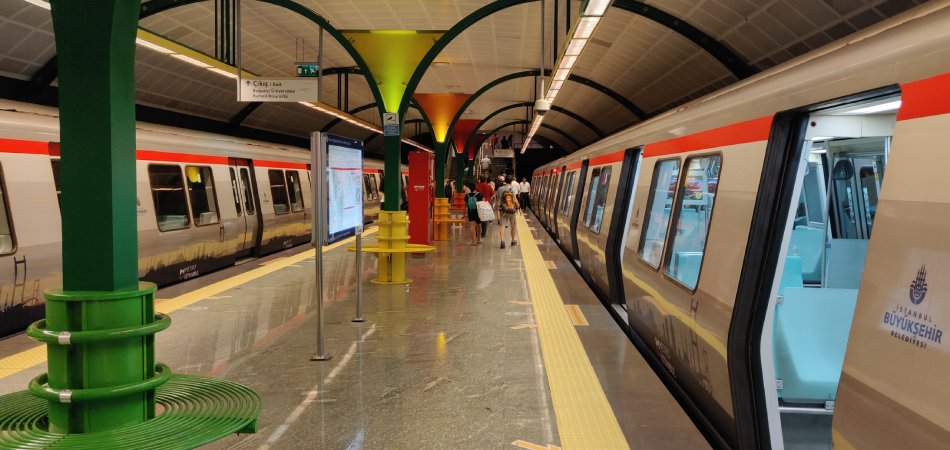
updated on february 6
Public transportation in Istanbul
Istanbul stretches over 5,000 km ² therefore moving is not always easy because it is one of the most congested cities in the world. Moreover, its topography makes the development of the public transportation complex (Istanbul, like Rome, was built on seven hills). There is currently a major project taking place in the city in order to develop public transport in Istanbul. This project mainly consists of the development of the Istanbul metro and in the connection between the two continents. The first step of this project was inaugurated on October 29 of 2013 and allowed the connection between the Asian and European sides via a railed tunnel under the Bosphorus .
During your trip we advise you to use public transport and especially the tram to get to the old town. This will allow you to move quickly at a lower cost and save time because Istanbul is really very bottled. At peak hours (between 8 am and 9:30 am, and between 5 pm and 8 pm) it is almost impossible to travel by car.
Map of public transport, and useful application for getting around
To download the map of public transport in Istanbul in PDF and JPG, click here .
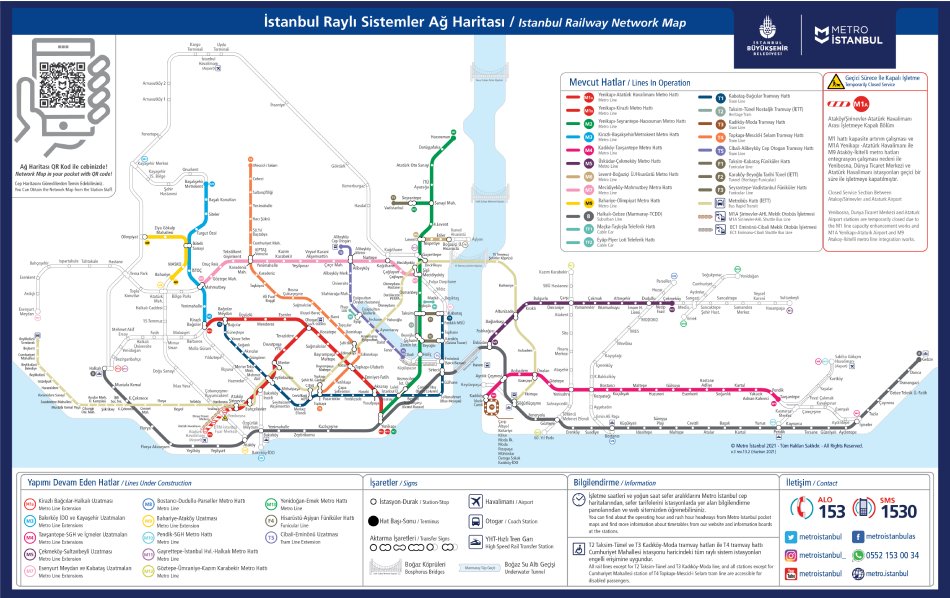
Useful application: To help you move around Istanbul we can advise you on the City Mapper application. A little less reliable, and less complete, Google Maps is not bad either.
The Istanbul kart (transport card)

In order to use all public transportation in Istanbul (boats, subways, buses, tramways, funiculars) , you will need the magnetic card, Istanbul Kart . You can find it in the small kiosks near all metro stations, piers, and also bus stations. It costs 70 TL , you will then add credit. Keep in mind that most trips cost approximately 17 TL each way. For more information you can visit the website of the municipality: https://www.iett.istanbul/en If you buy a card with a limited number of trips, you can do it directly in front of the turnstiles. The prices are 25 TL for one way, 45 TL for two ways, 70 TL for three ways, 105 TL for five ways, and 200 TL for ten ways.
THE MODERN TRAMWAY
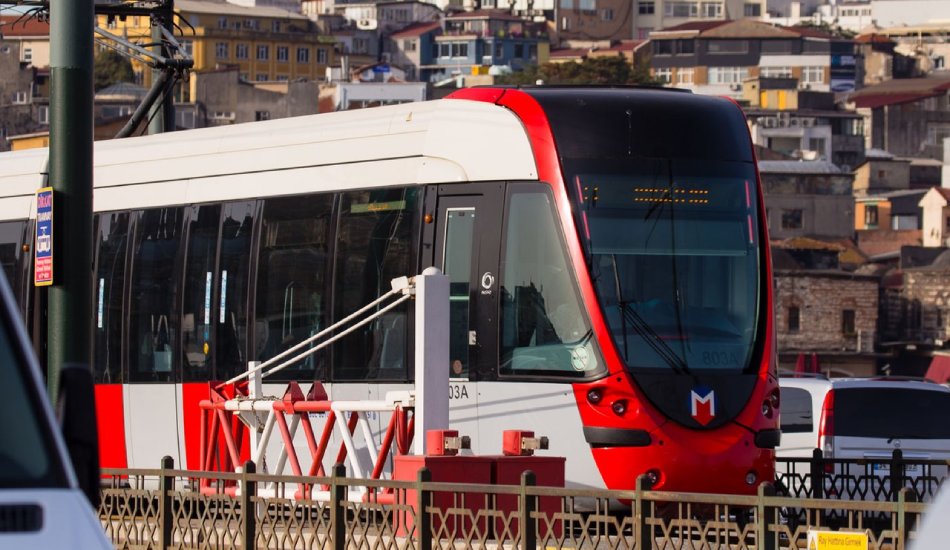
On the European side, there are two lines in service, the T1 line from Kabataş allows easy access to Sultanahmet and the T4 line that goes North – West of the city. It runs from 6 am to 11 pm. The tramway in Istanbul is very clean and has air-conditioned.
The T1 line will allow you to reach the main attractions of the city. We recommend you using it as it is really cheap and fast and definitely the easiest way to get to the old town . The main stops of T1 are:
- Kabataş — Dolmabahçe Palace, Taksim connection with the funicular (F1) to go to the pier to the Princes’ Islands and Kadıköy.
- Tophane — Museum of Modern Art in Istanbul.
- Karaköy —Connection Tünel funicular, (T) which will drop you on Istiklal Street.
- Eminönü — Spice Market.
- Sirkeci — Train station and connection to the Marmaray .
- Sultanahmet — Topkapı Palace, Hagia Sophia, Blue Mosque, Basilica Cistern, Archaeology Museum.
- Beyazit — Grand Bazaar.
- Zeytinburnu — Connection M1 .
Another line that may be of interest is the new T5 streetcar line. It will take you to the districts of the Golden Horn, such as Fener and Balat, or to the foot of Pierre Loti Hill, where you can take the funicular up to the cemetery. The main stops are:
- Eminonü — Departure/terminus, Spice Market – Connection with tramway T1
- Fener — One of Istanbul’s most fascinating districts, once predominantly populated by Greeks.
- Balat — Right next to the Fener district, historically populated by the Jewish community.
- Eyüp Sultan — Here you can take the funicular to Pierre Loti’s hill.
THE FUNICULAR
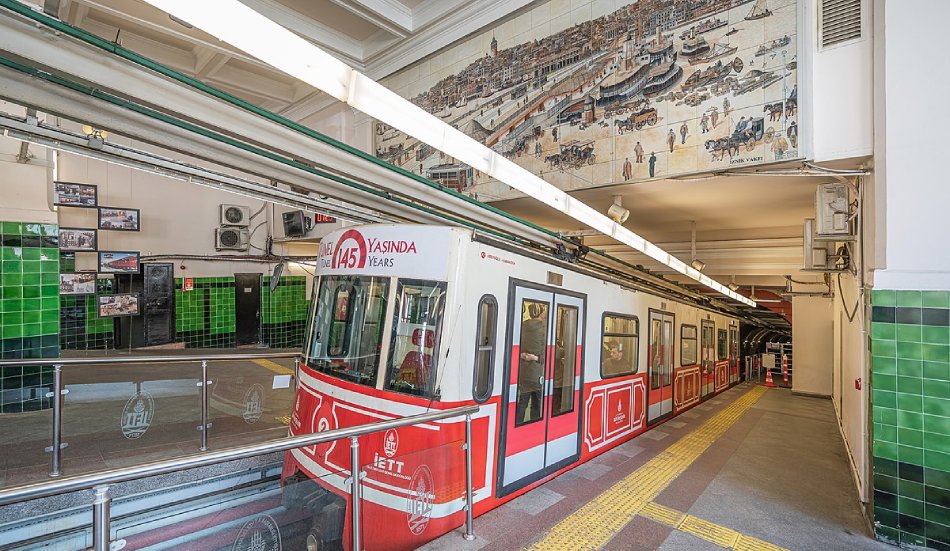
– Karaköy-Tünel (T): It allows you to go quickly down Istiklal Street and you will avoid climbing the slopes to get in neighborhoods like Galata. Once in Tünel, you can use the historical tram (NT) to go to Taksim Square. It runs from 7 am to 9 pm.
– Taksim-Kabataş (F1): It allows you to go from Taksim Square to Kabataş. From here, you can take the tramway (T1) to get to the old town, and the boat to the Princes’ Islands from Kadıköy. To go to the old town, another option is to take the M2 metro directly to the Golden Horn (Haliç stop) from Taksim.
THE HISTORICAL TRAMWAY
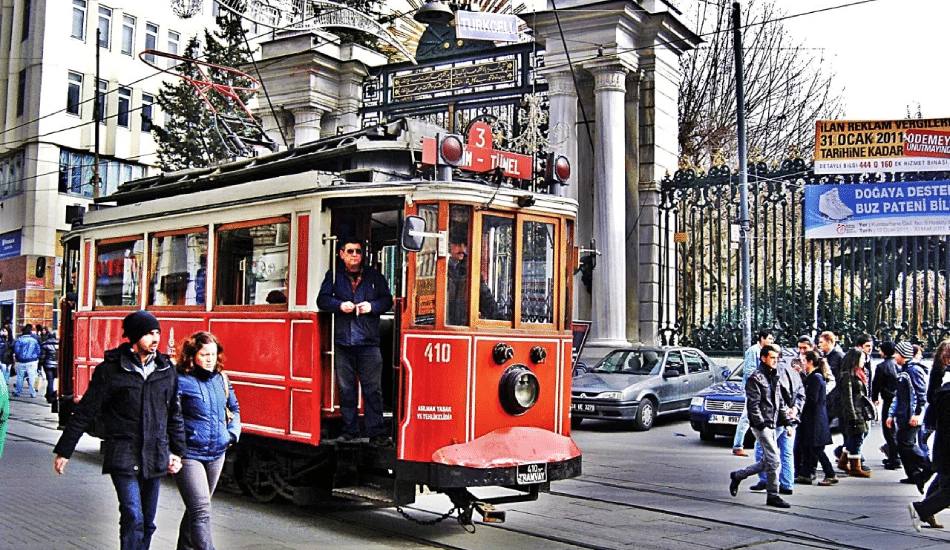
They look like trams out of an old movie, two lines are in service: the first on the European side (NT) which runs down the Istiklal Street from Taksim Square to Tünel, and the second (T3) is on the Asian side from the pier and it goes from Kadıköy to the Moda neighborhood.
THE METRO (SUBWAY)
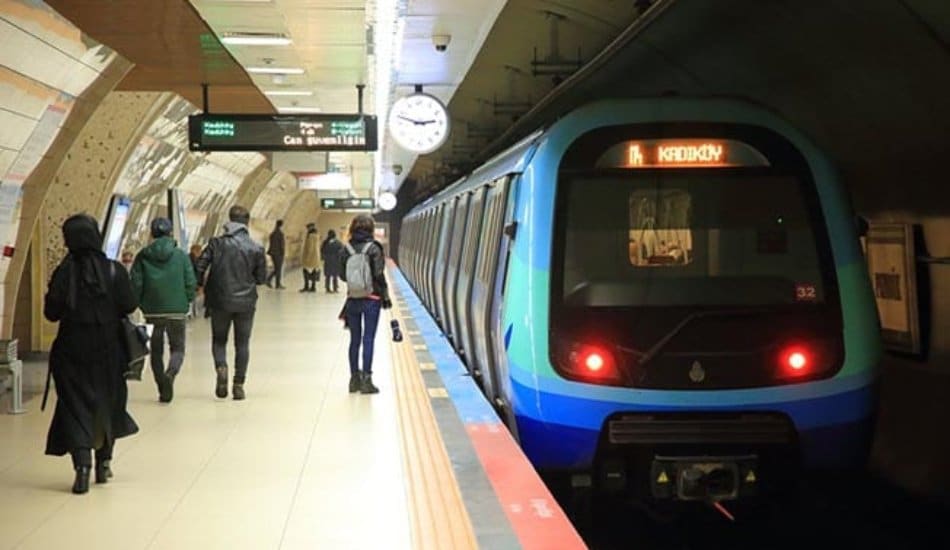
It is open from 6:15 to midnight , there are currently two lines on the European side. Unfortunately, these two lines are not connected yet. There is also a line on the Asian shore (M4) but it is not of great interest to you because it is not connected to Sabiha Gökçen Airport yet.
– Atatürk airport – Aksaray (M1): This metro line mainly allowed tourists to get to the center of Istanbul from the old airport on the European shore – Atatürk Airport – via Yenikapı station to reach the M2 metro. From now on, Atatürk Airport only accepts cargo and VIP passenger flights. As the new Istanbul airport (IST) is not served by the metro yet, this line is not essential for walking in the city of Istanbul.
– Yenikapi-Hacıosman (M2): It is the longest metro line in Istanbul and the one you will use the most. This is the one you need the most during your stay. Since the beginning of the year, it has been lengthened, it is now possible for example to get to the old city from Taksim Square and more. This is especially useful for businessmen residing in the district of Levent , or for travelers who have chosen to reside in more Turkish and less touristy areas like Nisantasi . Taksim Square is now only 2 stop Eminönü district where the spice market is located. The main stops of the M2 are:
- Yenikapı — This station is intended to be the hub of transport in Istanbul. You can already use the Marmaray from Yenikapı (the metro passing under the Bosphorus ) to reach Üsküdar on the Asian side.
- Haliç — This is the most useful station for tourists wishing to reach the old town or for those wishing to go from the old town to other areas that seem less accessible. You will be near the spice market and Eminönü tram station (T1).
- Şişhane — Located at the bottom of İstiklal Street, it will allow you to reach the Tünel funicular located right next to the station, as well as the Galata district .
- Taksim — Located in Taksim Square, the station can be reached quickly by foot from the districts such as Cihangir, Beyoğlu or Çukurcuma . You can also use the funicular (F1) to get to Kabataş where you’ll take the ferry for Asia and the Princes’ Islands , and the tram (T1) to get to the old town.
- Osmanbey — Located just minutes from the upscale Nisantaşı district. Very nice area with many bars and restaurants as well as luxury shops and many Turkish designers.
- Levent — This is the business district of Istanbul. There is also close to the metro two major shopping malls: Kanyon and Metrocity.
- İTÜ Ayazağa — Located near the chic shopping gallery İstinye Park (you need a little walk or take a taxi or a minibus). This gallery is a paradise for all lovers of fashion and luxury, you will find all the most luxurious brands.
– Marmaray: After long years of work, the European side and the Asian side are now connected by the metro which passes under the Bosphorus. It allows you to go to the Asian shores from Yenikapı or Sirkeci. Two stops from the Asian side are Üsküdar and Ayrılık Çesmesi. You can use the M4 to get to the Kadıköy district.
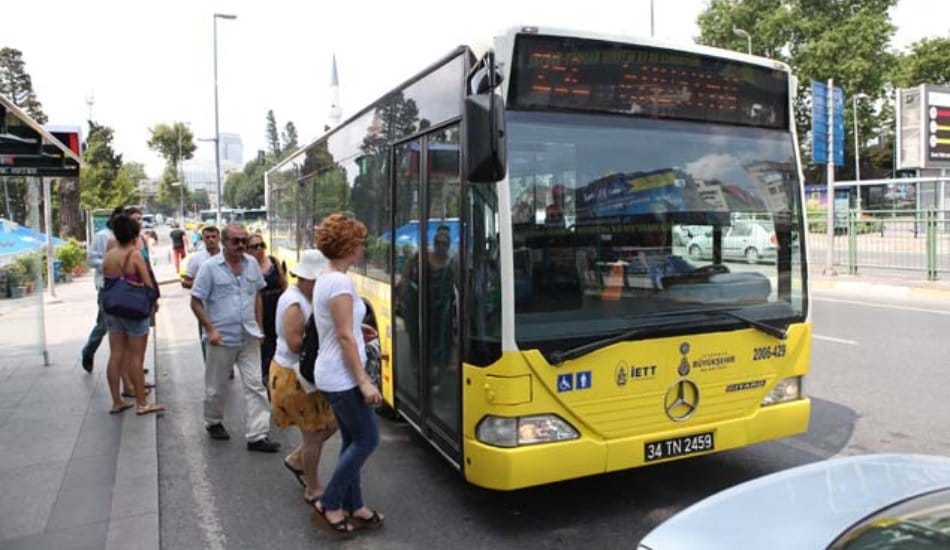
There are 400 bus lines in Istanbul, the majority work until midnight every night. Except for Sultanahmet (accessible by tram), buses go all over the city. Destinations and major stops are written in yellow on the sides of the buses.
For information on bus timetables and to see where they stop click here .
THE METROBUS
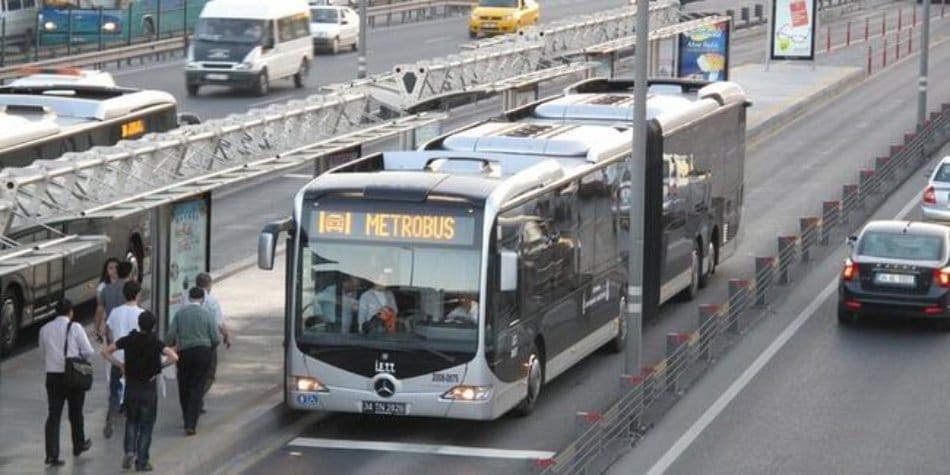
These are buses that run on reserved lanes to avoid congestion. Most of the areas served are on the outskirts of the city. Therefore, its use is not of great interest if you are visiting the city. Only the Istanbul Kart and the Mavi Kart (which is for monthly subscriptions) are accepted to access Metrobus. You can buy or recharge your Istanbul Kart at all stations.
THE PUBLIC FERRY
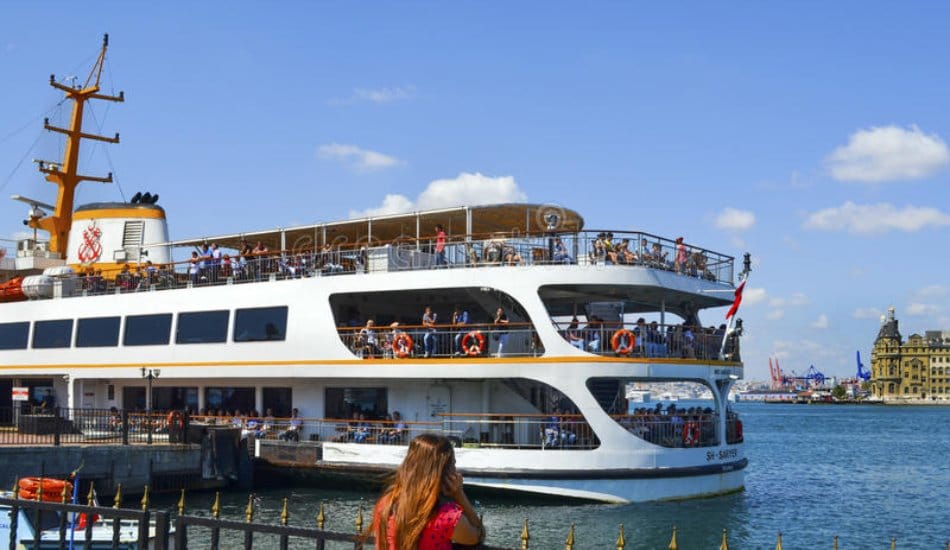
They allow you to move from Europe to Asia. As with the metro, Istanbul residents use public boats/ferries – “ vapur ” in Turkish – every day and save considerable time by avoiding constant traffic jams on the two main bridges of the Bosphorus. By taking the ferry, you will realize the vastness of the city, it is also a good way to see the city from the water at a lower price. The main piers on the European side are Eminönü, Kabataş, Karaköy, and Besiktaş, and on the Asian side, Üsküdar and Kadıköy.
Unlike the metro, Metrobus, and certain bus lines, ferries are in service between around 7 am till midnight (depending on the pier). You can use your Istanbul Kart to access the boats.
These public boats are also useful for reaching the Princes’ Islands for the price of 58 TL: One day in the Princes’ Islands .
For more information on timetables, click here .
If you want to cruise on the Bosphorus (see our article in the section “Ideas for days in Istanbul”: The Bosphorus ). We advise you to take the boat from Beşiktaş or Ortaköy rather than the one from Eminönü which is always full and less comfortable.
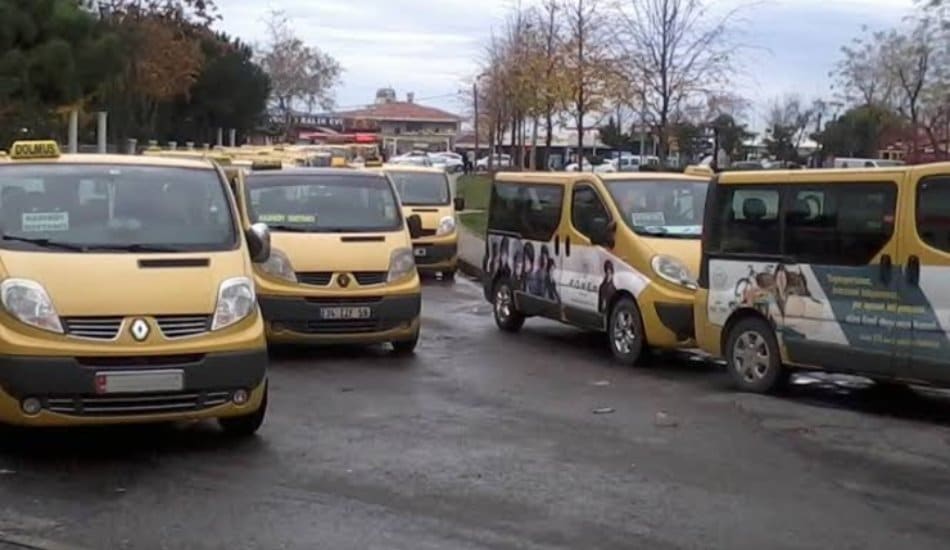
These are shared taxis that operate 24/7. It is fast, economical and widely used throughout Turkey. They run on a specific path and leave when they are full (8 passengers). On the way, you can get out wherever you want. The payment method is simple, once seated, state your destination to the driver who will tell you the price and hand him the money (only cash is accepted). The main dolmuş lines are in Europe: Beşiktaş – Taksim; and Taksim – Bakırköy, Yeşilköy; Sarıyer – Beşiktaş and Kadıköy and Üsküdar from Asia. There are also lines connecting Europe to Asia from Beşiktaş and Taksim.
We hope this article will help you get around this huge city of Istanbul. If you have any questions, you can ask us them in the comments so that all readers can benefit from your questions and our answers.
- Taxis in Istanbul
Who are we ?
Passionate about travel, food and current affairs, we created Too Istanbul with the desire to share our love and knowledge of Istanbul to give you the opportunity and desire to participate in the vibrant life of Istanbul, and make your trip a unique and rewarding experience and not just a visit.
Visit with us
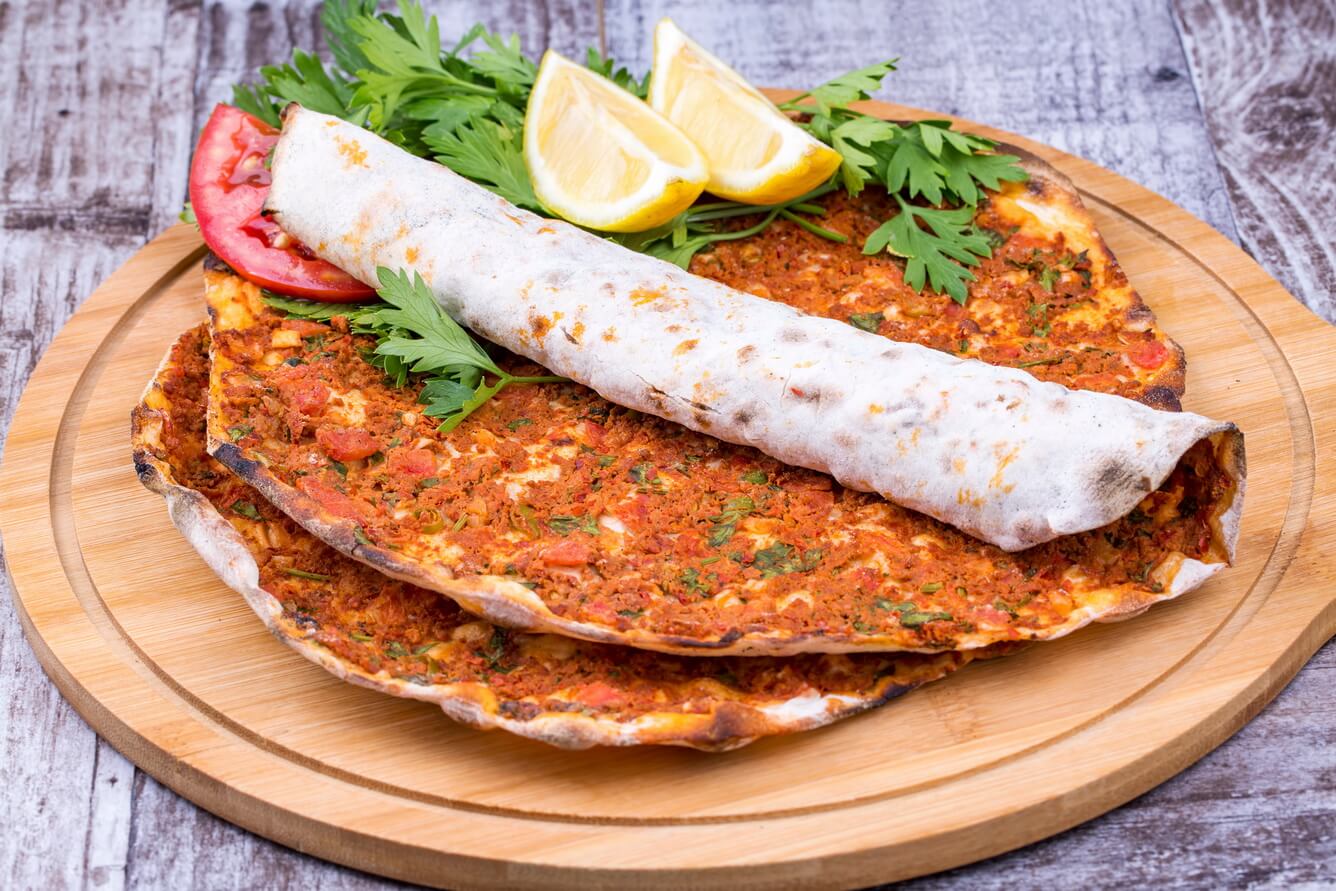
JOIN our culinary and cultural walk on two continents
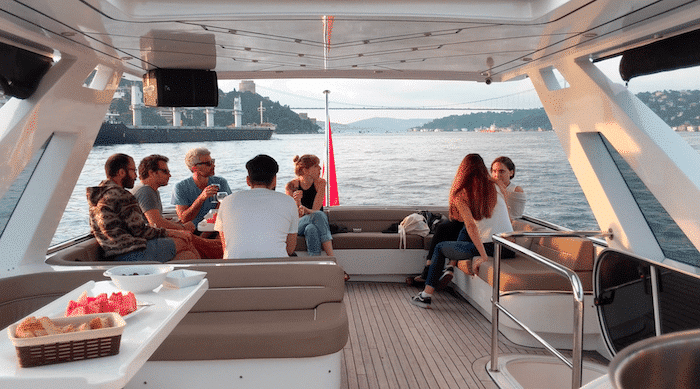
CRUISE on the Bosphorus with an aperitif
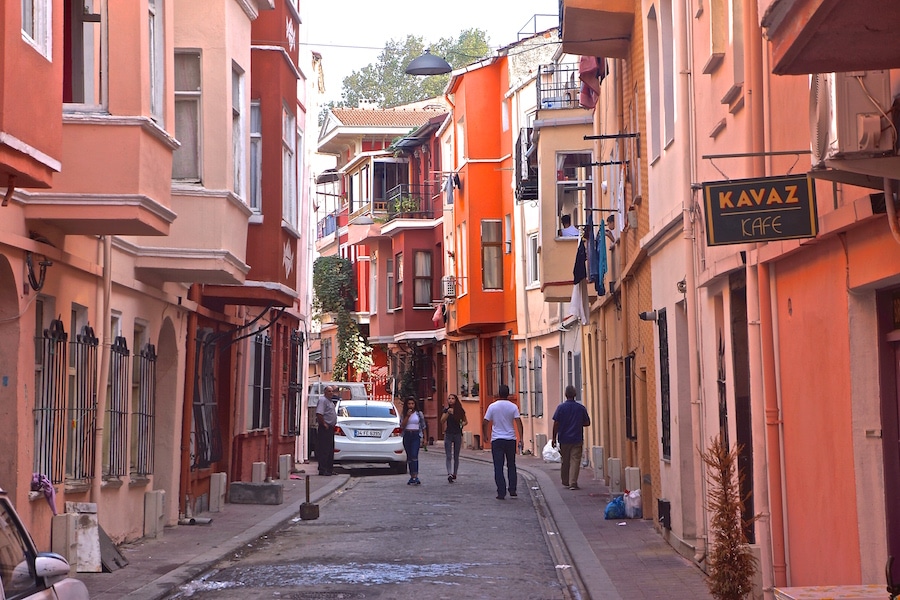
DISCOVER the contrasts of Istanbul, Fatih, Fener, Balat, Beyoğlu
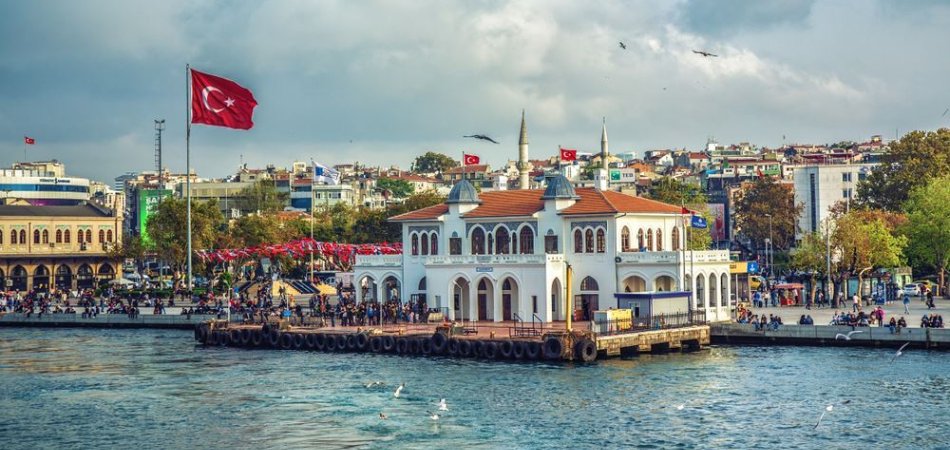
EXPLORE Kadiköy the new arty district of Asia
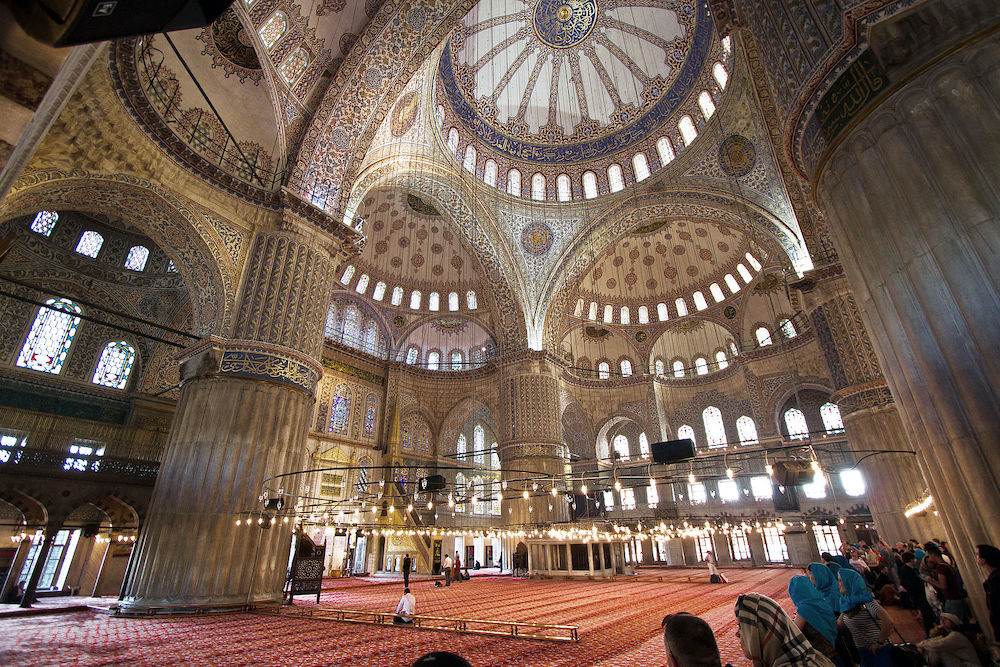
VISIT with us the great classics, Sultanahmet
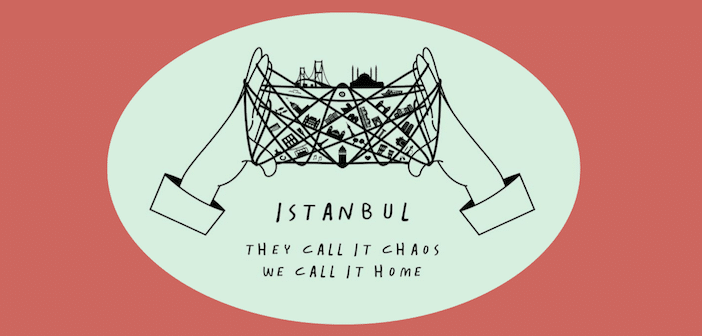
CREATE your tailor-made trip
Most commented
- Culinary and cultural walk in Istanbul
- Guide des transports en commun à Istanbul
- Accommodation in Istanbul: apartment or hotel?
- Voir un match de foot à Istanbul
- Small-group aperitif cruise on the Bosphorus
- Transfert depuis l’aéroport Sabiha Gökçen
- Les plus belles plages d’Istanbul
- Tour football et matchs à venir
- La rive asiatique d’Istanbul
- Rent a boat in Istanbul
11 Comments
Hello, This blog post was a great help when I first moved to Turkey. I was struggling to find my way in Istanbul and was confusing between all the options in the city. I’m sure this post is helping so many like me however it would be more helpful if you can include more information about transport prices. Otherwise, this post from capetocasa blog would be a great help as well https://www.capetocasa.com/istanbul-public-transport-guide/
Thanks for the information.
I would like to confirm if there is 24/7 transportation from any of the airports, because I have an international one that arrives at 11 PM.
This information is helpful it’s true but old. There are more lines now in Istanbul, like Marmaray line, M3 metro, M6 metro, M5 metro, Yenikapi Transfer Centre for M1A, M1B, M2 and Marmaray and Metrobus is at Beylikdüzü now. M7, M8, M9, M10, M11, M12, M13, T5 and F4 lines are under construction they’ll open soon
Thank you so much for all the Helpful information. I would like to know one more thing. Is there a Tram connecting from the Asia side to the European side, specifically at the Sultanahmet Area. Please assist me in this regard and if not could you please advice on the best form of transport to use from Asia to Europe side with the best time saver. Thank you in Advance
Your article was especially helpful. I had no idea how we were going to find our way in that huge beautiful city. Thank you
Bonjour Je vous ecrit en français car je sais que tooistanbul a vu l’existence grace a deux francophones (un français et un turc). J’avais une confusion entre metrobus et metro, maintemant grace a vous je comprends la difference.
Thank you! I’m planning to visit Istanbul in the spring or autumn this year. I’d seen google maps and few articles about Istanbul’s transportation but it still leaved me confused and a little bit overwhelmed. This article made me easily understand the layout and options for moving around Istanbul. Again, many thanks!
Thank u so much Its realy helpfull specialy when u dont have any information about how to move there my case and also with family.
Hello Yassine,
Thanks a lot for the compliment! If you need anything else! We would be happy to help you organizing your stay!
Best regards,
Tooistanbul’s team
Nice article and easy read. Thanks.
Submit a Comment Cancel reply
Your email address will not be published. Required fields are marked *
Save my name, email, and website in this browser for the next time I comment.
Submit Comment
A découvrir aussi
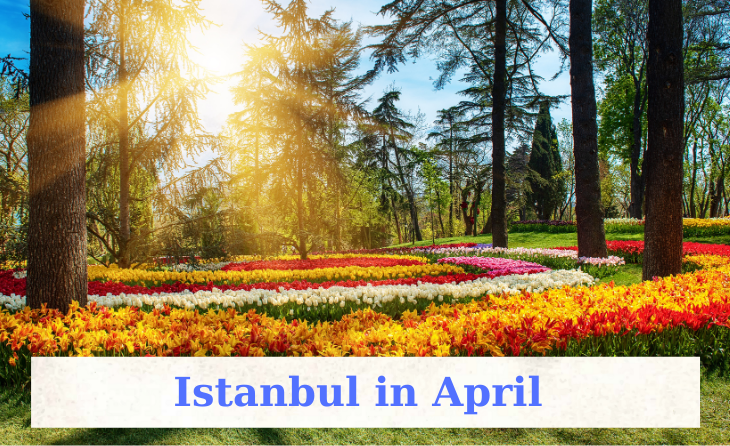
Istanbul in April
Currently , The Guide
WEATHER, WHAT TO SEE, WHAT TO DO IN ISTANBUL IN APRIL? Is the April weather pleasant for discovering Istanbul? What to do in Istanbul in April? April is the month when Istanbul awakens to spring. The city emerges from its winter slumber,...
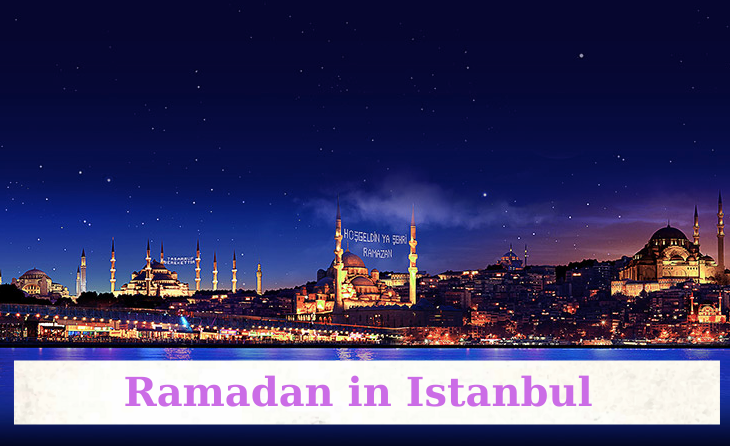

Ramadan in Istanbul
Ramadan in Istanbul : What's the difference? Is it a good idea to visit Istanbul during Ramadan? Imagine a city where the minarets rise majestically into the sky, where the streets vibrate with an infectious energy, and where the flavors and...
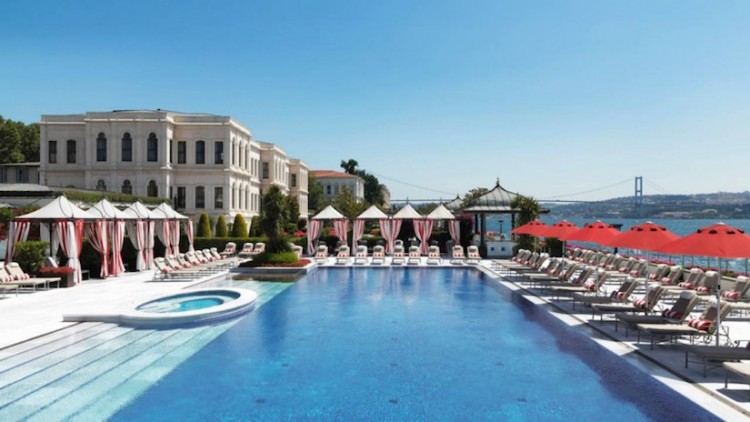
The best swimming pools in Istanbul
Activity , Swim
What are the most beautiful swimming pools in Istanbul? Summer in Istanbul is very warm, especially in July and August. During your stay, you will wonder how you can refresh and relax in a city that never stops. A good idea may be to go to the pool...
Jul 30, 2023 · istanbul · 6 min read
What’s the Best Way to Get Around in Istanbul?
Discover the best ways to get around Istanbul and explore its famous sights.
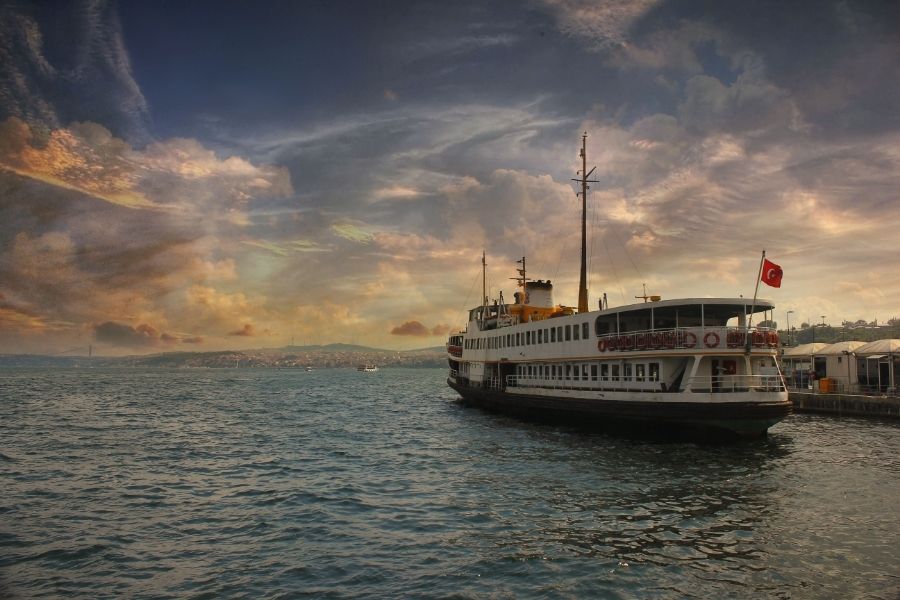
There’s so much to see and do in Turkey’s largest city, but what’s the best way to get around Istanbul? Here are the best ways to get around Istanbul so you can see all the sights .
Istanbul is home to incredible sights like the Hagia Sophia and the oldest covered bazaar in the world. You can get 360-degree views of the city from the Galata Tower. It's the only city in the world that lies on two continents: Europe and Asia. Yet, these sights aren’t all close together.
So, what’s the best way to get around Istanbul? Find out how to explore the city’s famous sights , ranked from best to worst.
The Best Ways to Get Around in Istanbul
The best way to explore Istanbul is on foot; however, you can’t explore all of Istanbul this way.
Tourists should plan to get around Istanbul on foot as much as possible to see more of the city and its rich culture.
You’ll see more of the city and its people on foot than by any other mode of transportation.
Walk along the Bosphorus Bridge, wander the old roads of the Grand Bazaar, and plan a day on foot at Sultanahmet, where you can see Topkapı Palace and the Hagia Sophia.
Istanbul is safe for you to go around on foot, as long as you avoid dark alleys or wandering late at night. Keep an eye on your belongings to avoid pickpockets in Sultanahmet.
Wear proper walking shoes to the Grand Bazaar. The winding streets aren’t all paved and can easily catch a high heel. Wear low wedges or flat, comfortable walking shoes to avoid tripping down one of the city’s hills.
Although walking is the best way to get around Istanbul, it isn’t always practical. Few people have the time or energy to walk the length of the city, especially if they’re booked for a Turkish hammam.
The best form of transit in Istanbul is the tram. There are 4 tram lines in Istanbul. You’ll likely rely on Bağcılar-Kabataş (T1), which serves the city’s main sights, like the Galata Tower. Istanbul’s trams are just as nice as any European tram.
Print an Istanbul tram map ahead of time, as stops don’t always have them listed. It’ll help you find stops and know which line to take. Trams are great options for budget travelers.
Get an Istanbulkart for 6 TL to reduce your transit costs from 4 TL to 2.30 TL.
Istanbul has the third oldest metro in the world , but you wouldn’t know that from riding it.
The city’s metro is a comfortable way to get around. It runs from all corners of the city, even outside of the tourist districts.
This is a great way to get into the city center from a hotel on the outskirts of the city. You can even ride beneath the Bosphorus continental divide with the Marmaray Rail Tunnel.
The metro is a great discount way to get from the city center to the Istanbul Airport (IST). Planned for August 2021, the M11 line will connect the airport to the city center in just 35 minutes . You can see more on Istanbul's airports in another article .
Although the stops are more spaced out than the tram or bus stops, Istanbul’s metro is one of the few ways you can avoid the city’s rush hour traffic. At 8 am and 6 pm, traffic comes to a standstill above ground. Go below the ground to avoid the slower transit above the ground.
The Istanbul bus network is the most extensive transit in the city. Although it runs to more locations than the tram or the metro, it has one major problem: space.
Due to the heavy traffic and designated bus lanes, people pack the buses to their limits. You may find yourself squished against strangers or struggling to get off past the mass of people.
Avoid the buses during rush hour times to maintain your personal space. The buses run outside of rush hour, from 6 am to midnight.
Although the buses go around the city, they aren’t a great way to take in any sights. You’ll spend most of your time focused on the coming stops, as the Istanbul buses don’t announce them.
5. Ferry or Seabus
Riding the ferry or the sea bus is one of the best ways to get around Istanbul.
Not only do the water vehicles avoid heavy rush hour traffic, but they also offer stunning views of the Bosphorus and Istanbul’s skylines.
There are several ports along the city’s shores used by both tourists and commuters. Keep your Istanbulkart handy to get discounted tickets, like a ride to Princes’ Island for 5.50 TL. You can even get a two-hour Bosphorus tour for 12 TL or a full-day adventure for 25 TL.
Not only does the ferry offer one of the most unique views of the city, but it’s also one of the cheapest tours you can find. Avoid the overpriced and scammy Bosphorus tours offered near the pier of Eminönü and opt for the affordable tour offered by the municipality.
Check the ferry timetables on the Şehir Hatları website .
Taxis are usually one of the best ways to get around a city, but not in Istanbul. Here, taxis are one of the biggest tourist scams in the country . Unfortunately, Istanbul’s taxi drivers continue two ruses meant to overcharge tourists.
Be careful of taxi drivers who claim their meter is broken, as they’ll give you a massively overpriced charge at the end of your journey. Don’t let your taxi driver take you sightseeing. They may try to take you on the scenic route or to see a particular place, meanwhile, they’re running their meter up to charge you more.
To get a safe taxi, ask your hotel to call one for you. Taxis are less likely to try to scam you if they are looking for the hotel’s repeat business.
You can also use the popular Turkish app BiTaksi (available in English) to find trusted taxis to take you around the city. Avoid taxis during rush hour, as road times can triple, and so will your fee.
Cars are the worst way to get around Istanbul.
Here are four reasons why:
- Turkey is known for its terrible drivers
- Istanbul has some of the worst traffic in the world
- Road signs are in Turkish
- Istanbul has almost no parking
While driving is a great way to get around Turkey, it is not the best way to get around Istanbul. You’ll spend more time in your car than seeing the city’s sights.
Between parking issues, traffic jams throughout the day, getting lost, and not understanding Turkish drivers’ inability to respect the rules of the road, you’ll quickly come to agree. Istanbul is not a city for driving.
Skip the car for your Istanbul trip and stick to public transport when you need to get somewhere further away.
Closing Thoughts
Istanbul has so many great neighborhoods to see and amazing things to do , but it can be hard to find the best way to get around the city. What works in Europe or North America won’t necessarily be the best here.
Usually, cars and taxis are the best way to get around cities due to their privacy and speed. Here, you’ll end up in a traffic jam as long as your trip.
Instead, opt to take public transit and walk when you can. Walking lets you see more of the city than you can on public transit. Istanbul’s tourist and bazaar areas are very easily walkable if you’re wearing good shoes.
Public transit will let you venture further than the tourist zones for a low price. Get the Istanbulkart for further discounts. Get a beautiful perspective of the city on the Bosphorus with the affordable Şehir Hatları (municipality) tours.
Use this guide to the best ways to get around Istanbul, so you don’t miss out on Istanbul’s best experiences .
14 must-do things on your trip to Istanbul
Nov 1, 2021 • 8 min read
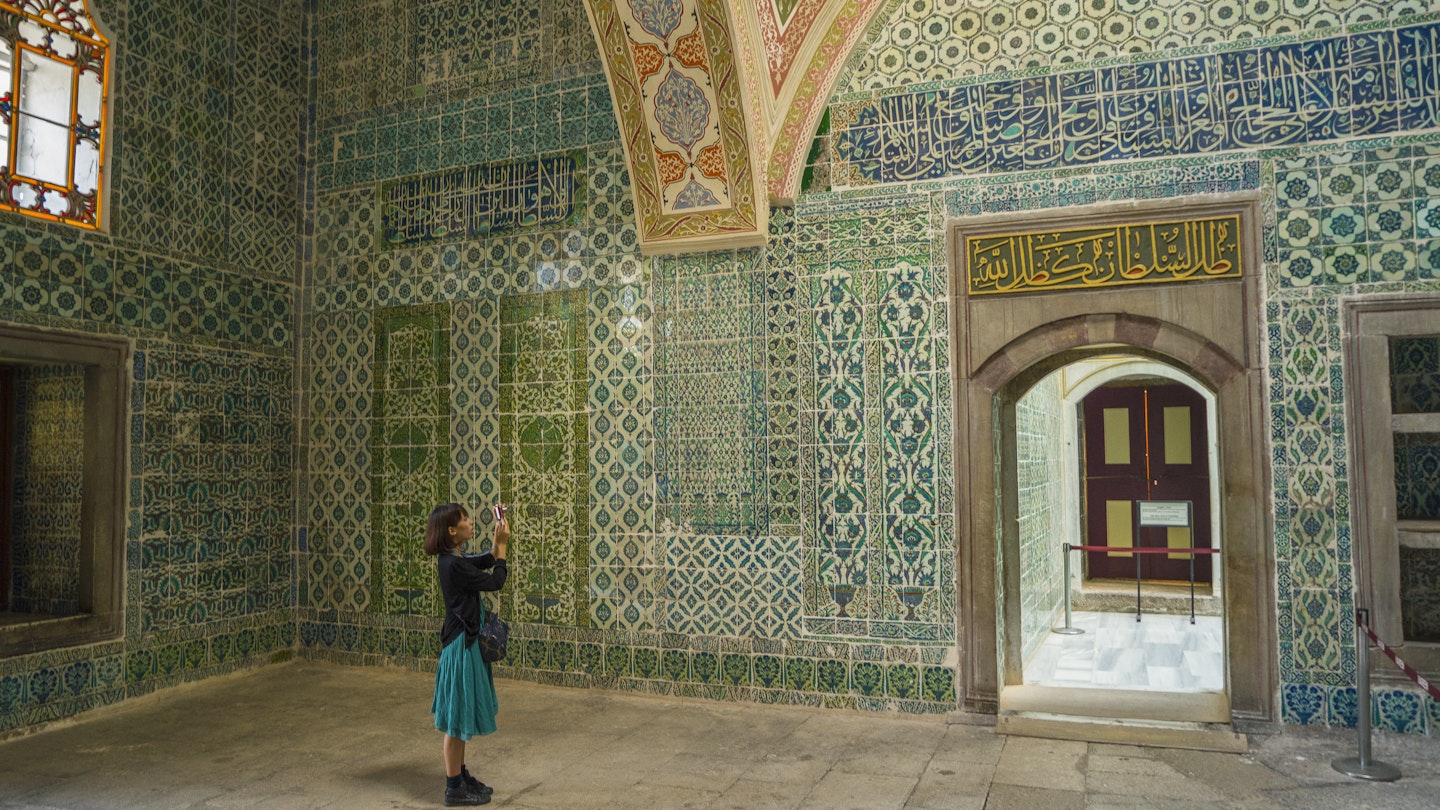
Get ready to add even more to your Istanbul itinerary: here are the top things to do in the city © Atlantide Phototravel / Getty Images
We’ve all heard the descriptions of Istanbul being a bridge between Europe and Asia, a place where East meets West and where cultures have coexisted for centuries. But not everyone is aware of its endlessly fascinating contradictions.
Here are the top things to do in Istanbul to experience the city’s different stories and faces.

Marvel at the Aya Sofya
History resonates when you visit the majestic Byzantine basilica of Aya Sofya . Built by order of the Emperor Justinian in the 6th century, its soaring dome, huge nave and glittering gold mosaics contribute to its reputation as one of the world's most beautiful buildings, and its fascinating history as church, mosque and museum make it the city's most revealing time capsule. Looted by marauding Crusaders in the 13th century, stormed by Ottoman invaders during the Conquest in 1453 and visited by millions of tourists after being converted into a museum in 1935, it is one of Turkey's greatest treasures.
Since its reconsecration as a mosque in summer 2020 , the Aya Sofya is closed to non-worshippers during the five daily prayer times, women must cover their heads and all visitors must take off their shoes to enter the inner narthex. Most of the building’s ancient marble floor has been covered by carpets, some of its mosaics are shielded by retractable screens and the upper gallery is inaccessible, but its historic grandeur remains breathtaking.

Experience the extravagance of Topkapı Palace
The secrets of the seraglio will be revealed during your visit to the opulent Ottoman Topkapı Palace complex occupying the promontory of Istanbul's Old City. A series of mad, sad and downright bad sultans lived here with their concubines and courtiers between 1465 and 1830, and extravagant relics of their centuries of folly, intrigue, excess, patronage, diplomacy and war are everywhere you look. Highlights include the huge Harem, impressive Imperial Council Chamber, object-laden Imperial Treasury and picturesque Marble Terrace.
Uncover the secrets of Topkapı Palace

Lose yourself in Istanbul's Bazaar District
The chaotic and colorful Grand Bazaar is the best-known shopping destination on Istanbul's historic peninsula, but it certainly isn't the only one. After exploring its labyrinthine lanes and hidden caravanserais, follow the steady stream of local shoppers heading downhill into the busy shopping precinct of Tahtakale, which has at its hub the seductively scented Spice Bazaar . From there, head back up toward the Blue Mosque and its attached arasta (an arcade-style Ottoman bazaar that typically featured practitioners of a single trade), where you may well find a lasting memento of your trip.
Ride Istanbul’s ferries
Climbing aboard one of the city's famous flotilla of ferries is the quintessential Istanbul experience. The trip between Asia and Europe on a commuter ferry is hard to beat, but the Bosphorus tourist ferries that travel the great strait from Eminönü toward the mouth of the Black Sea are even better, offering passengers views of palaces, parks and ornate timber mansions on both the Asian and European shores. It doesn't matter whether you opt for a long or short cruise: either is sure to be memorable.
Istanbul ferries will now run during the night at weekends

Revel in Istanbul's nightlife
Though Istanbul’s nightlife scene has suffered some setbacks, you can’t keep a good party town down. For a traditional night out, head to one of the Beyoğlu district’s meyhanes, tavern-like restaurants serving meze and fish where sing-alongs of classic songs flow with each new round of rakı, an anise-flavored liquor. Lively crowds of young beer-drinkers fill the pubs of the Beşiktaş Çarşı and central Kadıköy, while a swankier set sips cocktails near the Bosphorus in the bars and cafes of Bebek and Arnavutköy. For the full Istanbul experience, top off the evening by joining your fellow revelers in lining up for some late-night street food.
Get acquainted with Turkish contemporary art
Anchored by high-profile cultural institutions like Istanbul Modern , Pera Museum , SALT Beyoğlu and Yapı Kredi Kültür Sanat , the Beyoğlu district has long been a hub for art-lovers, with galleries and museums scattered on and around İstiklal Caddesi , and increasingly in the adjacent Karaköy, Tophane and Dolapdere neighborhoods as well. Well-established commercial galleries in stately apartment buildings also cluster among the chic boutiques of the Nişantaşı neighborhood, while hip Kadıköy has an up-and-coming independent art scene of its own.
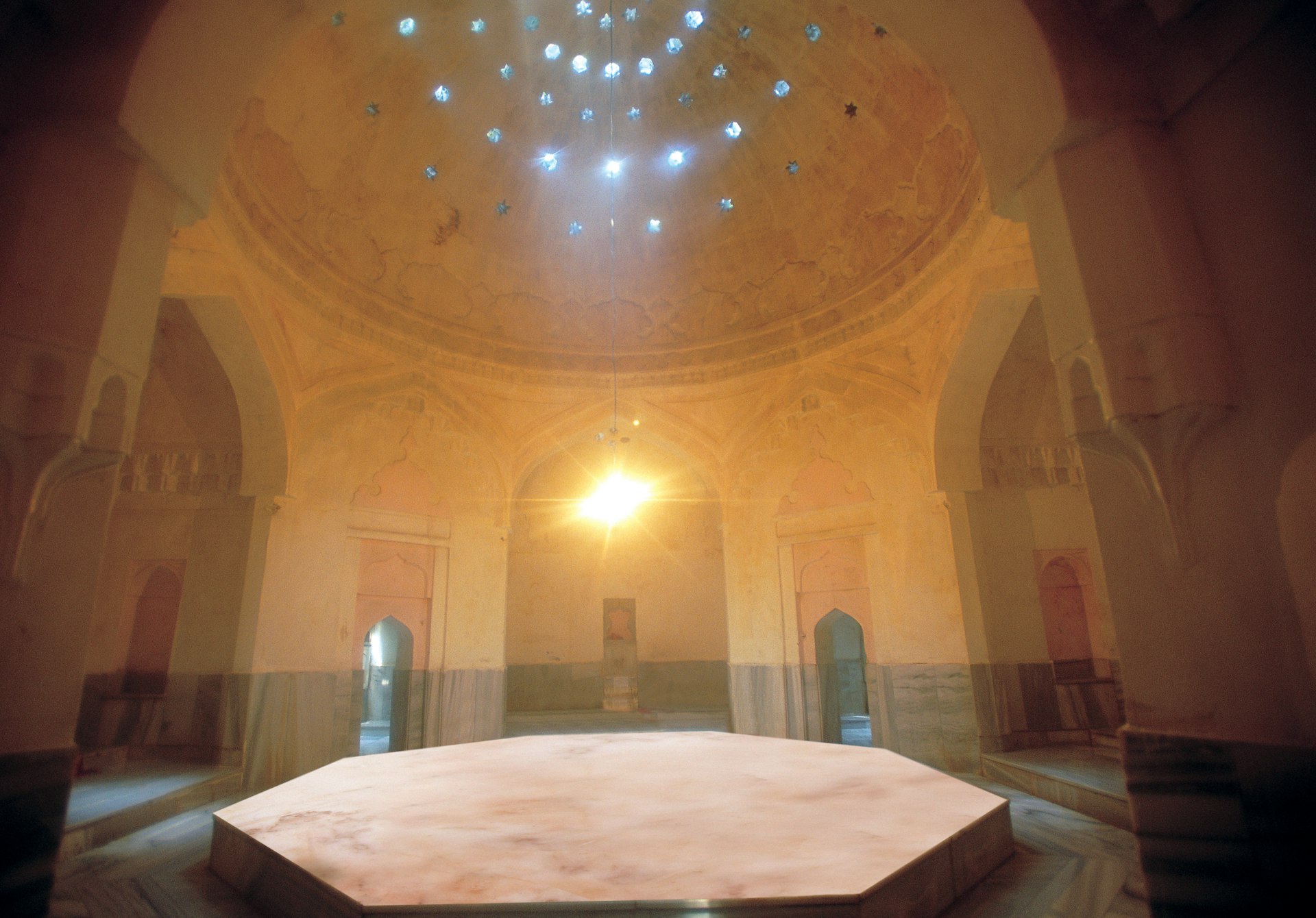
Surrender to the steam in a bath house
In life, there aren't too many opportunities to wander seminaked through a 16th-century Ottoman monument. But Istanbul's world-famous hamams offer just that: the chance to immerse yourself in history, architecture, warm water and soap suds all at the same time. A hamam treatment makes for a relaxing finale to a day spent pounding the city's pavements and gives a fascinating insight into the life and customs of Ottoman society. You can surrender to the steam at baths on both sides of the Galata Bridge: the Kılıç Ali Paşa Hamamı in Tophane and the Ayasofya Hürrem Sultan Hamamı in Sultanahmet are particularly stunning and luxurious.
Istanbul's bathhouses: a step-by-step guide
Hang out with the cool kids in Kadıköy
Riding a ferry across the Bosphorus is one of Istanbul’s great pleasures and the Asian-side neighborhood of Kadıköy is becoming a destination in itself, with hip cafes, bars, restaurants and boutiques frequented by a lively young crowd. Peruse the colorful produce market , hunt for street-art murals in the backstreets, visit the museum-home of Turkish rock giant Barış Manço or stroll the waterfront with an ice cream in hand. The sunset views from the shoreline are among the most spectacular in the city.

Sample the flavors of Istanbul
More than anything else, Istanbullus love to eat, and food is much more than mere fuel. Instead, it’s a celebration of community. Meals unfurl with great ceremony – they are joyful, boisterous and almost inevitably communal. The national cuisine has been refined over centuries and is treated more reverently than any museum collection in the country. That’s not to say it’s fussy, because what differentiates Turkish food from other national noshes is its rustic and honest base. The small meze dishes you’ll eat will be simple, the kebaps austere, the salads unstructured and the seafood unsauced. Flavors will explode in your mouth because ingredients are used in season.
Top 5 Istanbul cooking courses and food tours
Admire the architecture of Süleymaniye Mosque
Commissioned by the Ottoman sultan Süleyman I, known as “the Magnificent,” this 16th-century mosque has a fittingly grand perch atop one of the old city’s seven hills. The view from here is one of the finest in Istanbul, looking out over domes and rooftops to the confluence of the Bosphorus and Golden Horn waterways and beyond. With its elegant symmetry and soaring interior, the mosque itself is considered among the masterpieces of the great architect Mimar Sinan. The complex around it is inviting and serene, with tall trees, a grassy lawn and a rose-studded cemetery.
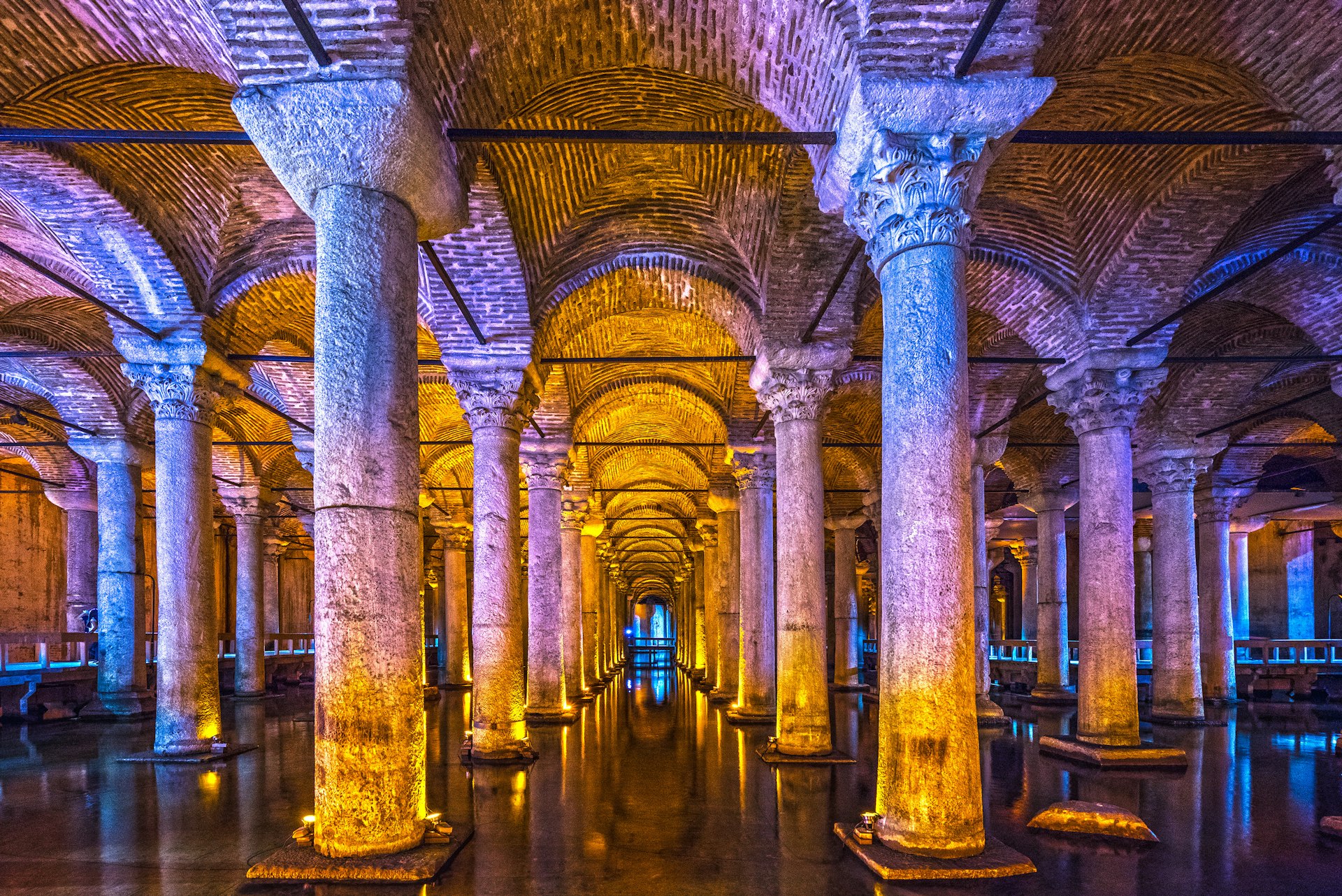
Go underground at the Basilica Cistern
When the Byzantine emperors decided to build something, they certainly didn't cut corners. The extraordinary subterranean Basilica Cistern , located opposite Aya Sofya, features a wildly atmospheric forest of columns (336 to be exact), vaulted brick ceilings, mysterious carved Medusa-head capitals and ghostly patrols of carp. A testament to the ambitious town planning and engineering expertise of the Byzantines, the cistern has played a starring role in innumerable motion pictures (remember From Russia with Love ?) and is now one of the city's best-loved tourist attractions.
Go tile-mad at the Blue Mosque
Officially named the Sultan Ahmed Mosque, after the early 17th-century Ottoman ruler Ahmed I, the Blue Mosque gets its better-known moniker from the color of the tens of thousands of İznik tiles that adorn its interior. With its enormous courtyard, grand prayer hall and six minarets (an unprecedented number for a mosque when it was constructed) this is a building made to impress – and to rival the Aya Sofya, which sits directly opposite across a landscaped square.

Ogle the opulence of Dolmabahçe Palace
Weighing in at nearly 10,000 pounds, the crystal chandelier hanging over the Ceremonial Hall of Dolmabahçe Palace exemplifies the opulence of this royal residence commissioned in the mid-19th century by Sultan Abdül Mecit I. It’s a glorious mishmash of styles and materials, with ceilings gilded with thousands of pounds of gold, marble floors, crystal bannisters and bearskin rugs. The Bosphorus views are just as dazzling as the decor.
Let your feet be your guide
Istanbul’s marvelous sights could keep a visitor busy for months, but it’s worth taking some time to explore its myriad neighborhoods as well. Though the city is sprawling, its central districts are walkable and reward wandering, with lively street life and distinct identities. Follow the film crews and Instagram influencers through shabby-chic Fener and Balat’s historical lanes ; sip black tea with a Golden Horn view at the Pierre Loti Café , perched above the leafy cemeteries and holy tomb complexes or Eyüp; or watch fishermen cast their lines from the Bosphorus village of Arnavutköy.
You might also like: A hotel in Istanbul has the world's first baklava butler The best shops you can only find in Istanbul Local's guide to Istanbul
This article was first published Feb 10, 2011 and updated Nov 1, 2021.
Explore related stories

Mar 20, 2022 • 7 min read
Istanbul has always lured traders and shoppers. Here's our guide to shopping in this dazzling city, from the Grand Bazaar to the boutiques of Nişantaşı.
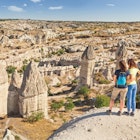
Feb 1, 2022 • 7 min read

Jan 3, 2022 • 8 min read

Dec 13, 2021 • 6 min read
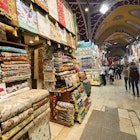
Dec 9, 2019 • 4 min read

Nov 5, 2019 • 5 min read

Feb 27, 2019 • 8 min read

Jan 2, 2019 • 7 min read

Jun 14, 2018 • 7 min read

Aug 17, 2015 • 6 min read
- The Best Ways To Get...
The Best Ways To Get Around Istanbul

With traffic that might as well be described as the tenth circle of hell in Dante’s Inferno , Istanbul ’s various modes of transportation may be crowded, but they serve as a savior in disguise. Get to know all the buses, ferries, and trains that will take you to your destination without getting stuck in eternal traffic.
The vapur (ferry) is the best way to get from the European to the Asian side (or vice versa) when the bridge is absolutely full of cars. Rush hour starts at around 8AM and ends 6PM on weekdays, so lots of people commuting to and from work prefer to glide over the Bosphorus instead. There are three main ferry stations on the European side: Beşiktaş , Kabataş (currently under construction) and Karaköy. There is also Eminönü, from where ferries go directly to the Kadıköy Ferry Station on the Asian side. You can check out the timetables for all Istanbul ferries (including Bosphorus tours) via the Şehir Hatları website. As an alternative, the Ido and Dentur Avrasya deniz otobüsleri (sea buses) also take off from Beşiktaş and Kabataş and go to different areas of the Asian side, as well as the islands.

The metrobus definitely has its pros and cons when it comes to its reputation. At first glance it’s a great alternative, because the metrobuses have their own lanes, allowing them to drive right through the traffic, taking passengers all the way from one end of the city to the other (see map). However, because the metrobus makes frequent stops, it’s also infamous for its packed-to-the-limit rides, so expect to get uncomfortably close to other passengers and prepare for potentially low personal hygiene standards.

Istanbul’s metro system has grown at an incredible rate over the last years, with more lines currently in construction set to open in 2018. Even though the metro lines can get very crowded during rush hour, they are one of the best alternatives for getting around. The European side has plenty of metro lines that connect all the major neighborhoods. Make sure to ride Tünel , which connects Karaköy and Beyoğlu and is the world’s second oldest subterranean urban rail line (inaugurated in 1875).

It was a pretty big deal when Marmaray opened because of its rail tunnel that goes under the Bosphorus strait. At the moment, Marmaray only runs from Kızılçeşme on the European side to Ayrılık Çeşmesi on the Asian side, but it’s already become quite the popular alternative for avoiding the bridge. During construction, Byzantine shipwrecks dating from the fifth to the eleventh century were discovered (something that happens often in Istanbul) setting back the opening date by four years. If you do plan on taking the Marmaray, make sure to check out the old Sirkeci train station for a taste of the past before you get on board this brand new mode of transportation.

You’ll soon realize that there are taxi cabs all over Istanbul just driving around empty, looking for passengers. If the traffic isn’t at its peak, cabs are a good way to get around if you’re feeling a bit lazy. Make sure to get into a cab that has a logo on its car doors, which means it’s connected to a taxi stand, which eliminates the chance of getting swindled. If you want to be extra careful, use the BiTaksi app, which sends the nearest trusted cab your way.

Culture Trips launched in 2011 with a simple yet passionate mission: to inspire people to go beyond their boundaries and experience what makes a place, its people and its culture special and meaningful. We are proud that, for more than a decade, millions like you have trusted our award-winning recommendations by people who deeply understand what makes places and communities so special.
Our immersive trips , led by Local Insiders, are once-in-a-lifetime experiences and an invitation to travel the world with like-minded explorers. Our Travel Experts are on hand to help you make perfect memories. All our Trips are suitable for both solo travelers, couples and friends who want to explore the world together.?>
All our travel guides are curated by the Culture Trip team working in tandem with local experts. From unique experiences to essential tips on how to make the most of your future travels, we’ve got you covered.

See & Do
The most beautiful places in turkey.

The Best Hiking Trails in Cappadocia, Turkey

The Nomadic Travels of Kadıköy’s Famous Bull Statue

Guides & Tips
The best tours of istanbul and turkey.

Secrets Of The Steppe: Exploring Northeast Turkey

How to have the Perfect Short Stay in Istanbul

A Resurgence of the Arts in Istanbul

Hot-Air Ballooning in Cappadocia – What You Need to Know

Local Insider - Culture Trip's Guide to Majestic Turkey

Where to Travel in Spring 2023

Your Travel-Good Guide to Turkey in 2021

Places to Stay
The best hotels to book in turkey for every traveller, culture trip spring sale, save up to $1,100 on our unique small-group trips limited spots..

- Post ID: 899917
- Sponsored? No
- View Payload
Istanbul Travel Guide
Book your individual trip , stress-free with local travel experts
Select Month
- roughguides.com
- istanbul-around
- Travel guide
- Itineraries
- Local Experts
- Travel Advice
- Accommodation
Plan your tailor-made trip with a local expert
Book securely with money-back guarantee
Travel stress-free with local assistance and 24/7 support
Uniquely among the world’s cities, Istanbul stands astride two continents, Europe and Asia. As if its spectacular geographical location were not enough, it can also boast of being the only city to have played capital to consecutive Christian and Islamic empires, a role that has shaped the region’s history for more than 2500 years and bequeathed to Istanbul a staggering wealth of attractions; these range from the masterpiece Byzantine church of Haghia Sophia (Aya Sofya) to the formidable city walls, and the domes and minarets of the Ottoman mosques and palaces that dominate the city skyline. Although no longer its capital, the city remains the vibrant economic, cultural and intellectual heart of modern Turkey, a bustling, go-ahead city where east really does meet west.
Arts, entertainment and festivals
The bosphorus cruise, city danger watch, i̇stanbul festivals, july/august, october/november, the land walls, the northwest quarter, the princes’ islands.
In conservative districts such as Fatih, bearded men sporting skullcaps and baggy shalwar -style trousers devoutly heed the call to prayer, while women wouldn’t dream of leaving the house with their heads uncovered. Yet across the water, the tidal wave of humanity sweeping down İstiklal Caddesi (Independence Street) includes young Turkish men and women in designer jeans and trainers who have rarely ever been to a mosque. In business districts such as Şişli, commuters arrive via the metro to work in high-rise office blocks, shop in state-of-the-art malls, and at weekends can be out clubbing until 6am.
Whether yours is the Istanbul of the Blue Mosque and the Topkapı Palace , or the Beyoğlu nightclubs and swish rooftop cocktail bars, the city takes time to get to know. Three to four days is enough to see the major historical sights in Sultanahmet and take a ferry trip on the Bosphorus . But plan on staying in Istanbul a week, or even two, if you want to fully explore the backstreets of the old city and the outlying suburbs and islands.
Brief history
In 2008, while digging the Yenikapı metro station, archeologists uncovered a Neolithic settlement dating back to circa 6500 BC. In popular tradition, however, the city was founded in the seventh century BC by Byzas , from Megara in Greece – hence the original name of Byzantium . Over the next thousand years, Byzantium became an important centre of trade and commerce, though not until the early fourth century AD did it reach the zenith of its wealth, power and prestige. For more than 350 years, it had been part of the Roman province of Asia. On Diocletian’s retirement in 305, Licinius and Constantine fought for control of the empire. Constantine finally defeated his rival on the hills above Chrysopolis (Üsküdar) and chose Byzantium as the site for the new capital of the Roman Empire in 330 BC. The hilly promontory, commanding the Bosphorus and easily defensible on its landward side, was a superb choice. It was also well placed for access to the troublesome frontiers of both Europe and the Persian Empire.
In 395, the division of the Roman Empire between the two sons of Theodosius I left what was now named Constantinople as capital of the eastern part of the empire. It rapidly developed its own distinctive character, dissociating itself from Rome and adopting the Greek language and Christianity . Long and successful government was interrupted briefly, in Justinian’s reign, by the Nika riots in 532. Half a century later, however, the dissolution of the Byzantine Empire had begun, as waves of Persians, Avars and Slavs attacked from the east and north. The empire was overrun by Arab invaders in the seventh and eighth centuries, and by Bulgars in the ninth and tenth. Only the city walls saved Constantinople, and even these could not keep out the Crusaders , who breached the sea walls in 1204 and sacked the city.
As the Byzantine Empire declined, the Ottoman Empire expanded. The Ottomans established first Bursa, then Edirne, as their capital, and Ottoman territory effectively surrounded the city long before it was taken. In 1453, Mehmet II (the Conqueror) – also known as Fatih Sultan Mehmet – besieged the city, which fell after seven weeks. Following the capture and subsequent pillage, Mehmet II began to rebuild the city, starting with a new palace and continuing with the Mosque of the Conqueror (Fatih Camii) and many smaller complexes. Tolerant of other religions, Mehmet actively encouraged Greek and Armenian Christians to take up residence in the city. His successor Beyazıt II continued this policy, settling Jewish refugees from Spain into the city in an attempt to improve the economy.
In the century following the Conquest, the victory was reinforced by the reign of Süleyman the Magnificent (1520–66), “the Lawgiver” and greatest of all Ottoman leaders. His attempted conquest of Europe was only thwarted at the gates of Vienna, and the wealth gained in his military conquests funded the work of Mimar Sinan , the finest Ottoman architect.
A century after the death of Süleyman, the empire began to show signs of decay. Territorial losses abroad combined with corruption at home, which insinuated its way into the very heart of the empire, Topkapı Palace itself. Newly crowned sultans emerged, often insane, from the institution known as the Cage, while others spent time in the harem rather than on the battlefield, consorting with women who increasingly became involved in grand-scale political intrigue.
As Ottoman territory was lost to the West, succeeding sultans became interested in Western institutional models. A short-lived parliament of 1876 was dissolved after a year by Abdülhamit II, but the forces of reform led to his deposition in 1909. The end of World War I saw Istanbul occupied by Allied troops as the victors procrastinated over how best to manage the rump of the once-great empire. After the War of Independence, Atatürk’s declaration of the Republic in 1923 and the creation of a new capital in Ankara effectively solved the problem.
The population of Greater Istanbul has increased twelvefold since the establishment of the Turkish Republic, and stands today at around 15 million. This rapid urban growth has left the city with more than its fair share of problems, from horrendous traffic congestion to housing and water shortages and rising crime rates. A UNESCO threat to revoke the city’s “World Heritage” status and place it on the “In Danger” list focused the minds of the government and local authorities on preserving the city’s glorious heritage, and Istanbul emerged from its year as a European Capital of Culture in 2010 with great credit.
Much else has been done to improve the infrastructure of one of the world’s leading cities. A government-backed housing scheme offers quality, affordable housing to low-income families in order, eventually, to replace the shanty-dwellings that have long ringed the suburbs. The European and Asian sides of the city were linked by a rail tunnel under the Bosphorus in late 2013, and the metro systems either side of the Golden Horn joined by a (controversial) bridge early in 2014. The Horn itself, once heavily polluted, has been cleaned up, and both anglers and cormorants can now be seen successfully fishing in its waters.
Travel ideas for Turkey, created by local experts

4 days / from 1050 USD
Sensational landscapes of Cappadocia
3 different modes of transportation to explore Cappadocia - by hot air balloon, on the back of a camel as well as on an ATV quad. Why choose if you can have it all? Four days filled with fun and adventure in the volcanic valleys around Cappadocia make an unforgettable trip.

5 days / from 1100 USD
City & culture - Istanbul and Cappadocia
Explore two absolute highlights in Turkey - Istanbul, the former capital of the Ottoman Empire with its many landmarks. After a few days in the city, fly to Cappadocia and explore the surreal surroundings, either on day tours or from above in a hot air balloon.

9 days / from 2500 USD
Magical Turkey
Visit Gobekli Tepe and Mount Nemrut in Southeastern Anatolia before proceeding to Cappadocia with its volcanic scenery. After a few days in the valleys, continue to Pamukkale and the ancient city of Ephesus. Your tour starts and ends in Istanbul.
İstanbul hosts a decent range of annual cultural festivals , and matches other European cities for the breadth of its arts scene . State-subsidized theatre, opera and ballet make performances affordable for all, and there’s something going on almost every night at venues around the city. Music features heavily over the summer months, when international festivals draw musicians from all over the world.
Taking a boat trip up the Bosphorus, from the bustling quays of Eminönü to the quiet fishing village of Anadolu Kavağı, is a highlight of any visit to İstanbul. The long Bosphorus Cruise , run by the Şehir Hatları company ( t 444 1851, w sehirhatlari.com.tr ), leaves from the Boğaz Ferry Terminal just east of the Galata Bridge in Eminönü (daily: May–Oct 10.35am & 1.35pm, Nov–April 10.35am; one-way TL15, round-trip TL25).
In summer, especially at weekends, the queues to buy tickets can be very long, so allow at least half an hour, or, preferably, buy your ticket a day or two in advance. There are also often long queues to board, so late-comers end up sitting in the worst seats. The ferries are rather antiquated but comfortable enough, and you can buy snacks, sandwiches and drinks on board. The round trip, including a 2hr 30min lunch stop at Anadolu Kavağı, takes about seven hours.
The boat stops at Beşiktaş, Kanlıca (Asia), Yeniköy, Sariyer and Rumeli Kavağı (all Europe) and, finally, Anadolu Kavağı (Asia); the only stop on the return is Beşiktaş. You can leave the boat at any of the landings to explore the waterfront or hinterland, but most passengers do the return cruise. A shorter version is also available for TL10, departing from the same ferry terminal and covering the same distance with no stops (other than to pick up more passengers at Üsküdar). The tour takes around two hours, departing Eminönü at 2.30pm (April–Oct daily; Nov–March Sun & public holidays).
On Saturday nights only, between early June and mid-September, a night-time Mehtaplı cruise (TL20) makes an attractive alternative, with the great suspension bridges lit up like Christmas trees, and the lights of Asia and Europe twinkling on either side. The boat departs Eminönü at 7pm, reaching Anadolu Kavağı at 8.30pm, where it moors for dinner, before arriving back in Eminönü around midnight.
The private Turyol company also runs tours up the Bosphorus, as far as the Fatih bridge. Boats depart every hour on the hour on weekdays, more frequently at weekends, and the 1hr 30min round trip costs TL12.
Istanbul is undoubtedly far safer than most European or North American cities, and cases of mugging and assault against tourists are rare.
For the average visitor, pickpocketing is the main cause for concern: be particularly careful around Sirkeci station, the Eminönü waterfront, the Galata Bridge, and around Taksim (especially at night). Also avoid being on or around the Byzantine land walls at dusk/night. Be very careful, too, on public transport , particularly when it is crowded. If you feel anyone is harassing or attempting to pickpocket you, try calling out " imdat! "(meaning “help!”) and contact the tourist police.
Visitors should also be aware that political demonstrations sometimes turn into violent confrontations between police and protestors, as in the Gezi Park (part of Taksim Square) riots of 2013. Galatasary Meydanı, on busy İstiklal Caddesi, is the starting point for many protests.
İstanbul is home to Turkey’s best restaurants, including several that lavish time and skill on old Ottoman cuisine, and, thanks to the lengthy coastline, fish is a firm menu favourite. Snacks are ubiquitous, with kebab stands, pastry shops, fast-food outlets and cafés across the city catering to locals, workers and tourists alike. Restaurants around tourist honey-pot Sultanahmet tend to be of poorer quality, and are more expensive than elsewhere in the city.
The annual festival calendar is pretty full, especially between April and October. The most important modern art event is the International İstanbul Biennial , held on odd-numbered years. Organized by IKSV, the İstanbul Foundation for Culture and Arts ( w iksv.org ), it uses venues ranging from historic buildings like the Topkapı Palace to urban-chic warehouses.
International Film Festival
w film.iksv.org/en . Turkish, European and Hollywood movies premiere at İstanbul’s cinemas, mainly in Beyoğlu, plus the best of the non-English-speaking world’s releases from the previous year.
Tulip Festival
Week-long festival honouring the national flower, including concerts, arts events and competitions at different locations around the city. Over three million bulbs flower across the city, planted by the municipality.
w chilloutfest.com . Dance and electronica festival held in the incongruous surroundings of ultra-posh Kemer Golf and Country Club in Belgrade Forest.
Conquest Celebrations
w ibb.gov.tr . Week-long celebration of the Ottoman conquest of old Constantinople (May 29, 1453) – concerts by the Ottoman Mehter military band, fancy-dress processions and fireworks.
w millerfreshtival.com . Held in Maçka’s Kücükçiftlik Parkı, this festival mixes indie, dance and rock sounds, with both international and local acts and DJs.
International Puppet Festival
t 0212 232 0224. A celebration of Turkish Shadow Theatre, or karağoz – silent puppets perform behind a two-dimensional screen.
International Theatre Festival
w iksv.org . The year’s best Turkish plays (both local avant-garde and established theatre groups), and performances by visiting foreign theatres.
Efes Pilsen One Love
w icvb.org.tr/art-and-culture/ . Moderately alternative city-centre weekend-long festival, usually held at Santralistanbul, with plenty of DJ-led dance sets and performances from international bands such as Röyksopp and Klaxons, plus assorted home-grown acts.
The International Music Festival
w iksv.org . This hugely successful festival was launched in 1973 to celebrate Turkey’s fifty years of independence and brings top-notch orchestras and soloists from all over the world to perform in such atmospheric venues as the church of Aya Irene.
w sonispherefestivals.com . Two-day head-banging event for (mainly Turkish) heavy-metal lovers.
International Jazz Festival
w iksv.org . Two weeks of gigs and jamming sessions from world-class performers (with the definition of jazz stretched to include rock artists such as Lou Reed and Marianne Faithful).
Rumeli Hisarı Fortress Concerts
Nightly summer concerts within the walls of this Ottoman fortification overlooking the Bosphorus – a varied programme from classical to rock.
Rock N’ Coke
w rockncoke.com . Attracts major international acts – often a little past their prime – to the (defunct) Grand Prix track on the Asian side of the city.
İstanbul Arts Fair
w tuyap.com . A week-long fair selling the work of some fifty or so İstanbul galleries and visiting foreign artists – paintings, sculptures, pottery and fabrics.
International İstanbul Biennial
w iksv.org . Multimedia contemporary arts festival that usually runs mid-September to the first week in November. Held odd years: 2013, 2015, etc.
Akbank International Jazz Festival
w akbanksanat.com . Two-week festival concentrating on traditional jazz, with performers such as Dave Holland and Henry Threadgill. Events include film screenings, informal jamming sessions and drum workshops. Varied venues include the Byzantine church of Aya Irene and the Babylon Performance Centre in Beyoğlu.
Efes Pilsen Blues Festival
Two-day late-night blues festival – a showcase of new local talent and famous foreign bands.
Theodosius II’s land walls are among the most fascinating Byzantine remains in Turkey. Well-preserved remnants can still be found along the whole of their 6.5km length, though purists (and UNESCO) decry the fact that much of the recent work done on the walls looks like new-build rather than restoration.
The land walls were named after Theodosius II, and construction started in 413 AD. Stretching from the Marmara to Tekfur Saray, 2km further out than the previous walls of Constantine, they were built to accommodate the city’s expanding population. All citizens, regardless of rank, were required to help in the rebuilding following their collapse in the earthquake of 447 AD, in the light of the imminent threat of attack by Attila the Hun. The completed construction consisted of the original wall, 5m thick and 12m high, plus an outer wall of 2m by 8.5m, and a 20m-wide moat, all of which proved sufficient to repel Atilla’s assault.
Walking along the walls takes a little over two hours, though a full day allows time to enjoy it, and the adjacent sites, fully. Most of the outer wall and its 96 towers are still standing; access is restricted on some of the restored sections, though elsewhere there’s the chance to scramble along the crumbling edifice. As there are still plenty of run-down slums in this area, it’s best avoided at night (especially Topkapı).
The three principal sights can also be visited independently. The Yedikule fortifications , towards the southern terminus of the walls, are best reached by walking up from the suburban train station at Yedikule. The Kariye Museum , a former Byzantine church containing some of the best-preserved mosaics and frescoes in the world, just in from Edirnekapı and around 750m north of the Golden Horn, is easily accessed from the Ulubatlı M1 metro stop or the Pazartekke T1 tramstop, the Mihrimah Camii likewise – or take #28, #38E or #336E bus from Eminönü to Edirnekapı.
Kariye Museum
Formerly the church of St Saviour in Chora, the Kariye Museum (Kariye Müzesi) is decorated with a superbly preserved series of frescoes and mosaics portraying the life and miracles of Christ. Arguably the most evocative of all the city’s Byzantine treasures, it’s thought to have been built in the early twelfth century on the site of a much older church far from the centre: hence “in Chora”, meaning “in the country”. Between 1316 and 1321, the statesman and scholar Theodore Metochites rebuilt the central dome and added the narthexes and mortuary chapel.
The mosaics
Inside the church, the most prominent of the mosaics is that of Christ Pantocrator , bearing the inscription “Jesus Christ, the Land of the Living”. Opposite is a depiction of the Virgin and angels, with the inscription “Mother of God, the Dwelling Place of the Uncontainable”. The third in the series, located in the inner narthex, shows Metochites offering a model of the building to a seated Christ. Saints Peter and Paul are portrayed on either side of the door leading to the nave, and to the right of the door are Christ with his Mother and two benefactors, Isaac (who built the original church), and the figure of a nun.
The two domes of the inner narthex hold medallions of Christ Pantocrator and the Virgin and Child, while in the fluting of the domes there’s a series of notable figures – starting with Adam – from the Genealogy of Christ . The Cycle of the Blessed Virgin is located in the first three bays of the inner narthex. Episodes depicted here include the first seven steps of the Virgin; the Virgin caressed by her parents, with two beautiful peacocks in the background; the Virgin presented as an attendant at the temple, the Virgin receiving a skein of purple wool, as proof of her royal blood; Joseph taking the Virgin to his house, in which is also depicted one of Joseph’s sons by his first wife; and Joseph returning from a trip to find his wife pregnant.
The next cycle, found in the arched apertures of the outer narthex, depicts the Infancy of Christ . The mosaics can be followed clockwise, starting with Joseph dreaming, the Virgin and two companions, and the journey to Bethlehem. Apart from well-known scenes such as the Journey of the Magi and the Nativity, there are depictions in the seventh bay of the Flight into Egypt. In the sixth bay is the Slaughter of the Innocents, complete with babies impaled on spikes.
The Cycle of Christ’s Ministry fills the vaults of the outer narthex and parts of the south bay of the inner narthex. It includes wonderful scenes of the Temptation of Christ, with dramatic dialogue (Matthew 4: 3–10) that could almost be in speech bubbles, beginning “Devil: If thou be the Son of God, command that these stones be made bread. Christ: It is written, Man shall not live by bread alone, but by every word that proceedeth out of the mouth of God.”
The frescoes
The main frescoes in the nave of St Saviour echo the mosaics, featuring the death of the Virgin over the door and, to the right, a depiction of Christ. The best known of all the works in the church, however, are the frescoes in the funerary chapel to the south of the nave.
The most spectacular of these is the Resurrection , also known as the Harrowing of Hell. It depicts Christ trampling the gates of Hell underfoot, and forcibly dragging Adam and Eve from their tombs. A black Satan lies among the broken fetters at his feet, bound at the ankles, wrists and neck. To the left, animated onlookers include John the Baptist, David and Solomon, while to the right Abel is standing in his mother’s tomb; behind him is another group of the righteous.
Other frescoes in the chapel, in the vault of the east bay, depict the Second Coming , while in the east half of the domical vault Christ sits in judgement.
With such a youthful population, a booming economy and relentless Westernization, it is not surprising that İstanbul is establishing a major reputation for clubbing . The best bars and clubs are in Beyoğlu, Taksim, Ortaköy and the richer Bosphorus suburbs such as Kadıköy. For a more traditional night out, head to a meyhane (tavern), where a fasil band might accompany your food and bottle of rakı. Alternatively, try a Türkü bar , where you can drink and listen to the plaintive sounds of Anatolian folk music. Both meyhanes and Türkü bars are enjoying something of a revival of late, but if you want something more familiar there are countless café-bars and modern nightclubs as well.
One of the least visited but most fascinating areas of the old city, the northwest quarter is bounded on the west by the major thoroughfare of Fevzi Paşa Caddesi, to the north by the land walls of Theodosius, to the east by the Golden Horn, and on the south by traffic-choked Atatürk Bulvarı. Once home to a cosmopolitan population of Muslims, Christians and Jews, it’s now a devoutly Muslim area, particularly in the district of Fatih , where you’ll notice many women in chadors and bearded men in şalvar pants, long baggy shirts and skullcaps (dress appropriately).
The most notable sights are a former Byzantine church, now the Zeyrek Camii ; two notable Ottoman mosques, the Fatih and Yavuz Selim ; the magnificent Byzantine mosaics in the Fethiye Museum , the spiritual centre of the Orthodox Christian world; the Greek Orthodox Patriarchate ; and the curious cast-iron church of St Stephen of the Bulgars . A spiritual centre of a different order awaits a couple of kilometres up the Golden Horn from the Patriarchate, the Eyüp area, sacred to Muslims worldwide as it boasts the tomb of Eyüp Ensari, standard-bearer of the Prophet Mohammed.
With their charming waterfront villages, fin-de-siècle architecture, wooded hills and rocky coves, the romantic Princes’ Islands have always been a favourite retreat from the mainland. Set in the Sea of Marmara between 15km and 30km southeast of the city, the islands are easily accessible by ferry from İstanbul, and can get very crowded in summer, especially at weekends. Cars are banned on the islands, so transport is either by foot, phaeton (horse-drawn carriage), hired bike or donkey. Their proximity to the city makes them an easy, enjoyable and very cheap day-trip, but accommodation is surprisingly expensive, and, on summer weekends, hard to come by.
The copper mines of Chalkitis ( Heybeliada ), famed in antiquity, are long since exhausted, but they remain visible near Çam Limanı. During the Byzantine era, numerous convents and monasteries were built on the islands, which soon became luxurious prisons for banished emperors, empresses and princes (often after they had been blinded). The islands were neglected by the conquering Ottoman Turks and became a place of refuge for Greek, Armenian and Jewish communities.
In 1846 a ferry service was established and the islands grew popular with Pera’s wealthy merchants and bankers, becoming İstanbul’s favourite summer resort after the establishment of the Republic in 1923. Mosques began to appear in the villages, and hotels and apartment buildings soon followed. A Turkish naval college was established on Heybeliada and Atatürk’s private yacht was moored here as a training ship.
Sivriada , uninhabited and unvisitable, gained public notoriety in 1911 when all the stray dogs in İstanbul were rounded up, shipped out there and left to starve, while Yassıada is best known as a prison island, used for the detention of political prisoners.
Shopping in İstanbul is an experience. Whether or not it’s a pleasant one depends on your ability to ignore the hustlers when you’re not in the mood, and to bargain hard when you are. Don’t miss the Grand Bazaar , a hive of over four thousand little shops. Equally interesting shopping districts scattered around the city include İstiklal Caddesi for clothes, Nişantaşı for upmarket international fashion; and the Spice Bazaar (Mısır Çarşısı) and its environs for spices and sweets. Out of the centre, shopping malls have taken off in a big way, good for homeware and clothes. The covered bazaar is credit-card friendly, as are all shops except the smallest of grocers ( bakals ) or kiosks.
The mixed dockland area of Tophane is named after the Imperial Armoury – now housing a university – that churned out cannonballs for the Ottoman war machine. It’s dotted with venerable Ottoman buildings, most notably the Kılıç Paşa Camii , dating from 1780, and the more recent Nusretiye Camii (1822), both recently restored. It’s also well known for its large congregation of nargile (water-pipe) cafés.
İstanbul Modern
Turkey’s leading contemporary arts gallery, İstanbul Modern , is housed in a revamped warehouse on the edge of the Bosphorus, just in front of the Nusretiye Camii. The interior is all big, blank white walls and exposed ventilation pipes, with picture windows giving views across the Bosphorus to the Topkapı Palace. The collection includes the best of modern Turkish art, as well as some intriguing video installations from foreign artists. There’s a reference library, a cinema showing arts and independent movies, and a trendy café with a terrace overlooking the Bosphorus.
Discover more places in Turkey
- Asian İstanbul
- Galata and around
- The Grand Bazaar and around
- The Golden Horn
- Along the Bosphorus
- Sultanahmet
The Rough Guides to Turkey and related travel guides
In-depth, easy-to-use travel guides filled with expert advice.
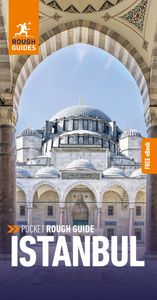
Find even more inspiration here

Planning your own trip? Prepare for your trip
Use Rough Guides' trusted partners for great rates
written by Rough Guides Editors
updated 26.04.2021
Ready to travel and discover Turkey?
Get support from our local experts for stress-free planning & worry-free travels.
- Travel advice
- Where to stay
Istanbul Travel Guide
Courtesy of Leonardo Patrizi | Getty Images

19 Best Things to Do in Istanbul, Turkey
The world's only city that sits on the two continents of Europe and Asia, separated by the Bosphorus strait, Istanbul possesses so many layers that make it absolutely unique. A megacity that has seen the rise and fall of two empires, the former
- All Things To Do

Blue Mosque (Sultanahmet Camii) Blue Mosque (Sultanahmet Camii) free
Sultan Ahmed I was determined to build a mosque that rivaled the nearby Hagia Sophia , and most would agree that he accomplished this task or, at least, came close. Since the early 1600s, the Blue Mosque has been quite the sight to behold, with an array of domes, semidomes and minarets (or narrow towers). It's also one of the biggest tourist draws in Istanbul.
Visitors say this mosque offers stunning architecture inside and out. It can, however, get busy, so consider arriving early. And remember, the Blue Mosque is an active religious site, so dress conservatively. Women should wear headscarves, as is custom. If you forgot to bring one, you can borrow one from the mosque.

Hagia Sophia Mosque (Ayasofya Cami) Hagia Sophia Mosque (Ayasofya Cami) free
Tourists flock en masse to the Hagia Sophia for its stunning architecture, glorious interior views and historical significance. Built between 532 and 537, the building was a church for nearly a thousand years. It then served as a mosque from 1453 until 1935, before becoming a secular museum. In 2020, the building once again became a working mosque.
Once the biggest cathedral in the world, the Hagia Sophia is considered the magnum opus of Byzantine architecture. Visitors say it is a must-see when in Istanbul and recommend taking a guided tour for more information about the history of the site.

Basilica Cistern (Yerebatan Sarnici) Basilica Cistern (Yerebatan Sarnici)
The Basilica Cistern is Istanbul's largest surviving Byzantine cistern and one of its most unique historic sites. Constructed in 532 for Justinian I, this sprawling underground water reservoir –which is roughly the size of two football fields – once supplied water to the Great Palace of Constantinople, a large palace that served as the main residence for local emperors for centuries. Though the palace no longer exists, the cistern was renovated in 1985 to welcome visitors. In 2022, it reopened to the public after a five-year restoration effort. Its most noteworthy feature is a pair of Medusa heads that sit upside down at the base of two columns.
According to past travelers, the Basilica Cistern is easy to miss but worth checking out, despite its lack of interior attractions. Many said the site is beautifully preserved, but queues to buy tickets and enter can get quite long, so several recommended visiting with a tour group. Multiple half- and full-day tours that include stops at the cistern are offered on Viator ; tour prices range from $39 to $686 per person.

Popular Tours

Best of Istanbul: 1, 2 or 3-Day Private Guided Istanbul Tour
(4988 reviews)
from $ 200.00

ISTANBUL BEST : Iconic Landmarks FullDay Private Guided City Tour
(407 reviews)
from $ 160.00

Taste of Two Continents: Istanbul Food Tour
(2041 reviews)
from $ 125.00

Grand Bazaar (Kapaliçarsi) Grand Bazaar (Kapaliçarsi) free
Located within walking distance of must-visit sights like the Blue Mosque , the Basilica Cistern and Süleymaniye Mosque , the Grand Bazaar is one of the biggest and oldest covered shopping markets in the world. It regularly overwhelms visitors with its more than 60 streets of 3,000-plus shops, each accompanied by an overzealous vendor. Products range from hand-loomed carpets to antiques, traditional textiles to copper and silver artisan objects, artisan jewelry and ceramics to clothing and much more.
Despite the size and chaos of this bazaar, shoppers say you'll find yourself strangely at ease with the rhythm of the market, thanks in part to the friendliness of the vendors, who are far from pushy. Remember, though, that Westerners are often quoted higher rates for items here, so come prepared to bargain. Most merchants will drop their rates by as much as 50% when a customer refuses to pay full price. What's more, additional discounts are often given to those who pay with cash, although most vendors do accept credit cards.

Spice Bazaar (Misir Çarsisi) Spice Bazaar (Misir Çarsisi)
U.S. News Insider Tip: Take a lunch break at Pandeli Restaurant inside the bazaar, which has been around since the 1950s serving classic Turkish dishes in a refined ambiance. Make reservations in advance and don't miss the stairs that lead up to the restaurant on the left side of the bazaar's Eminönü entrance. – Feride Yalav-Heckeroth
Built in the 17th century from the revenue of the Ottoman administrative district in Egypt (and therefore also known as the Egyptian Bazaar) this historic bazaar is the second most famous covered market in Istanbul. A must-visit for gourmets who love to shop for traditional ingredients, the more than 80 shops inside the market have a wide and fragrant spectrum of spices, nuts, dried fruits, Turkish coffee and traditional sweets.

Süleymaniye Mosque (Süleymaniye Camii) Süleymaniye Mosque (Süleymaniye Camii) free
Nestled within Istanbul's historic Fatih district by the Golden Horn, Istanbul University and the Grand Bazaar , Süleymaniye Mosque is considered one of the city's most impressive Ottoman mosques. Built between 1550 and 1557 after being commissioned by its namesake, Süleyman I, this grand structure features multiple gardens and a large dome, plus high-end finishes like mother-of-pearl window shutters, painted corbels, traditional ceramic tiles and stained-glass windows.
Recent travelers described their time at this mosque as "amazing" and "peaceful," adding that it is just as stunning as the Blue Mosque and cannot be missed. What's more, this attraction is not as central and popular as others like the Hagia Sophia , meaning you won't have to rub elbows with lots of tourists while visiting. But remember, like other religious sites in the area, Süleymaniye Mosque hosts six prayer services every day, so expect occasional closures and dress conservatively. If you forget to wear long pants or pack a scarf to cover your head, the mosque offers loaner coverings at its entrance.

Rüstem Pasha Mosque (Rüstem Pasa Camii) Rüstem Pasha Mosque (Rüstem Pasa Camii)
One of Sultanahmet's lesser-known mosques is also one of its most beautiful. Designed by the famous Ottoman imperial architect Mimar Sinan (who also designed the Süleymaniye Mosque ) and completed in 1563, the structure was dedicated to the Grand Vizier Rüstem Pasha. The mosque's most important trait are the large quantities of Iznik tiles that decorate its interior in a wide variety of floral and geometric patterns. It's a definite deviation from Mimar Sinan's usual style, which favored the structure rather than its internal decoration.
Previous travelers commented that this more hidden sight is a definite stop for anyone interested in Islamic art and Ottoman architecture. They add the design impresses deeply with its hand-painted tilework as well as its majestic dome. Travelers have also commented that the mosque is a welcome respite from Istanbul's busy streets.

Topkapi Palace Museum (Topkapi Sarayi Müzesi) Topkapi Palace Museum (Topkapi Sarayi Müzesi)
Topkapi Palace served as the home of the Ottoman Sultans from 1478 to 1856 and is one of Istanbul's most popular attractions. It officially became a museum in 1924, shortly after the end of the Ottoman era, and features brilliant architecture, manicured courtyards and extensive weaponry, porcelain, cutlery, art and fabric collections.
Previous visitors loved admiring the palace's architecture and perusing its exhibits, saying you'll need several hours to take in everything there is to see. Popular exhibits include the kitchens, the calligraphy area and the armaments room. Many also recommend strolling through the property's gardens and refueling at the on-site coffee shop, where picturesque views of the Golden Horn await you.

Best of Istanbul private tour pick up and drop off included
(334 reviews)
from $ 48.17

Bosphorus Night Cruise with Dinner, Show and Private Table
(592 reviews)
from $ 35.00

2 Day All Inclusive Cappadocia Tour from Istanbul with Optional Balloon Flight
(261 reviews)
from $ 578.29

Istanbul Archaeological Museums (Istanbul Arkeoloji Müzeleri) Istanbul Archaeological Museums (Istanbul Arkeoloji Müzeleri)
At the Istanbul Archaeological Museums, which opened near the Topkapi Palace Museum in 1869, you'll find more than a million antiquities displayed throughout three buildings: the Archaeological Museum, the Ancient Orient Museum and the Tiled Kiosk Museum. Exhibitions offer a wealth of artifacts from the Assyrian, Hittite, Egyptian, Greek, Roman, Byzantine and Ottoman civilizations.
Travelers have commented on the beauty of the museum structures themselves and appreciated the vast collection at this underrated museum. Others recommended seeing the Sarcophagus of Alexander, a highlight in the collection.

The Beyoglu Neighborhood The Beyoglu Neighborhood
The heart of Istanbul's local life, Beyoglu, once known as Pera, was the center of European aristocratic settlement during the Ottoman era. The neoclassical architecture of its structures all speak of this past. Starting with the new Ataturk Cultural Center in the famous Taksim Square, the equally famous Istiklal Avenue stretches all the way to Tünel Square, where the historic Tünel funicular station is located as one of the world's oldest subterranean urban railways.
When walking down Istiklal, make sure to stop and explore the many historic shopping arcades, restaurants, art galleries and churches hidden in the side streets. Standouts include the Church of St. Anthony of Padua, the city's largest Catholic Church; the Istanbul Cinema Museum , exhibiting the history of Turkish cinema inside a stunning former mansion from the 19th century; and the art gallery Casa Botter inside a renovated and repurposed art nouveau apartment building from the 1900s.

Galata Tower (Galata Kulesi) Galata Tower (Galata Kulesi)
Certainly one of Istanbul's most iconic structures, the Galata Tower was first built during the Byzantine era, rebuilt by the Genoese, who gave it the stone mesh exterior it still possesses today, and later used as a prison during the Ottoman period. Today, the tower welcomes visitors who can climb to the top to enjoy a gorgeous 360-degree view of Istanbul.
Travelers have remarked that the tower is located in the city's "coolest" neighborhood and noted that the view from the top is especially amazing at night. Others commented that the tower itself is beautiful, though they felt the steep entry fee wasn't worth the experience.

Dolmabahce Palace Dolmabahce Palace
Sitting along the Bosphorus near the Kabatas tram stop and the Besiktas ferry port, Dolmabahçe Palace's jaw-dropping beauty and historical importance impresses visitors. Built in the 19th century, the palace was used by the final Ottoman sultans as their primary residence and administrative seat. The interior and exterior architecture showcase a mix of European and Ottoman designs that can only be found at this global crossroad. Make sure to also visit the National Painting Museum next door (included in the ticket), which showcases around 200 paintings from the palace's collection that spans Turkish and international artists from the 19th century.
Past travelers were wowed by the palace's extravagant interior, although some wished photography was permitted and felt tours were rushed and lacked information. Several visitors also reported long ticket lines, and the property's website cautions that the ticket office closes early once all passes have been distributed for the day, so plan on arriving early.

The Besiktas Neighborhood The Besiktas Neighborhood
After exploring the Dolmabahçe Palace , a stroll in the Besiktas neighborhood at large is a great way to delve into local life, away from the tourist highlights. Walk up Süleyman Seba Avenue to reach Akaretler, the 19th-century row houses originally built for those who worked at Dolmabahçe Palace. They're now filled with modern shops, art galleries, cafes and restaurants. Stroll down Çiragan Avenue to reach Yildiz Park, one of the city's largest public parks with two Ottoman-era pavilions that now serve as cafes and enjoy some time away from the crowds. Right across the park, gaze at one of Istanbul's most iconic hotels with its ornate gates, the Çiragan Palace Kempinski, inside a former Ottoman palace. If you still have the energy, continue on Çiragan Avenue to Ortaköy Square to enjoy a waterfront view of the famous Bosphorus Bridge with the Ortaköy Mosque built in the 1850s right before it.
The best way to reach Besiktas is via bus, however, the neighborhood also has its own ferry port with transfers available from Eminönü (Old City).

Bosphorus Sunset Cruise on Luxury Yacht
(1327 reviews)
from $ 66.47

Cappadocia Dream - 2 Days Cappadocia Travel with Balloon Ride from / to Istanbul
(164 reviews)
from $ 475.26

Bosphorus Yacht Cruise with Stopover on the Asian Side - (Morning or Afternoon)
(969 reviews)
from $ 55.39

The Nisantasi Neighborhood The Nisantasi Neighborhood
U.S. News Insider Tip: Make sure to visit Kalyon Kültür , an art and culture space inside a beautifully renovated Ottoman mansion built in 1889. – Feride Yalav-Heckeroth
It's in this neighborhood that you'll find the city's residents shopping for the latest collections from Turkish and international designers. Apart from Beymen , Turkey's most exclusive department store, you'll also find brands such as Gucci, Louis Vuitton and Chanel plus the atelier and showrooms of some of Istanbul's most important fashion designers. The neighborhood is, however, also home to brands such as Gap, Massimo Dutti, Zara and Marks & Spencer, pleasing shopping crowds of all budgets in one go.

Galataport Galataport
Much more than the world's first underground cruise ship terminal, Galataport is filled with restaurants, cafes, shops and a wide boardwalk that all face the Bosphorus. Apart from Istanbul Modern , Galataport's other cultural offering is the Istanbul Museum of Painting and Sculpture , designed by the famed Turkish architect Emre Arolat's firm. It has a vast collection that presents Turkish art from the late 19th-century Ottoman period to the end of the 20th century. The port is also home to the luxurious Peninsula Hotel; three of its four buildings are renovated heritage structures overlooking the Old City.
Travelers have remarked that the port is modern and has lots of branded storefronts and restaurants and that the views are incredible. They add that the modern design of Galataport and the historic architecture of nearby structures gives visitors the best of both worlds.

Istanbul Modern Istanbul Modern
Inside a stunning waterfront structure by the Renzo Piano Building Workshop, Istanbul Modern is the city's most important hub for contemporary art with its permanent and temporary exhibitions. The collection focuses mainly on pioneering Turkish artists and also includes a photography collection. Make sure to visit the museum's rooftop that faces the Bosphorus and the Old City and features shallow pools that reflect the horizon.
Previous visitors have commended the large variety of artworks, including all types of art, media, sculpture and interactive exhibits. Other guests recommended the rooftop and its fantastic view of the historic city center.

The Kadiköy Neighborhood The Kadiköy Neighborhood
U.S. News Insider Tip: Heading to Kadiköy Market? Start your journey on Günesli Bahçe Street and then get lost among the offerings, especially the many little eateries selling street food. – Feride Yalav-Heckeroth
Istanbul's Asian side (or Anatolian side as the locals like to say) is often completely overlooked by tourists, but it's the perfect locale for those who want to have a genuine local experience. Kadiköy is very down-to-earth and still very Turkish, largely untouched by the cosmopolitan air that is prevalent on the European side. After arriving at the Kadiköy ferry station, the first stop should be the vast Kadiköy Market, a network of interconnected streets that are filled with vendors selling everything from fresh fish to produce, cheeses to pickled vegetables, coffee to nuts, offal to honey and so much more.

Beylerybeyi Palace Beylerybeyi Palace
Another hidden gem Istanbul's Anatolian (Asian) side, the breathtakingly ornate Beylerbeyi Palace was built between 1863 and 1865 under the order of Ottoman Sultan Abdülaziz. It served as a summer residence and state guesthouse. The waterfront palace was designed by Sarkis Balyan, who, along with other members of the Armenian Balyan family, designed such other icons as the Dolmabahçe and Çiragan Palaces. A confluence of Western and Eastern architectural styles, the interior of the lavish palace is filled with Turkish Hereke carpets; French Baccarat crystal chandeliers; and Chinese, Japanese, French and German ceramics, to name a few.
Previous travelers were astounded by the beauty and design of the palace, which exhibited wonderful craftsmanship. The palace's coffee shop was also recommended due to the stunning Bosphorus view.

Private Guided Istanbul Day Tour
(148 reviews)
from $ 95.00

Istanbul Bosphorus Sunset Cruise on Luxury Yacht
(1276 reviews)
from $ 49.85

Istanbul 7-8 Hours Private Guided Tour. Depart from Cruise Port
(68 reviews)
from $ 149.00

Büyükada Büyükada
U.S. News Insider Tip: This island is very popular on the weekends, so if you'd rather avoid the crowds, visit on a weekday. – Feride Yalav-Heckeroth
The largest of Istanbul's Princes' Islands is certainly its most popular and is the best way to really take a break from the city's endearingly chaotic energy. Büyükada (which literally translates to 'large island') was a popular getaway for Istanbul's prosperous Greeks, Jews and Armenians who had lavish summer mansions built to accommodate their vacationing needs. Nowadays, these Ottoman-era mansions are some of the most important attractions on the island, and locals and visitors alike arrive in droves to stroll along the streets to gaze up at the historic architecture. Some of the most notable houses are located on Çankaya Avenue.

Things to Do in Istanbul FAQs
Explore more of istanbul.

Best Hotels

When To Visit
If you make a purchase from our site, we may earn a commission. This does not affect the quality or independence of our editorial content.
Recommended
The 28 Best Water Parks in the U.S. for 2024
Holly Johnson|Timothy J. Forster May 8, 2024

The 18 Best Napa Valley Wineries to Visit in 2024
Lyn Mettler|Sharael Kolberg April 23, 2024

The 25 Best Beaches on the East Coast for 2024
Timothy J. Forster|Sharael Kolberg April 19, 2024

The 50 Best Hotels in the USA 2024
Christina Maggitas February 6, 2024

The 32 Most Famous Landmarks in the World
Gwen Pratesi|Timothy J. Forster February 1, 2024

9 Top All-Inclusive Resorts in Florida for 2024
Gwen Pratesi|Amanda Norcross January 5, 2024

24 Top All-Inclusive Resorts in the U.S. for 2024
Erin Evans January 4, 2024

26 Top Adults-Only All-Inclusive Resorts for 2024
Zach Watson December 28, 2023

Solo Vacations: The 36 Best Places to Travel Alone in 2024
Lyn Mettler|Erin Vasta December 22, 2023

26 Cheap Beach Vacations for Travelers on a Budget
Kyle McCarthy|Sharael Kolberg December 4, 2023


Travel Guide
- Things to Do
- Best Hotels
- Things to See
- Best Restaurants
- Best Nightlife
- Getting Around
- Entry Requirements & Customs
- Visitor Information
- Sustainable Travel & Ecotourism
- Health & Safety
- Calendar of Events
- Neighborhoods in Brief
- Getting There
- Escorted & Package Tours
- Tips for Families
- Tips for Gay and Lesbian Travelers
- Tips for Senior Travelers
- Tips for Travelers with Disabilities
- Tips for Women Travelers
- Staying Connected
- Walking Tours
- Spectator Sports
- Suggested Itineraries
Getting Around in Istanbul
We'll Tell You Where to Go -- Not sure how to get where you're going? The transport arm of the Istanbul municipality operates a great website, www.iett.gov.tr , where you can find all the routes for the whole range of transport options. You can also plug in your starting point to find out which public transport options stop there. Just click on the "How can I GO There?" icon on the bottom right of the main page (English).
With traffic getting denser and more aggravating on an hourly basis, having a car in Istanbul is the surest method for going nowhere. In the rare event that traffic moves smoothly, do you really think you know where you're going? Can you read signs in Turkish? Do you know what a "Cevreyolu" is? And once you get there, where are you going to park? If you do decide to disregard better judgment and good counsel (and the fact that traffic-related enforcement in general in Turkey has become rather unforgiving, given the potential revenues), or if you're only planning to pick up the car and drive out, here's some basic information:
The major car-rental companies in Istanbul are Avis (www.avis.com), Sixt (www.e-sixt.com), Hertz (www.hertz.com), National (www.nationalcar.com), Budget (www.budget.com), and Alamo (www.alamo.com). All have desks at Atatürk International Airport, as well as at locations in town. Meanwhile, Hertz and Decar (www.decar.com.tr) have desks in the international terminal at Sabiha Gökçen Airport, while Avis has one in the domestic terminal. Check your national website for deals; at press time, the price for a manual-transmission compact car was 60TL per day.
Taxis are plentiful in Istanbul and are more likely to hail you than vice versa. Avoid taxis that congregate around the main tourist spots such as Topkapi Palace, Ayasofya, and at the cruise-ship landing in Karaköy -- these are the ones adept at performing a bait-and-switch with large bank notes or taking meandering routes. Better to have your hotel call a cab for you, the agreement being that the hotel will continue giving the taxi company business only as long as the drivers remain aboveboard (granted, not a fool-proof system). Similarly, when out and about, pop into the nearest hotel and have the receptionist call a taxi for you.
Istanbul taxis no longer have separate rates for daytime and nighttime, a system which saw a 50% increase in fares between midnight and 6am. Instead, the starting rate for a taxi ride has increased from 2TL to 2.50TL. A taxi from Sultanahmet to Taksim will cost between 12TL and 16TL, depending on traffic and distance.
Don't Let Taxi Drivers Take You for a Ride -- There is a certain amount of control you give up when entering a taxi in a strange city. Your safest bet is to have your hotel concierge phone for the taxi instead of you flagging it down. (In Istanbul, under no circumstances should you hire a taxi off the street in front of the Ayasofya.) Some hotels and taxi companies have agreements that award the company repeat business in exchange for honesty and accountability at no extra charge to the passenger. Still, the risk that absolute ignorance of a location will be rewarded with a circuitous route is fairly high. A preemptive approach is always good: Get the approximate taxi fare from your hotel before you get in the car. But even once you're seated, there are still a few things to look out for to avoid being scammed.
Check to see that the meter is running. Beware of the "bait-and-switch" routine, whereby the driver takes your 10TL bank note (worth about $8.70 or £3.80) and accuses you of having given him a 1TL note. You can avoid this by holding onto the bank note until you've received your change. Also, note that 1TL notes are blue-toned and 10TL notes are orange.
For longer distances or drives outside of the city limits, taxis usually have a list of set rates. Be sure you've discussed these in advance, as you may be able to negotiate a discount (though it's doubtful). A final word: Don't get into a cab expecting bad things to happen. Just be a smart customer.
By Public Transportation
Transportation in Istanbul has come a long way since its earlier disjointed days, and improvements are being advanced at a hearty pace. While certainly not a seamless system, the network of buses, minibuses, funiculars, ferries, catamarans, subways, trains, trams, and trolley cars will certainly get you where you're going, but you may have to take all of them to get there.
The full fare for a one-way ride, without a transfer, on the bus, tramway, historic trolley, funicular to Taksim, metro, and most of the commuter ferry crossings costs 2TL (the Tünel costs 1TL). Unless you purchase a transit pass, you will have to pay the individual fare again each time you transfer lines or modes of transport. For the purpose of consistency, all prices for transportation are listed here at the pay-per-ride fare.
The metro is still a work in progress. The metro line north of Taksim has been extended. The completed Sishane metro stop will eventually be connected to the massively ambitious Marmaray project, optimistically expected to be completed around 2011. Once complete, the section of the commuter rail between Yenikapi and Sirkeci will close.
Transport Made Easy with a Transit Pass -- The entire metropolitan transport system accepts jetons (tokens) or one of a number of transit passes currently available. If you rely entirely on the jetons, you'll be forced to insert one at every transfer point, whereas use of a transit card gets you discounts for transfers. Currently there are three types of transit cards: the Akbil, the Besibiryerde, and the Istanbulkart, all with a built-in discount of 10% off the full token (or jeton ) fare. Until recently, the Akbil (meaning "smart ticket") was the only transit pass offering the convenience and savings of a transit pass to commuters. The Akbil is a prepaid plastic key-chain contraption with a refillable metal "button" that connects with a receptacle in the turnstile to deduct the fare. All transfers are free for travel within a 45-minute period. For an initial deposit of 6TL (keep your receipt so that you can get your deposit back before you leave), you can add money and top it off at will. And better still, one Akbil can be used by multiple travelers in a group. Meanwhile, true to its name, the Besibiryerde ("five-in-one") is good for five rides. The newer credit card-size Istanbulkart, which operates via radio frequency, was introduced in March 2009 and is designed to eventually replace the Akbil. Both are rechargeable at vending/refilling machines located in all metro stations, at major bus and tramway hubs, and at the ferry docks. Machines accept both Turkish lira and major credit cards.
The Bus -- Metropolitan buses in Istanbul are frequent, comprehensive, economical, and easy -- if you know your way around. While there is no bus map, the destination of an individual bus line is now clearly marked at the bus stop (usually your typical glass shelter with a metal bench). Plaques at the bus stop provide a list of the stops along the route. The bus's final destination is also indicated above the front windshield, with a selection of major stops listed on the side of the bus next to the entrance (admittedly, not much help if you aren't familiar with the basic layout of the city). You can also do some advance planning via the IETT website (www.iett.gov.tr), which has an interactive map and line-stop assistance. Still, always check with the driver before getting on to make sure the bus is going in the direction you need; and once boarded, frequently ask your neighbor when to get off. Some of the most useful major hubs are at Eminönü, Taksim, and Besiktas. Tickets are sold at the major hubs or on the bus -- if your bus doesn't have a "cashier" on board, there's an informal system whereby you can pay the driver, who will in turn hand you his own personal Akbil to use (this earns the driver about .05TL per cash-paying customer). Buses run, roughly, from 6 or 6:30am until around 11pm or midnight.
The Dolmus -- Dolmus are yellow minivans that operate like group taxis with set routes. A relatively informal system, dolmus run daily from early morning to early evening. A dolmus will leave its terminus (marked with a blue "D") only when it fills up (the word dolmus means "stuffed") and then pick up and drop off passengers along the route. The main dolmus stands are located in Taksim (at Taksim Caddesi and Tarlabasi Caddesi, near the flower sellers), Sirkeci, and Aksaray, and connect to points all over the city. Dolmus are often more direct than metropolitan buses and cheaper than taxis, cutting down on time and leaving more money in your pocket. Look for a dolumus with the name of your destination displayed in the window. When boarding, tell the driver your destination and ask how much it will be (ne kadar?). For shorter distances, 3TL to 5TL should cover it. The driver will drop you off at your destination, but if you want to get off sooner, say "inecek var" (this is my stop) or "inmek istiyorum, lütfen," the short version of "I want to get off" with a "please" stuck on the end.
The Tramway -- When the tram from Eminönü to Zeytinburnu was built and inaugurated in 1991, the planners had overlooked one very important detail: money collection. Passengers rode for free for 1 year while the system installed booths and printed tickets. The system has grown up quite a bit since then; the city recently extended the tramway from Eminönü all the way to Kabatas (just below Dolmabahçe Palace); there's also an underground funicular that hoists passengers up the hill from Kabatas to Taksim in just 110 seconds for 2TL. A ticket booth at the turnstile entrance dispenses jetons or Akbil refills. This collective service cuts trips between Taksim and Sultanahmet to around 15 minutes (with transfers), while destinations in-between (Eminönü, for the Egyptian Spice Bazaar; Çemberlitas or Beyazit for the Grand Bazaar; Tophane for the Istanbul Modern) are just a token away. By the time you read this, the tramway will most likely be extended from Kabatas north along the Bosphorus; the plan is to add stations at Dolmabahçe, Besiktas, Sisli, and points north and northwest all the way to Mahmutbey. Token (jeton) booths are located at the entrance to the turnstiles; Akbils can be purchased/refilled at selected stops, including Sultanahmet, Eminönü, and Taksim, as well as in any metro station. Hours of operation are from 6am until about midnight.
The Historic Trolley -- Just when you feel your feet are ready to fall off, you hear the jingle of the lifesaving streetcar. The "Nostalgic Tramway" now plies fresh tracks on newly laid cobblestones along Istiklal Caddesi. As with most public-transportation options, you can pay with cash or with the Akbil. The trolley runs daily from 7am to 11pm and makes three intermediary stops at Hüseyn Aga Camii, at Galatasaray High School/Flower-Fish Market, and in Beyoglu at Nutru Sokak (in front of the Turkiye Is Merkezi).
The Funicular -- The subway known as Tünel connects the sea-level neighborhood of Karaköy near the Galata Bridge with the lofty neighborhood of Beyoglu at the southern end of Istiklal Caddesi. Tünel trains run Monday through Saturday from 7am to 9pm and Sunday from 7:30am to 9pm. The cost is 1TL.
A second funicular was completed in 2006, providing a much-needed lift to those down at the docks of Kabatas (near Dolmabahçe Palace) up the very steep hill to Taksim.
The Metro/Underground -- Istanbul's modern underground is growing at a fast clip, currently connecting the new Sishane stop (located beneath Mesrutiyet Caddesi), just steps from Tünel, with (as of this writing) the Atatürk Oto Sanayi, passing through Taksim, Osmanbey (walking distance from Nisantasi), Sisli/Mecediyeköy (commercial center), Gayrettepe (even more commerce), Levent (guess what, business plus the Kanyon and Metrocity shopping malls), Sanayi, and Maslak (Turkey's equivalent of Wall St.). The metro is open from around 6:30am until midnight. You can buy jetons at the ticket window outside the turnstile; or, if you're using the Akbil, just plug it into the turnstile receptacle.
The metro extension connecting the airport to town is now complete, providing access at Yesilköy (just outside the airport; you'll need two jetons ) to Aksaray via a roundabout route by way of the otogar (bus station). If your destination is Sultanahmet, exit the metro at Zeytinburnu, transfer to the tramway (by paying the fare again), and hop on any train marked EMINÖNÜ.
The Ferry & Sea Bus -- All inner- and intercity sea transport is operated by the Istanbul Deniz Otobüsleri (IDO; tel. 0212/444-4436; www.ido.com.tr). The IDO fleet includes, in order of increasing speed: conventional ferries (read: slow, both passenger-only and car); the dubiously named "fast" ferries with a speed of 35kmph (22 mph); sea buses (passenger-only catamarans with speeds ranging from 40-53kmph/25-33 mph), and fast catamarans (up to 59kmph/37 mph). Generally speaking, fast ferries serve the southern Marmara Sea ports. Some of the more useful inner-city connections are on the commuter ferries, shuttling passengers between Kadiköy and Haydarpasa; Kadiköy and Eminönü; Kadiköy and Kabatas; Kadiköy and Besiktas, and on the passenger-only commuter sea buses, which ply the Bosphorus and the Marmara Sea (Yenikapi on the European side, Kadiköy and Bostanci on the Asian side, and the Princes' Islands). Smaller, more scenic boats take a more tourist-friendly leisurely pace up the Bosphorus, and a commuter boat plies the route from Üsküdar, through Karaköy and Eminönü, to Eyüp. Sample fares for public ferries are 1.50TL for the shorter points within Greater Istanbul and 3TL for the slow ferry to the Princes' Islands and are payable via the Akbil or token. Online booking is available for fast ferries and intercity sea bus lines only.
The scenic ferry that takes the time-honored cruise up the Bosphorus leaves from Eminönü, making stops at Besiktas (near Dolmabahçe Palace and the Çiragan Palace) on its crisscross pattern up the channel to Kanlica, Yeniköy, Sariyer, Rumeli Kavagi, and Anadolu Kavag[ag]i (13TL one-way or 20TL round-trip; 90 min. each way). The ferry from Eminönü departs daily, year-round, at 10:35am, returning from its final stop at Anadolu Kavagi at 3pm. An additional noon and 1:35pm departure operates from mid-April through November or December with a return departure at 4:15pm (additional return departures on weekdays; confirm times, as they may change). On Saturday nights from July 1 to mid-August, IDO also operates a moonlit Bosphorus cruise (20TL round-trip) departing Bostanci and making stops in Moda, Eski Kadiköy, Eminönü, Üsküdar, Besiktas, Ortaköy, Çengelköy, Rumeli Kavagi, and Anadolu Kavagi. The cruise departs at 6:10pm arriving at Anadolu Kavagi at 8:50pm; the return departure is at 10pm, arriving Bostanci at 12:35am.
If you're interested in traveling by car to cities along the Marmara region (for example, Bursa or Çanakkale), the easiest and quickest way is to take an IDO car ferry or sea bus from Yenikapi to Güzelyali or Mudanya (for Bursa) or Bandirma (for Çanakkale and the Northern Aegean). The trip takes 75 minutes and 1 hour, 45 minutes respectively.
For points farther south (Izmir, Bergama, Kusadasi, Ephesus/Selçuk, or Bodrum), you may want to cruise with Denizline (tel. 0212/444-3369; www.denizline.com.tr) on the company's overnight ferry from Istanbul to Izmir.
Note : This information was accurate when it was published, but can change without notice. Please be sure to confirm all rates and details directly with the companies in question before planning your trip.

- All Regions
- Australia & South Pacific
- Caribbean & Atlantic
- Central & South America
- Middle East & Africa
- North America
- Washington, D.C.
- San Francisco
- New York City
- Los Angeles
- Arts & Culture
- Beach & Water Sports
- Local Experiences
- Food & Drink
- Outdoor & Adventure
- National Parks
- Winter Sports
- Travelers with Disabilities
- Family & Kids
- All Slideshows
- Hotel Deals
- Car Rentals
- Flight Alerts
- Credit Cards & Loyalty Points
- Cruise News
- Entry Requirements & Customs
- Car, Bus, Rail News
- Money & Fees
- Health, Insurance, Security
- Packing & Luggage
- -Arthur Frommer Online
- -Passportable
- Road Trip Guides
- Alaska Made Easy
- Great Vacation Ideas in the U.S.A.
- Best of the Caribbean
- Best of Mexico
- Cruise Inspiration
- Best Places to Go 2024
Ten Minute Travel Break
Getting around istanbul.
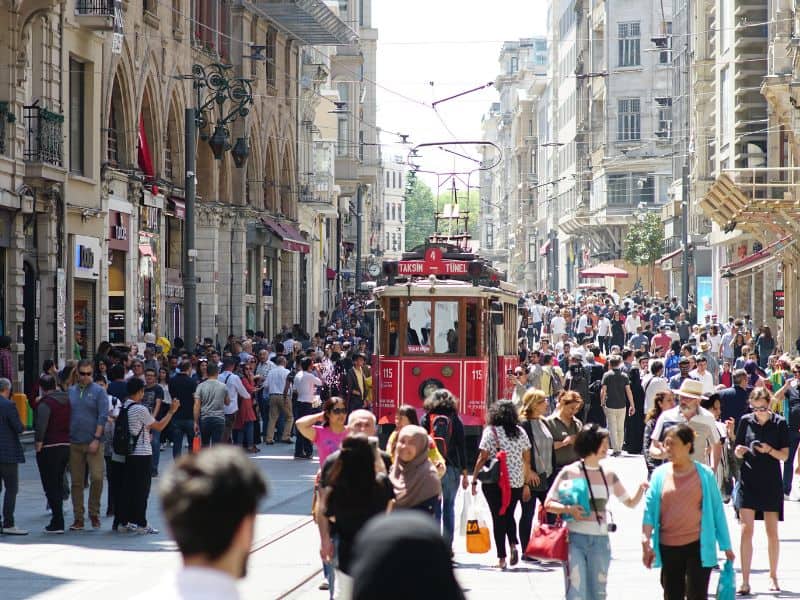
A Complete Guide to Public Transport in Istanbul
Planning a trip to Istanbul and don’t know how to get around the city? You’re in the right place! And fortunately, getting around Istanbul is easy enough.
In this article, you can find everything about public transport network in Istanbul and alternative and fun ways to travel around the city.
Getting around Istanbul is Easy
How to get to the city.
If you travel to Istanbul by plane, you might wonder how to get to the city from the airport. Thankfully, Istanbul has a convenient and extensive public transportation system that offers easy access to the city’s different parts.
Havaist Bus
Havaist buses are the most popular means of Istanbul public transportation for visitors (‘hava’ means air in Turkish, so the name seems like a reference to Airport-Istanbul). Havaist offers around 20 routes between the airport and multiple destinations in Istanbul.
You can purchase Havaist tickets in the ticket office near the bus stops. Also, you can use your credit card or İstanbulkart for the ride.
Since Havaist bus prices constantly change, you should visit their official webpage to see how much it costs to get to your destination and which line you should take.
You can find yellow taxis at the airport. Although taxis are more pricey than public transportation, they offer faster and more convenient transportation.
Istanbul’s metro network connects airports to the city’s prominent areas. In order to reach your destination, you can take the M4 line from Sabiha Gökçen Airport and the M11 line from Istanbul Airport. These high speed rail links will whisk you downtown as fast or faster than any other options.
See the Rapid Transit System Maps below.
Airport Transfers
Contact your hotel prior to arrival to learn whether they have private airport transfers. Some hotels may provide free airport transfers.
We also recommend Get Transfer as a trusted affiliate partner, if you prefer to book your own arrangements in advance.
What Ticket Types Are Available?
In Istanbul, there are four different ticket types you can use:
- Electronic Ticket : This type of ticket provides limited access to public transportation. It has five different types: Single ticket, Two-pass ticket, Three-pass ticket, Five-pass ticket, and Ten-pass ticket. You can find the official price list here .
- İstanbulkart (also known as Akbil) : İstanbulkart, also known as Akbil, is another electronic ticket to use public transportation. You place your card near İstanbulkart readers so it can deduct the ticket price. Unlike electronic tickets, you can load as many credits as you want onto İstanbulkart. You can see fares for İstanbulkart here .
- Mavi Kart (Blue Card) : Blue Card is the monthly version of İstanbulkart. Once you purchase a Blue Card, you can use it for the whole month without reloading. Check the IETT’s fare list for Blue Card prices.
- Istanbul Welcome Card : You should consider Istanbul Welcome Cards for an unforgettable Istanbul experience. The card provides you with a myriad of benefits, such as a loaded İstanbulkart, special discounts, and saving you entry fees. Visit the Istanbul Welcome Card website for more information.
Besides these tickets, you can pay cash when taking a regular yellow taxi or minibuses – dolmuş .
Istanbul Metro
[metro – text = The map of Istanbul metro lines in operation. Click here to see a bigger version of the map .]
Istanbul Metro is the city’s fastest and most convenient public transportation. The railway network connects various parts of Istanbul on both the European and Asian sides.
Among nine different metro lines, M1 is the most prominent for visitors as it connects the Old Town region to the airport, passing through the city’s historic sites.
Line M1A Yenikapı-Atatürk Airport
The first rail system of Metro Istanbul, M1A, constitutes the first part of the M1 operation. It connects the Old Town (Suriçi) region to the airport. Passing through Bayrampaşa to reach the bus terminal (Otogar), the route takes you by some of Istanbul’s most prominent spots.
Line M1B Yenikapı-Kirazlı
M1B is a rail system operation that uses the same route between Yenikapı and Otogar stations as M1A. After Otogar station, M1B passes through Esenler and Bağcılar Meydan to get to Kirazlı. M1B ends in integration with M3.
Line M2 Yenikapı-Seyrantepe-Hacıosman
Starting at Hacıosman, the M2 metro line travels along the southern part of Istanbul’s historic peninsula. The line passes through Maslak and Levent, two prominent financial districts, and heads to Taksim Square. The route ends at Yenikapı station, where you can take M1A or M1B to discover Istanbul’s historic sites.
Line M3 Kirazlı-Kayaşehir Merkez
The M3 metro line travels further into Istanbul’s European Side (Avrupa Yakası). The line starts at Kirazlı-Bağcılar and heads to İSTOÇ, a significant business park. The route goes through the Başakşehir region and ends at Kayaşehir. The line’s Bakırköy-İDO extension is currently under construction and planned to commence operations by February 2024.
Line M4 Kadıköy-Sahiba Gökçen Airport
Starting at Kadıköy and heading to Acıbadem region, the M4 metro line is the first rapid transit line on Istanbul’s Asian Side (Anadolu Yakası). It is currently the longest metro line in Istanbul, with a 33.5-kilometer (20-mile) line length and 23 stations. The route passes through Maltepe and Pendik before ending at Sabiha Gökçen Airport.
Line M5 Üsküdar-Çekmeköy
The second metro line on the Asian Side and the first driverless metro system in Turkey, the M5 line starts at Üsküdar, passes through Ümraniye, and reaches its destination, Çekmeköy. Istanbul Metropolitan Municipality plans to extend the metro line all the way to Sabiha Gökçen Airport in the future.
Line M6 Levent-Boğaziçi University/Hisarüstü
The M6 line is the shortest metro line in Istanbul and was built to allow access to Boğaziçi University and Hisarüstü. The line has four stations: Levet, Nispetiye, Etiler, and Boğaziçi Üniversitesi/Hisarüstü. Despite its shorter route, around 20,000 passengers use the M6 line daily. The journey takes 7 minutes, and only one train runs one way.
Line M7 Yıldız-Mahmutbey
The M7 line starts at Yıldız station in Beşiktaş and heads to Mecidiyeköy. The route goes through Kağıthane and Gaziosmanpaşa districts to end at Mahmutbey. M7 is the first fully automatic driverless metro line in Istanbul’s European Side and boasts one of the most extensive routes. Istanbul Metropolitan Municipality plans to extend the line to Esenyurt between 2025 and 2030.
Line M8 Bostancı-Dudullu-Parseller
The M8 line starts at Parseller in the heart of the Asian Side and heads to Bostancı in the south. At Bostancı station, passengers can change for Marmaray, high-speed trains or ferries. M8 connects to the M4 line at Kozyatağı and the M5 line at Dudullu.
Line M9 Bahariye-Olimpiyat
The M9 metro line is a rail system between Bahariye and Olimpiyat stations. Starting from Küçükçekmece district, the route terminates at Atatürk Olympic Stadium in Başakşehir. M9, at the moment, has only five running stations: Bahariye, Masko, İkitelli Sanayi, Ziya Gökalp Mahallesi, and Olimpiyat. Nevertheless, nine new stations are under construction and will extend the route to Ataköy by March 2024.
[tramvay – text = The map of Istanbul tram lines in operation. Click here to see a bigger version of the map .]
Tramvay is the oldest means of public transportation in Istanbul. Five Istanbul tram lines boast a 44-kilometer (27-mile) route and a daily ridership of over 400,000 people. Except for the T3 heritage tram, all tram lines in Istanbul operate on the European Side.
Line T1 Kabataş-Bağcılar
The T1 tram line, opened in 1992, is Istanbul’s oldest modern tram system. The line runs through the city’s most popular tourist attractions, such as Karaköy (Galata Tower), Eminönü (Spice Bazaar), Sultanahmet (Blue Mosque), Çemberlitaş (Burnt Column), and Beyazıt Kapalıçarşı (Grand Bazaar).
T1 is the longest among Istanbul tram lines, with a journey duration of 65 minutes. The route ends at Bağcılar, where passengers can take the M1 line.
Nostalgia Trams (T2 & T3)
Istanbul’s oldest electric tram line started to operate in 1914 and reached its greatest extent in 1956. Around 1966, the tram line ended its operations to open the way for faster transportation around the city.
For over 20 years, no tram operated in Istanbul. However, this absence only increased the traffic jams and pollution.
In 1990, the T2 Taksim-Tünel line reopened as a solution, followed by the modern tram lines. Today, the route is one of Istanbul’s two operating nostalgia tram lines.
Following the T2 line, in 2003, Istanbul Metropolitan Municipality opened the T3 Kadıköy-Moda line. T3 uses the historic tram route 20 on the city’s Asian Side.
T4 Topkapı-Mescid-i Selam
T4 is the second longest tram line in Istanbul. The route follows a north-south route and boasts 22 stations. Starting at Topkapı in Zeytinburnu, T4 goes through Eyüp, Bayrampaşa, Gaziosmanpaşa, and terminates at Sultangazi. The line offers a 45-minute journey one way.
T5 Eminönü-Alibeyköy Coach Station
The T5 line follows the Golden Horn coastline in the historic peninsula. Its route features several of Istanbul’s most prominent landmarks and attractions. The line is shorter than the T1 and T4 lines, with a 10-kilometer (6-mile) length and 14 stations. The journey on the T5 line takes around 35 minutes one way.
Funicular Lines
Istanbul funicular lines connect the city’s most prominent districts to facilitate transportation between busy urban areas. Currently, all funiculars in Istanbul operate on the European Side.
F1 (Taksim-Kabataş)
The F1 funicular line, launched in 2006, is the oldest modern funicular system in Istanbul and the second oldest funicular line after F2.
The line completes its route between Kabataş and Taksim stations after a 2.5-minute journey. F1 connects with the M2 metro line at Taksim station and T1 at Kabataş Station.
F2 (Karaköy-Beyoğlu Tarihi Tünel Füniküler Hattı, or simply Tünel)
F2 is a historic funicular line in Istanbul. Opened in 1875, it was the oldest fully underground urban railway in continental Europe and the second oldest in the world. The system underwent two comprehensive renovations to modernize, one in 1970 and one in 2007.
Tünel completes its 573-meter (0.3-mile) route between Karaköy and Beyoğlu in 2.5 minutes. It connects to the M2 metro line at Beyoğlu station and the T1 tram at Karaköy.
F3 (Seyrantepe-Vadistanbul)
F3 funicular line runs between Seyrantepe and Vadistanbul Mall. At Seyrantepe station, it connects with the M2 metro line. Like other Istanbul funiculars, F3 offers a 2.5-minute journey and around 100 trips.
F4 (Boğaziçi-University/Hisarustu-Asiyan)
The line facilitates access to Boğaziçi University from the Aşiyan district. It is currently the longest funicular line in Istanbul, with an 800-meter (0.5-mile) route. At Rumeli-Hisarüstü station, the line connects with M6.
Cable Car Lines
There are two operating cable car lines in Istanbul:
- TF1 (Maçka-Taşkışla)
- TF2 (Eyüp-Piyer Loti)
Both lines are on the European Side and have four stations in total. TF1 operates in the Şişli district and connects the Maçka neighborhood with Taşkışla.
TF2, on the other hand, facilitates access within the Eyüpsultan neighborhood.
You can see the location of both on the map below ( courtesy of Maps Istanbul ). Neither of them connect directly to the rest of the Istanbul Rapid Transit Network.
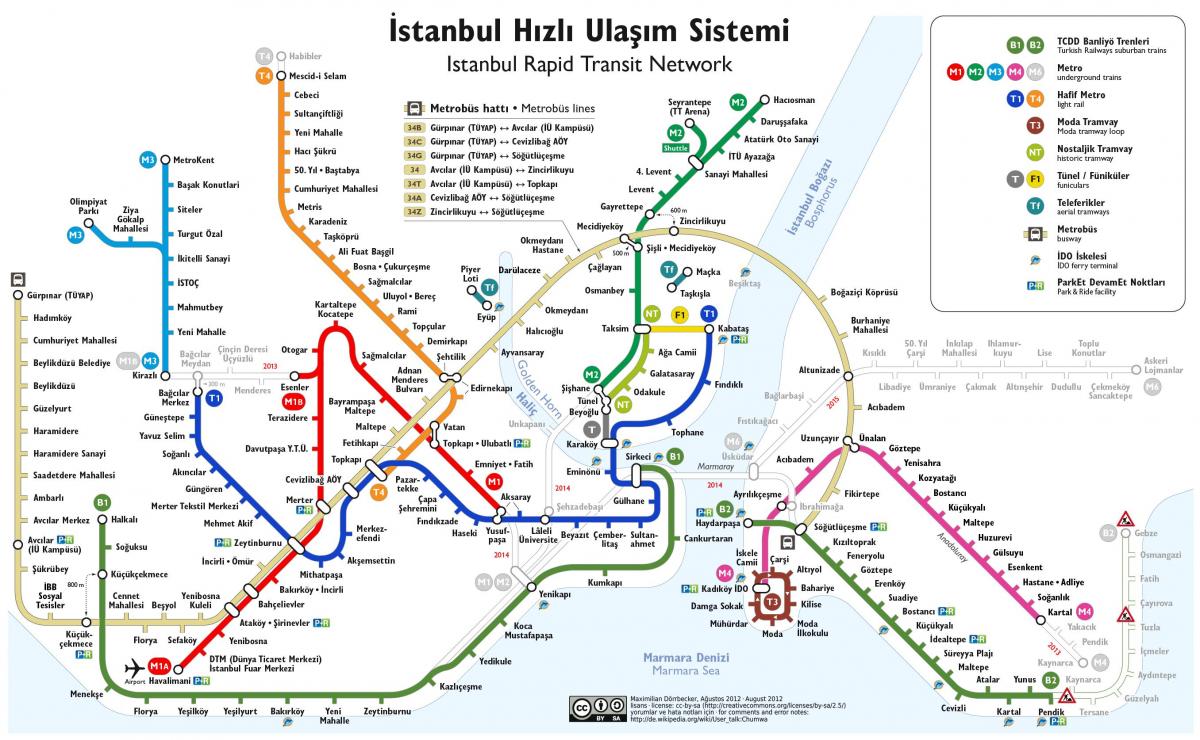
Istanbul Metropolitan Municipality plans to extend the cable car system by adding two new lines by 2029.
Buses (Otobüs)
Istanbul has an extensive bus network that provides access to every corner of the city. There are 11.795 Istanbul bus stops as of January 2024, including 44 Metrobus stops. The 3.060-car fleet of IETT (Istanbul Electric Tram and Tünel Company) runs through these stops daily.
You can use IETT’s website to search for specific bus lines, their departure times, and routes. Also, if you don’t know how to get to a particular location, you can use the website to search for bus stops and lines near that location.
Metrobuses (Metrobüs)
Metrobus is a bus rapid transit route with 44 stations. There are currently five Metrobus lines in Istanbul:
- 34 Avcılar – Zincirlikuyu
- 34A Söğütlüçeşme – Cevizlibağ
- 34AS Avcılar-Söğütlüçeşme
- 34BZ Beylikdüzü-Zincirlikuyu
- 34C Beylikdüzü – Cevizlibağ
- 34G Beylikdüzü – Söğütlüçeşme
- 34U Uzunçayır-Zincirlikuyu
- 34Z Zincirlikuyu – Söğütlüçeşme
The term Metrobus – or Metrobüs in Turkish – was coined by IETT and is a portmanteau of metro and bus.
Since Metrobus mostly follows a dedicated bus lane along its route, it stands out as a faster alternative to regular buses. The line starts from the Avcılar district on the European Side and follows a 52-kilometer (32-mile) route to reach Söğütlüçeşme on the Asian Side.
Minibuses (Dolmuş)
Minibuses operate as a shared taxi service, with cheaper prices than regular taxis. They usually have fixed routes and offer an even more extensive network than public buses.
Ferry Connections
Istanbul has six major piers:
- Eminönü (European Side)
- Beşiktaş (European Side)
- Kabataş (European Side)
- Karaköy (European Side)
- Kadıköy (Asian Side)
- Üsküdar (Asian Side)
Since the bridges over the Bosphorus are always busy, the ferry is the fastest way to travel between European and Asian sides. Plus, the sea ride provides an unforgettable experience with majestic city views.
Inner-city public ferry lines in Istanbul run every 15 to 20 minutes from 07.00 to 23.00. Some lines also offer night rides from 00:30 to 05:30.
You can use İstanbulkart or purchase tickets at the ferry dock for the ride. For more information regarding the departure times, prices, and routes, visit İstanbul Şehir Hatları .
Besides the public ferry lines, the private company Dentur Avrasya Group offers speed boat trips between ports. They operate daily and more often than public ferries. You can visit their website for active lines and schedules.
Getting Around Istanbul is Easy
Traffic in Istanbul and Ankara, I can tell you, can be pretty atrocious so it is worth taking the time to get acclimated and learn the local tram, rail and ferry routes – plus who doesn’t love a funicular or a cable car ride? That’s as much entertainment as it is transportation.
See our article on the best Instagram photo locations in Istanbul and start planning your routes!
Best Instagram-Worthy Views in Istanbul
How do I pay for public transportation in Istanbul?
You can use İstanbulkart or buy electronic cards for public transportation. Taxis and minibuses usually accept cash, whereas you can pay with your credit card in some taxis.
How much is the İstanbulkart card in 2024?
As of January 2024, İstanbulkart full-fare is 15 TRY, and Mavi Kart full-fare is 1,177 TRY.
Electronic ticket prices are:
- Single ticket – 20 TRY
- Two-pass ticket – 38 TRY
- Three-pass ticket – 60 TRY
- Five-pass ticket – 90 TRY
- Ten-pass ticket – 170 TRY
However, since fares constantly change, visit IETT’s website to see the current pricing.
What is the cheapest way to get around Istanbul?
Public transportation, especially the metro, is the cheapest way to travel around Istanbul. You can also use minibuses, which usually have similar pricing to public transportation.
Are taxis cheap in Istanbul?
Compared to other means of transportation, taxis are generally an expensive option. The taxi fare per kilometer is usually equivalent to the bus fare.
Can I use Uber in Istanbul?
While Uber is available in Istanbul, it uses regular yellow taxis. However, it is still more convenient and affordable. You can also use iTaksi or BiTaxi apps for a ride.
tenminutetravelbreak_mark
Veteran, former expat, former travel agent, investor, digital content creator and creative soul. Make your escape to discover and explore a range of exotic places and amazing destinations around the globe
Recent Posts
Train Routes from Rome
Exploring Italy by Rail, starting your journey from Rome Embarking on a rail journey through Italy starting from Rome unveils a captivating adventure filled with cultural richness, historic...
Getting Around Milan
A Guide to Public Transport in Milan Milan is one of Italy’s most popular city break destinations, frequented by many travelers on a long weekend. The city is small, and much of it is walkable,...
You will be redirected to your dashboard shortly. We will also call you back in 24 hrs .
- 13 Best Places Near Istanbul To Explore The City Beyond Its Borders
23 Mar 2023
Istanbul is one of the big cities of Turkey and spreads across Europe and Asia on the Bosphorus Strait. the city is historically known as Byzantium and Constantinople. Istanbul has a very rich history and culture and various destinations for tourists to visit and see and because this city is so famous and packed with things to see and do, it sometimes overshadows the numerous cities and attractions that are near the city or around it and this article will list the places near Istanbul and the beautiful cities near Istanbul that you can visit.
13 Gorgeous Places Near Istanbul
If you are planning to visit Istanbul for a holiday, do not just limit yourself to the city. There are many interesting places near and around Istanbul that can add some extra punch to your vacation. If not all, here are 10 best places near Istanbul that you must visit on priority.
- Belgrad Forest – Enjoy Natural Beauty
- Prince Islands – Enjoy A Ferry Ride
- Kilyos – A Resort Town
- Cappadocia – Enjoy Hot Air Balloon Ride
- Edirne – Rich In Culture
- Blue Mosque – A Historical Place
- Bursa – Enjoy Turkish Cuisine
- Şarköy – Enjoy Completely
- Sapanca – With Amazing Natural Environment
- Antalya – A Popular City
- Polonezkoy – A Small Town
- Sile – A Charming Place
- Agva – Get Impressed By The Beauty
1. Belgrad Forest – Enjoy Natural Beauty

Image Credit: User:Yonca for Wikimedia Commons
This is a mixed deciduous forest which is located adjacent to Istanbul and is a popular destination for tourists who want to escape the bustle of the city and enjoy the natural beauties that are preserved in this forest. Tourists can drive to the forest from Enterprise offices and enjoy activities like trekking and hiking through its numerous trails, taking nature walks or even having a picnic or a barbecue at some of the designated areas which are a favorite pastime for even the locals during the weekends, this is one of the more beautiful places near Istanbul.
Best Time to Visit : Can be visited throughout the year Location : Kemer, 34450 Sarıyer/İstanbul, Türkiye Distance from Istanbul : 29 Km
Must Read: 9 Istanbul Restaurants For That Perfect Turkish Culinary Affair
Looking To Book An International Honeymoon?

Bali Honeymoon Starting @ Rs 16,999/--
Plan your honeymoon today!

Europe Honeymoon Starting @ Rs 89,999/-
Get quotes from multiple travel experts.

Mauritius Honeymoon Starting @ Rs 27,000/--
Compare and customize quotes before booking.

Maldives Honeymoon Starting @ Rs 39,800/-
Have questions? Talk to our travel experts today.

Honeymoon in Sri Lanka @ Rs 13,500-
Best prices guranteed

Honeymoon in Seychelles@ Rs 40,999/-
EMI option available

Thailand Honeymoon @ Rs 19,999/
Includes resorts, meals, cabs & sightseeing
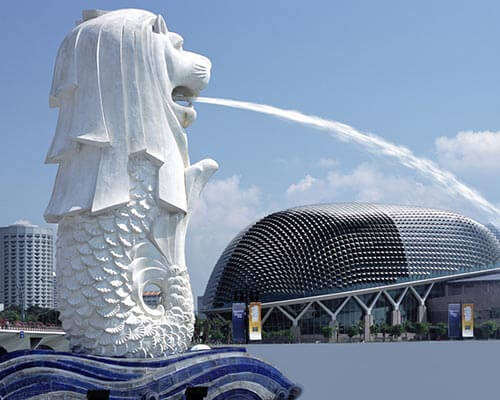
Singapore Honeymoon @ Rs 21,000/-
Gift your partner lifetime memories. Go international
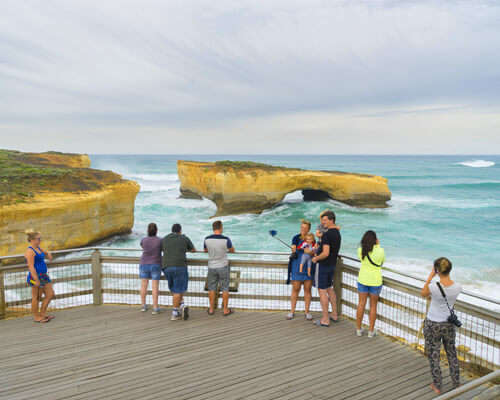
Honeymoon in Australia @ Rs 70,000/-
Romantic pristine beaches

See more at TRAVELTRIANGLE.COM
2. Prince Islands – Enjoy A Ferry Ride
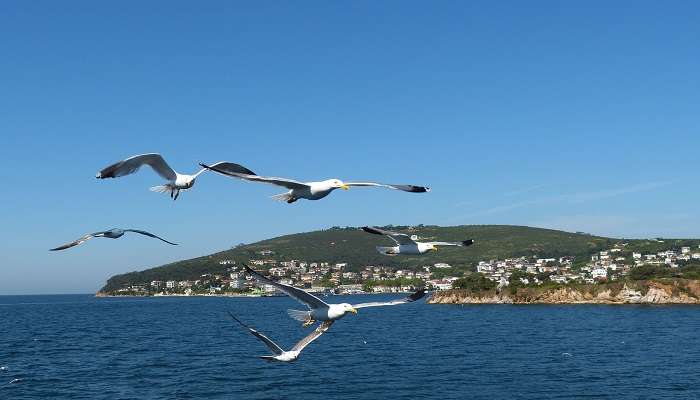
Image Credit: Falco by Pixabay
Also called Prince’s Island this is a cluster of nine islands that are based off the Asian coast of Istanbul, people can visit these islands by a ferry ride from Istanbul. These islands are popular for the fact that there are no motorized vehicles allowed so there are horse drawn carriages only, the other aspect of these Islands is the architecture and the untouched forests which will make you feel like you have time traveled into the past. This is one of the more relaxing places to go near Istanbul.
Best Time to Visit :April-May and September-October Location : Adalarİstanbul, Türkiye Distance from Istanbul : 17.6 km
3. Kilyos – A Resort Town

Image Credit: Ozan Kilic for Wikipedia Commons
This is a resort town or village which is located in the Sariyer district and is a well-known seaside destination as it rests on the Black Sea coasts, the tourists come here to visit and enjoy some of the beaches and visitors can also enjoy the big parties organized during the weekends or visit the 14th century Genoese castle which is in the village.
Best Time to Visit :Can be visited throughout the year Location : Kumköy34450 Sarıyer/İstanbul, Türkiye Distance from Istanbul :60 km
Suggested Read: 4 Best Wedding Venues In Istanbul For An Out-Of-The-World Experience!
4. Grand Bazaar- A Popular Shopping Destination
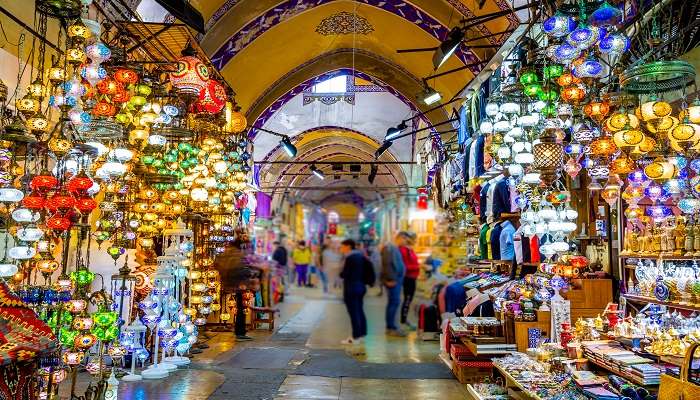
Image Source
known as the world’s biggest enclosed bazaar, The Grand Bazaar is one-stop destination for the tourists who want to explore traditional goods such as textiles, authentic jewelry etc for amazing shopping experience. spread across 30,700 square metres, this amazing destination features 64 shopping streets, more than 4,000 stores, cafes, banks as well as post office and the mosque, making it a little central city. it is world’s oldest bazaar that is keeping a lot of vanishing professions alive with their unique culture. This place is a like paradise for all the shopping lovers as well as for tourists.
Best Time to Visit :Can be visited throughout the year Location :Beyazıt, 34126 Fatih/İstanbul, Türkiye Distance from Istanbul : 3.2 km
5. Edirne – Rich In Culture
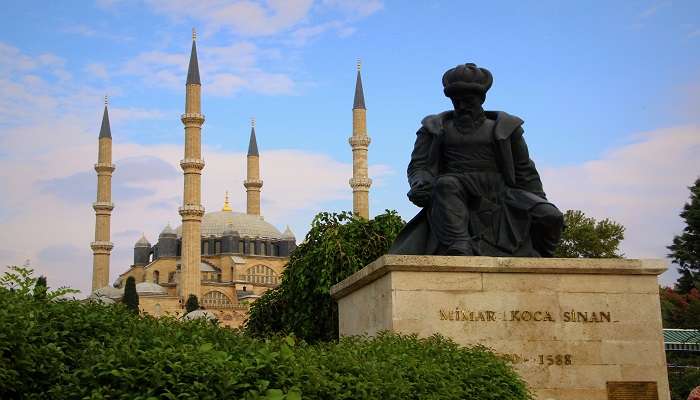
Image Credit: Tevfik Teker for Wikipedia Commons
This city which is located in the region of East Thrace and was the capital of the Ottoman Empire before Istanbul was captured, this is one of Istanbul neighboring cities and is rich in culture and history and travelers can come to see the amazing architecture, many iconic mosques, cathedrals, Palaces and more. Visiting this city is an amazing experience and an opportunity to learn about its history and culture and it is among the most beautiful cities near Istanbul.
Best Time to Visit :Between late June and late August Location : 22100 Edirne Türkiye Distance from Istanbul :213 km
Suggested Read: 4 Best Ways To Experience Safari In Istanbul On A Thrilling Turkey Vacation
6. Blue Mosque – A Historical Place
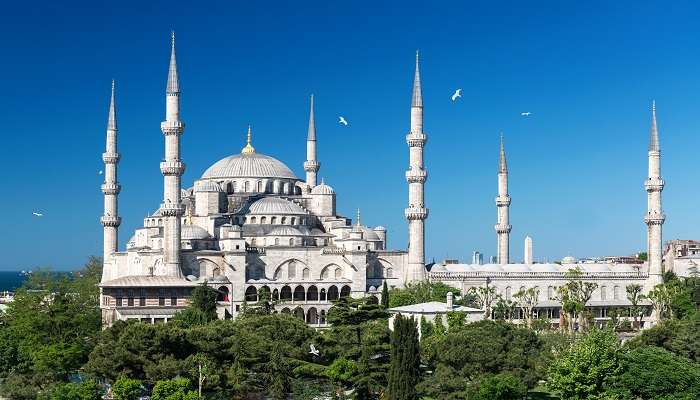
This mosque is also known as Sultan Ahmet Mosque is a historical mosque which is now among popular tourist places near the Istanbul airport, the mosque is called blue mosque due to the blue tiles on the interior and the fact that the mosque appears blue during the sunset time due to the light. This is an amazing view and it still functions as a place of worship along with being a popular tourist destination.
Best Time to Visit : Can be visited throughout the year Location : Binbirdirek, At Meydanı Cd No:10, 34122 Fatih/İstanbul, Türkiye Distance from Istanbul : Less than 1 km
Planning your honeymoon but confused about where to go? These honeymoon stories help you find your best honeymoon trip ever!

Rahul's Honeymoon Story Tells Why Bali Is The Ultimate Romantic Escape
Dinner cruises, Cabarets, & More. Wow! I'm Excited!

Vishal Lists The Most Romantic Places In Europe From His Honeymoon Tour
Find some handy city-specific tips from Vishal!

Take A Peek Into Puneet's Movie-Like Honeymoon In Mauritius
Romantic dinner date & Undersea walk are love!

Sun, Sand, & Desert Safari Made Dubai A Perfect Escape For Roshan & His Wife
Here's what to explore on a 4N/5D Honeymoon in Dubai

Keshav Narrates How Seychelles Proved To Be The Ultimate Tropical Paradise
Beaches, Self-Driven Tours, & Snorkeling.

Pooja's Husband Surprised Her With A Splendid Singapore Honeymoon Tour
And she shared her tales from the Fantasy Land!

Nisarg Can't Stop Praising His Honeymoon Trip To Maldives
There was snorkeling, sightseeing, luxury, comfort, & much more!

Anurag Tells Why Sydney & Gold Coast Are Perfect For A Honeymoon In Australia
Nightlife, Romantic cruises, & Jenolan Caves. Wow! Tell me more...

Vinamra Describes How New Zealand Amazed Him & His Wife On Their Honeymoon
Helicopter ride, Scuba diving, & beauty all around!

Sandeep Describes The Amazing Experience Of Nature On His Honeymoon Tour
Nawara Eliya is so beautiful. And there's more!

Devansh Went On A Honeymoon Trip To Thailand & Came Back With Some Useful Tips
The Best of Bangkok, Phuket, & Pattaya!
7. Bursa – Enjoy Turkish Cuisine
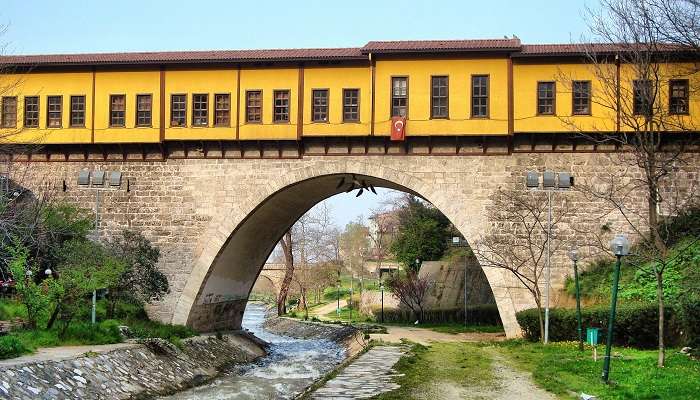
Image Credit: Haluk CÖMERTEL for Wikipedia Commons
This is among one of the tourist cities near Istanbul with various attractions and things to do in Istanbul along with being famous for Turkish cuisine. This industrialized metropolitan city has amazing architecture, numerous mosques and historical sites, many parks and botanical gardens and an amazing mountain backdrop. This city is located in northwest Anatolia, within the Marmara Region and is a must visit a city that is near Istanbul along with Edirne.
Best Time to Visit : April, May, June, July, August, September, October and November Location : Atatürk Cad. Uçak Sok. No 1 16020 Bursa Türkiye Distance from Istanbul : 91 km
Suggested Read: 6 Waterfalls In Istanbul One Must Visit To Witness The Charismatic Beauty Of Nature!
8. Şarköy – Enjoy Completely
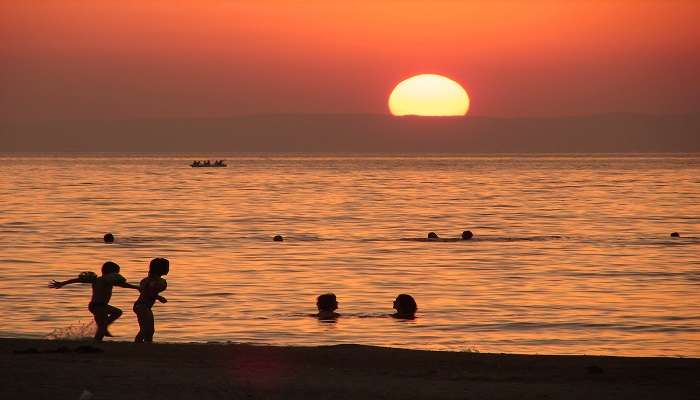
Image Credit: Nevit Dilmen for Wikipedia Commons
This small seaside town which is located in the Tekirdag Province on the north coast of the Marmara Sea can be reached by inland roads. This place is for having the longest beach in Turkey which was dirty before but was cleaned up and received a blue flag, you can go fishing, swimming or even motor boating from here to Avsa or Marmara islands, the town has numerous hotels, bars, and clubs to enjoy as well as wineries which tourists can visit and indulge in some wine tasting since this area is known for wine-making.
Best Time to Visit : June, July, August, September Location : Altıntepsi, Büyük İstanbul Otogari D:26, 34035 Bayrampaşa/İstanbul, Türkiye Distance from Istanbul : 13.7 km
9. Sapanca – With Amazing Natural Environment
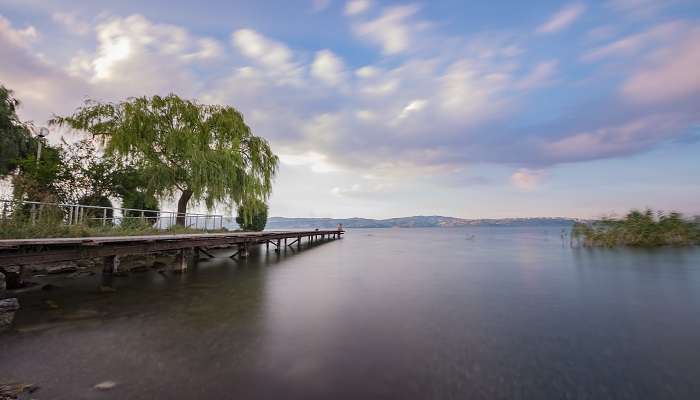
This is a town located in the Sakarya Province in the Marmara region and has become a tourist destination recently due to its amazing natural environment, the lake and also the fact that it is located just below the Kartepe ski resort which makes visiting this town during the winter for winter sports ideal. The town has a number of resorts and hotels along with pubs, bars, and clubs that you can enjoy while on your visit there. It is one of the best places near Istanbul to visit by car.
Best Time to Visit : Late June to Early September Location : Rüstempaşa, Petek Sk. No:3, 54600 Sapanca/Sakarya, Türkiye Distance from Istanbul : 116 km
Suggested Read: 8 Incredible Restaurants In Turkey That Are Creating A Lot Of Buzz
10. Rumeli Fortress – A Popular Historical Place
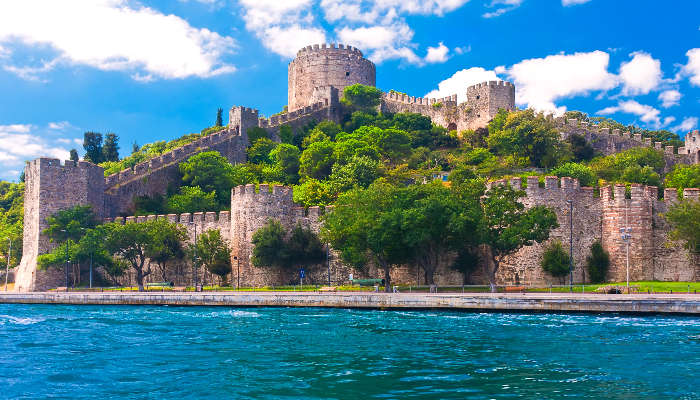
Rumeli Fortress, also known as Rumeli Hisarı, is an awe-inspiring historical gem nestled on the European side of Istanbul, Turkey. With a history dating back to the 15th century, this imposing structure stands as a testament to the city’s rich heritage. Commissioned by Sultan Mehmed II in 1452, its primary purpose was to secure control of the Bosporus Strait during the famed Ottoman siege of Constantinople. Boasting strategic positioning and robust defensive walls, the fortress showcases an exceptional example of military architecture from the era. Today, visitors flock to this UNESCO World Heritage site, marveling at its grandeur and enjoying breathtaking vistas of the Bosporus.
Best Time to Visit : April to mid-June (Spring) and September to mid-October (Autumn) Location : Rumeli Hisarı, Yahya Kemal Cd., 34470 Sarıyer/İstanbul, Turkey Distance from Istanbul : 22.7 km
11. Polonezkoy – A Small Town
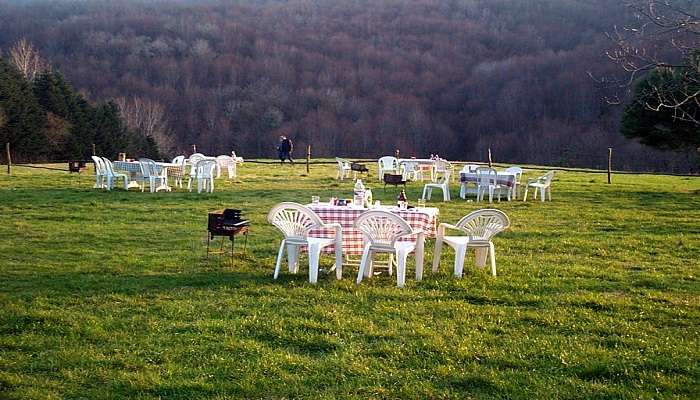
Image Credit: Nevit Dilmen for Wikimedia Commons
Polonezkoy is a small town located on the Asian side of Istanbul around 30 km away. It is rich in natural beauty and one of the top places to visit near Istanbul. Due to its history, you will still find a small Polish settlement in the village. The place has been able to maintain a top notch central European village charm, which is very ideal for excursions, picnics and long walks, especially if you are with a loved one. Taste some mouth-watering Turkish foods that are authentic in nature. The town has managed to preserve a rich environment with a wide area dedicated to lush green forests. Some top attractions to visit include Polonezköy Nature Park, İstanbul Kelebek Çiftliği and Nehir Park.
Best Time to Visit :May, September and October Location :Polonez34829 Beykoz/İstanbul, Türkiye Distance from Istanbul : 40 km
Suggested Read: Turkey Honeymoon: 13 Romantic Experiences To Let The Love Blossom
12. Sile – A Charming Place

Image Credit: Fatih Ahıskalı for Wikimedia Commons
Sile is one of the most charming places around Istanbul with lots of sandy beaches covering its shores. The sea conditions are similar to that of Black Sea with frequent undercurrents. If you are planning to spend your summer in Turkey , then Sile should be on top of your list due to the ever-gusting winds, climate and a perfect resort town. The fishermens’ harbor is another popular destination in Sile as you get to taste some fish freshly caught from the nearby restaurants. Some other popular attractions include Şile Aqua Beach, Şile Lighthouse, Ağlayan Kayalar Şile and more.
Best Time to Visit : July, August, and May Location : Şile İstanbul, Türkiy Distance from Istanbul : 83 km
13. Agva – Get Impressed By The Beauty
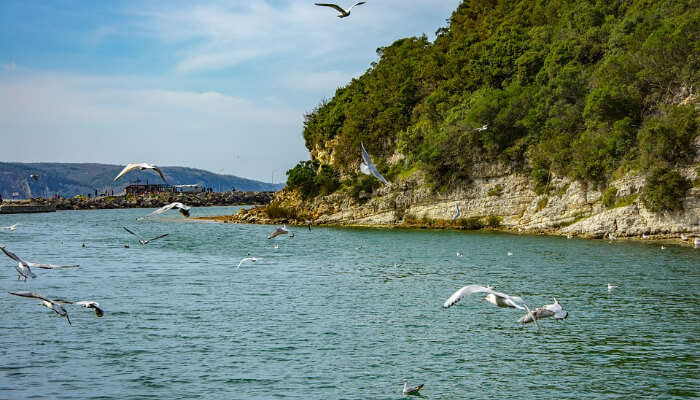
Image Credit: orhanyunus18 for Pixabay
Agva is another popular resort town and one of the best places to visit near Istanbul, if not the best. The whole town is situated between the calm waters of Goksu and Agva rivers. You can explore immense natural beauty and a vast beach area around Agva. Many Turkish films have been shot here subject to the unique beauty of the place. Some fabulous places that you can visit in Agva are Kilimli Dark Trekking Trails, Ağva Feneri, Ağva Plajı, Green Park, Bozgoca Köyü Cami and Tatooine Beach.
Best Time to Visit : May and August Location : Ağva MerkezŞile/İstanbul, Türkiye Distance from Istanbul : 109 km
Further Read: 10 Routes For Trekking In Turkey For Both Beginners And Advanced Trekkers
These are some of the best places near Istanbul for you to visit. Istanbul itself is an amazing city with numerous attractions and rich culture, but if you are an explorer at heart then you must visit these destinations and more as there are numerous places to see near Istanbul. So, plan a trip to Istanbul right away and explore the city in and out.
For our editorial codes of conduct and copyright disclaimer, please click here .
Cover Image Source- Shutterstock
Frequently Asked Questions About Places Near Istanbul
Which city is close to Istanbul?
Istanbul. For all cities with a population greater than five hundred thousand, Istanbul is closest to Bursa and farthest from Auckland. The closest foreign city is Bucharest and the farthest domestic city is Diyarbakir.
What country is near Istanbul?
Turkey is the nearest country, the city is located in the northwest of the country at the Bosporus (or Istanbul) strait, which connects the Black Sea with the Marmara Sea.
What is close to Turkey?
Turkey shares its land border with eight countries: Iraq, Bulgaria, Georgia, Iraq, Greece, Armenia, Azerbaijan, and Syria. The Turkey-Syria border is the longest, stretching a total of 511 miles, while the Turkey-Azerbaijan border is the shortest, at 6 miles in length.
Which is the best area to stay in Istanbul?
Sultanahmet. On the other part of the European side is Sultanahmet, which is the #1 area for tourism in Istanbul as it holds the Hagia Sofia, Blue Mosque, Topkapı Palace, and the movie-famous Basilica Cistern. You can stay here, but it’s a little more expensive in this area for shopping and food.
What should I avoid in Istanbul?
10 Things You Should Avoid Doing in Istanbul: 1. Don’t stay close to the sights. 2. Don’t take the tram on Istiklal. 3. Don’t shop on Istiklal. 4. Don’t buy apple tea. 5. Don’t buy everything you see on the bazaars. 6. Don’t buy on bazaars without haggling. 7. Don’t be afraid to try street food. 8. Don’t eat close to touristic places.
Which is the most beautiful city in Turkey?
Istanbul. The country’s largest and most famous city, Istanbul is home to some of the most beautiful buildings and landscapes in the whole of Turkey.
What should I buy in Istanbul?
1.Turkish Tea (Chai) Offered as a sign of welcome to guests in every household, Turkish black tea has to be consumed plain without any milk. 2. Turkish Delight (Lokum) 3. Evil Eye (Nazar) 4. Glass Lamps. 5. Turkish Towels (Peshtemal) 6. Soap. 7. Coffee Pot. 8. Carpets & Rugs.
Is it safe to travel to Istanbul?
The FCO has advised that Istanbul, Turkey’s largest city, and Ankara, its capital, are mostly safe. However, it warns that, much like other major cities, precautions should be taken to avoid the chances of being caught up in civil unrest or a terrorist attack.
The closest city to Istanbul in Turkey is Bursa which is situated around 150 kilometers away. If you are planning to explore Turkey then don’t miss out on places near Istanbul like Prince Islands and Cappadocia.
Istanbul is in Turkey and the country shares borders with eight other countries, namely Georgia, Greece, Iraq, Iran, Azerbaijan, Bulgaria, Syria, and Armenia. Istanbul is closest to Bulgaria as it located at a distance of 417 kilometers.
Istanbul and Ankara are the two cities that have been declared as safe to travel to in Turkey. However, one must stay alert in a new city or country to avoid any mishappenings.
Can you drink tap water in Turkey?
Generally, it is not advised to consume tap water in Turkey as it is not treated like in many other countries. It is better to buy bottled water for consumption and washing eatables.
How far is Istanbul from Santorini?
The distance between Istanbul and Santorini is around 595 kilometers which can be covered in different ways according to your suitability.
How far is Bursa from Istanbul?
The driving distance between Istanbul and Bursa is 250 kilometers which can be covered in a day.
Is there a ferry from Santorini to Istanbul?
Unfortunately, there are no direct ferries to Istanbul from Santorini. Ferries are available from Santorini to Rhodes. The best way to reach Istanbul is by taking a flight from Santorini to Athens and then to Istanbul.
Is Turkey expensive to visit?
Turkey is not an expensive destination for tourists who stay aware of genuine prices. A well-planned itinerary and several reasonable places to stay make it a cheap place to visit.
Looking To Book Your Honeymoon Package?

Kerala Honeymoon Package (6D/5N) @ Rs 16,000/-
Experience the backwaters of Kerala on a houseboat!
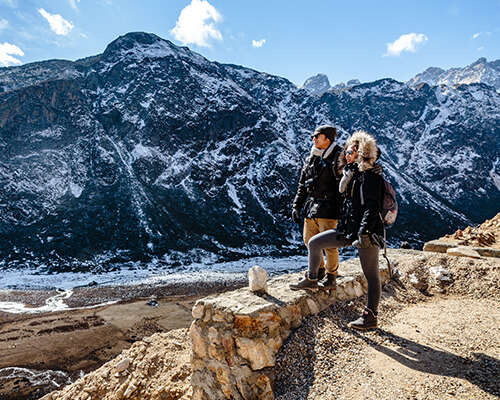
Sikkim honeymoon package (5D/4N) @ INR 14,000/-
Witness the beauty of Tsomgo lake

Goa Honeymoon package (5D/4N) @ INR 11,500/-
Spend some quality time on the beaches of Goa

Andaman Honeymoon package (5D/4N) @ INR 23,000/-
Scuba Dive into the depths of Andaman

Himachal honeymoon package (4D/3N) @ INR 8,500
Romantic getaway amidst the hills

Rajasthan Honeymoon package (4D/3N) @ INR 8,000/-
Explore glorious places, colourful towns, sand dunes and lakes
People Also Read:
Places Near Vagamon Places Near Madikeri Places Near Udupi
Recent Posts

Must See Rivers in Vietnam For A Complete Vietnamese Experience

Picnic Spots In Surat: Escape From The City Noises And Pamper Yourself With Stunning Destinations

5 Must-Visit Destinations On The Delhi To Udaipur Road Trip
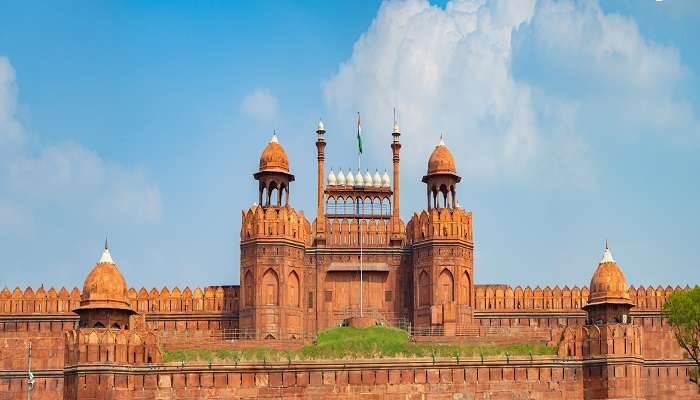
Top 10 Places To Visit Near Red Fort Delhi Within 200 Km
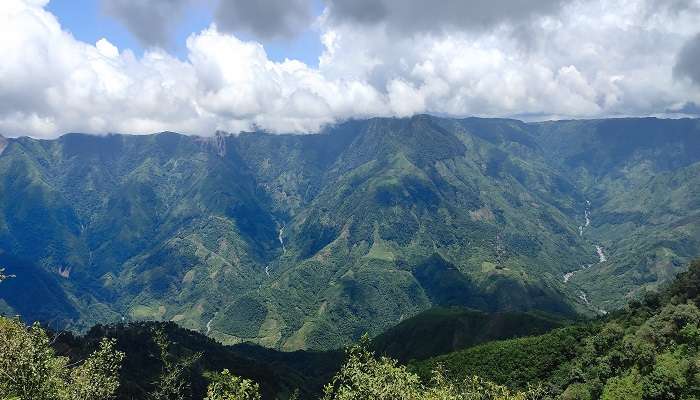
Picnic Spots In Meghalaya: Absolute Paradise For Unwinding During Weekends

Offbeat Places In North Goa That Are Worth Visiting For A Wholesome Travel Experience
Trending Blogs

20 Mysterious Places In India To Visit In 2023 More Bizarre Than The Bermuda Triangle

10 Scariest Roads In India That Are A Driver’s Nightmare

101 Places To Visit In India Before You Turn 30 in 2024

35 Exotic Places To Visit In December In India 2024 To Enjoy A Surreal Vacation

60 Best Honeymoon Destinations In India In 2024

95 Best Honeymoon Destinations In The World In 2023 For A Romantic Escape!
Best Places To Visit In India By Month
Best places to visit outside india by month.
- TravelTriangle
- Turkey »
- Tour Packages
- Honeymoon Packages
- Family Packages
- Budget Tour Packages
- Luxury Tour Packages
- Adventure Tour Packages
- Group Tour Packages
- Kerala Tour Packages
- Goa Tour Packages
- Andaman Tour Packages
- Sikkim Tour Packages
- Himachal Tour Packages
- Uttarakhand Tour Packages
- Rajasthan Tour Packages
- Tour Packages From Delhi
- Tour Packages From Mumbai
- Tour Packages From Bangalore
- Tour Packages From Chennai
- Tour Packages From Kolkata
- Tour Packages From Hyderabad
- Tour Packages From Ahmedabad
- Kerala Tourism
- Goa Tourism
- Sikkim Tourism
- Andaman Tourism
- Himachal Tourism
- Uttarakhand Tourism
- Rajasthan Tourism
- Hotels in Kerala
- Hotels in Goa
- Hotels in Sikkim
- Hotels in Andaman
- Hotels in Himachal
- Hotels in Uttarakhand
- Hotels in Rajasthan
- Tulips in Istanbul – April to May
- Snowing in Istanbul Walking Tour in freezing cold weather with captions
- 24 Istanbul videos to inspire you before you come here.
- 24 place in Istanbul to see. Video on Youtube
- Youtube – Istanbul
- Corona Istanbul Turkey
- Leander’s Tower (Maiden’s Tower) Istanbul
- 10 things you need to know about Istanbul
- 7 Public Bazaar (Open Market) in Istanbul
- Bakırköy – Istanbul

Travelling around Istanbul
Public transport Istanbul’s public transit system can be difficult to figure out; maps are rare and you often have to transfer, and pay another fare, to get where you are going. However, if you put some effort into it, you can avoid taxis and not walk too much.
There is an extensive bus system, including city-run and private buses, as well as one high-speed Metrobüs line; an extensive light rail system including four Metro (underground) lines, four Tramvays (aboveground), two Fünikülers (ascending/descending), two mini-lines called Teleferik, and the Marmaray (underwater) lines; and the ferries which travel the Bosphorus.
An important supplement to all of this (particularly late at night) is the fleet of private dolmuş minivans, which follow prescribed routes and wait until they fill up before departing. They range in price from 2-8 lira (paid in cash), depending on how far you’re going. They run all night long, unlike most of the public transport lines. So if you find yourself stranded at Taksim at 4am, a dolmuş is your way home. Look for the yellow minivans, and ask them where they’re going (“néreye gidiyórsunuz?”).
Each time you use a tram, metro, bus, or boat on the public transport system, you will need to use a token (expensive) or a magnetic card (cheaper, see below). The small metal/plastic tokens cost 4 TL (July 2014) and can be bought at various ticket kiosks & machines at bus, railway and metro stations. Ticket fares across buses, trams and metros are at a flat rate (i.e. not dependent on how far you go). Only cash in Turkish lira is accepted at ticket kiosks of public transport, no credit cards or foreign currency. Also be aware that the Istanbul subway system does not offer transfer tickets and as such each new line requires a new fare, unless you use an an Istanbulkart
Istanbul Kart
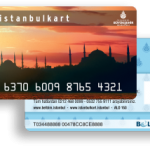
Buying an Istanbulkart is a good idea if you are in Istanbul for more than a day or two, and intend to use public transport. This is a plastic card that looks like a credit card. It can be used as a ticket on buses, trams, suburban trains, metro, some cross-Bosphorus ferries, and even some public toilets. You touch the Istanbulkart to a reader when you get on the bus or enter the tram/metro platform. The great part for groups of travellers is that you can buy only one and touch it as many times as there are passengers (unlike London’s Oyster card, there is no need to touch out). You can buy or refill them at designated booths located at any major bus, tram, to metro station, as well as some other places such as newspaper stands close to bus stops.
By Bus (İETT) There are two types of public buses in Istanbul; those run by the private sector and those run by the city-owned İETT. You can differentiate these two types by their colors. Privately run buses are blue-green with yellow non-electronic destination signs while İETT-run buses come in many flavors including old red-blue ones, newer green ones and red double-deckers. The Akbil Transit Pass is valid universally while tickets that can be obtained in kiosks near bus stops for 1.40 TL are valid only on İETT buses and cash payment only on private buses, although if you get on an İETT bus the driver will normally accept cash (normally 1.50 TL but this is dependent entirely upon what the driver wishes to charge) and hand you his Akbil for you to use.
Recently installed Metrobüs, long hybrid buses running on their special lanes separated from all other traffic and thus saving lots of time in Istanbul’s usually congested roads, connect western suburb of Avcılar with Kadıköy in Asian Side via Bakırköy, Cevizlibağ which is just out of old city walls near Topkapı Gate, and Mecidiyeköy.
Most bus lines operate between 6AM and around midnight, usually with a reduced volume of services after 10PM. Some lines between major centres operate 24 hr, though, as is the Metrobüs, with about an hour intervals. After midnight, buses cost two tickets pp rather than the usual one. Buses and streetcars tend to be very crowded during rush hours, especially on Mondays and Fridays. That can also create opportunities for pickpockets.
24 hr Bus Lines:
73 Taksim Square-Ataturk International Airport 110 Taksim Square-Kadikoy 112 Taksim Square-Bostanci 25T Taksim Square-Sariyer 40 Taksim Square-Sariyer 89C Taksim Square-Basaksehir E10 Kadikoy-Sabiha Gokcen International Airport 15F Kadikoy-Uskudar 130 Kadikoy-Tuzla 34A Sogutlucesme(Kadikoy)-Edirnekapi (Metrobus) 34 Avcilar-Zincirlikuyu (Metrobus)
As a tourist, you are most likely to use the tram and the metro in the Sultanahmet and Taksim area since there are no bus lines operating in the Sultanahmet area anymore.
Istanbul’s first underground system dates back to 19th century, when the funicular subway “Tünel” was constructed to operate from Karaköy to Istiklal Street in 1875. The distance travelled was 573 metres. This is a good way to go up the hill from the Beyoğlu side of the Galata Bridge to the famous Istiklal Caddesi pedestrian street.
Starting in the 1990’s, a modern and extensive (and often confusing) light rail system has been constructed in all parts of the city. The newest (as of October 2014) addition is the Marmaray undersea tunnel, which crosses below the Bosphorus from the the Sultanahmet area to the Anatolian side. Underground lines are called “metro,” above ground lines are called “tram,” and there are also short, uphill lines called “füniküler,” two tiny “teleferik” lines, and the undersea Marmaray. There is also a high-speed bus called Metrobüs, complementary to this whole network.
There are four Metro lines, the first of which has two branches. The most useful to most tourists will be M1A which visits both Atatürk Airport and the Otogar Bus Station, and the M2 which passes near to Sultanahmet and travels to Galata/Taksim and beyond.
All lines are still being extended, but as of October 2014, they include:
M1A starts in Aksaray (west of Sultanahmet) and ends at Atatürk Airport, traveling via Emniyet-Fatih, Topkapı-Ulubatlı, Bayrampaşa-Maltepe, Sağmalcılar, Kocatepe, Otogar, Terazidere, Davutpaşa-YTÜ, Merter, Zeytinburnu, Bakırköy-İncirli, Bahçelievler, Ataköy-Şirinevler, Yenibosna, DTM İstanbul Fuar Merkezi, and finally Atatürk International Airport (Havalimanı) M1B also starts in Aksaray and has the same stops as M1A until Otogar. After Otogar, it continues with Esenler, Menderes, Üçyüzlü, and ends Bağcılar Meydan. M2 travels between Yenikapı (south of Sultanahmet) and Hacıosman, stopping at Vezneciler, Haliç, Şişhane (near Galata Tower), Taksim Square (north end of Beyoğlu), Osmanbey, Şişli-Mecidiyeköy, Gayrettepe, Levent, 4 Levent, Sanayi, İTÜ Ayazağa, Atatürk Oto Sanayi, Darüşşafaka, and finally Hacıosman. M3 is the Kirazlı-Olimpiyat-Başakşehir line. All stops are in the far west of the European side, and therefore unlikely to be of use to tourists and visitors. M4 goes from Kadıköy to Kartal on the Anatolian side, stopping at Ayrılık Çeşmesi, Acıbadem, Ünalan (aka Uzunçayır), Göztepe, Yenisahra, Kozyatağı, Bostancı, Küçükyalı, Maltepe, Huzurevi, Gülsuyu, Esenkent, Hastane-Adliye, Soğanlık, and finally Kartal. There is also a funicular system connecting Taksim to Kabataş, where you can take ferries across the Bosphorus to the Anatolian side, and also transfer to trams bound for the old city (see below). Another funicular, called Tünel, connects Şişhane to Karaköy (the eastern side of the Galata Bridge).
Nowadays, most metro stations do not have a staffed ticket booth, so you will have to obtain your token from automatic token dispensers (called Jetonmatic). Insert coins (except 1 or 5 kuruş) up to 4 TL and then press the button marked onay (Turkish for “approval”, no English translations are given on all the machines).
A token costs 4 TL (around €1.30) on any urban rail in Istanbul.
Istanbul Metro and Tram
A tram (line # T1) connects Zeytinburnu (connection to the metro line to the airport) to Kabataş (connection to the underground funicular to Taksim). The line is 14km long, has 24 stations and serves many popular tourist sites (e.g. in Sultanahmet) and ferries (e.g. Eminönü). An entire trip takes 42 minutes.
There are two tram lines running on the same tracks, the line numbered as 38 in front of tram cars runs along the entire T1 line between Kabataş and Zeytinburnu, while significantly shorter line #47 runs between Eminönü and Cevizlibağ stations (the latter of which is abbreviated as C.bağ-A.Ö.Y. on the signage of tram cars). However, both lines call at stations that are of most interest to travellers through the Old City. During morning and evening rush hours every alternate tram runs as #47, while during the rest of the day, most run as #38.
Although you may use the same tokens (2 TL) or AKBİL on the metro and tram, you must pay another fare each time you change lines.
The tram was put in service in 1992 on standard gauge track with modern cars, connecting Sirkeci with Topkapi. The line was extended on one end from Topkapi to Zeytinburnu in March 1994 and, on the other end from Sirkeci to Eminönü in April 1996. On January 30, 2005 it was extended from Sirkeci to Kabataş crossing Golden Horn after 44 years again. 55 vehicles built by ABB run on the line. The daily transport capacity is 155,000 passengers.
Tramway stations are: Zeytinburnu, Mithatpaşa, Akşemsettin, Seyitnizam, Merkezefendi, Cevizlibağ, Topkapı, Pazartekke, Çapa, Fındıkzade, Haseki, Yusufpaşa, Aksaray, Laleli (Üniversite), Beyazıt (Kapalıçarşı), Çemberlitaş, Sultanahmet, Gülhane, Sirkeci, Eminönü (ferryboats), Karaköy, Tophane, Fındıklı, Kabataş.
Between Taksim and Kabatas, there is a modern underground funicular to connect this tram line to the Taksim metro. The tram is also connected to the southern metro line (for the Otogar and Ataturk Airport) at Aksaray station, though the metro and tram lines are a short walk from each other.
During morning and evening rush hours (roughly between 7AM-9AM and 5PM-7:30PM respectively), tram cars run jam-packed so if you intend to take it for a couple of stations down the way, don’t even bother—walking instead is not only less tiresome than standing in what is essentially more crowded than a sardine can, it’s also quicker as you will most likely be able to get in the second or even third tram calling at the station due to the crowd.
There are also two other tram lines linking residential and industrial suburbs in the northwest with the city centre: T2, which heads for Bağcılar, and T4 (which is more like metro-tram systems of northwestern Europe, as it lies underground for part of its route), which heads for Sultançiftliği, connecting to the Zeytinburnu and Topkapı stations of the T1 line respectively. However, these lines are of very little, if any, use to the average traveller.
Taxis are an easy and cheap way to get around. As of September 2016, start off rate is 3.40 TL (€1.1) and then 2.1 TL (€0.6) for each km afterwards. A one-way travel from Taksim Square to Sultanahmet costs approximately 10-15 TL. Tipping is generally unnecessary. Occasionally, drivers will refuse to start the meter and try to negotiate a fixed price (but most drivers will start taximeters at all times). You should avoid these cabs and simply take another one as you will almost certainly end paying too much. To be sure, before getting in, just ask “how much to go to …?” (most of the drivers understand basic English) since the price they tell then is quite accurate. Tell them then to put the taximeter on. Drivers do normally work with the taximeter, so they will not be surprised at all when you ask them to put it on. The price at the end will be quite close to the one they tell you at the beginning. There is now, as of October 2009, just one fare unit, it means, there is no extra fare at night.
Taxis that wait near a bus station are usually a tourist trap. They start the meter but charge you 20 TL at least. Emphasize to the driver that you will pay for the meter price before getting in. Do not buy their quick-sell tricks. Always try to stop a taxi that is passing by on the road or find a legitimate taxi stop.
Insist on going to the destination that you want because some drivers are payed by commission for each time they have someone go to a certain site.
Beware riding a taxi other than the “yellow-colored” ones since the other-colored taxis are registered under different cities and have a different rating system.
Be careful on what notes you hand them for payment; some drivers have tried to pretend that the 50 lira note that was handed was just a 5 lira note. Occasionally taxi drivers may actually also rip notes you give them, and tell you it is no good, in order to make you hand them a 50 lira note. So, make sure the notes are not ripped, and is actually the right one before you hand them over. Also, if you are not familiar with the city the taxi driver may drive a detour in order to charge you more.
Traffic can be very bad, it can take an hour for a few km through the old city. You might be better off taking the metro out of the old city and then a taxi from there.
Some important routes with distances and estimated taxi fares are :
Ataturk Airport (IST) – Taxim Square ~ 21 km. See taxi fare and directions Ataturk Airport (IST) – Sultanahmet Square (Old City) ~ 18 km. See taxi fare and directions Taxim Square – Sultanahmet (Old City) ~ 5,5 km. See taxi fare and directions Sabiha Gokcen Airport (SAW) – Kadikoy (Chalcadonia) Ferry Terminal ~ 36 km. See taxi fare and directions Esenler (Bus Terminal) – Topkapi Palace (Sultanahmet) ~ 10,5 km. See taxi fare and directions Esenler (Bus Terminal) – Ataturk Airport (IST) ~ 15 km. See taxi fare and directions By shared taxi[edit]
By shared taxi
Dolmuş (Turkish: “full”) is a shared taxi, travelling on a fixed route, which costs more than a city autobus but less than a normal taxi. They can carry up to 8 passengers. They are easy to recognize, because they also have the yellow painting as taxis and carry a Dolmus sign on its top. They will only start driving when all eight places are filled, which is also where the name derives from.
The main and most important routes for Dolmuses are :
Taksim – Eminönü (Taksim stop, near the Ataturk Cultural Center, in Taksim square) Taksim – Kadıköy Taksim – Bostanci Taksim – Aksaray (Taksim stop, Tarlabasi Avenue, close to Taksim square) Kadıköy – Bostanci (Bostanci stop, in front of the Bostanci ferry port) Taksim – Tesvikiye (Taksim stop, in front of Patisserie Gezi, in Taksim square) Beşiktaş – Nisantasi (Beşiktaş stop, in front of the Beşiktaş – Üsküdar ferry port) Kadıköy – Üsküdar (Üsküdar stop, Near the Üsküdar – Beşiktaş and Üsküdar – Kabataş ferry port) If you want the driver to make a stop, you can say İnecek var.(EE-neh-djek war!) (Someone’s getting out.) or Müsait bir yerde.(mU-sa-EEt bir yer-deh.) (At a convenient spot.).
Related posts
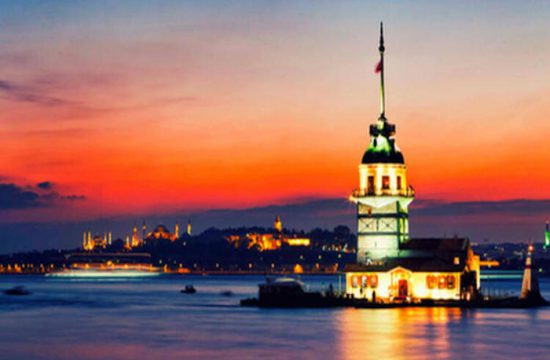
Leave a reply Cancel reply
This site uses Akismet to reduce spam. Learn how your comment data is processed .

- Living In Croatia
- Croatian Recipes
- Balkan Recipes

Home > A Guide to Kadikoy: Things To Do In Kadıköy Istanbul
A Guide to Kadikoy: Things To Do In Kadıköy Istanbul

Written by our local expert SJ
Sarah-Jane has lived in Croatia for 10+ years. SJ, as she is known, has been traveling the Balkans & beyond since 2000. She now shares her passion for traveling with her husband & kids.
I am just back from my trip to Istanbul, this time to the Asian side, which offers a welcome escape from the hustle and bustle of the city’s more touristy areas on the European side.
In Kadıköy, you can soak in a more tranquil ambiance away from the crowds. Here is your guide on what to see, do, and where to eat in Kadikoy, Istanbul.
If you’ve never been to Istanbul before, you’re in for a treat. This city is packed with so much to see and do that it’s impossible to see it all on one trip, which is why I have been there so many times.
Most people visit the European side of the city first, taking in sights in Sultanahmet , Taksim , Beyoglu , and Besiktas. However, the Asian side shouldn’t be forgotten.
Kadikoy is a large neighborhood on the Asian banks of the Bosphorus, offering a trendy, action-packed, and street food-filled experience . With a youthful student vibe, Kadikoy is a lot more chilled-out than the European side’s districts, and you’ll find a more authentic way of life as a result.
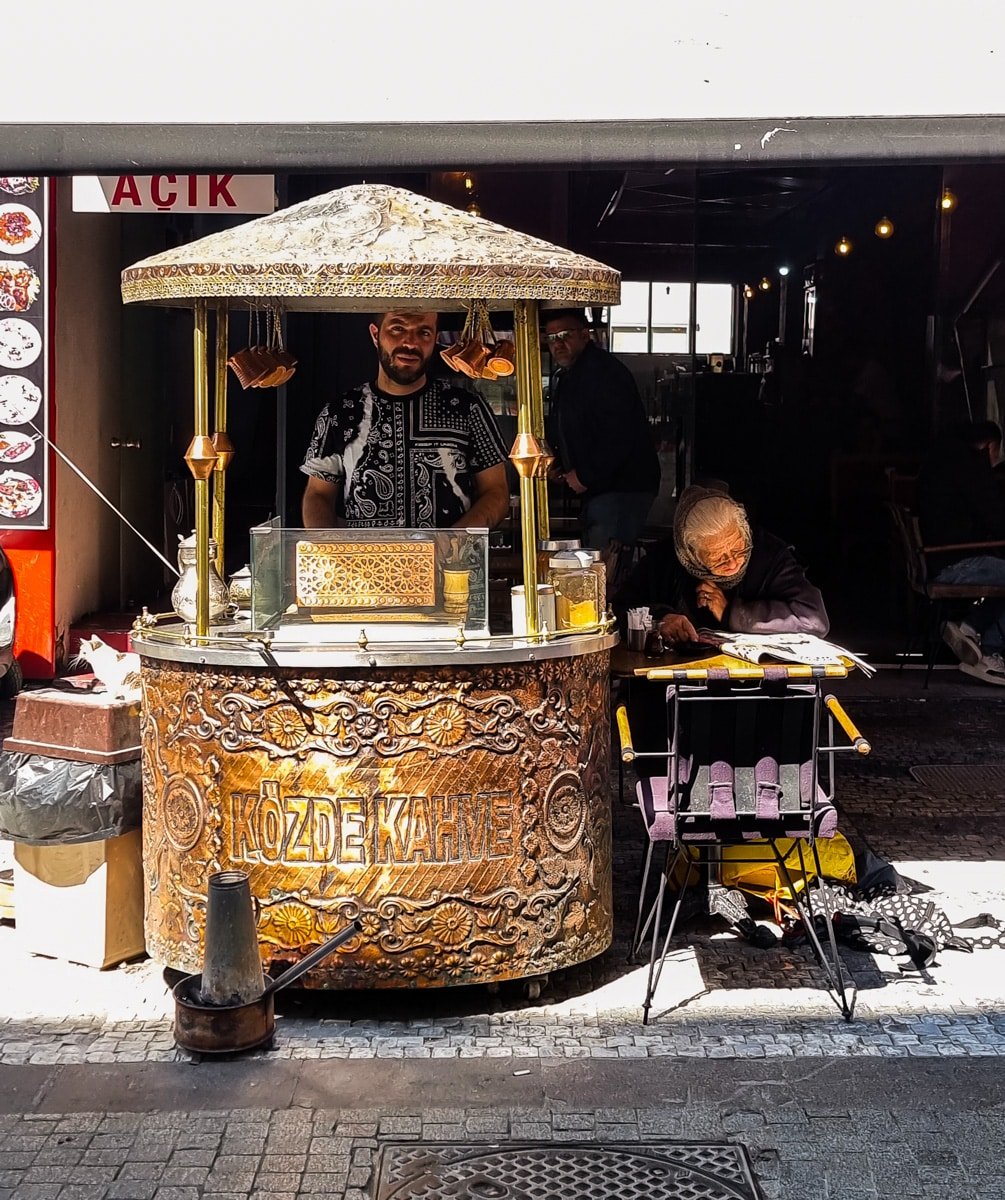
Skip Ahead To My Advice Here!
Kadikoy On The Asian Side Is So Worth Visiting
This Asian part of Istanbul is pretty artsy, and there is street art everywhere you look. It’s got a trendy vibe that’s really infectious, but you never feel out of place or struggling to fit in.
The people in Kadikoy are very welcoming and helpful, so if you’re stuck or not sure where to go, ask, and they’ll be sure to help you out—even if they do not speak as much English as they do on the Euro side.
While Kadikoy might not be as famous as the neighborhoods on the European side , it shouldn’t be missed. In fact, that’s another reason why you should go.
Why Visit The Asian Side Of Istanbul
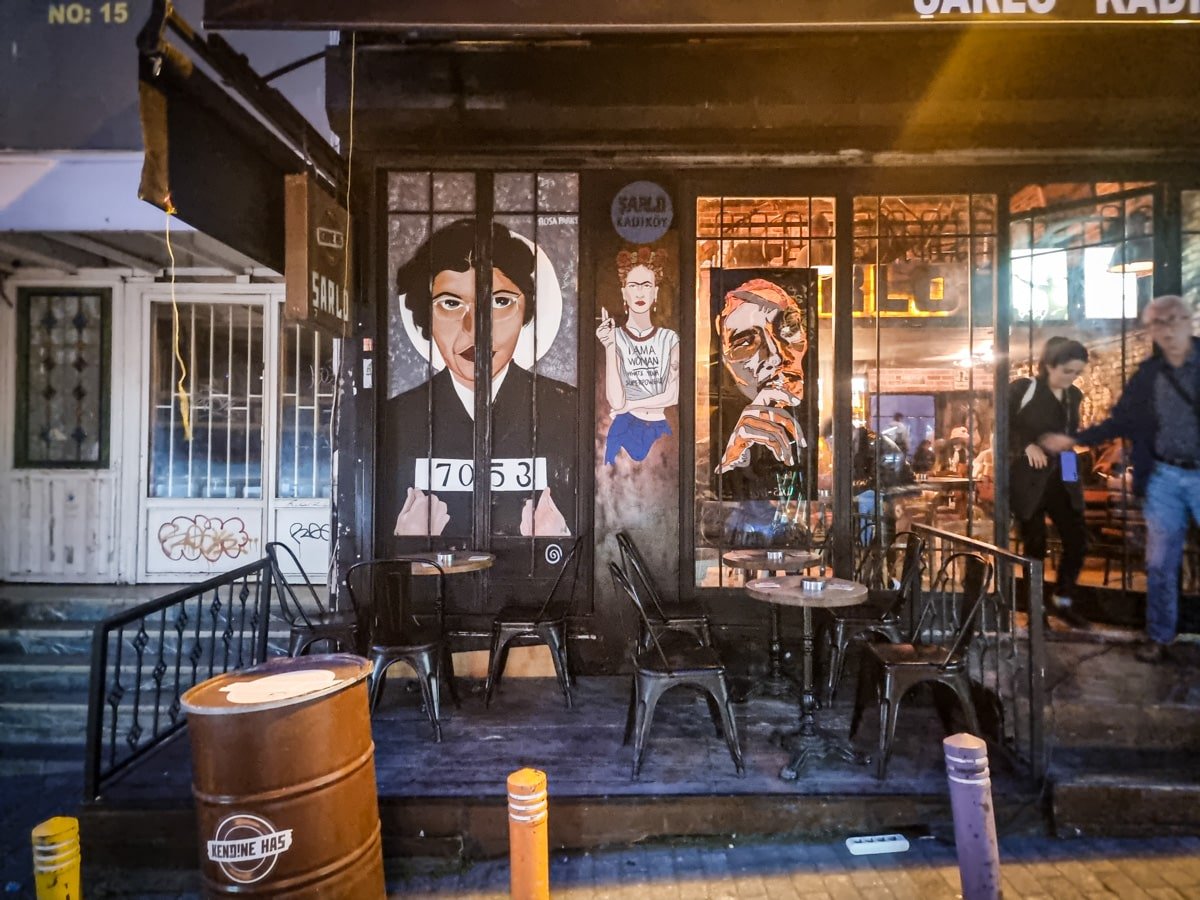
It’s easy to focus all your attention on the touristic hotspots on the European side, but that would be a big mistake!
The Asian side of Istanbul offers a welcome escape from the hustle and bustle of the city’s more touristy areas. Here, you can soak in a more tranquil ambiance reminiscent of an oasis away from the crowds.
Stroll along serene waterfront promenades, such as Kadikoy or Uskudar, and indulge in a peaceful retreat where the locals go about their daily lives.
The charming neighborhoods are filled with quaint streets, cozy cafes, and local markets, providing an authentic glimpse into the everyday life of Istanbul’s residents.
Next, let’s discuss the culinary delights awaiting you on the Asian side. The area is a food lover’s paradise, boasting an array of delicious flavors and authentic cuisines that will tickle your taste buds. From traditional Turkish dishes to international fare, the options are endless.
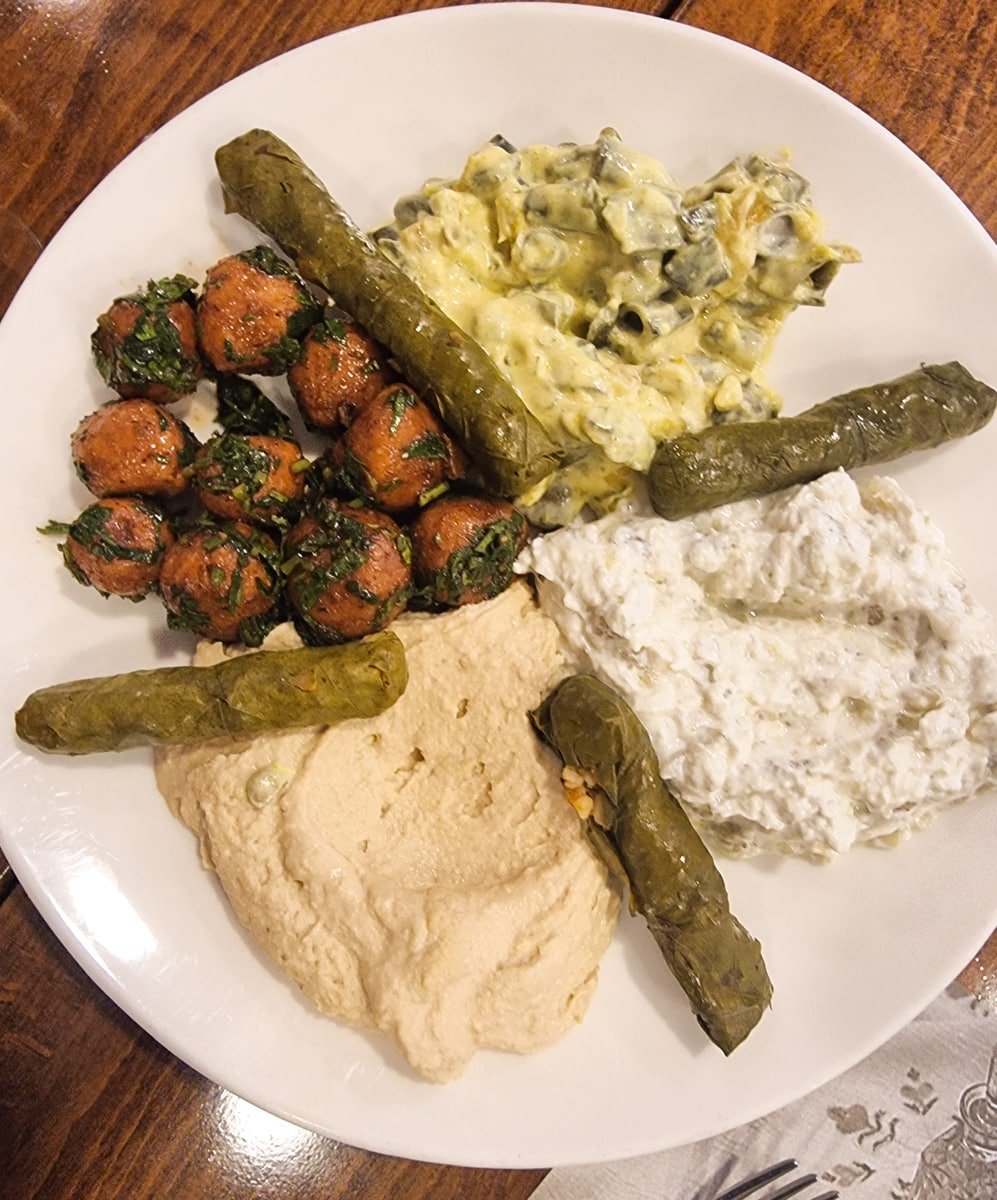
Don’t miss out on exploring the renowned street food stalls, where you can sample delectable treats like mouth-watering kebabs , freshly baked simit (Turkish sesame bread), and baklava to satisfy your sweet tooth , or if you are game, try the super famous dish – Kokoreç (grilled lamb intestines).
Prepare to embark on an unforgettable culinary journey that will leave you longing for more!
You could also argue that Kadikoy is cheaper than the European side. You’ll find prices a little lower, although, of course, you can find places to splurge if you choose to do so.
The more authentic way of life on this side of the city means that you’ll see less tourist prices and more regular ones instead.
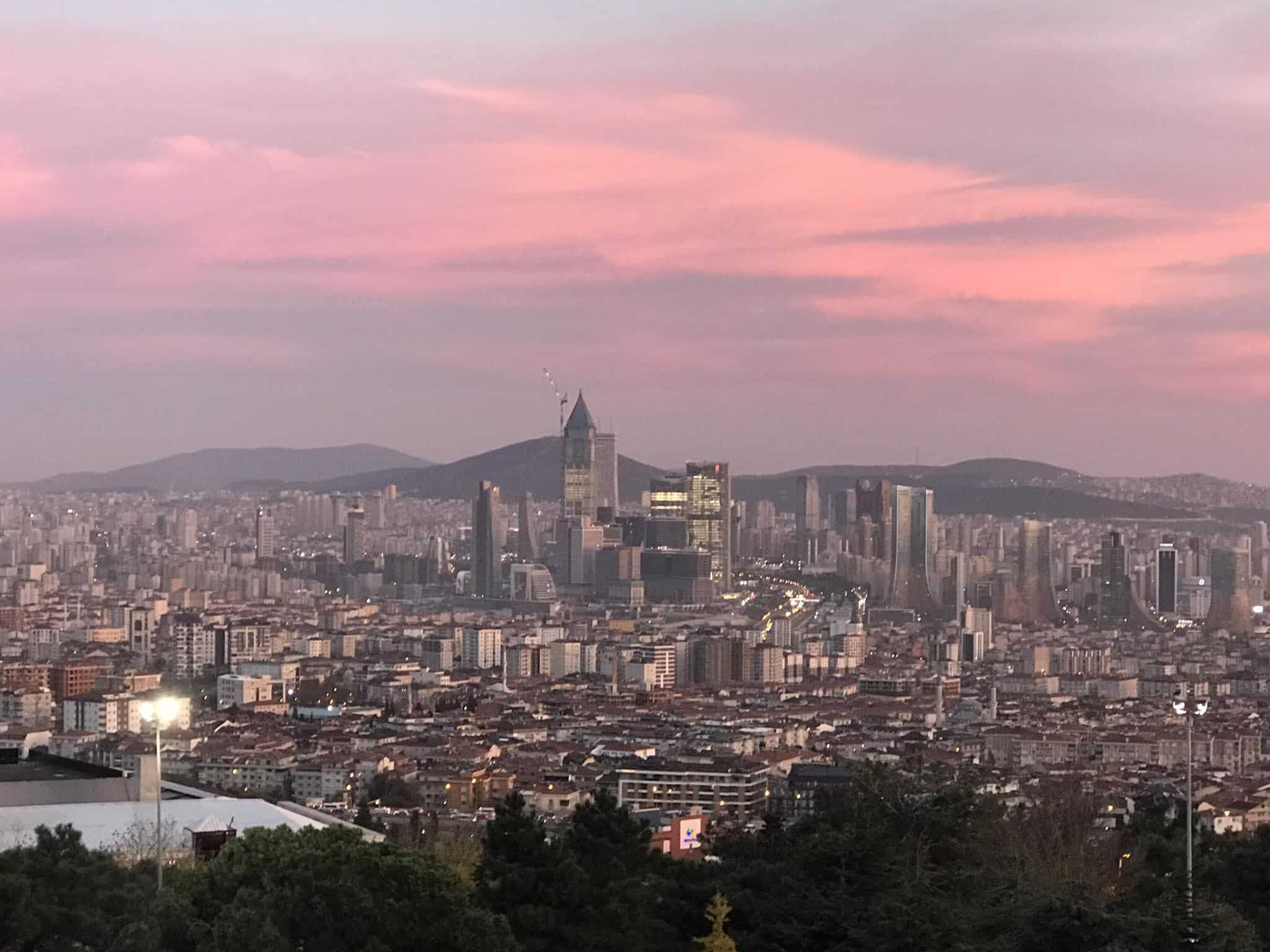
Last but not least, the Asian side of Istanbul offers superb views of the city’s European side. From vantage points such as Çamlıca Hill or the Maiden’s Tower, you can marvel at the stunning skyline adorned by iconic structures like the Blue Mosque and the Hagia Sophia.
These panoramic views allow you to appreciate Istanbul’s architectural wonders, beautifully contrasted against the backdrop of the vibrant Bosphorus Strait . Capture Insta-worthy pictures and create memories that will last a lifetime.
- How To Get From Istanbul Airport To Kadikoy
Brands We Use And Trust
Best things to do in kadikoy.
There is so much to see and do in Kadikoy (I mean even I have to go back again to see what I missed), and it’s really easy to get to other parts of the city thanks to the ferries and Metro . Regular ferries until late in the evening allow you to hop over to the European side within just 20 minutes.
Here are some of the best things to do in Kadikoy to help you decide what to include on your visit list.
1. Explore The Moda Neighborhood
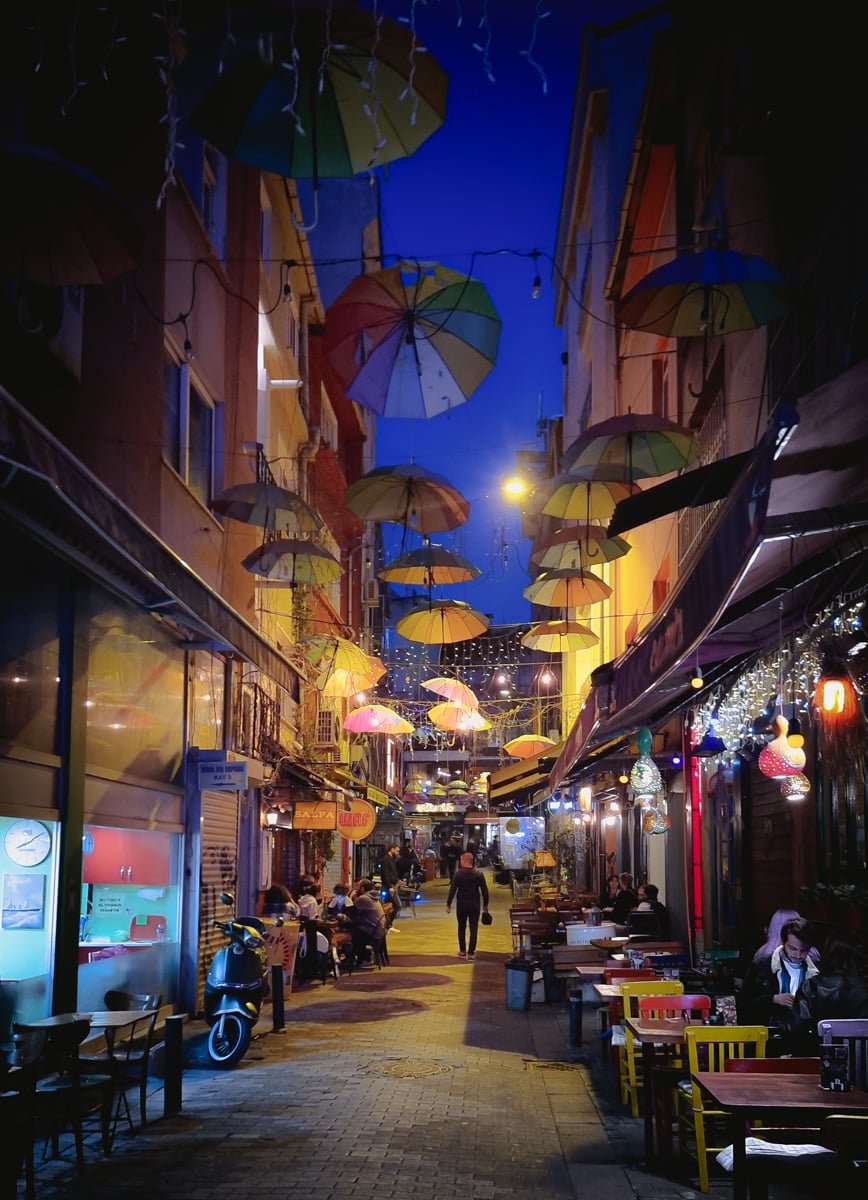
Moda is a vibrant neighborhood in Kadikoy known for its bohemian atmosphere. Take a stroll through its charming streets, lined with eclectic cafes, boutique shops, and art galleries.
Don’t miss Moda Park, a lush green space offering stunning views of the Marmara Sea.
2. Visit Kadikoy Bazaar
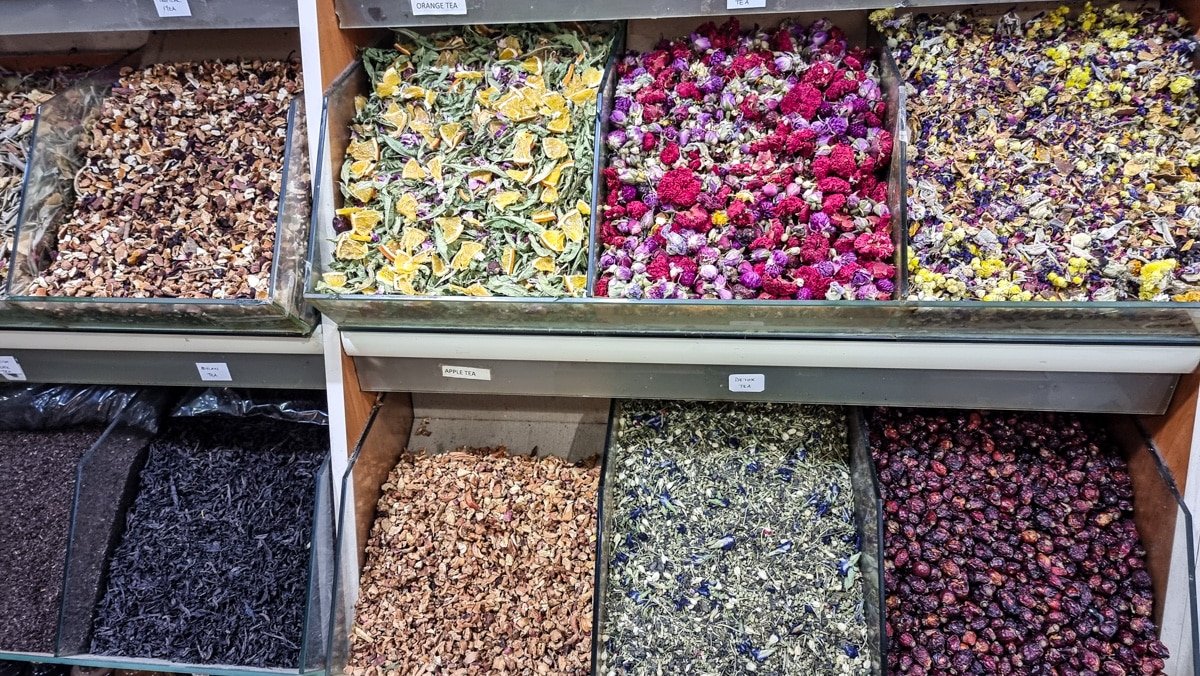
Dive into the heart of local life by visiting the bustling Kadikoy Bazaar. This lively market is a sensory delight, with vendors selling fresh produce, spices, textiles, and more. Immerse yourself in the vibrant energy while sampling local treats and engaging in friendly haggling.
- Best Souvenirs To Buy In Turkey
3. Take A Ferry To Istanbul’s European Side
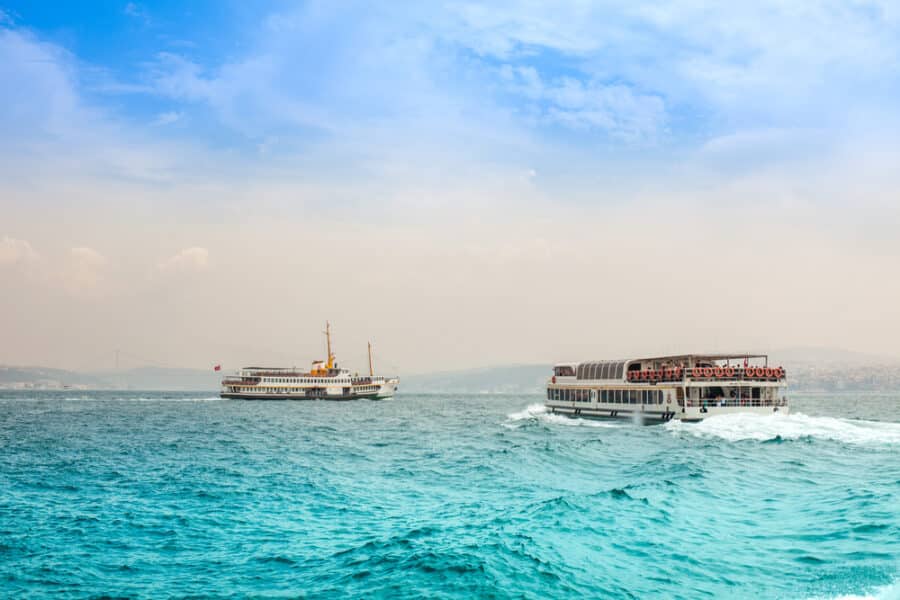
Kadikoy is a major transportation hub with several ferry ports. Hop on one of the ferries to Kadikoy and enjoy a scenic ride across to the European side of the Bosphorus.
By taking the ferry, you can admire the iconic skyline and significant landmarks such as the Hagia Sophia and Topkapi Palace.
4. Explore The Historical Haydarpasa Train Station

Located on the shores of the Bosphorus, the Haydarpasa Train Station is an architectural gem. Marvel at its unique blend of European and Ottoman influences while enjoying panoramic views of Istanbul. Although the station is currently closed, it’s worth visiting the exterior and taking pictures.
5. Visit Kadikoy’s Churches
Kadikoy has a rich religious heritage, and you can find various churches within its boundaries. Stop by the grand Saint Andrew’s Church, a prominent Greek Orthodox church, or explore the hidden gem of Ayia Triada Church, known for its stunning Byzantine frescoes.
6. Enjoy The Kadikoy Street Art
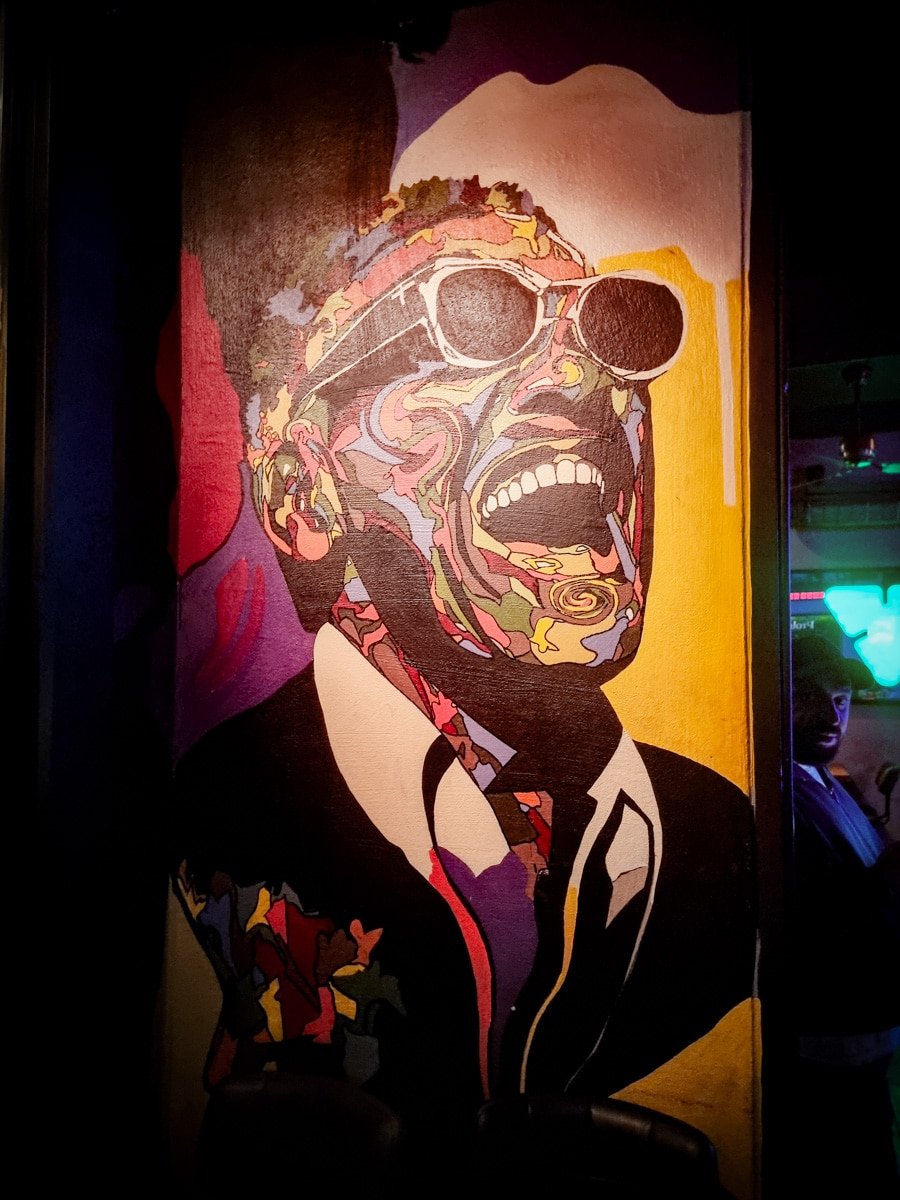
Kadikoy boasts a thriving street art scene, with colorful murals adorning many walls and buildings. It seemed to me that it was on every street!

One of the best ways to see it is to take a street art tour, but if you just walk around the neighborhood, you’ll stumble upon impressive artworks by local and international artists in the most random places—and, of course, on all the big walls. It’s a great way to appreciate Istanbul’s contemporary art culture.
7. Indulge In Delicious Turkish Cuisine
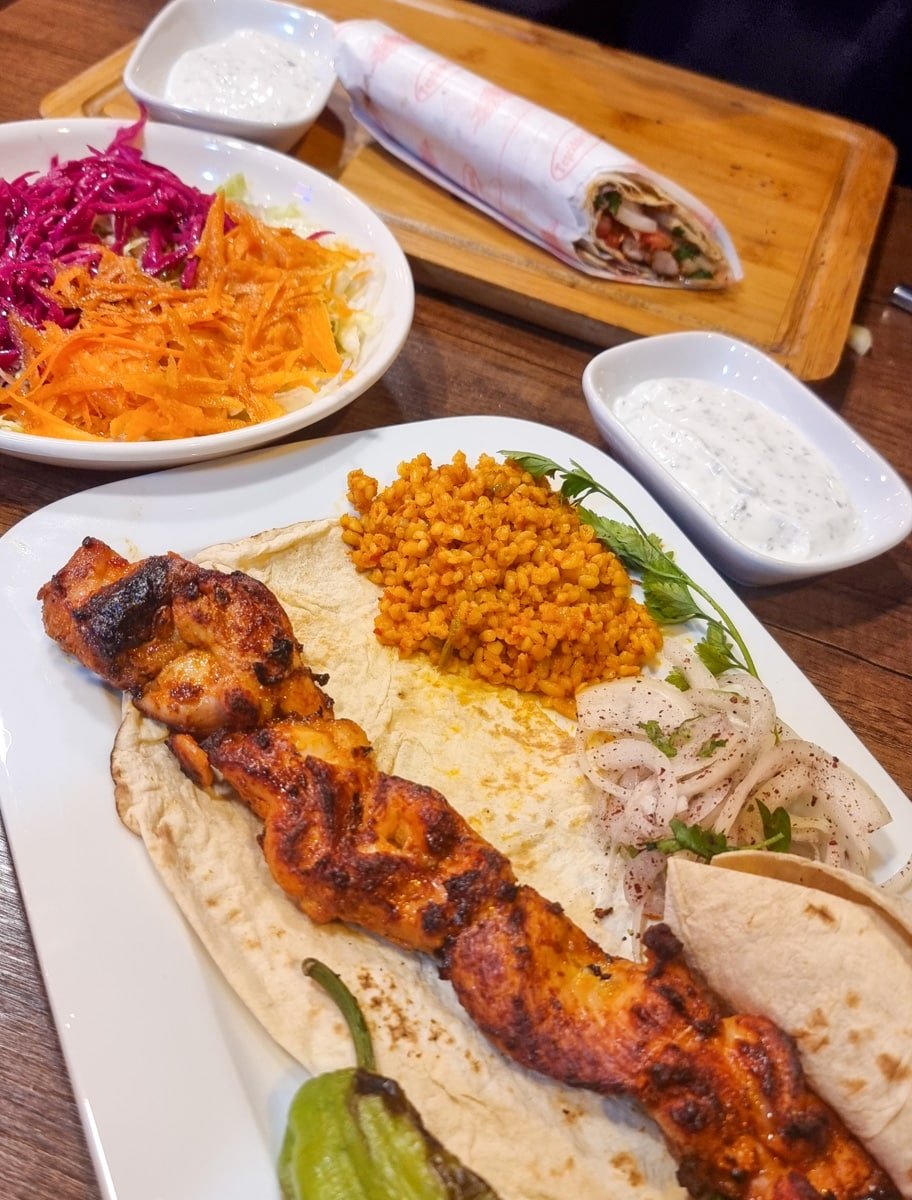
Kadikoy is a food lover’s paradise. On my last trip, I ate so much that I felt I missed many choices.
Numerous restaurants, cafes, and food stalls offer mouth-watering Turkish cuisine all over. Treat yourself to traditional dishes like lahmacun (Turkish pizza), döner kebab, or meze (appetizers) accompanied by freshly squeezed pomegranate juice or ayran (a cooling yogurt-based drink).
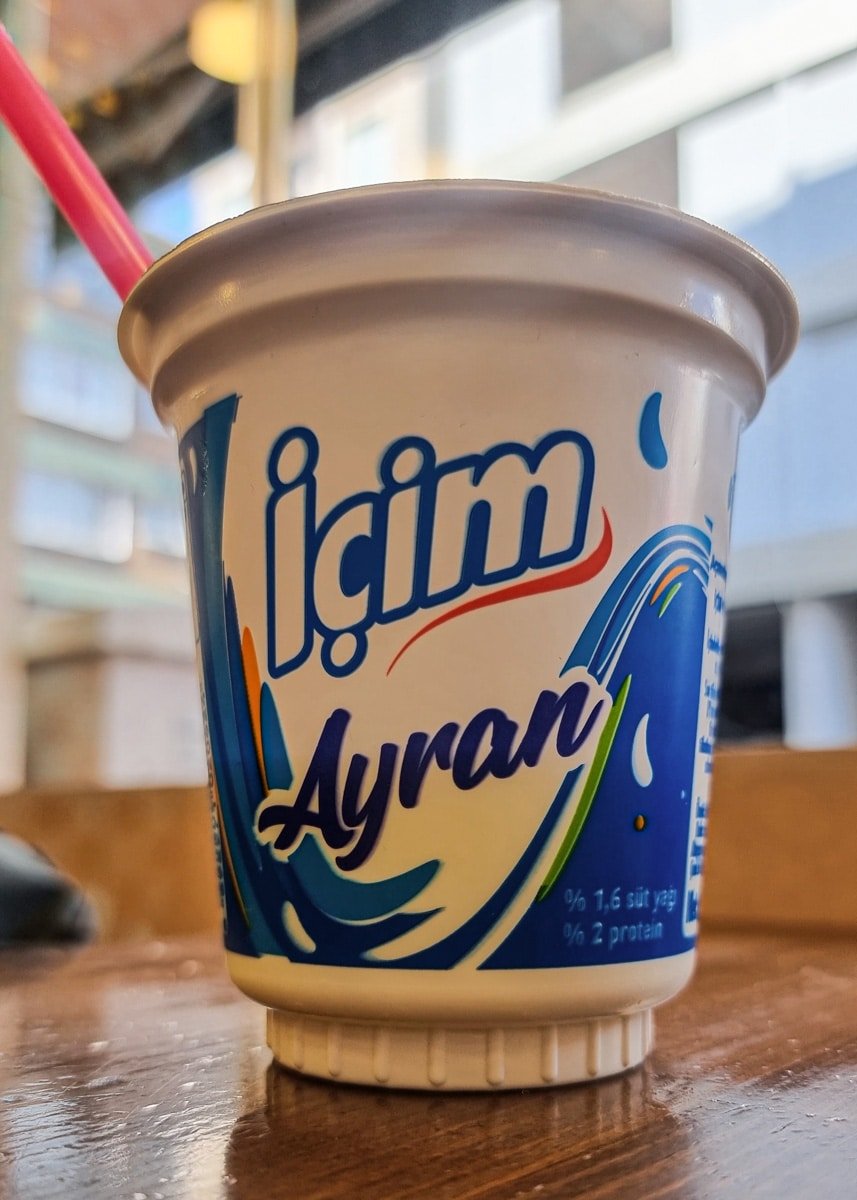
- Food Tours In Istanbul
8. Wander Through The Fish Market
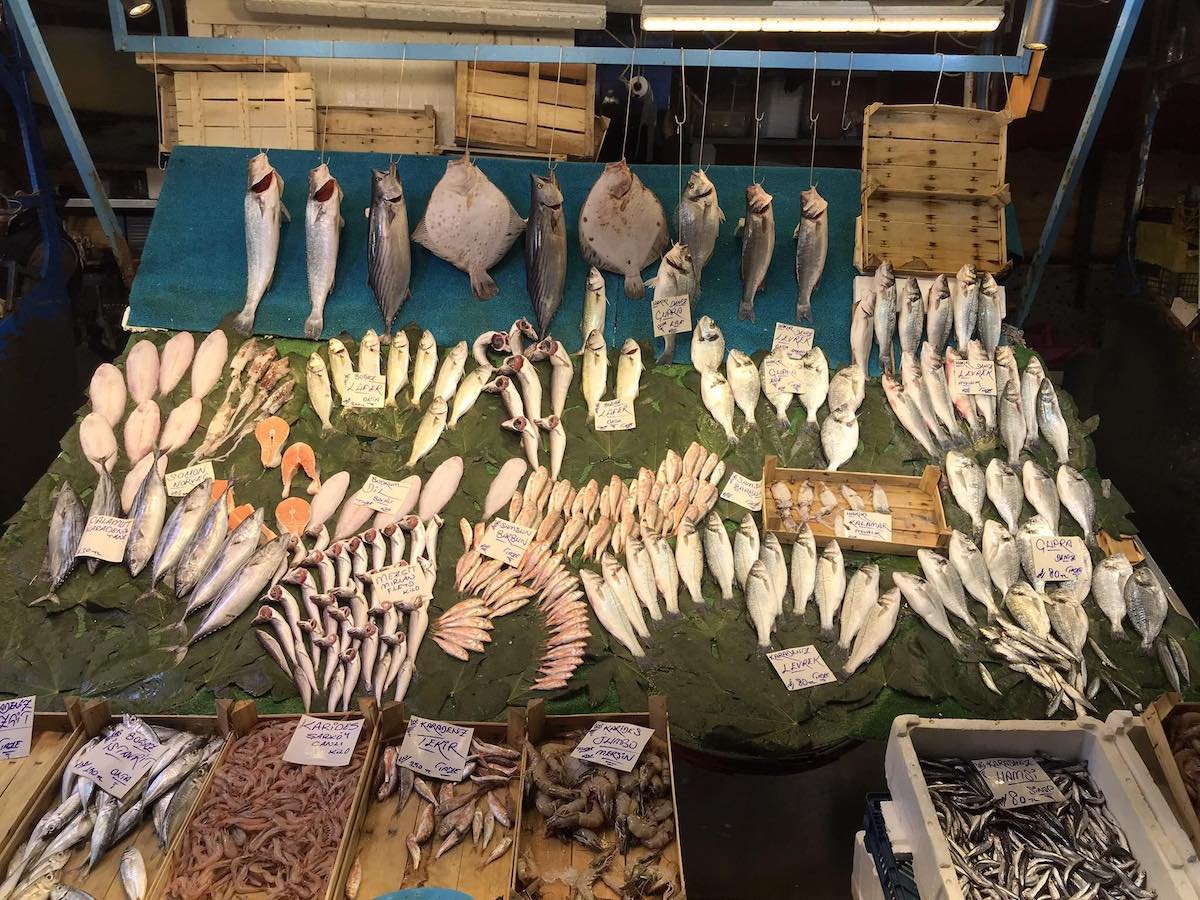
Pay a visit to Kadikoy’s lively Balık Market, where you’ll find a wide array of seafood delicacies. Watch the local fishmongers skillfully prepare the catch of the day or savor a tasty fish sandwich at one of the nearby street food stalls.
9. Discover Kadikoy’s Bookstores
Kadikoy has a reputation as Istanbul’s bookworm paradise, with a high concentration of bookstores. Explore the narrow streets and stumble upon charming independent bookshops offering a vast collection of both new and second-hand books, as well as a cozy reading atmosphere.
10. Experience Kadikoy’s Nightlife & Live Music
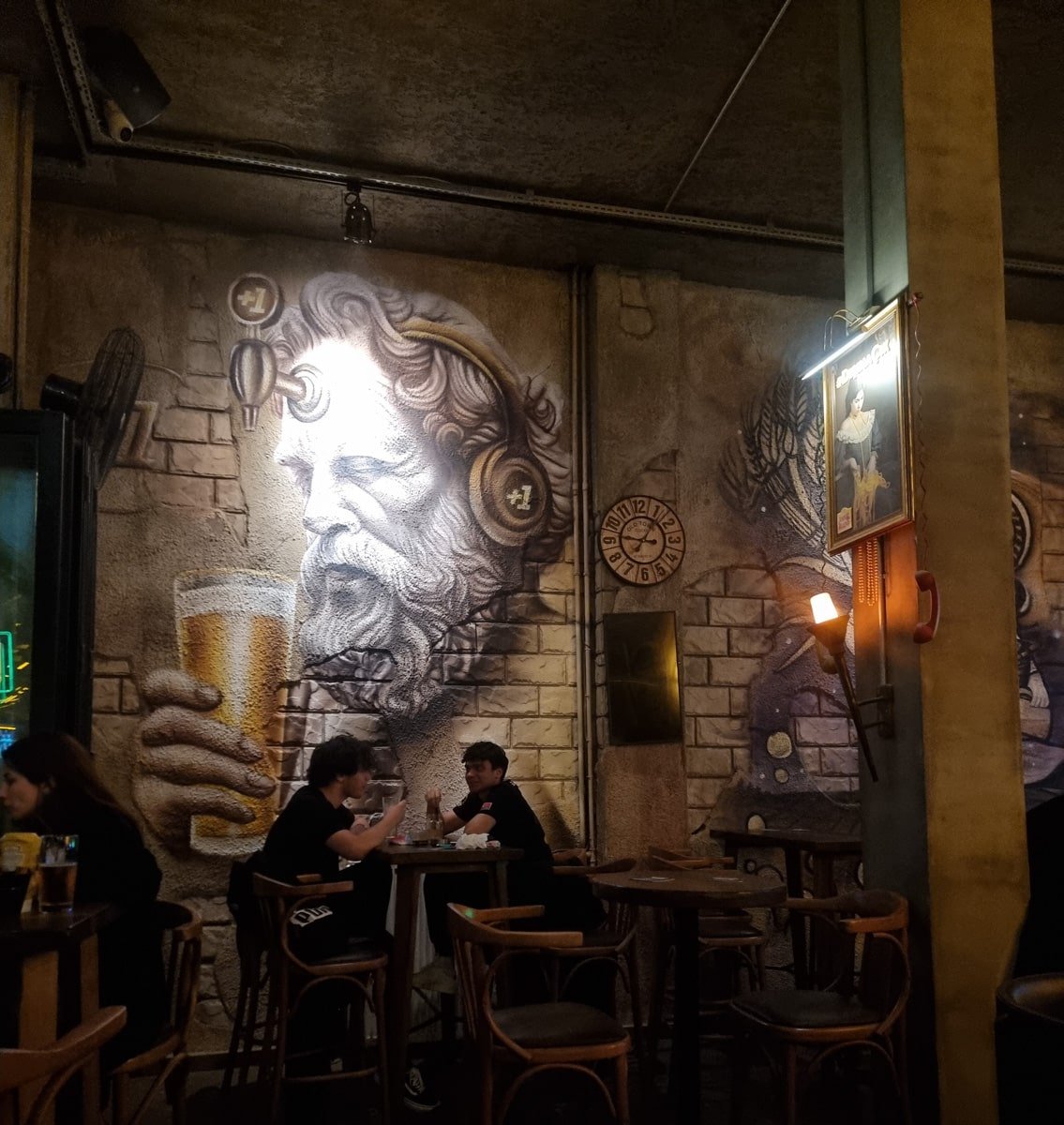
As the sun sets, Kadikoy comes alive with its vibrant nightlife .
Actually, the coffee shops and bars are busy all day, but at night, the buzz is electric. Such a different vibe from the Euro side.
The neighborhood is home to numerous trendy bars, pubs, and live music venues. Unwind with a drink, enjoy live performances, or dance the night away in one of the many lively spots.
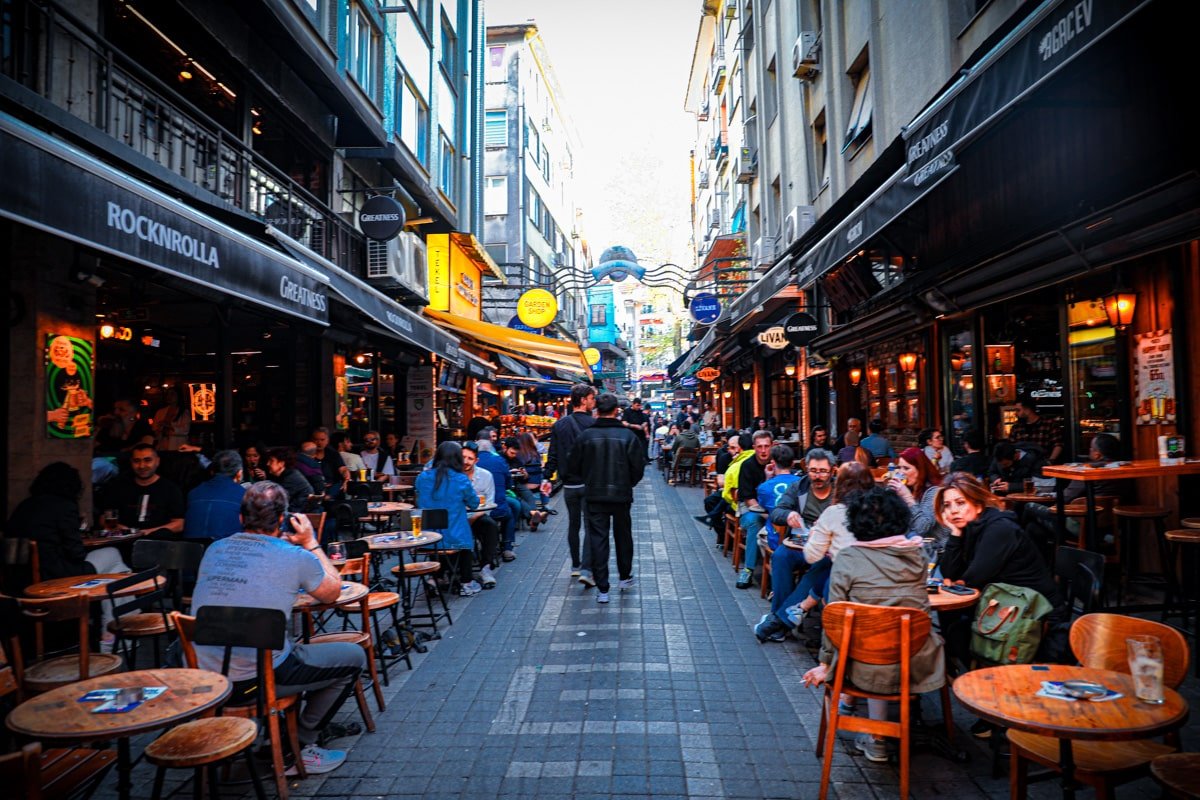
These are just a handful of things to see and do in Kadikoy. Remember, it’s so easy to get around that you should definitely push your exploration a little further. You’ll also find that Kadikoy is a very walkable city too, so you won’t need to take buses or taxis unless you want to go to another part of the city.
Uskudar is a short bus ride from Kadikoy, which is certainly another great place to explore. You’ll find Uskudar is a lot more traditional than Kadikoy, but it’s great to see, and there are some fantastic restaurants and cafes there also.
- Best Turkish Hookah Lounges
Where To Eat A Turkish Dinner In Kadıköy
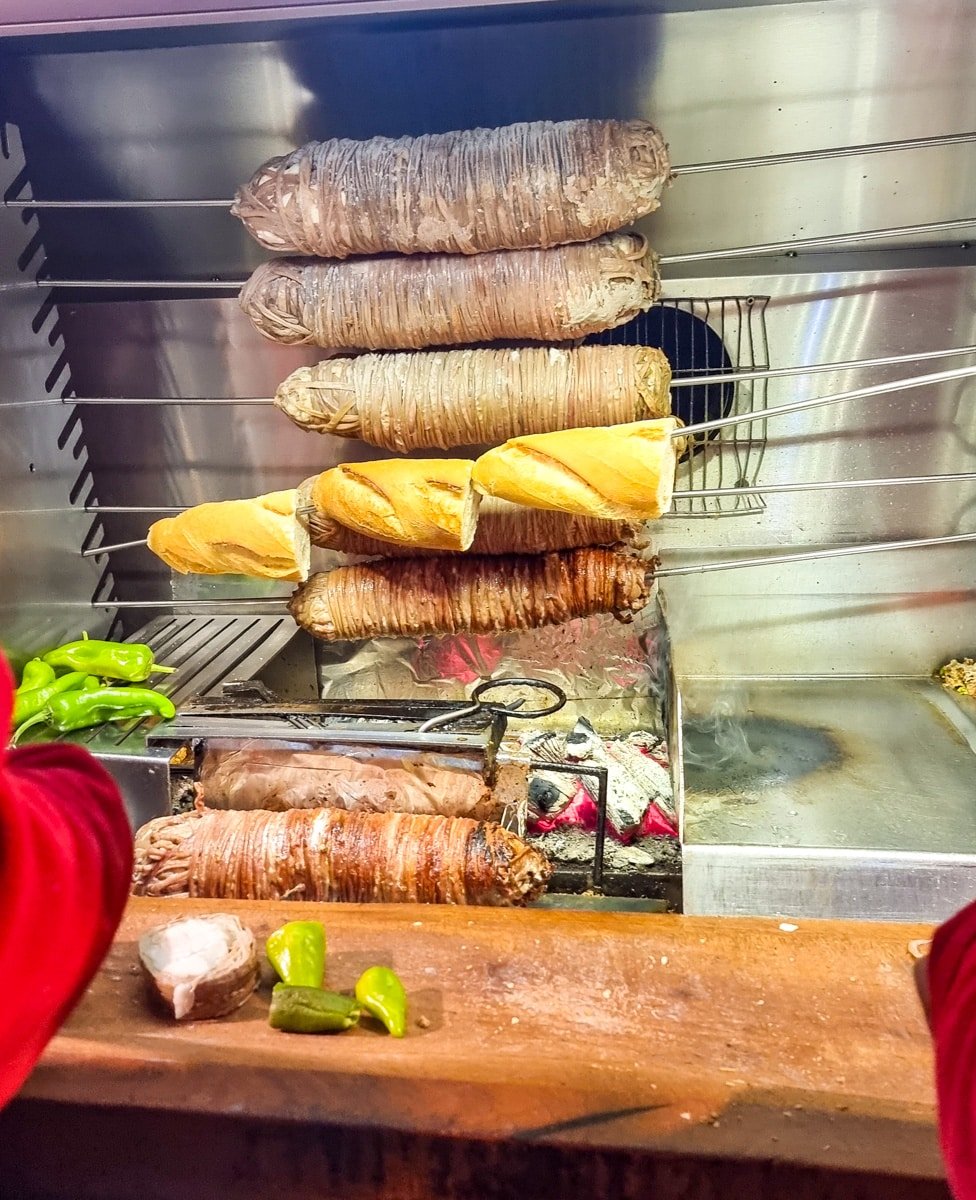
Whether you’re a fan of traditional Turkish cuisine, curious about global flavors, or seeking out unique and innovative dishes, Kadikoy has something to satisfy every palate.
You won’t struggle to find street food vendors everywhere you look. From hot dogs to burgers, pizza to doner kebabs, jacket potatoes to baked goods, you’ll find it all and at reasonable prices.
However, if you’re looking for somewhere to sit and enjoy a delicious meal, here are some of my favorite places for places to eat in Kadikoy:
Ciya Sofrası
Caferağa, Güneşli Bahçe Sok, 34710 Kadıköy/İstanbul
Experience a true culinary adventure at this beloved institution. Ciya Sofrası offers a vast array of traditional Anatolian dishes prepared using ancient recipes and fresh ingredients.
Karadeniz Pidecisi
Rasimpaşa, Recaizade Sk. No:7, 34716 Kadıköy/İstanbul
Indulge in mouth-watering pide (Turkish pizza) at Karadeniz Pidecisi. Their crispy crusts, flavourful toppings, and warm atmosphere make it a must-visit spot.
Kadikoy Fish Market
Osmanağa, Güneşli Bahçe Sok, 34714 Kadıköy/İstanbul
Immerse yourself in the bustling atmosphere of the fish market, where you can choose your own fish and have it cooked to perfection at one of the surrounding restaurants. A seafood lover’s dream come true!
Sample some of the juiciest and most flavorful kebabs in town at Ciya Kebap. Their extensive menu offers a variety of grilled meats, vegetables, and traditional Turkish dishes.
Allpato Kumir
Caferağa, postane Starbucks sokağı Gratis karşı sinda koton Vakıfbank yanı, Muvakkıthane Cd. no:17/A, 34710 Kadıköy/İstanbul
For a unique twist on a baked potato, head to Allpato. Customize your own “kumpir” by selecting toppings from an extensive buffet, resulting in a loaded, flavorful treat.
Baylan Pastanesi
Caferağa, Muvakkıthane Cd. No: 9/A, 34710 Kadıköy/İstanbul
Satisfy your sweet tooth at Baylan Pastanesi, a century-old patisserie serving up delicious cakes, pastries, and Turkish desserts. Try their famous chocolate pistachio baklava!
Moda Caddesi
Caferağa, 34710 Kadıköy/İstanbul
Take a leisurely stroll down Moda Caddesi, a vibrant street lined with numerous cafes, street vendors, and local eateries. Explore the charming side streets and let your senses guide you to hidden culinary gems.
- Best Hotels On The Asian Side Of Istanbul
Move This Adventure To Your Inbox & Get An Instant Freebie

No spam. Unsubscribe at any time.
Kadikoy FAQs
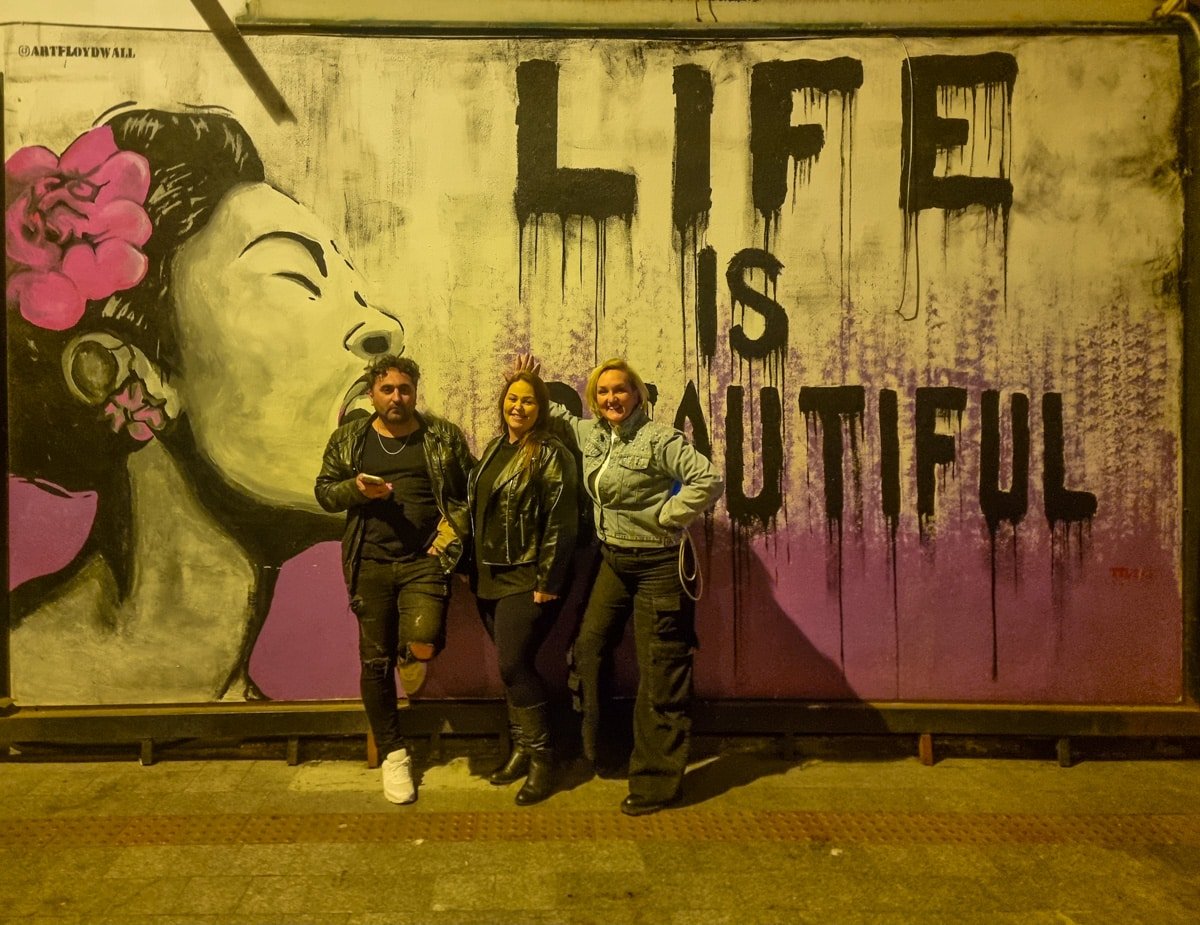
Where is Kadikoy?
Kadikoy is a vibrant district in Istanbul, located on the Asian side of the city. Known for its lively atmosphere and unique blend of history, culture, and modernity, Kadikoy offers a diverse range of experiences for both locals and visitors.
How do I get to Kadikoy?
There are several ways to reach Kadikoy. If you’re on the European side, you can take a direct ferry from Eminonu or Karakoy. Additionally, you can use public transportation options such as buses, the Metro, or the Marmaray train, which connects both sides of Istanbul.
What are the must-see attractions in Kadikoy?
Kadikoy has much to offer in terms of attractions. Please pay a visit to Moda, a charming neighborhood known for its picturesque streets and beautiful seaside park. Explore the vibrant Kadikoy market, where you can find a variety of fresh produce, spices, and local delicacies. Don’t miss the chance to visit Haydarpaşa Train Station, a magnificent historical landmark.
Are there any famous food spots in Kadikoy?
Absolutely! Kadikoy is a food lover’s paradise. You can find a wide array of culinary delights, from traditional Turkish cuisine to international offerings. Head to Ciya Sofrasi for an authentic taste of Anatolian cuisine, or try the famous lahmacun at Borsam Taşfırın. For a unique experience, check out the street food scene at Kadikoy Food Street.
Where can I shop in Kadikoy?
Kadikoy is known for its vibrant shopping streets and diverse boutiques. Bagdat Avenue, one of the city’s most prestigious shopping districts, offers a mix of high-end brands and local shops. Kadikoy Bazaar is also worth a visit for those looking to experience the traditional Turkish market. And don’t forget to browse through the numerous bookstores and vintage shops scattered around the district.
Is Kadikoy nightlife lively?
Yes, Kadikoy is famous for its lively nightlife scene. The streets come alive with a variety of bars, pubs, and live music venues catering to different tastes. Barlar Sokağı (Bars Street) and Kadife Street are excellent choices to explore for a fun night out. From live music performances to cozy cafes, Kadikoy has something for everyone.
Are there any family-friendly activities in Kadikoy?
Certainly! Kadikoy offers several family-friendly activities. Enjoy a relaxing picnic in Moda Park or take a walk along the Kadikoy Promenade, which offers stunning views of the Bosphorus Strait. Visit the Istanbul Toy Museum, where you and your children can explore an extensive collection of toys from different eras.
Are there any festivals or events held in Kadikoy?
Kadikoy hosts various festivals and events throughout the year. The International Istanbul Theatre Festival, which showcases performances from around the world, and the Kadikoy Maritime Festival are both worth experiencing. Check local event listings for the latest updates on upcoming events.
- 5 Day Itineraries For Istanbul
- Best Rooftop Restaurants In Istanbul
- Hotels Near The Airport In Istanbul
- Exploring Istanbul With Kids
- Whirling Dervishes In Istanbul
Leave a Reply Cancel reply
Your email address will not be published. Required fields are marked *
Save my name, email, and website in this browser for the next time I comment.
This site uses Akismet to reduce spam. Learn how your comment data is processed .
Subscribe To Unlock Your FREE Customizable Travel Packing List & All Our Best Tips!
Unlock Your FREE Customizable Travel Packing List!
Subscribe Now For Instant Access To Stress-Free Packing

IMAGES
VIDEO
COMMENTS
Of Istanbul's four modern tram lines, the one most useful to visitors is the T1, which starts near the Kabataş ferry terminal and runs across the Galata Bridge and past the sights of Sultanahmet. There's also a tram (T5) alongside the Golden Horn that stops in the colorful neighborhoods of Fener, Balat and Eyüp, and a tram (T3) that winds ...
Ride around the city with ease using an. The Istanbul Public Transportation Card is pre-loaded with 5, 10, or 20 rides valid on the Metro, as well as all bus numbers, metro bus lines, funicular lines, trams, or ferries in Istanbul. As of November, a one-way journey on public transport with IstanbulKart is 15 lira.
Bus & Metrobus. Istanbul is a bustling city with so much to see, so if you don't want to travel underground, another great way to get around is by bus (dolmuş). The large, yellow buses take you to places all over Istanbul. With over 4,012 buses and 783 bus lines, you can find a bus to take you anywhere.
4. Travel insurance is a must. Travel insurance is mandatory for all foreign visitors to Turkey. Again, you might not be asked to show proof of insurance if you're travelling on an e-visa (I haven't), but rules are rules nonetheless. Istanbul is generally regarded as a safe city, but pickpocketing and crime do occur.
İstanbul has more than its fair share of Byzantine monuments, but few are as drop-dead gorgeous as this mosaic- and fresco-laden church. ... How to get around in Istanbul despite the traffic. Apr 15, 2023 • 6 min read. Destination Practicalities. When is the best time to visit Istanbul? Feb 3, 2023 • 4 min read. Art and Culture.
Istanbul Travel Tips for First-Time Visitors Know Turkish Money. This isn't really an Istanbul travel tip, more of a Turkey travel tip, but you still need to know that wrapping your head around the currency is all-important. In Turkey, the national currency is the lira. If you are wondering what money to carry with you, then it does not matter.
Istanbul Travel Tips for getting around 10. The bus is the best and cheapest way to get from the airport to the city center. Istanbul has two airports - Istanbul Airport (IST) on the European side and Sabiha Gokcen Airport (SAW) on the Asian side.
Address: Azapkapı, Bankalar Caddesi 5/1. 34421 Beyoğlu/İstanbul. Phone: +90 212 283 00 55. Website. Located in a reappropriated late-Ottoman-era bank in the Karakoy neighborhood, The Bank Hotel ...
Tourism in Istanbul booms during the summer months of August and September, as do the room rates, humidity, and lines to enter major tourist attractions. For a more comfortable vacation, visit in spring or autumn when temperatures peak around 70°F and humidity is mild. Mid-April is by far the prettiest time of year, when over 14 million tulips ...
Istanbul has a very central location as just the meeting point of Asia and Europe, and because of that, it is also in the middle of transportation lines. There are many different airlines offering flights directly to Istanbul. Also, trains, buses, and cruises are coming to Istanbul from various locations. When you get to Istanbul it is easy to get around the city with various transportation ...
The Istanbul kart (transport card) In order to use all public transportation in Istanbul (boats, subways, buses, tramways, funiculars), you will need the magnetic card, Istanbul Kart. You can find it in the small kiosks near all metro stations, piers, and also bus stations. It costs 70 TL, you will then add credit.
Istanbul ...
Ride Istanbul's ferries. Climbing aboard one of the city's famous flotilla of ferries is the quintessential Istanbul experience. The trip between Asia and Europe on a commuter ferry is hard to beat, but the Bosphorus tourist ferries that travel the great strait from Eminönü toward the mouth of the Black Sea are even better, offering passengers views of palaces, parks and ornate timber ...
Istanbul's metro system has grown at an incredible rate over the last years, with more lines currently in construction set to open in 2018. Even though the metro lines can get very crowded during rush hour, they are one of the best alternatives for getting around. The European side has plenty of metro lines that connect all the major neighborhoods.
To ride one of the city's buses, you'll need to purchase a limited use ticket or an Istanbulkart card. Limited use tickets are good for one, two, five or 10 rides; fees start at 15 Turkish lira ...
Istanbul Tourist Pass: 100+ Attractions & Services. All of your sightseeing plans, sorted! The Pass will let you skip ticket lines, save you money and guide you around all the best attractions in the city! 569 Reviews. €140.00 / Per Person. Multi-Day Tour Full Day Tour Kids Friendly Sightseeing History Nature Guided Tour Entrance Ticket Pick ...
Explore two absolute highlights in Turkey - Istanbul, the former capital of the Ottoman Empire with its many landmarks. After a few days in the city, fly to Cappadocia and explore the surreal surroundings, either on day tours or from above in a hot air balloon. view trip ⤍. 9 days / from2500 USD.
Read More. At the Istanbul Archaeological Museums, which opened near the Topkapi Palace Museum in 1869, you'll find more than a million antiquities displayed throughout three buildings: the ...
The trip takes 75 minutes and 1 hour, 45 minutes respectively. For points farther south (Izmir, Bergama, Kusadasi, Ephesus/Selçuk, or Bodrum), you may want to cruise with Denizline (tel. 0212/444-3369; www.denizline.com.tr) on the company's overnight ferry from Istanbul to Izmir.
The T5 line follows the Golden Horn coastline in the historic peninsula. Its route features several of Istanbul's most prominent landmarks and attractions. The line is shorter than the T1 and T4 lines, with a 10-kilometer (6-mile) length and 14 stations. The journey on the T5 line takes around 35 minutes one way.
If not all, here are 10 best places near Istanbul that you must visit on priority. Belgrad Forest - Enjoy Natural Beauty. Prince Islands - Enjoy A Ferry Ride. Kilyos - A Resort Town. Cappadocia - Enjoy Hot Air Balloon Ride. Edirne - Rich In Culture. Blue Mosque - A Historical Place.
Taxis are an easy and cheap way to get around. As of September 2016, start off rate is 3.40 TL (€1.1) and then 2.1 TL (€0.6) for each km afterwards. A one-way travel from Taksim Square to Sultanahmet costs approximately 10-15 TL. Tipping is generally unnecessary.
Osmanağa, Güneşli Bahçe Sok, 34714 Kadıköy/İstanbul. Immerse yourself in the bustling atmosphere of the fish market, where you can choose your own fish and have it cooked to perfection at one of the surrounding restaurants. A seafood lover's dream come true! Ciya Kebap. Caferağa, Güneşli Bahçe Sok, 34710 Kadıköy/İstanbul